|
[Entertainment]
Washington Post paperback bestsellers
A snapshot of popular books.
Published:7/24/2024 8:06:13 AM
|
[Markets]
CJ Hopkins: The People's Court Of New Normal Germany
CJ Hopkins: The People's Court Of New Normal Germany
Authored by CJ Hopkins via The Consent Factory,
Just when I thought things could not possibly get more shockingly totalitarian in New Normal Germany, where I’m being prosecuted in criminal court (for the second time) for tweeting, the German authorities have gone and surprised me again.
No, they haven’t established an actual Nazi-style People’s Court (pictured below) yet, and, of course, there is absolutely no similarity between the current German justice system, which is totally fair and democratic and a paragon of impartial justice and the rule of law, and The People’s Court of Berlin during the Nazi era, nor is there any similarity between Nazi Germany and New Normal Germany (i.e., modern-day Germany), and I would never, ever, suggest that there was, as that would be intellectually lazy, and tasteless, and completely inaccurate, and illegal, and … well, let me fill you in on the latest.

The Berlin Superior Court has set a date for my next thoughtcrime trial.
As regular readers will probably recall, my first thoughtcrime trial in January ended with my acquittal. So, the German authorities are putting me on trial again. Yes, they can do that in Germany. But, wait, that’s not the best part.
The best part is, at my new thoughtcrime trial - this time in Berlin Superior Court - full-scale Anti-Terrorism Security protocols will be effect in the courtroom. Everyone will be subjected to TSA-style scanning and screening, and will have to surrender all their personal possessions and hats and coats and head coverings to the Security Staff, and completely empty their pockets of all items, before entering the courtroom. No computers, phones, smart-watches, or any other potential recording devices will be allowed in the courtroom. Pencils and sheets of paper will purportedly be provided to members of the press by Security Staff. Members of the press and public will be limited to 35, and, after they have successfully passed their “security screening,” they will be cordoned off in the last five rows of the gallery in the very back of the courtroom, “for security reasons,” and monitored by the armed Security Staff.
For the benefit of any new readers unfamiliar with me and my case, I am not a terrorist. I’m an award-winning American playwright, novelist, and political satirist. I have lived here in Berlin for 20 years. The German authorities have been investigating and prosecuting me since August 2022. My case has been covered in The Atlantic, Racket News, Neue Zürcher Zeitung, Multipolar, and many other outlets, so I won’t reiterate every little detail again here. Basically, I am being prosecuted for “spreading pro-Nazi propaganda” because I criticized the Covid mask mandates and tweeted the cover artwork of one of my books, The Rise of The New Normal Reich.
Here’s the cover artwork of that book. The other two images are the recent covers of Der Spiegel and Stern, two well-known mainstream German magazines, which are not being prosecuted for “spreading pro-Nazi propaganda.”

As anyone (even the German authorities) can see, the Spiegel cover artwork uses exactly the same concept as the cover artwork of my book. The only difference is, the Spiegel swastika is covered by the German flag, whereas the swastika on my book is covered by a medical mask.
Both artworks are obviously intended as warnings of the rise of a new form of totalitarianism. Der Spiegel was warning about the Alternativ für Deutschland party (AfD) — as was Stern with its swastika floating in a champagne glass. I was warning about what I dubbed “The New Normal Reich,” the new nascent form of totalitarianism that emerged during 2020-2023, which is still very much on the rise, and which is thoroughly documented and analyzed in my book (which book was banned by Amazon in Germany at the same time the German authorities launched a criminal investigation of me and instructed Twitter to censor my Tweets, which Twitter did).
The pretext the Court is citing for ordering these Anti-Terrorism Security protocols at my trial is ridiculous, and infuriating. The Court claims that the courtroom in which my trial is to take place is occasionally used for a certain “high-security” trial. Therefore, according to the Court, my trial must also be subjected to Anti-Terrorism Security protocols. Seriously, the Court sent my attorney a fax setting forth this “explanation,” which is, of course, a load of horseshit. The Berlin Superior Court is a huge building containing multiple courtrooms, one or two which are probably not subject to such Anti-Terrorism Security protocols when “high-security” trials are not taking place within them.

No, the imposition of these Anti-Terrorism Security protocols is clearly a cynical ploy intended (a) to suppress coverage of the trial, (b) to discourage the press and public from attending, and (c) to intimidate and harass me and my legal counsel, and any members of the press and public who nevertheless attend the trial in spite of the “security procedures” they will be subjected to.
This cynical tactic — which is not an official press blackout, because journalists can still attend and attempt to scribble notes on their knees with the pencils and sheets of paper provided by the Security Staff — comes as no real surprise. As I mentioned above, my case and my first trial got a fair amount of attention from the international press, enough to put the Court on notice that my prosecution was being watched. So, it’s no mystery why the German authorities would want to discourage any reporting on my “do-over” trial in Superior Court.
Also, the gallery was filled to capacity at my original trial in January, where I delivered a rather unusual closing Statement to the Court, which was then published and disseminated widely in Germany. So, again, it is no real mystery why the Superior Court wants to discourage members of the public from attending this new trial by threatening to subject them to these humiliating “security” protocols, and why it has limited the gallery size to only 35 seats.
I assume the German authorities — and by “authorities” I mean the Berlin District Prosecutor’s office, the Berlin Superior Court (Der Kammergericht), and whatever other authorities are intent on punishing me, and making an example of me, for daring to criticize the government’s edicts during 2020-2022, i.e., suspension of the constitutional rights, mask mandates, segregation, the banning of protests, etc. — I assume these authorities are particularly motivated to prevent the press from covering this second trial in Superior Court, because, from what I understand of the German legal system, they are going to “do” me (i.e., convict me) this time.
The way the German legal system works, if they want to do you, is (1) you are acquitted in the lower Criminal Court, (2) the District Prosecutor appeals the verdict to the Superior Court, (3) the Superior Court overturns your acquittal, and (4) the prosecution goes back to the original Criminal Court, which stages a new trial, at which you will be found guilty, because, once the Superior Court has overruled your acquittal, the Criminal Court will convict you based on the Superior Court’s ruling. At which point you will appeal. And on and on and on it will go, until you are broke, or until you give up fighting because you are just so fucking exhausted.
I’m not making this up. This is how The People’s Court of New Normal Germany (i.e., the post-Covid German justice system, which, again, bears no resemblance whatsoever to The People’s Court of Berlin in Nazi Germany, or to the courts in the Soviet Union during the Stalin era, or any other totalitarian “justice” system) … this is how it works in New Normal Germany if you are a critic of the authorities and refuse to meekly accept whatever punishment they want to summarily dish out for whatever they deem to be your thoughtcrimes.
But, hey, at least they’re not going to take me out and put me up against a wall and shoot me, like they did with political criminals in Nazi Germany, and the USSR, so I suppose I should be grateful. I’ll have to work on that.
If you think my case is an aberration, it isn’t. There are many, many other people — critics of the government’s “Covid measures” during 2020-2023 — who are being persecuted and made examples of. Most of these people do not have the financial resources to pay lawyers to fight these prosecutions, so they plead guilty to the charges and pay the fines, which are typically much less than what they would face in attorney’s fees. Being somewhat of a public figure, I thought it was my responsibility not to do that. I’m extremely grateful to everyone who has donated to my legal defense fund, which is how I have been able to cover my legal expenses. There’s enough left in that fund to cover this next trial in Superior Court, so I’m OK for now, financially. I mention that because people are already asking how they can send me money.
What people can do, if they want to do something helpful, is make as much noise as possible about what is happening, not just in Germany, but all throughout the West. Because what is happening is, well, what I tried to capture and analyze in my book. The Powers That Be are going totalitarian on us. They are gradually, and not so gradually, phasing out the so-called “liberal” or “democratic” rights and principles that it was necessary to placate the Western masses with during the Cold War era, which it is no longer necessary to do beyond a certain superficial point.
I have published three books of essays documenting this transition to a new global-capitalist form of totalitarianism, so I’m not going to go on and on about it here. But that’s what all the censorship is about. That’s what all the manufactured hysteria, fomented hatred, fanaticism, the permanent state of “emergency” and “crisis,” the “culture wars,” the cults of personality, the bombardment of our minds with absolutely meaningless nonsense, the naked displays of force, the blatant instrumentalization of the justice system to punish political dissidents, not just here in Germany, but throughout the “democratic” West … that is what all this is about.
I’ll keep my readers posted on the details of my upcoming trial in Berlin Superior Court. My attorney is objecting to these “security protocols,” of course. We’ll see how that goes. In the meantime, instead of sending me money this time, maybe try to step back from all the mass hysteria and hatred that we are being inundated with and see the big picture. It isn’t pretty.
Help spread the word about the new totalitarianism, about the phasing-out of our democratic rights. I don’t care which “side” of whatever you are on — Trump, Biden, Palestine, Israel, the culture wars, the cancel campaigns, Covid, Elon Musk, Russia, whatever — and neither do The Powers That Be. Take a step back and try to see the bigger picture … the forest, instead of just the trees. And then make as much noise about it as you can.
We are heading somewhere very ugly … somewhere most of us can’t imagine. Some of us will get there first, but all of us will be there, together, eventually. My story is just one example of what it will be like there, in that ugly place. It isn’t really a story about Germany. It is a story about the end of the myth of democracy, and the rule of law, and all that good stuff. As Frank Zappa once so eloquently explained …
“The illusion of freedom will continue as long as it’s profitable to continue the illusion. At the point where the illusion becomes too expensive to maintain, they will just take down the scenery, they will pull back the curtains, they will move the tables and chairs out of the way and you will see the brick wall at the back of the theater.”
It’s something to behold, that brick wall is, especially up close and personal. You’ll see when you get here. I’ll save you a seat.
|
[Markets]
True Purpose Of NATO Remains USA Hegemony
True Purpose Of NATO Remains USA Hegemony
Authored by Yves Engler via Counterpunch.org,
NATO’s new focus on China harkens back to the belligerent alliance’s early days.

At the North Atlantic Treaty Organization’s 75th anniversary summit in Washington, DC, last week China was a big part of the agenda. The NATO summit’s final declaration mentioned the People’s Republic of China’s (PRC) 14 times. It noted that “the PRC continues to pose systemic challenges to Euro-Atlantic security” and China’s “stated ambitions and coercive policies continue to challenge our interests, security and values.”
The leaders of NATO “partner” nations Japan, South Korea, New Zealand and Australia attended the summit. They collectively met NATO Secretary General Jens Stoltenberg to map out strategy for the Asia Pacific region. NATO announced four new joint projects with countries that are important to Washington’s bid to establish an anti-China military bloc. In response, Beijing accused NATO of “inciting bloc confrontation and hyping up regional tensions”.
Unsurprisingly, NATO frames its focus on China as defensive. “The PRC has become a decisive enabler of Russia’s war against Ukraine”, claimed the summit’s final communique. According to this storyline, Chinese relations with Russia threaten NATO. But this is exaggerated. China has taken a cautious approach to Russia’s war largely complying with (illegal) US sanctions and refusing to sell arms (though its companies sell some dual use products to Russian firms). Conversely, North Korea and Iran are selling Russia arms while NATO countries are donating large amounts of weapons to Ukraine.
Comparing Chinese ties to India’s highlights NATO’s exaggeration. India is buying more oil and weapons from Russia than China and when NATO began its meeting Indian Prime Minister Narendra Modi was in Moscow to meet President Vladimir Putin.
In 2022, NATO released a strategic concept listing China for the first-time. It labeled Beijing a challenge to the alliance’s “interests, security and values” and at the time Stoltenberg declared, “China is substantially building up its military forces, including nuclear weapons, bullying its neighbours, threatening Taiwan ….”
This is all part of the US empire’s bid to contain China’s rise. Washington has become obsessed with an emerging “peer competitor” that may eventually rival its power.
While it seems strange that an alliance to defend the ‘north Atlantic’ should target a faraway Asian state, NATO is neither defensive nor only about the north Atlantic. The alliance’s recent wars in Afghanistan and Libya demonstrate that it’s a tool to enable US-led global domination.
That’s been clear for 75 years.
As part of the Parliamentary debate over NATO’s founding Canada’s external affairs minister Lester Pearson said:
“There is no better way of ensuring the security of the Pacific Ocean at this particular moment than by working out, between the great democratic powers, a security arrangement the effects of which will be felt all over the world, including the Pacific area.”
Two years later he said:
“The defence of the Middle East is vital to the successful defence of Europe and north Atlantic area.”
In 1953 Pearson went even further:
“There is now only a relatively small [5000 kilometre] geographical gap between southeast Asia and the area covered by the North Atlantic treaty, which goes to the eastern boundaries of Turkey.”
Pearson believed that the newly created ‘defensive’ alliance justified sending 27,000 Canadian troops to Korea. In a history of the 1950-53 US-led Korean war David Bercuson writes that Canada’s external minister “agreed with [President] Truman, [Secretary of State] Dean Acheson, and other American leaders that the Korean conflict was NATO’s first true test, even if it was taking place half a world away.”
The Korean War was partly a reaction to Mao’s 1949 communist/nationalist revolution in China. After US forces approached its border, China intervened. The war left around three million dead.
In reality, NATO was established to bring a decolonizing world under the US geopolitical umbrella. This remains true 75 years later as the alliance continues to advance US hegemony.
|
[Markets]
Engineering A Crisis: How Political Theater Helps Keep The Deep State Stay In Power
Engineering A Crisis: How Political Theater Helps Keep The Deep State Stay In Power
Authored by John & Nisha Whitehead via The Rutherford Institute,
“The two ‘sides’ of mainstream politics are not fighting against one another, they’re only fighting against you. Their only job is to keep you clapping along with the two-handed puppet show as they rob you blind and tighten your chains while your gaze is fixed on the performance.”
- Caitlin Johnstone
A failed assassination attempt on a presidential candidate. An incumbent president withdrawing his re-election bid at the 11th hour. A politicized judiciary that fails to hold the powers-that-be accountable to the rule of law. A world at war. A nation in turmoil.
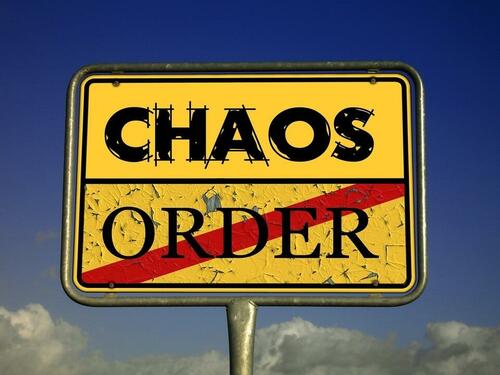
This is what controlled chaos looks like.
This year’s election-year referendum on which corporate puppet should occupy the White House has quickly become a lesson in how the Deep State engineers a crisis to keep itself in power.
Don’t get so caught up in the performance that you lose sight of what’s real.
This endless series of diversions, distractions and political drama is the oldest con game in the books, the magician’s sleight of hand that keeps you focused on the shell game in front of you while your wallet is being picked clean by ruffians in your midst.
It’s the Reichstag Fire all over again.
It was February 1933, a month before national elections in Germany, and the Nazis weren’t expected to win. So they engineered a way to win: they began by infiltrating the police and granting police powers to their allies; then Hitler brought in stormtroopers to act as auxiliary police; by the time an arsonist (who claimed to be working for the Communists in the hopes of starting an armed revolt) set fire to the Reichstag, the German parliamentary building, the people were eager for a return to law and order.
That was all it took: Hitler used the attempted “coup” as an excuse to declare martial law and seize absolute power in Germany, establishing himself as a dictator with the support of the German people.
Fast forward to the present day, and what do we have? A discontented citizenry, a disconnected government, and a Deep State that wants to stay in power at all costs.
So what happens? Trump has a near miss, Biden bows out, and politics becomes exciting to the masses again.
It works the same in every age.
This is how the police state will win, no matter which candidate gets elected to the White House.
You know who will lose? Every last one of us.
After all, politics today is not about Republicans and Democrats.
Nor is it about abortion, healthcare, higher taxes, immigration, or any of the other buzzwords that have become campaign slogans for individuals who have mastered the art of telling Americans exactly what they want to hear.
Politics today is about one thing and one thing only: maintaining the status quo between the Controllers (the politicians, the bureaucrats, and the corporate elite) and the Controlled (the taxpayers).
Indeed, it really doesn’t matter what you call them—the 1%, the elite, the controllers, the masterminds, the shadow government, the police state, the surveillance state, the military industrial complex—so long as you understand that no matter which party occupies the White House in 2025, the unelected bureaucracy that actually calls the shots will continue to do so.
In other words, no matter who wins this next presidential election, you can rest assured that the new boss will be the same as the old boss, and we—the permanent underclass in America—will continue to be forced to march in lockstep with the police state in all matters, public and private.
Consider the following a much-needed reality check, an antidote if you will, against an overdose of overhyped campaign announcements, lofty electoral promises and meaningless patriotic sentiments that land us right back in the same prison cell.
-
FACT: According to a scientific study by Princeton researchers, the United States of America is not the democracy that it purports to be, but rather an oligarchy, in which “economic elites and organized groups representing business interests have substantial independent impacts on U.S. government policy.”
-
FACT: Despite the fact that the number of violent crimes in the country is down substantially, the lowest rate in sixty years, the number of Americans being jailed for nonviolent crimes such as driving with a suspended license continues to skyrocket.
-
FACT: Thanks to an overabundance of 4,500-plus federal crimes and 400,000-plus rules and regulations, it is estimated that the average American actually commits three felonies a day without knowing it. In fact, according to law professor John Baker, “There is no one in the United States over the age of 18 who cannot be indicted for some federal crime. That is not an exaggeration.”
-
FACT: Despite the fact that we have 38 million Americans living at or below the poverty line, 13 million children living in households without adequate access to food, and 1.2 million veterans relying on food stamps, enormous sums of taxpayer money continue to be doled out on wasteful programs that do little to improve the plight of those in need.
-
FACT: Since 2001 Americans have spent $93 million every hour for the total cost of the nation’s so-called war on terror.
-
FACT: It is estimated that 5 million children in the United States have had at least one parent in prison, whether it be a local jail or a state or federal penitentiary, due to a wide range of factors ranging from overcriminalization and surprise raids at family homes to roadside traffic stops.
-
FACT: According to a Gallup poll, Americans place greater faith in the military and the police than in any of the three branches of government.
-
FACT: At least 400 to 500 innocent people are killed by police officers every year. Indeed, Americans are now eight times more likely to die in a police confrontation than they are to be killed by a terrorist. Americans are 110 times more likely to die of foodborne illness than in a terrorist attack. Police officers are more likely to be struck by lightning than be made financially liable for their wrongdoing.
-
FACT: On an average day in America, over 100 Americans have their homes raided by SWAT teams. Most of those SWAT team raids are for a mere warrant service. There has been a notable buildup in recent years of heavily armed SWAT teams within non-security-related federal agencies such as the Department of Agriculture, the Railroad Retirement Board, the Tennessee Valley Authority, the Office of Personnel Management, the Consumer Product Safety Commission, the U.S. Fish and Wildlife Service, and the Education Department.
-
FACT: For all intents and purposes, we now have a fourth branch of government: the surveillance state. This fourth branch came into being without any electoral mandate or constitutional referendum, and yet it possesses superpowers, above and beyond those of any other government agency save the military. It is all-knowing, all-seeing and all-powerful. It operates beyond the reach of the president, Congress and the courts, and it marches in lockstep with the corporate elite who really call the shots in Washington, DC. The government’s “technotyranny” surveillance apparatus has become so entrenched and entangled with its police state apparatus that it’s hard to know anymore where law enforcement ends and surveillance begins. They have become one and the same entity. The police state has passed the baton to the surveillance state.
-
FACT: Everything we do will eventually be connected to the Internet. By 2030 it is estimated there will be 100 trillion sensor devices connecting human electronic devices (cell phones, laptops, etc.) to the Internet. Much, if not all, of our electronic devices will be connected to Google, which openly works with government intelligence agencies. Virtually everything we do now—no matter how innocent—is being collected by the spying American police state.
-
FACT: Americans know virtually nothing about their history or how their government works. In fact, according to a study by the National Constitution Center, 41 percent of Americans “are not aware that there are three branches of government, and 62 percent couldn’t name them; 33 percent couldn’t even name one.”
-
FACT: Only six out of every one hundred Americans know that they actually have a constitutional right to hold the government accountable for wrongdoing, as guaranteed by the right to petition clause of the First Amendment.
Perhaps the most troubling fact of all is this: we have handed over control of our government and our lives to faceless bureaucrats who view us as little more than cattle to be bred, branded, butchered and sold for profit.
As I make clear in my book Battlefield America: The War on the American People and in its fictional counterpart The Erik Blair Diaries, if there is to be any hope of restoring our freedoms and reclaiming control over our government, it will rest not with the politicians but with the people themselves.
One thing is for sure: the reassurance ritual of voting is not going to advance freedom one iota.
|
[Markets]
Understanding Lab Tests For Optimal Health
Understanding Lab Tests For Optimal Health
Authored by Emma Tekstra via The Epoch Times (emphasis ours),
Study Challenges 'Bad Cholesterol' Label For LDL
 (IvanRiver/Shutterstock) (IvanRiver/Shutterstock)
Annual Lab Tests Are a Good Idea
Maybe you already submit to blood tests as part of your annual check-up with your doctor. If you’re generally healthy they may advise everything “looks normal” whether or not you have been complaining of various symptoms.
If you’re managing a chronic condition perhaps your doctor requests more regular testing and monitors your numbers to adjust medication accordingly. Or maybe you’ve been avoiding the doctor and haven’t had any lab work done in a while.
Blood tests are one of the least invasive and cost-effective tests you can get to be proactive about managing your health. Testing centers are typically easy to find and make an appointment with. In fifteen minutes you can be in and out, having had a few vials of blood drawn in a usually pleasant setting, and be on your way. Results are often available online a week or so later.
According to the Cleveland Clinic, “blood tests are an essential tool healthcare providers use to monitor your overall health or diagnose medical conditions.” But you don’t need to be under a doctor’s care to obtain blood tests. Consumer-focused companies like Grassroots Labs or Function Health can put you firmly in the driver’s seat.
Limitations of Normal Ranges
The trick though is in understanding the context of all those numbers and how your results compare to the cited “normal range.” Only then can you begin to glean relevant insights to optimize your health.
For starters, even if you test 100 different biomarkers in your blood, it is barely scratching the surface of what is going on inside your infinitely complex body that is constantly working to keep you in balance and functioning well.
A blood test generally measures a moment in time and may be influenced by what you ate the day before, how much you exercised, if you had an argument with your spouse, or how well you slept the previous night. You are an individual. There is no such thing as a perfect score for any element being tested.
An article published in the journal Heliyon last year discusses the pros and cons of biomarkers which include tests of other bodily fluids and cells such as hair—useful to test for heavy metals—and stool—useful to assess your microbiome—and sound an alert to certain cancers and other conditions. One of the clear disadvantages cited of biomarker monitoring is the difficulty of establishing what is “normal.”
The reference values or normal ranges listed on your test results are typically lab-specific and are based on the test results of a subset of the population studied. The range then covers the results for 95 percent of this sample population who are deemed to be healthy. The lowest 2.5 percent and the highest 2.5 percent are considered outliers, with the rest considered normal.
The lab may adjust its range by demographics such as males/females and age groups, but this vastly oversimplifies all the elements that affect any individual biomarker for a given human.
Typical Tests Your Doctor May Order
The biggest use of blood tests is to assist your doctor in making diagnosis and treatment decisions. The pharmaceutical industry relies on biomarker testing to prove its drug is doing what it claims to do better than a placebo.
Most drugs are evaluated by their effect on a biomarker rather than their impact on actual health. But as long as we understand the context and limitations of the tests, we can use them to our advantage helping to inform our priority interventions.
The most common tests your doctor is likely to order include:
- Metabolic markers—to understand your kidney and liver function, blood sugar level, proteins, and electrolyte balance including your hydration status.
- Complete blood count—looks at your red and white blood cells and platelets which can indicate an infection, anemia, or blood clotting issues.
- Lipids—will include your LDL (low-density lipoprotein) and HDL (high-density lipoprotein) cholesterol, and your triglycerides (a type of fat stored in your liver).
- Thyroid function—especially for women, specifically your TSH (thyroid-specific hormone) levels indicating potential hypo- or hyperthyroidism which can affect many aspects of your health including infertility.
- Hemoglobin A1C—especially for those who have a high basic glucose level or who are overweight. It measures the percentage of your blood cells that are saturated with glucose and provides a better measure of your average glucose level over the last 2—3 months.
- PSA (prostate-specific antigen)—men only. Can indicate problems with the prostate, including cancer, but other factors can also affect PSA levels.
Without going into the details of each test and the shortcomings of its quoted normal range, it is important to do your own research and consider additional testing if:
- You are outside of normal ranges and your doctor is proposing pharmaceutical treatment to address it.
- You are inside of normal ranges but are suffering from “unexplained” symptoms.
Examples of other blood tests that can provide additional context and guidance are:
- Inflammatory markers—C-reactive protein (hs-CRP, the high-sensitivity version) can be used as a general measure of inflammation and risk for cardiovascular disease and depression. Homocysteine is an amino acid that needs certain B vitamins to break down—elevated levels can indicate impaired ability to detox and make neurotransmitters.
- Thyroid detail—beyond the basic TSH score, more accurate tests can measure additional elements such as free T4, total T3, free T3, and reverse T3 to get a better picture of how your thyroid is performing.
- Full hormone panel—such as the DUTCH testing service, which stands for dried urine test for comprehensive hormones—which tests over 24 hours to get a more accurate picture.
- Cancer detection—such as the Galleri test that has been validated to detect early signals of over 50 types of cancer.
- Pathogen antibodies—including Lyme disease and mold using specialty tests such as those offered by Realtime Laboratories and IGeneX.
- Essential nutrients—like vitamin D, iron/ferritin, B12, folate (B9), magnesium, and omega-3s.
These more advanced tests may not be covered by your insurance plan but are often an excellent investment to better understand your health issues and how to tackle them. This is especially true if the aim is to avoid pharmaceuticals so often designed to address a biomarker rather than improve overall health.
Essential nutrient testing in particular can often provide the missing link to explain mystery symptoms or unusual “scores” in other blood tests.
Understanding Nutrient RDAs
In our modern world of over-scheduling, ultra-processed food, insidious technology, and other toxin exposures, so much of what ails us is due to an underlying nutrient deficiency. There are simply inadequate nutrients going into our body to run all the many complex systems that rely on them.
If we’re taking any pharmaceuticals the risk of deficiencies is higher as many pharmaceuticals are known to leach nutrients out of the body.
It is therefore recommended to include nutrient-level testing in your annual blood work. But make sure you apply a similar level of caution in their interpretation and your response for three main reasons:
1. The “normal” ranges quoted for nutrient tests are usually far too low given the vast majority of the U.S. population is deficient, and therefore any sample taken to set the ranges. A deficiency in certain nutrients may not immediately present with symptoms so the sample population may be considered healthy subjects but in fact, their nutrient levels are not optimal.
For example, most labs will quote a normal range for vitamin D blood levels of 30–150 nanograms per milliliter (ng/ml). A well-informed doctor may push you to be over 50 ng/ml and supplement up to that level. However, research now suggests over 75 ng/ml is optimal.
2. It is important to understand that blood levels are not always a good indication of absorption or availability to your cells. Magnesium for example is stored in your bones and tissues with only a small amount circulating in the blood. Absorption of one nutrient can also affect another, with low magnesium levels potentially responsible for low potassium or calcium levels as well, emphasizing the need to look at all test results holistically.
3. Another factor to understand when responding to nutrient test results is the recommended daily allowance (RDA) suggestions—more often now quoted in the United States as daily value (DV) requirements for individual nutrients.
It’s worth noting a bit of the history about how RDAs were developed decades ago before we understood the interaction of different nutrients and how factors like the health of our microbiome, age, weight, and lifestyle greatly affect our personal nutrient needs.
The focus was to prevent the occurrence of specific diseases like scurvy, beri beri, pellagra, and rickets (respectively long-term deficiencies in vitamin C, B1, B3 (niacin), and vitamin D for calcium absorption). They weren’t (and still aren’t) focused on optimal health.
The U.S. Food and Drug Administration took over the ownership of DV levels to help consumers determine the level of various nutrients in a standard serving of food compared to their approximate requirement for it. You are likely to find the percentage of DV now quoted on supplement bottles. However, your personal needs may be far higher.
In Conclusion
It can seem a bit overwhelming to synthesize the pros and cons of lab testing plus make an informed decision on what tests to undertake and how to interpret the results. As with all aspects of your health, it is a very individual decision and warrants taking the time to research some details rather than ceding responsibility to the professional in a white coat. Standardized guidelines are never a substitute for an informed holistic assessment.
8 Key Tips
- Annual blood tests are a good idea—despite their drawbacks analyzing your blood can provide important insights.
- You don’t need to go through a doctor—several direct-to-consumer options are now available without a doctor’s requisition order.
- Non-standard tests may be helpful particularly if symptomatic—consider additional testing for better insight although be aware your insurance plan may not cover them.
- Reference ranges are not always useful—individual physiology is important as well as taking a holistic view of all tests and their levels over time.
- Focus on symptoms not just numbers—context is key. The numbers are just a set of data points. Energy levels, digestion, mental health, and pain for example are important indicators.
- Absorption and interaction of different nutrients may not line up with test numbers—monitor symptoms for indication of deficiency and take a holistic view.
- A whole food diet is optimal to address nutrient deficiencies and other concerning test results—make food your first line of defense opting for nutrient density over convenience.
- If supplementation is required select quality brands—nutrient combinations from whole foods (not synthetically made) and a formulation that optimizes absorption is critical.
|
[Markets]
Anti-Free Speech Laws Hit New Heights In Italy: Reporter Fined For "Body Shaming' PM Meloni
Anti-Free Speech Laws Hit New Heights In Italy: Reporter Fined For "Body Shaming' PM Meloni
Authored by Jonathan Turley,
I have long been critical of the erosion of free speech in Italy and other Western European countries, including the use of criminal libel laws against critics of the police or government. This week a Milan court has ordered a journalist to pay Italian Prime Minister Giorgia Meloni damages of 5,000 euros ($5,465) for making fun of her in a social media post. Giulia Cortese was also given a suspended fine of 1,200 euros for a joke on X. It is the latest absurd example of the expanding crackdown on free speech.
In my new book, “The Indispensable Right: Free Speech in an Age of Rage,” I discuss how this anti-free speech wave from Europe has finally reached our shores. The rapid loss of free speech in countries like Italy, France, Germany, and Great Britain should be a wake up call for all Americans to protect this “indispensable right.”
There are many in the United States, including Hillary Clinton, who want to replicate the anti-free speech laws in the United States.
This is a prototypical example of how vague laws are being used to crackdown on everyone from journalists to politicians to even comedians.
Cortese posted a comment on Twitter in Oct. 2021 about Meloni’s height.

She objected to the government’s attack on “freedom of expression and journalistic dissent.”
Cortese published a mocked-up photo of Meloni with a picture of the late fascist leader Benito Mussolini in the background. As she clashed with the Prime Minister, she then later added:
“you don’t scare me, Giorgia Meloni. After all, you’re only 1.2 metres (4 feet) tall. I can’t even see you.”
Notably, Meloni supported the legal action despite the fact that she is part of a party long in the minority and threatened by such laws. She also successfully sued best-selling author Roberto Saviano after he insulted her on television in 2021 over her position on illegal immigration.
This is the slippery slope that our own country could soon find itself on if many politicians and pundits have their way.
Just recently, the New York Times published another anti-speech diatribe titled “The First Amendment is Out of Control.”
It is, of course, no easy task to convince a free people to give up a core part of identity and liberty. You have to make them afraid. Very afraid.
Anti-free speech books have been heralded in the media. University of Michigan Law Professor and MSNBC legal analyst Barbara McQuade has written how dangerous free speech is for the nation. Her book, “Attack from Within,” describes how free speech is what she calls the “Achilles Heel” of America.
There is even a movement afoot to rewrite the First Amendment through an amendment. George Washington University Law School Professor Mary Anne Franks believes that the First Amendment is “aggressively individualistic” and needs to be rewritten to “redo” the work of the Framers. She wants the language change to balance your right to speak against the interests of “equity.”
Meloni’s use of these laws to silence critics is disgraceful. At the same time, the media has been largely supportive of these laws in targeting others with dissenting political and religious views. The Cortese case shows how many in journalism and academia remain silent on the rights of others until they are themselves threatened by the growing intolerance for opposing views.
As the anti-free speech movement literally reaches new heights in countries like Italy, Americans should take note. This remains an existential fight over a right that defines us all. That is the long and short of it.
|
|
[Culture]
Dire Strait
While the Republican and Democratic parties plunge into painful realignments, China is making its own moves internationally. Taiwan has become a major flashpoint of the U.S.-China rivalry, and two books on the topic reveal not only some of the key arguments taking place in the United States about Taiwan, but also why this realignment is happening.
The post Dire Strait appeared first on .
Published:7/21/2024 5:11:36 AM
|
[Markets]
Carnegie Mellon University Prof Says Trump Assassination Attempt Was "Staged" Like "Stupid Tubi Movie Set"
Carnegie Mellon University Prof Says Trump Assassination Attempt Was "Staged" Like "Stupid Tubi Movie Set"
By Emma Arns of CampusReform
A professor at Carnegie Mellon University took to social media after the assassination attempt of former President Donald Trump and suggested that the shooting was “staged,” suggesting that the shooter was part of a “stupid show.”

Uju Anya, an associate professor of second language acquisition at Carnegie Mellon University, made the comments just hours after the attempted assassination.
“People dying doesn’t make the attack any less staged. Someone who thought the attack was real could’ve killed others trying to prevent harm. Also, someone could’ve shot the shooter to hide the plot,” associate professor of second language acquisition, Uju Anya, tweeted.
“Politicians kill all the time and kill many more people to steal power,” she added. “And people died behind this farce. Actual people’s lives gone for them to stage this stupid show.”
Anya currently teaches and conducts research primarily “examining race, gender, sexual, and social class identities in new language learning through the experiences of African American students,” according to her website.
“It was staged. Like a stupid Tubi movie set in the Bronx with palm trees in the background,” she added.
“They lie, and people die. That’s exactly what they do. That’s the record. Whatever ‘attack’ on him they set up to stoke his followers’ fears and sentiments, threat and persecution has now cost lives,” Anya said.
When an X user commented “someone is dead,” Anya responded, “a dead person can’t reveal the setup.”
Trump was grazed by a bullet Saturday at his Pennsylvania rally. The gunman was taken down by Trump’s Secret Service team, and Corey Comperatore, an attendee, was killed.
Anya considers herself an “antiracist” a “feminist” and an ally of the LGBT+ community, as referenced in her X account biography.
She is also the author of two books, “Racialized identities in second language learning” and “Racial equity on college campuses”.
Campus Reform has reached out to Anya and Carnegie Mellon University for comment. This article will be updated accordingly.
|
[Markets]
Leftists Prove They Are Zealots In The Wake Of Trump Shooting
Leftists Prove They Are Zealots In The Wake Of Trump Shooting
The response by a large portion of the political left to the attempted assassination of Donald Trump has revealed a disturbing ideological madness - A dedication to lies and delusions that goes deep into the realm of zealotry. It's something that thousands of commentators have warned about over the years. The general public has long denied the claim as being "reactionary" and many thought conservatives were exaggerating. Recent events prove otherwise.

What else would you expect from the same group of people that can't define what a woman is? The same people that think sexualized drag performances and graphically sexual picture books are a good idea for young children in public schools? The same people that engaged in years of violent rioting because of the death of a hardcore criminal and fentanyl addict who happened to be black? The same people that supported medical authoritarianism and mass censorship during the covid pandemic? The same people that claimed "stagflation was transitory"? The people that bought into the Russiagate hoax, refused to believe that Hunter Biden's laptop was real and denied Joe Biden's steep cognitive decline?
This zealotry continues to be exposed through their response to the attempted assassination of Donal Trump. The narrative in the media is that now is the time for "cool heads" and calm, yet, at the same time they are working diligently to peddle the conspiracy that the plot was staged by Trump himself.
The envy from Joy Reid is transparent - The leftists are furious about that iconic photo and they wish they could diminish it somehow. They aren't honest enough to say "Hey, I don't like Trump's policies, but that moment was ballsy."
She seems to be asserting that Trump trusted a sniper enough to barely miss his face so that he could get a great photo. This would mean that the plan was for Trump to fake an ear injury with hundreds of people and cameras around him, and that the shooter would have to fire close enough to his head to make it believable, hitting three bystanders and killing one of them in the process. And of course, most of Trump's Secret Service security team and local police would have to be in on the plot, not to mention the photographer.
Keep in mind, there's no evidence to support any of this and the leftists suggesting the conspiracy are the same people who argued that conservatives should "follow the science" during the pandemic lockdowns. When it comes to leftists and Trump, reason goes completely out the window and their true insanity shines through. Those that aren't entertaining conspiracies about the shooting are simply enraged that the shooter missed.
Why are these people like this? One could assume they've always been this way - Zealots with a pure hatred for anyone that contradicts their ideology and Trump happens to be a convenient magnet for their animosity. Then again, it's more likely that they have been radicalized by the very media that's calling for conservatives to "calm down" after the attack, not to mention the Biden Administration. Remember this speech painting MAGA Republicans as monsters ready to tear down "democracy"?
When leftists are referred to as "useful idiots" it's important to understand what that means. It means that they are willing to say anything and do anything to further a cause which, in the end, doesn't even benefit them. It means they have ascended to a dangerous level of incompetence; a world in which reason and logic have no meaning and everything they do to win is emotionally justified.
|
|
[Entertainment]
Need a break from the news? 5 feel-good books offer refuge.
Find solace in books like “A Good Life,” “Big in Sweden,” “Experienced,” “Joe Nuthin’s Guide to Life” and “Pets and the City.”
Published:7/19/2024 7:30:50 AM
|
[Markets]
A Time Of Shame And Sorrow: When It Comes To Political Violence, We All Lose
A Time Of Shame And Sorrow: When It Comes To Political Violence, We All Lose
Authored by John & Nisha Whitehead via The Rutherford Institute,
“Whenever any American's life is taken by another American unnecessarily—whether it is done in the name of the law or in the defiance of law, by one man or a gang, in cold blood or in passion, in an attack of violence or in response to violence—whenever we tear at the fabric of life which another man has painfully and clumsily woven for himself and his children, the whole nation is degraded.”
- Robert F. Kennedy on the assassination of Martin Luther King Jr. (1968)
There’s a subtext to this assassination attempt on former President Trump that must not be ignored, and it is simply this: America is being pushed to the brink of a national nervous breakdown.

More than 50 years after John F. Kennedy, Martin Luther King Jr., and Robert F. Kennedy were assassinated, America has become a ticking time bomb of political violence in words and deeds.
Magnified by an echo chamber of nasty tweets and government-sanctioned brutality, our politically polarizing culture of callousness, cruelty, meanness, ignorance, incivility, hatred, intolerance, indecency and injustice have only served to ratchet up the tension.
Consumed with back-biting, partisan politics, sniping, toxic hate, meanness and materialism, a culture of meanness has come to characterize many aspects of the nation’s governmental and social policies. “Meanness today is a state of mind,” writes professor Nicolaus Mills in his book The Triumph of Meanness, “the product of a culture of spite and cruelty that has had an enormous impact on us.”
This casual cruelty is made possible by a growing polarization within the populace that emphasizes what divides us—race, religion, economic status, sexuality, ancestry, politics, etc.—rather than what unites us: we are all Americans, and in a larger, more global sense, we are all human.
This is what writer Anna Quindlen refers to as “the politics of exclusion, what might be thought of as the cult of otherness… It divides the country as surely as the Mason-Dixon line once did. And it makes for mean-spirited and punitive politics and social policy.”
This is more than meanness, however.
We are imploding on multiple fronts, all at once.
This is what happens when ego, greed and power are allowed to take precedence over liberty, equality and justice.
This is the psychopathic mindset adopted by the architects of the Deep State, and it applies equally whether you’re talking about Democrats or Republicans.
Beware, because this kind of psychopathology can spread like a virus among the populace.
As an academic study into pathocracy concluded, “[T]yranny does not flourish because perpetuators are helpless and ignorant of their actions. It flourishes because they actively identify with those who promote vicious acts as virtuous.”
People don’t simply line up and salute. It is through one’s own personal identification with a given leader, party or social order that they become agents of good or evil. To this end, “we the people” have become “we the police state.”
By failing to actively take a stand for good, we become agents of evil. It’s not the person in charge who is solely to blame for the carnage. It’s the populace that looks away from the injustice, that empowers the totalitarian regime, that welcomes the building blocks of tyranny.
This realization hit me full-force a few years ago. I had stopped into a bookstore and was struck by all of the books on Hitler, everywhere I turned. Yet had there been no Hitler, there still would have been a Nazi regime. There still would have been gas chambers and concentration camps and a Holocaust.
Hitler wasn’t the architect of the Holocaust. He was merely the figurehead. Same goes for the American police state: had there been no Trump or Obama or Bush, there still would have been a police state. There still would have been police shootings and private prisons and endless wars and government pathocracy.
Why? Because “we the people” have paved the way for this tyranny to prevail.
By turning Hitler into a super-villain who singlehandedly terrorized the world—not so different from how Trump is often depicted—historians have given Hitler’s accomplices (the German government, the citizens that opted for security and order over liberty, the religious institutions that failed to speak out against evil, the individuals who followed orders even when it meant a death sentence for their fellow citizens) a free pass.
This is how tyranny rises and freedom falls.
None of us who remain silent and impassive in the face of evil, racism, extreme materialism, meanness, intolerance, cruelty, injustice and ignorance get a free pass.
Those among us who follow figureheads without question, who turn a blind eye to injustice and turn their backs on need, who march in lockstep with tyrants and bigots, who allow politics to trump principle, who give in to meanness and greed, and who fail to be outraged by the many wrongs being perpetrated in our midst, it is these individuals who must shoulder the blame when the darkness wins.
“Darkness cannot drive out darkness; only light can do that. Hate cannot drive out hate, only love can do that,” Martin Luther King Jr. sermonized.
The darkness is winning.
It’s not just on the world stage we must worry about the darkness winning.
The darkness is winning in our communities. It’s winning in our homes, our neighborhoods, our churches and synagogues, and our government bodies. It’s winning in the hearts of men and women the world over who are embracing hatred over love. It’s winning in every new generation that is being raised to care only for themselves, without any sense of moral or civic duty to stand for freedom.
John F. Kennedy, killed by an assassin’s bullet five years before King would be similarly executed, spoke of a torch that had been “passed to a new generation of Americans—born in this century, tempered by war, disciplined by a hard and bitter peace, proud of our ancient heritage—and unwilling to witness or permit the slow undoing of those human rights to which this nation has always been committed, and to which we are committed today at home and around the world.”
Once again, a torch is being passed to a new generation, but this torch is setting the world on fire, burning down the foundations put in place by our ancestors, and igniting all of the ugliest sentiments in our hearts.
This fire is not liberating; it is destroying.
We are teaching our children all the wrong things: we are teaching them to hate, teaching them to worship false idols (materialism, celebrity, technology, politics), teaching them to prize vain pursuits and superficial ideals over kindness, goodness and depth.
We are on the wrong side of the revolution.
“If we are to get on to the right side of the world revolution,” advised King, “we as a nation must undergo a radical revolution of values. We must rapidly begin the shift from a thing-oriented society to a person-oriented society.“
Freedom demands responsibility.
Freedom demands that we stop thinking as Democrats and Republicans and start thinking like human beings, or at the very least, Americans.
JFK was killed in 1963 for daring to challenge the Deep State.
King was killed in 1968 for daring to challenge the military industrial complex.
Robert F. Kennedy offered these remarks to a polarized nation in the wake of King’s assassination:
“In this difficult day, in this difficult time for the United States, it is perhaps well to ask what kind of a nation we are and what direction we want to move in. [Y]ou can be filled with bitterness, with hatred, and a desire for revenge. We can move in that direction as a country, in great polarization…filled with hatred toward one another. Or we can make an effort … to understand and to comprehend, and to replace that violence, that stain of bloodshed that has spread across our land, with an effort to understand with compassion and love… What we need in the United States is not division; what we need in the United States is not hatred; what we need in the United States is not violence or lawlessness; but love and wisdom, and compassion toward one another, and a feeling of justice toward those who still suffer within our country, whether they be white or they be black.”
Two months later, RFK was also killed by an assassin’s bullet.
Fifty-plus years later, we’re still being terrorized by assassins’ bullets, but what these madmen are really trying to kill is that dream of a world in which all Americans “would be guaranteed the unalienable rights of life, liberty, and the pursuit of happiness.”
We haven’t dared to dream that dream in such a long time.
But imagine…
Imagine what this country would be like if Americans put aside their differences and dared to stand up—united—for freedom.
Imagine what this country would be like if Americans put aside their differences and dared to speak out—with one voice—against injustice.
Imagine what this country would be like if Americans put aside their differences and dared to push back—with the full force of our collective numbers—against government corruption and despotism.
As I make clear in my book Battlefield America: The War on the American People and in its fictional counterpart The Erik Blair Diaries, tyranny wouldn’t stand a chance.
|
|
[Entertainment]
Washington Post hardcover bestsellers
A snapshot of popular books.
Published:7/17/2024 7:04:35 AM
|
[Entertainment]
Olympic Moments That Ring True as Among the Most Memorable in History
 These Olympic moments deserve their own podium.
Because even if they didn’t all include a medal, they still secured their place in the history books.
Often, these moments featured celebratory...
These Olympic moments deserve their own podium.
Because even if they didn’t all include a medal, they still secured their place in the history books.
Often, these moments featured celebratory...
Published:7/13/2024 3:14:54 AM
|
[Entertainment]
Pregnant Lea Michele Reunites With Scream Queens Costar Emma Roberts
 The Chanels are back in action.
It was one for the books as Lea Michele gave a glimpse into her Hamptons reunion with Scream Queens costar Emma Roberts.
The Glee alum posted a slew of photo...
The Chanels are back in action.
It was one for the books as Lea Michele gave a glimpse into her Hamptons reunion with Scream Queens costar Emma Roberts.
The Glee alum posted a slew of photo...
Published:7/12/2024 8:02:23 PM
|
|
[In Education]
Pentagon Schools Encouraged Students To Be Left-Wing Activists, Pushed DEI On Kids And Teachers, Docs Show
by Robert Schmad at CDN -
Teachers at Pentagon schools promoted materials that train students to be social justice activists and pushed diversity, equity and inclusion (DEI) on teachers, according to a new Open The Books report shared exclusively with the Daily Caller News Foundation. Department of Defense Education Activity (DODEA) schools, which serve children of …
Click to read the rest HERE-> Pentagon Schools Encouraged Students To Be Left-Wing Activists, Pushed DEI On Kids And Teachers, Docs Show first posted at Conservative Daily News
Published:7/11/2024 6:55:54 PM
|
[Markets]
Anarchy In The UK
Anarchy In The UK
Authored by Joakim Book via The Mises Institute,
Anarchism [an·ar·chism] n.
1. “a political theory holding all forms of governmental authority to be unnecessary and undesirable and advocating a society based on voluntary cooperation and free association of individuals and groups”
Merriam Webster
The venerable British magazine The Economist has us worried in their May 11 issue titled “The New Economic Order.” Contemplating what seems to be the collapse of the global, liberal order—Francis Fukuyama’s End of History story, more or less—the leader article argues that “a worrying number of triggers could set off a descent into anarchy, where might is right and war is once again the resort of great powers.”
Later in the piece we’re told that once the precious conditions of the last three decades break, “it is unlikely to be replaced by new rules. Instead, world affairs will descend into their natural state of anarchy that favors banditry and violence.”
Adding to the unhelpful pile is Oxford English Dictionary, giving us a wholly misleading entry for anarchy:
“political or social disorder resulting from the absence or disregard of government or the rule of law.”
Granted, this is how most people think about anarchy. Upon mentioning this frightful word, most react in horror. Yes, communist types from the tweed-wearing intellectual to the stone-hurling Antifa member embrace the term for themselves in their literal banditry and violence.

But anarchy only means “disorder” to the mind that can’t fathom anything but top-down dirigisme. Altogether foreign is a universe of emergent order, of “the products of human action but not human design” in the famous phrase that harks back to Adam Ferguson (Adam Smith’s contemporary during the Scottish Enlightenment). Instead, it’s a state of affairs of rules, not rulers. The etymological origin is a?a???a, where an means “without” and a???a “rulers.” Anarchy isn’t disaster, destruction, or war but rules without rulers.
We’re sometimes told that nation-states are acting with respect to one another in a state of anarchy, since nothing—no world government or court—binds them, and a plethora of ever-passing democratically rulers merely play an infinitely lived game of mutual interaction. The equivalence is false, since nation-states aren’t natural entities, but contrived aggregations of mafiosos that extract maximum value from their (tax) hostages via the use of violence.
It was roughly a decade ago that the social purpose of “property rights” clicked for me, and it was directly in connection with a world of an-archy—rules without rulers.
I hadn’t thought much about the concept or its role in economic affairs, but picturing the frontier setting in Terry Anderson’s and P.J. Hill’s The Not So Wild Wild West made it obvious. We humans establish property rights, not in some pen-wielding constitutional setting or faraway legal process involving bribing (sorry, “lobbying”) and political horse-trading, but by literally fencing land when the (transaction) cost of the process makes sense given the scarcity of land. And land only becomes scarce when humans have conflicting uses for the exact same plot of land.
Until then, a hyperabundant resource (well, “resource…”) like land—more than you can fence or cultivate or put livestock on even if you wanted to—becomes like a non-resource like oxygen: All possible and practical demands for it won’t make more than a negligible dent in its availability.
In the excellent book The Company of Strangers: A Natural History of Economic Life, economics professor Paul Seabright gets to the same point using property rights over water:
“Property rights are, above all, rules that determine how water may be used, and water use is a social institution whose rules we collectively invent.” But, he adds crucially, “Rules are worth making only if we can afford the expense of enforcing them,” which explains the classic difference in riparian vs prior appropriation rights between eastern and western United States.
In his slam-dunk Bitcoin: Everything Divided by 21 Million, Swedish author Knut Svanholm hits on exactly that very Austrian point:
“Economics only applies to scarce goods. Things in abundance are free because their supply greatly exceeds the demand. The air you breathe is an example of such goods.”
Similarly, the core thesis of Anderson and Hill’s work is positively blasphemous to most statists and the average man on the street alike, misunderstanding the state of anarchy in which the rules themselves evolve:
The West during this time is often perceived as a place of great chaos, with little respect for property or life. Our research indicates that this was not the case; property rights were protected, and civil order prevailed. Private agencies provided the necessary basis for an orderly society in which property was protected and conflicts were resolved.
Hobbes was off; there is no need for an overbearing Leviathan threating all of us with violence. Rousseau’s general will is nonsense. Left to their own devices, humans—aided by social institutions—are pretty nice.
Plenty of our everyday interactions are anarchical, too, merely mundane instances of repeat games in the pursuit of common wellbeing. Svanholm clearly realizes that Bitcoin is anarchism; it’s rules without rulers, and your option is to obey them or exit. Nobody “runs it,” and there’s no management to replace or CEO to jail. Still, it functions.
For freedom to prevail, we instead choose to submit ourselves to good rules, not dismantling every last hard and difficult obstacle standing in our way to an imagined utopia. In a forthcoming book about the Christian faith and Bitcoin, Jordan Bush, executive director at educational foundation Thank God for Bitcoin, gives an allegory about a fish in pursuit of ultimate freedom:
“I’m going to free myself from the confines of the water and live on land.” He swims as fast as he can, leaps out of the water, and comes to rest on the riverbank only to find that he fundamentally misunderstood the nature of freedom. Freedom isn’t found in the pursuit of the absolute absence of restrictions. It’s found by submitting oneself completely to the right restrictions—the ones that correspond to one’s nature.
Broadly speaking, faith groups are pretty anarchical: They join together in commune or various religious institutions, but your faith is with God—not the leaders of those man-made organizations; you leave, or re-create them, when they break apart. Most friendships, too, are anarchic: You cooperate and do together what both parties voluntarily agree to. Contrary to Bitcoin, the rules of which are crystal clear, friendships are hazy and often undefined. They can be negotiated, expanded, or reduced; nobody but the parties to the interaction governs it (no Friendship Tsar at the Office for Friendly Relations)—and you leave, i.e., dissolve the friendship, when it no longer functions.
In none of these anarchic domains do we find “might is right” or the destruction of property that the word traditionally invokes. Anarchy doesn’t mean anything goes, the purview of the postmodern left—or might is right, the ever-lasting claim of the extreme right.
It may well be the case that the on-going regime shifts in the global world order will take place through destruction and conflict—but it won’t be because of anarchy.
Anarchy is rules without rulers. The Economist overlooked that first, crucial part.
|
|
[Entertainment]
Washington Post paperback bestsellers
A snapshot of popular books.
Published:7/10/2024 7:13:06 AM
|
|
[Culture]
Everyone Is Trying to Make This TikTok Go Viral—and It Never Will
The app’s algorithm is so powerful that ordinary TikTok users can’t get their favorite videos into the record books. Homegrown viral campaigns like the egg that took over Instagram are a thing of the past.
Published:7/10/2024 6:08:07 AM
|
|
[Uncategorized]
Town Admits First Amendment Violation After Firing Librarian Who Endorsed Conservative Candidates Opposed to ‘Inappropriate’ Children’s Books
The library and town admitted 'regret' for violating the librarian's 'constitutional rights.'
The post Town Admits First Amendment Violation After Firing Librarian Who Endorsed Conservative Candidates Opposed to ‘Inappropriate’ Children’s Books first appeared on Le·gal In·sur·rec·tion.
Published:7/9/2024 7:45:53 AM
|
[Markets]
How Do Americans Prepare For Retirement?
How Do Americans Prepare For Retirement?
While the U.S. has no mandatory retirement age and forcing older workers to retire is, in fact, illegal according to the Age Discrimination in Employment Act, the OECD's Pensions at a Glance report suggests an effective labor market exit age of 65.2 for men and 65.3 for women in the United States in 2022.
One possible reason for the U.S. ranking 13th out of 39 OECD countries regarding the highest retirement age is pensions without additional private savings not being sufficient to sustain an adequate standard of living.
When choosing how to best save up for old age, there is a clear generational divide in the country.
Statista's Florian Zandt highlights a Consumer Insight survey from 2022 which shows that, on average, a savings book or deposit is still the most suitable method for many respondents, ranking particularly high among Baby Boomers (28 percent) and Gen Z (22 percent).
The former group also heavily relies on overnight deposits, with 29 percent of survey participants investing in these specific types of deposits lasting from one day to the next.

You will find more infographics at Statista
Interestingly, real estate ranks highest in the age cluster of survey respondents aged 18 to 29. 24 percent of said respondents see it as best suited for retirement savings, even though median house sale prices increased by almost 30 percent between the first quarters of 2020 and 2024.
Another popular retirement scheme in this group is company pension plans. The only cluster of respondents with a popularity share below 20 percent consisted of those born between 1965 and 1979.
Trust in government pensions is low across the board, trailed only by investing in commodities like precious metals. As with savings books and company pensions, the former is seen as especially suitable by both the youngest and the oldest participants in the survey.
|
|
[]
Daily Tech News 7 July 2024
Top Story Merle Myers did not kill himself: A former Boeing inspector says parts marked for scrap ended up being built into planes. (CNN)Meyers, a 30-year veteran of Boeing, described to CNN what he says was an elaborate off-the-books practice...
Published:7/7/2024 3:15:46 AM
|
[Markets]
Inside The Chinese Money-Laundering Network Fueling America's Fentanyl Crisis
Inside The Chinese Money-Laundering Network Fueling America's Fentanyl Crisis
It's worth noting that 100,000 Americans die in drug-related deaths per year, the vast majority from pills cooked with fentanyl, an opioid analog 50 times more potent than heroin. Every six months, the US drug death catastrophe eclipses the Vietnam War.
Fueling the fentanyl epidemic across the US are Chinese money launderers helping international drug traffickers, like Mexican cartels. Capital flight from China is not a new phenomenon, but in recent years, the scale of these transfers, washed through the drug trade, has become very alarming.
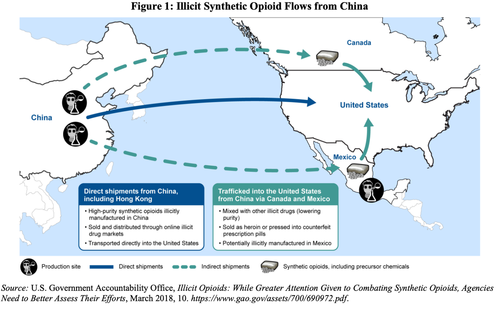
Paul Murphy from the Financial Times has provided the most straightforward explanation yet of the new Chinese money laundering network fueling America's fentanyl crisis:
First, understand that Chinese nationals are barred from transferring more than $50,000 out of China each year. And yet, as you are surely aware, there are many many Chinese nationals living very comfortable lives in the west, as students perhaps, or tourists, or simply not working.
Now understand that Mexican drug cartels are harvesting untold billions of dollars, in cash, selling drugs in North America — and that the pill of the moment is fentanyl, which kills about 70,000 people a year in the US.
The chemicals to make fentanyl come from China. These are shipped to Mexico by otherwise legit Chinese chemical manufacturers.
In Mexico, the cartels turn the chemicals into pills and smuggle these north across the border, where they are sold for cash — dollar bills that then need to be cleaned.
Murphy continued:
Meanwhile, in New York for instance, there will be a Chinese student attending an educational establishment, where the fees will be circa $66,000 a year, books and extras another $10,000, food and lodging costs of maybe $5,000 a month, or a lot more.
The $50,000 Chinese transfer cap doesn't cover these things, so she will go on WeChat and broadcast a message to her network of friends saying: "I need dollars in New York to meet my outgoings. Can anyone help?"
In due course, someone associated with what is a very efficient Chinese underground banking system will get in touch and tell the student to meet a courier at a preordained time and place, typically a park in Brooklyn. There, the student will be handed a bundle of cash.
Back in China, the parents of the student will then be asked to transfer the same amount of money (plus commission) to an account that will eventually make its way to the chemical company that produced the precursor ingredients for fentanyl, settling the outstanding bill for the Mexican drug cartel.
Murphy explained, "Drug addicts in the US are facilitating the Western education of Chinese youth, as well as helping to fund the lifestyles of other Chinese nations living outside China."
He provided a flow chart showing how the complex laundering system works.
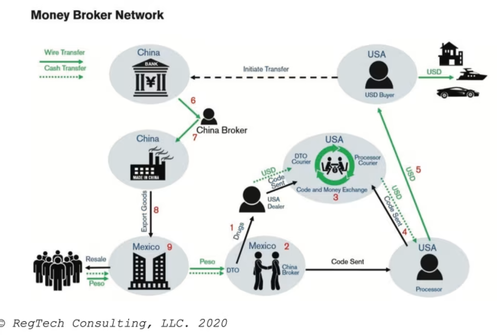 Source: FT Source: FT
In a separate report last week, FT's Joe Miller and James Kynge published an in-depth analysis of the Chinese-Mexican laundering network in a report titled "The new money laundering network fuelling the fentanyl crisis."
The report sheds light on the less understood part of the money laundering operation — the demand for dollars from wealthy Chinese individuals. While capital flight from China is not new, the methods have become increasingly creative, involving chemical companies that, in turn, have fueled America's opioid epidemic.
"The levels of capital flight in the past three years have been quite alarming," one senior Chinese official told FT, adding, "Some wealthy private entrepreneurs are losing confidence in China's future. They feel unsafe, so they find ways to get their money out."
Brad Setser, a former US Treasury official and an expert on global capital flows at the Council on Foreign Relations, estimated that capital flight from China is running at an annualized rate of about $516 billion as of 1Q24. This figure was even higher in the 3Q22, reaching almost $738 billion.
"The whole system of drug trafficking is being sustained by a network of clandestine [Chinese] money brokers," said Giovanni Melillo, the chief prosecutor for Italy's National Anti-Mafia and Terrorism Directorate. His office has been coordinating laundering probes across Italy this past year.
Previous cases of money laundering in the US involving Chinese nationals have raised serious questions about how much Beijing knows about these dark laundering networks. For instance, a recent Wall Street Journal report revealed that Chinese crime groups and drug traffickers used the Toronto-Dominion Bank to launder money from US fentanyl sales.
In mid-April, the House Select Committee on China revealed that the Chinese Communist Party used tax rebates to subsidize the manufacturing and exporting of fentanyl chemicals to overseas customers.
The biggest mystery here is why the Biden administration hasn't taken a tougher stance on China while America's fentanyl epidemic kills as many citizens each year as two Vietnam Wars.
|
|
[Entertainment]
Washington Post hardcover bestsellers
A snapshot of popular books.
Published:7/3/2024 7:09:32 AM
|
|
[9e366c9c-8b15-5dbc-b08f-cd6badbc5c74]
10 movies based on best-selling books
Many movies develop a story already established in a popular book. "Harry Potter," "The Hunger Games" and "The Godfather" were best-selling books before they were movies.
Published:7/2/2024 3:40:22 PM
|
[Markets]
Customized B Vitamin Therapy Could Help Parkinson’s Patients, New Study Suggests
Customized B Vitamin Therapy Could Help Parkinson’s Patients, New Study Suggests
Authored by George Citroner via The Epoch Times (emphasis ours),
A team of Japanese scientists has uncovered an unexpected link between the gut and the brain. The discovery may offer fresh insights into managing a condition that affects 9 million people worldwide.

Deficiency of 2 B Vitamins Linked to Parkinson’s
The study, published in npj Parkinson’s Disease, suggests that vitamin B deficiency may contribute to Parkinson’s development by compromising the intestinal barrier, which typically prevents toxins from entering the bloodstream. Toxins in the bloodstream may lead to neuroinflammation, which is inflammation in the nervous system often associated with neurodegenerative diseases and other neurological conditions.
Researchers used shotgun sequencing to analyze stool samples, allowing them to identify changes in the microbial community and genetic makeup. The study found fewer genes in Parkinson’s patients’ gut bacteria responsible for making vitamins B2 (riboflavin) and B7 (biotin). Both have anti-inflammatory properties and may help counteract the neuroinflammation associated with Parkinson’s disease.
This suggests that B vitamin supplementation could potentially relieve Parkinson’s symptoms and even slow disease progression, Hiroshi Nishiwaki, the lead study author, said in a press release.
Previous research has already shown that high doses of riboflavin contribute to the recovery of some motor functions in Parkinson’s patients. While there’s no specific research on biotin supplementation for Parkinson’s, one study found that high doses of biotin improved symptoms in patients with multiple sclerosis, another neurological disorder.
Customized for Individual Microbiomes
The findings also suggest that vitamin therapy could potentially be customized based on each patient’s unique microbiome profile to delay the onset of Parkinson’s-associated symptoms.
“We could perform gut microbiota analysis on patients or conduct fecal metabolite analysis,” Mr. Nishiwaki said in the press release.“ We could identify individuals with specific deficiencies and administer oral riboflavin and biotin supplements to those with decreased levels, potentially creating an effective treatment,” he added.
The study demonstrates the importance of the gut microbiome in the progression and initiation of Parkinson’s disease, a theory first hypothesized more than 20 years ago, Dr. Raminder Parihar, the director of neuromodulation at the Montefiore Neurological Surgery Movement Disorders Center who was not affiliated with the study, told The Epoch Times.
“This provides another avenue that should be further explored on using supplementation of riboflavin and biotin to slow the progression of Parkinson’s disease and potentially prevent the development of motor symptoms in Parkinson’s disease,” Dr. Parihar added.
Other Vitamins That Could Help
While no vitamins or nutrients can cure Parkinson’s disease, several may help alleviate symptoms or reduce risk. They include:
Dr. Parihar noted that some vitamins may interfere with levodopa, a drug commonly prescribed to Parkinson’s patients. Iron, for example, can affect the absorption of levodopa if taken simultaneously. He recommends taking iron supplements an hour after levodopa to allow for proper absorption.
Consult a health care professional before starting any supplements, as they may interact with medications or have side effects. While these vitamins and nutrients show potential benefits, they should not replace standard medical treatment for Parkinson’s disease.
|
[Markets]
You Keep Using The Term 'Authoritarian'...
You Keep Using The Term 'Authoritarian'...
Authored by Jeffrey Tucker via The Brownstone Institute,
You know the term “authoritarian.” You think you know what it means.
An authoritarian dad, boss, or government says: my way or the highway. They are forever barking orders and see compliance as the answer to all human problems. There is no room for uncertainty, adaptation to time and place, or negotiation. It’s ruling by personal dictate while tolerating no dissent.
To be authoritarian is to be inhumane, to rule with arbitrary and capricious imposition. It can also mean to be ruled impersonally by a machine regardless of the cost.

Sounds like a conventional government bureaucracy, right? Indeed. Think of the Department of Motor Vehicles. Think of the Environmental Protection Agency and the Department of Energy which are right now issuing edicts that will end in the ability of your washing machine to clean your clothes and your car to go the distance.
They have been doing this to us for many decades, with or without the permission of Congress or the president. The agencies have become literally out of control in the sense that no one can control them.
Any society managed by a large and intrusive bureaucratic machinery is necessarily authoritarian. A government that is not authoritarian is necessarily limited in size, scope, and range of power.
Let’s say you have a political leader who has routinely called for less in the way of authoritarian rule by bureaucracies. He intends to use whatever power he has to curb the autonomous rule by administrative bureaucracies and subject them more to the wishes of the people, who should ideally be in charge of the regime under which they live.
Such a leader would not be called an authoritarian. He would be called the opposite, an emancipator who is trying to dismantle authoritarian structures.
If all of the above makes sense to you, try to make sense of this news story in the New York Times. It’s about the growing efforts on the part of many activists to resist a second term of Donald Trump.
In passing, the story says: “If Mr. Trump returns to power, he is openly planning to impose radical changes — many with authoritarian overtones” including “making it easier to fire civil servants.”
The story quickly adds that he intends to replace the fired employees with “loyalists.” Maybe. But consider the alternative. The president is supposed to be ostensibly in charge of 2 million plus bureaucrats that are employed by 400-plus agencies in the executive branch — but they don’t actually have to carry out the policies of the elected president. They can in fact completely ignore him.
How is this compatible with either democracy or freedom? It is not. There is nothing in the Constitution about a vast army of bureaucrats who rule behind the scenes that is in no way reachable or manageable by elected representatives.
The attempt to pull back, rein in, and otherwise do something about this problem is not authoritarian. It is the opposite. Even if “loyalists” replaced the fired employees, that would be an improvement over a system of government in which the people truly have no control at all.
Two years into Trump’s first term, the administration came to figure out that this was a problem. The administration intended some dramatic turns in policy in a number of areas. All they experienced was dogged resistance from people who believed they and not the elected president were in charge. Over the next two years, they undertook many efforts to at least solve this problem: namely, the president should be in charge of the government that falls under his jurisdiction.
This only makes sense. Imagine you are the CEO of a company. You discover that the main divisions that actually run the company care nothing about what you say and cannot be fired even if you demand it, and yet you are personally held responsible for everything these divisions do. What are you going to do?
It is not “authoritarian” to unseat or otherwise attempt to gain control over that for which you are held responsible, professionally or politically. That is truly all that the Trump people are suggesting. This is nothing other than a Constitutional system: we are supposed to have a government by and for the people. That means that the people elect the administrator of the executive branch. At a minimum, the winner of the election needs to be able to have some influence over what the agencies in the executive branch do.
And for suggesting this and trying to make it happen, Trump is called an authoritarian. Prepare yourself: this will be said millions of times between now and November and following. Can the mainstream media just flat-out change the meaning of a term like this? They can but there is also every reason to push back and not let it happen.
Language is a human construct. The more vibrant and fast-moving society is, the more the language changes. That can be a wonderful thing. In fact, one of my favorite books to read in off-hours is H.L. Mencken’s The American Language, written by this genius when he was otherwise censored for his views in wartime.
It’s a marvelous chronicling of the evolution of American usage, published in 1919, but oddly pertinent even today, applicable to the dwindling number of people who can still form coherent sentences.
When it comes to vocabulary, there are two schools of thought broadly speaking: prescriptivist and descriptivist. The prescriptivist view is that words have embedded meanings that you can trace from other languages and should be used as intended. The descriptivist approach sees language as more a living experience, a tool of utility to make communication possible, in which case anything goes.
As Americans, we mostly accept the descriptivist outlook but this can go too far. Words cannot mean literally anything, much less the opposite. But this is exactly what is happening. It’s the same with the word “democracy,” which is supposed to mean the people’s choice, not whatever elites dish out to us. If Trump is the choice, so be it. That is the unfolding of democracy.
If we want the president to be the CEO of the executive branch of government — and that’s a pretty good description of what the US Constitution establishes — then the administration ought to have that managerial authority. If you don’t like it, take it up with the Founders.
Again, any society managed by a large and intrusive bureaucratic machinery is necessarily authoritarian. A government that is not authoritarian is necessarily limited in size, scope, and range of power.
Any one president who takes action to curb the power and reach of arbitrary authority is not an authoritarian, but rather one who seeks to give authority back to the people. Such a man would be an emancipator, even if everyone said otherwise.
|
[Markets]
Futures Jump After Biden's Disastrous Debate, Core PCE Looms
Futures Jump After Biden's Disastrous Debate, Core PCE Looms
Futures are higher led by small caps with tech stocks also mostly higher, as markets start pricing in a Trump presidency following what even Bloomberg admitted was a "disastrous" debate performance by Biden which is making Democrats panic. As of 7:45am ET, S&P and Nasdaq 100 futures rose 0.4%, suggesting this week’s rally on Wall Street is set to continue, with both indexes on course for a third quarter of gains amid expectations that signs of more bad economic growth will give the Fed more room to ease policy this year. That said, not even a looming core PCE which will likely show continued easing in prices (May PCE est 0.0% MoM, down from 0.3%, 2.6% YoY, down from 2.7%) is having an impact on bond yields which are notably higher this morning as is the USD as markets take a long, hard look at what inflation will look like under Trump's tariff-ridden regime (spoiler alert: higher). Commodities are mixed: oil and precious metals are higher; base metals are lower. Today's macro focus will be the May PCE release to access the Goldilocks narrative. Survey expects a 0.1% MoM print vs. 0.2% prior; on YoY basis, survey sees the number dropping to 2.6% survey vs. 2.8% prior).
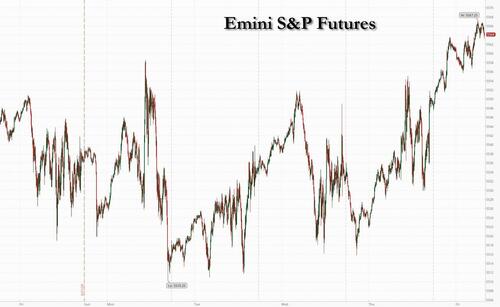
In premarket trading, Nike shares tumbled 15% after the sneaker maker’s Q1 sales outlook missed Wall Street expectations. Following the print, UBS downgraded its recommendation on the stock to neutral, saying the fundamental trends were much worse than analysts had realized. Morgan Stanley also moved to the sidelines, seeing the catalyst for their prior overweight thesis on the stock as “out of view." Megacap tech are mostly outperforming: NVDA +65bp, AMZN +40bp, AAPL +54bp, GOOG/L +48bp. Here are some other notable premarket movers:
- Infinera shares soar 17% after Nokia agreed to buy the maker of digital optical telecommunications equipment for $2.3 billion.
- Trump Media & Technology Group shares jump 7.9% following Thursday’s presidential debate between President Joe Biden and Donald Trump, with the latter coming away looking stronger.
The elephant in the room, of course, was last night catastrophic debate by Joe Biden who ended his presidential campaign in less than 2 hours because as Bloomberg notes, "Biden failed to ameliorate concern about his age in the presidential debate, offering remarks in a hoarse voice and often misspeaking and meandering. A thousand-yard stare on the split screen didn’t help. Donald Trump won the debate, according to 67% of watchers polled by a CNN flash poll. Democrats expressed alarm about Biden’s candidacy, but the president told reporters he intends to stay on the ticket."
And now that the debate is in the history books, traders are scrambling to evaluate what the Trump presidency will look like; conveniently we just published a great primer yesterday.
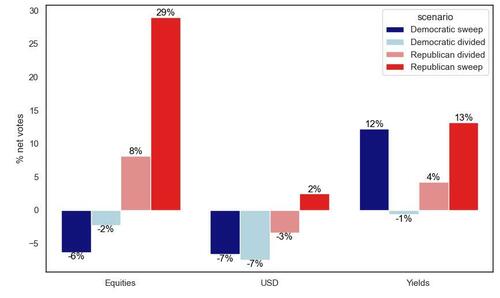
Attention now turns to the week's final event, the Fed's preferred inflation print, the core PCE. “The fundamental question behind the PCE print is whether there will be at least one rate cut this year,” said Mabrouk Chetouane, head of global market strategy at Natixis Global Asset Management. "If it goes in a way the consensus and the Fed aren’t anticipating, then it will be problematic for equity and bond markets alike."
European stocks pared an early gain, weighed down by a decline in France’s equity benchmark ahead of the weekend’s parliamentary election. Investors pulled the most money out of European equity funds in almost four months in the week through Wednesday, according to a Bank of America Corp. note citing EPFR Global data. France’s CAC 40 index dropped 0.5% to a five-month low, and the nation’s bonds underperformed, with the 10-year yield rising to the highest since November. The main concern for investors is that the new French government will drive the country deeper into debt. “We retain a cautious stance on French financial assets due to the high event risks and the slim chances of meaningful fiscal consolidation, regardless of the election result,” Bank J Safra Sarasin strategists led by Karsten Junius said in a note. L’Oreal SA fell after the French beauty-products maker said it expects slower growth in the overall beauty market this year. Puma SE and JD Sports Fashion Plc declined, tracking Nike’s slump. Nokia Oyj shares rose as much as 4.4% after the Finnish mobile-phone company agreed to buy US-listed optical transmission equipment maker Infinera. Here are the other notable European movers:
- Nokia shares rise as much as 4.6% after the Finnish company agrees to buy US-listed optical transmission equipment maker Infinera for $2.3 billion.
- Saab shares rise as much as 5.1% as the defense firm is to join Sweden’s main stock benchmark on July 1, following Nasdaq’s semi-annual changes.
- Keywords Studios shares gain as much as 6.5% to £23.20 after the video game services company said it’s likely to accept an updated offer from EQT Group of £24.50 per share in cash.
- Tyman shares rise as much as 4.6% after the UK construction firm and Quanex agreed on a revised proposal to increase the cash value received by Tyman shareholders through a special interim dividend of 15 pence/share.
- PKO Bank shares gain as much as 1.3% to a record high after shareholders of Poland’s biggest lender approve mgmt’s plan to pay 2.59 zloty/share as dividend from 2023 profit.
- Ercros shares climb as much as 13% to €3.93 after Esseco Industrial launched a voluntary, competing public tender offer for the shares in the industrial company.
- L’Oreal shares fall as much as 3.7%, declining for a second day after CEO Nicolas Hieronimus flagged slower growth for the beauty market this year as China weakness weighs on sales.
- Adidas shares hold steady in the face of Nike’s sales warning, with Warburg analysts citing a pre-close call held late Thursday by the German sportswear maker.
- Teamviewer shares fall as much as 8.2% on Friday. The firm detected an irregularity in the company’s internal corporate IT environment on June 26, according to a statement on Thursday.
- JD Sports shares slide as much as 6.6% after Nike issued a full-year outlook that missed expectations. Sports apparel retailer peer Puma falls as much as 3.4%.
- Air France-KLM shares drop as much as 7%, hitting a record low, after Barclays downgraded the stock to equal-weight from overweight, citing political instability in France.
- Safestore shares falls as much as 4.8% as Morgan Stanley downgrades the UK storage firm to equal-weight, citing cost pressures and delays to development plans.
Earlier, Asian equities rose, on track for a weekly gain, as the lack of hawkish comments in the US presidential debate offered some respite for Chinese stocks, with traders turning their focus to a key inflation data due Friday. The MSCI Asia Pacific Index gained as much as 0.6%, poised to post its first weekly advance in three. Japan’s Topix index reached its highest level since 1990 due to a rally in financial firms courtesy of the latest plunge in th eyen, while tech heavy-markets such as Taiwan and South Korea also advanced. Hong Kong stock benchmarks recouped early losses and edged away from technical correction territory as traders assessed the debate between President Joe Biden and former President Donald Trump.
In FX, the dollar hovered near an eight-month high, on track for a sixth weekly gain. The greenback initially rose as markets assessed Trump was the victor in the debate. It’s a foretaste of how markets might react to a second Trump presidency, and suggests the US currency could be a major beneficiary. Meanwhile, South Africa’s rand soared 1.5% on renewed optimism the country’s two largest parties are moving closer to a power-sharing deal.
“Markets likely extrapolated today’s debate outcome to the actual election outcome in November,” said Carol Kong, a strategist at Commonwealth Bank of Australia in Sydney. “Trump’s policies are likely to add to inflationary pressures and escalate trade tensions, thereby supporting US interest rates and the safe-haven US dollar.”
In rates, Treasuries retreated, paring gains from the prior session, when lackluster US economic data reinforced speculation the Federal Reserve will cut interest rates this year to prevent a bigger slowdown in the economy. Economists expect the Fed’s preferred inflation gauge, the core PCE Price Index, slowed to an annualized rate 2.6% last month from 2.8%. That would be the lowest reading since March 2021, though it remains above the central bank’s goal for 2% inflation. French bonds also drop, underperforming their German counterparts and widening the 10-year yield spread by 2bps to around 84bps. French, Spanish and Italian EU harmonized CPI rose inline with estimates and prompted little reaction.
In commodities, oil prices advance, with WTI rising 1% to trade near $82.60 a barrel. Spot gold is steady around $2,328/oz.
Looking at today's calendar, the US economic data slate includes May personal income/spending, PCE price index (8:30am), June MNI Chicago PMI (9:45am), University of Michigan sentiment (10am) and Kansas City Fed services activity (11am). Fed speakers scheduled for the session include Daly (8:40am, 12:40pm) and Bowman (12pm
Market Snapshot
- S&P 500 futures up 0.3% to 5,561.00
- STOXX Europe 600 up 0.2% to 513.47
- MXAP up 0.3% to 180.38
- MXAPJ up 0.3% to 566.34
- Nikkei up 0.6% to 39,583.08
- Topix up 0.6% to 2,809.63
- Hang Seng Index little changed at 17,718.61
- Shanghai Composite up 0.7% to 2,967.40
- Sensex up 0.2% to 79,373.31
- Australia S&P/ASX 200 up 0.1% to 7,767.47
- Kospi up 0.5% to 2,797.82
- German 10Y yield little changed at 2.45%
- Euro little changed at $1.0694
- Brent Futures up 0.7% to $86.97/bbl
- Gold spot up 0.1% to $2,329.85
- US Dollar Index up 0.12% to 106.03
Top Overnight News
- The IMF has urged the US to “urgently” address its mounting fiscal burden, as it took aim at the tax plans of both presidential candidates just hours before their first electoral debate. FT
- Japan’s economic data has a (slightly) hawkish bias, with higher industrial production for May (+2.8% M/M vs. the Street +2%) and a slightly firmer core Tokyo CPI for June (+1.8% vs. the Street +1.7%). RTRS
- Apple’s China iPhone shipments rose 40% in May, off the previous month’s pace of growth despite steep discounts. BBG
- NKE down 15% pre mkt reported a miss on FQ4 sales and provided very weak guidance for F25. WSJ
- Argentina’s Congress approved President Javier Milei’s signature pro-business reforms in a final 147 to 107 vote. Lawmakers also approved the return of income taxes, reversing the Senate’s bid to undo the measure and giving the government breathing room to reach its fiscal targets. BBG
- France heads to the polls for its first round of voting on Sunday with Marine Le Pen’s far-right National Rally party continuing to widen its lead. President Emmanuel Macron’s group trails in third place. BBG
- European inflation expectations ticked down according to the latest ECB survey, including over the next 12 months (from 2.9% to 2.8%) and 36 months (from 2.4% to 2.3%). ECB
- Iran has expanded its most sensitive nuclear production site in recent weeks. And for the first time, some leaders are dropping their insistence that the nuclear program is for peaceful purposes. NYT
- The US, Israel and Ukraine are in talks to supply Kyiv with up to eight Patriot air defense systems, dramatically improving its ability to counter Russian air strikes. FT
US Presidential Debate
- US President Biden said during the first presidential debate that the US economy was falling when Trump came out of the presidency and that the Trump economy rewarded the rich and raised the deficit, while he said that Trump exaggerates and lies about border security in which everything he says is a lie.
- Former President Trump said they had the greatest economy in the history of the US under his administration and had the greatest economy in the world but Biden did something disastrous by encouraging illegal immigrants, while he added that immigrants from everywhere flock to the US because of Biden and are killing US citizens. Trump also said he achieved a lot in the field of economics and that inflation is currently killing the US which became a third-world country under the Biden administration, as well as noted that tariffs will reduce deficits and check countries like China. Furthermore, Trump said there was no terror under his administration and that the world is blowing up under Biden, while he added Iran was broke and Hamas would never attack Israel under his administration, as well as claimed that he would have the war between Russia and Ukraine settled before he takes office.
- CNN poll showed about 67% of debate followers saw Trump as the winner; 81% of registered voters who watched the debate said it had no effect on their choice for President, 5% said the debate made them change their mind on whom to vote for.
- Following the debate, Politico reports that some Democrats were so concerned by Biden's performance that they are discussing replacing him on the ticket; however, the likes of Governor Newsom said that kind of talk is “unhelpful” and “unnecessary”. Additionally, advisors acknowledged that not much is possible unless Biden steps aside.
A more detailed look at global markets courtesy of Newsquawk
APAC stocks were mostly higher heading to month-, quarter-, and half-year end following the positive bias stateside but with gains capped as participants digest a slew of data and await the Fed's preferred inflation gauge. ASX 200 was led higher by tech strength but with upside limited by weakness in miners and materials. Nikkei 225 benefitted from recent currency weakness, while there was also a slew of data releases including mostly firmer-than-expected Tokyo inflation and a return to growth in Industrial Production. Hang Seng and Shanghai Comp. were positive in tandem with the gains in regional peers with catalysts light although there were comments from President Xi who reaffirmed the China opening up message.
Top Asian News
- Chinese President Xi said China will never leave the road of peaceful development and they will continue to expand the system which will become increasingly market-oriented. Xi added that China continues to expand opening up and its door will never close, while it is willing to discuss FTAs with additional developing countries.
- Japan's Finance Ministry announced they are to replace its top currency diplomat Kanda with Atsushi Mimura and replace Vice Minister of Finance Chatani with Hirotsugu Shinkawa although the changes were said to be part of a normal personnel rotation, according to Nikkei and Bloomberg.
- Japanese Finance Minister Suzuki said he won't comment on forex levels and it is important for currencies to move in a stable manner reflecting fundamentals. Suzuki reiterated he is closely watching FX moves with a high sense of urgency and is deeply concerned about excessive, one-sided moves on forex and repeated that rapid FX moves are undesirable.
- Geely Auto (0175 HK) Q1 2024 (CNY): revenue 52.315bln vs. prev. 33.506bln, profit attributable 1.561bln vs. prev. 714mln; Q1 sales volumes +49% Y/Y.
- PBoC says it is to step up the implementation of monetary policies already in place; will keep liquidity reasonably ample. Will guide a reasonable growth of credit.Will keep CNY basically stable. Will keep prices at a reasonable level. Will resolutely prevent overshooting risks. To firmly correct pro-cyclical behavior and prevent the formation and reinforcement of one-sided expectations. Deepen supply-side reform. Remarks which saw USD/CNH drop from 7.2985 to a test of 7.2900, a figure which held. Since, the move has pared marginally back to around 7.2930.
European bourses, Stoxx 600 (+0.3%) are mostly firmer, taking positive leads from a strong APAC session; price action in Europe has been choppy thus far. European sectors are mixed; Energy takes the spot, benefiting from the gains in the underlying crude complex. Consumer Products & Services is the clear laggard, with the likes of Puma (-2.5%) hit following poor Nike results. US Equity Futures (ES +0.2%, NQ +0.4%, RTY +0.6%) are entirely in the green, ahead of US PCE. Nike (-12%) has sunk in the pre-market after it reported a beat on EPS, a miss on Revenue, noted that quarterly sales will fall 10% and warned on weakness in China.
Top European News
- EU leaders agree on the top EU jobs with von der Leyen given a second term as European Commission President, while Portugal's Antonio Costa is to be the new chairman of EU summits and Estonia's Kaja Kallas is to be EU's top diplomat. It was separately reported that French President Macron named Thierry Breton as the French EU commissioner.
FX
- DXY is currently just shy of the 106 mark within a 105.87-106.13 range. Some desks attribute overnight strength in the USD to Trump outperforming Biden in the first tv debate. However, it is likely that ongoing upside in USD/JPY also played a role.
- USD/JPY has printed another multi-decade high at 161.27 with jawboning from Japanese officials and personnel adjustments unable to stop the rot for the currency. Officials in Japan will be hoping for a soft outturn for US PCE data today after Tokyo CPI picked up on a headline and core basis overnight. Currently flat on the session and holds around 160.70.
- EUR/USD is slightly softer and back on a 1.06 handle but within yesterday's 1.0676-1.0726 range. Asides from the fallout from the US PCE data, attention is increasingly turning towards the weekend risk associated with the French election.
- GBP is flat vs. the USD as the final release of Q1 UK GDP unable to instigate much in the way of price action. For now, Cable is tucked within yesterday's 1.2612-70 range.
- Antipodeans are both falling victim to the broadly firmer USD. AUD/USD a touch softer but largely in consolidation mode having not strayed from a 0.66 handle since June 17th.
- PBoC set USD/CNY mid-point at 7.1268 vs exp. 7.2727 (prev. 7.1270).
Fixed Income
- USTs came under pressure in APAC hours as the US election debate got underway. A debate which saw Biden perform particularly poorly with the odds of a Trump presidency lifting. Currently trading around 110-05 ahead of US PCE.
- Bunds were initially lower in tandem with broader weakness in Treasuries, and was fairly unreactive to French/Spanish inflation metrics thereafter. Currently lower by around 16 ticks and trading within Thursday's 131.68-132.19 bounds.
- OATs underperform ahead of Sunday's legislative first round election which has caused the OAT-Bund yield spread to widen to above 84bps.
- Gilt price action has been following peers, within initial underperformance on the back of the upwardly revised UK Q1 GDP figures.
Commodities
- Crude continues to climb. Upside which is a continuation of Thursday's marked gains for the complex, which began without clear or fresh fundamental catalysts. Brent higher by just under USD 1/bbl, and sitting above USD 86/bbl.
- Spot gold is flat, in what has been a rangebound and quiet session for the complex awaiting impetus from US PCE. XAU currently sits just under USD 2330/oz, with its 50 DMA at USD 2337/oz.
- Base metals are entirely in the green benefitting from the broadly positive risk tone, though with gains capped as participants await US PCE.
Geopolitics: Middle East
- "US Pentagon is moving military assets near Israel and Lebanon to be ready to evacuate Americans", via Walla's Elster citing NBC.
- US is to release part of suspended bomb shipment to Israel with the US and Israel discussing the release of a 500-pound bomb shipment to Israel, while the Biden administration is also reviewing another part of the shipment which includes 1,800 and 2,000-pound bombs, according to Axios.
- US official said the Pentagon is moving US military assets close to Israel and Lebanon as it prepares to evacuate Americans in Israel and Lebanon if the fighting intensifies, according to NBC.
Geopolitics: Other
- US Deputy Secretary of State Campbell raised serious concerns regarding China’s destabilising actions in the South Sea in a call with China's Executive Vice Foreign Minister Ma Zhaoxu.
US Event Calendar
- 08:30: May PCE Price Index MoM, est. 0%, prior 0.3%
- May PCE Price Index YoY, est. 2.6%, prior 2.7%
- May Core PCE Price Index MoM, est. 0.1%, prior 0.2%
- May Core PCE Price Index YoY, est. 2.6%, prior 2.8%
- 08:30: May Personal Income, est. 0.4%, prior 0.3%
- May Personal Spending, est. 0.3%, prior 0.2%
- May Real Personal Spending, est. 0.3%, prior -0.1%
- 09:45: June MNI Chicago PMI, est. 40.0, prior 35.4
- 10:00: June U. of Mich. Sentiment, est. 66.0, prior 65.6
- June U. of Mich. Current Conditions, est. 64.0, prior 62.5
- June U. of Mich. Expectations, est. 68.0, prior 67.6
- June U. of Mich. 1 Yr Inflation, est. 3.2%, prior 3.3%
- June U. of Mich. 5-10 Yr Inflation, est. 3.1%, prior 3.1%
- 11:00: June Kansas City Fed Services Activ, prior 11
Central Bank Speakers
- 06:00: Fed’s Barkin Gives Keynote Speech
- 08:40: Fed’s Daly on CNBC
- 12:00: Fed’s Bowman Speaks in Moderated Q&A
- 12:40: Fed’s Daly Speaks on AI, Workforce
DB's Jim Reid concludes the overnight wrap
We go to press this morning just after the first US presidential debate of the election between Joe Biden and Donald Trump. The general consensus among pundits is that Trump had the better performance, and a CNN flash poll of registered voters watching the debate found viewers thought Trump won by a 67%-33% margin. There are just two debates scheduled in this campaign, with the second on September 10, ahead of the election on November 5. Going into the debate, the national polls were neck-and-neck, and Trump only had a 0.2pt lead in FiveThirtyEight’s polling average, so it’ll be interesting to see if the debate affects that.
Staying on politics, it’s going to be an important weekend for markets ahead, as the first round of the French legislative election is taking place on Sunday. Clearly we won’t know the full results until the second round on July 7, but it will offer a better sense of the likely outcomes in terms of who can reach a majority, if anyone. As it stands, the latest Ifop poll yesterday showed Marine Le Pen’s National Rally on 36%, ahead of the left-wing alliance on 29%, and President Macron’s centrist group on 21%. In terms of seats projected in the National Assembly, that poll suggests the National Rally and its allies would end up with 220-260 seats, falling short of the 289 necessary for a majority. Alongside that, the left-wing alliance would get 180-210 seats, and President Macron’s group would be on 75-110. As a reminder, my team published a two-part guide to the French elections running through the situation and the implications for Europe (links here and here).
Ahead of Sunday’s first round vote, French assets have continued to lose ground, with the 10yr Franco-German spread closing above the 80bp mark for the first time since 2012. And in absolute terms, the 10yr French OAT was up +3.8bps to 3.26%, which is its highest level since November. That came as Germany’s finance minister Lindner said that “A strong intervention by the ECB would raise some economic and constitutional questions”. Equities also fell back, with the CAC 40 down -1.03%, meaning it’s now less than 0.4% above its low point a couple of weeks ago.
The French election is likely to be the main focus by Monday, but before we get to that, today will bring several important inflation numbers. In particular, we’ve got the US PCE inflation report for May, which is the measure that the Fed officially target, and hence is closely followed in markets. Our US economists think that core PCE should increase by +0.17%, based on the CPI and PPI data that we’ve already got. In turn, that would cut the year-on-year rate to 2.63%, the lowest in over three years. So that would be very promising news from the Fed’s perspective, but it’s clear they remain cautious given the inflation spike we had back in Q1 of this year. Indeed, that was echoed by Atlanta Fed President Bostic, who said that “It’s going to be a much longer experience and that’s why I’m preaching patience”.
US Treasuries rallied ahead of that release, as we got another batch of underwhelming data, which is increasingly becoming a theme of late. For instance, the continuing jobless claims rose to 1.839m in the week ending June 15 (vs. 1.828m expected), which is their highest level since November 2021. Alongside that, the weekly initial jobless claims over the week ending June 22 came in at 233k (vs. 235k expected). That was a bit lower than last week, but it still pushed the 4-week moving average up to 236k, which is the highest it’s been since September. That adds to several metrics suggesting that the labour market could be weakening, not least given the unemployment rate was up to 4.0% in the May jobs report. So evidence of loosening in the labour market even if there are enough one-offs in the data to give it a pass for the moment. Staying with the weaker data theme, core capital goods orders for May disappointed, falling -0.6% (vs. +0.1% expected), while a gauge of pending home sales fell to its lowest level since the start of the series in 2001. The Atlanta Fed’s GDPNow estimate for Q2 was cut to an annualised rate of +2.7% yesterday, having been at +3.0% previously. This is still decent but US data is increasingly surprising on the downside, so economic momentum still seems to be rolling over a bit, albeit from high levels.
That backdrop cemented investors’ conviction that the Fed would cut rates by the end of the year, with the amount of cuts priced in by the December meeting up +2.0bps to 45bps. In turn, that meant 10yr Treasury yields fell -4.3bps to 4.29%, and the 2yr yield was also down -3.5bps to 4.71%. Over in Europe, yields were steadier for the most part, with the 10yr bund yield down just -0.3bps. However, the consistent theme was wider spreads, with yields on French OATs (+3.8bps) and Italian BTPs (+3.3bps) both seeing larger moves.
For equities, there was a similar divergence on either side of the Atlantic. In the US, that saw the S&P 500 (+0.09%) close just shy of its all-time high, with the Magnificent 7 (+0.41%) closing at a new record. Nvidia (-1.91%) underperformed again, weighed down after underwhelming projections from chipmaker Micron (-7.12%) the previous evening. Elsewhere, the small cap Russell 2000 rose +1.00%, moving back into the green for 2024 with a +0.56% YTD advance (vs. a +14.95% gain for the S&P 500). Meanwhile in Europe, the STOXX 600 (-0.43%) lost ground for a third consecutive session, with more pronounced losses among southern European countries, including the FTSE MIB (-1.06%) and the IBEX 35 (-0.72%).
Overnight in Asia, the Japanese Yen has continued to weaken, and is currently trading at 161.07 per US Dollar, which would be its highest closing level since 1986. In the meantime, equities have continued to advance, with gains for the Nikkei (+0.76%), the CSI 300 (+0.64%), the Shanghai Comp (+0.98%), the Hang Seng (+0.56%) and the KOSPI (+0.26%). In addition, the TOPIX (+0.72%) is currently on course to close at its highest level since 1990. Looking forward, US equity futures are also pointing higher, with those on the S&P 500 up +0.23%.
In other political news, Ursula von der Leyen was nominated by EU leaders for a second term as President of the European Commission. That was part of an agreement that saw former Portuguese PM Antonio Costa chosen as President of the European Council, and Estonia’s PM Kaja Kallas as the EU’s High Representative for Foreign Affairs and Security Policy. However, Von der Leyen will still need to win a majority of votes in the new European Parliament, which is held by secret ballot, and in 2019 she only exceeded that by nine votes. The High Representative also needs agreement from the President-elect of the European Commission, and later on the entire Commission as a whole (including the President, High Representative and other commissioners) face a vote of consent in the European Parliament.
Finally we also saw the third estimate of US Q1 GDP just as we hit the end of Q2 for markets today. This release had a few revisions. On the bright side, the Q1 reading was revised up a tenth, and now shows growth at an annualised +1.4%. However, both headline and core PCE were revised up a tenth as well, with core PCE inflation now seen at an annualised +3.7% in Q1.
To the day ahead now, and data releases from the US PCE inflation reading for May, the Canadian GDP report for April, the flash CPI releases for June from France and Italy, along with German unemployment for June. From central banks, we’ll hear from the Fed’s Barkin, Bowman and Daly, along with the ECB’s Villeroy.
|
|
[World]
Another 80 Pro-Palestinian Protesters Have the Chargers Against Them Dropped
Published:6/27/2024 2:49:03 PM
|
|
[fiction]
10 Must-Read Books to Check Out While You Wait for Sally Rooney’s New Novel
Rooney's 'Intermezzo' comes out in September; lose yourself in these books while you wait.
Published:6/26/2024 2:09:21 PM
|
|
[Entertainment]
Washington Post paperback bestsellers
A snapshot of popular books.
Published:6/26/2024 7:09:00 AM
|
|
[Uncategorized]
Historic Heatwave
“we live in an unscientific age in which almost all the buffeting of communications and television-words, books, and so on-are unscientific. As a result, there is a considerable amount of intellectual tyranny in the name of science.” Richard Feynman
Published:6/23/2024 11:37:21 PM
|
[Markets]
"This Is Going To Be Far Worse Than The Great Depression..."
"This Is Going To Be Far Worse Than The Great Depression..."
Via Greg Hunter’s USAWatchdog.com,
Financial writer and precious metals broker Bill Holter has been documenting all the unpayable debt that has been building up in the financial system like cancer.

The latest black hole of default is coming from a big bank in Japan. Norinchukin Bank is selling $63 billion in Treasuries and other sovereign bonds to stay afloat. Then there is recent news announced by the FDIC that 63 US banks (the names are being kept secret) have more than $500 billion in losses, and let’s not forget about the trillions in losses sitting on the books of European banks ready to suck the world into a black debt hole. This is just a few of many on a long list of destabilizing problems that can tank the entire over-indebted financial system.
Holter warns, “The list is so long..."
"it could be a banking problem. It could be a derivatives problem. It could be a derivatives problem in the stock market, the bond market and you could see a failure to deliver in silver. Some type of warfare could crash the system. You could see warfare in Ukraine, Israel or Tiawan.
The system is so unstable, at this point, it could be anything that could bring it down.
Unpayable debt is not just a US problem. This is all over the world. Central banks are having to issue huge amounts of debt because we are in the exponential decay phase. We are exactly where Richard Russell said we would be 20 years ago. It’s inflate or die, and the only way to inflate is to create more money supply.”
Add to that the $10 trillion in debt the US Government has to roll over by the end of the year. Meanwhile, the US government piles on $1 trillion in new debt every 100 days. What could go wrong?
Holter said the last time he was on USAW that there was a little less than a 50% chance we would even have an election. Now, he predicts it is more likely there will be no 2024 Presidential Election. Holter says:
“There is no way the system, as it is now, survives. It’s mathematically impossible. So, if it is mathematically impossible, are they going to blow smoke . . . up until the day it blows up? Or are they going to do something to blow it up and then say our programs and policies were working except for XYZ this or whatever.
They have to kick the table over. They cannot allow the table to fall over on its own because then there is going to be finger pointing. To avoid the finger pointing, they have got to kick the table over.”
Holter also thinks gold is going to exponential numbers to back all the debt the USA has.
If you go with the 8,030 tons of gold the government claims is in Fort Knox, you will need a dollar price of gold at “$125,000 per ounce for 100% gold backing of the dollar.”
Holter also says, “The dollar is being pushed out of the global financial system..."
"Demand for dollars is shrinking at a time when borrowing demand is rising.” This is a going to be a disaster for America and anyone holding dollars in the future.
In closing, Holter says, “The financial collapse that is coming will be worse than anything we have ever experienced..."
"This is going to be far worse than the Great Depression simply because society itself is far worse. . . . Back in the Great Depression, you had neighbors helping neighbors. Today you will have neighbors picking on other neighbors like vultures.”
There is much more in the 51-minute interview.
Join Greg Hunter as he goes One-on-One with financial writer and precious metals expert Bill Holter for 6.22.24.
* * *
To Donate to USAWatchdog.com Click Here
Bill Holter’s website just keep getting more and more viewers, and it’s still free. It’s called BillHolter.com.
|
[Markets]
Biden Admin Asked Amazon To Hide Vaccine-Critical Books During Pandemic
Biden Admin Asked Amazon To Hide Vaccine-Critical Books During Pandemic
Authored by Steve Watson via modernity.news,
The Biden Administration pressured Amazon to hide books for sale on its platform that were critical of vaccines during the pandemic, it has been revealed.

The findings were presented by the House Judiciary Committee and Subcommittee on the Weaponization of the Federal Government in documents that show Amazon reduced the visibility of titles that the government deemed overly critical of big pharma shots.
The documents show that some books were simply generally critical of vaccines, with several written by medical professionals. Some were even just reviews of scientific studies.
The Federal government compiled a “Do Not Promote” list, to which more than 40 titles were added.
In a series of X posts, Judiciary Committee Chair Rep. Jim Jordan explained how internal emails from Amazon contain employees revealed that “the impetus for this request is criticism from the Biden Administration.”
They even targeted a children’s book that they deemed to be too friendly toward the unvaccinated.
“Don’t let the Biden Admin tell you that their censorship campaign was about concerns of misinformation going viral on social media,” Jordan wrote.
He further urged “They were going after BOOKS too. This is–and always has been–about suppressing difavored views, not purported challenges of new technologies.”
There is a deep irony attached to this story in that the Biden Administration has repeatedly accused Republicans of trying to ‘ban’ books nationwide.
While in almost all of these cases, the likes of Florida governor Ron DeSantis were expressing opposition to school libraries carrying sexually explicit books aimed at children, it turns out the Biden Administration was actively working to censor books for adults.
Your support is crucial in helping us defeat mass censorship. Please consider donating via Locals or check out our unique merch. Follow us on X @ModernityNews.
|
[Markets]
Von Greyerz: As Dominoes Fall, Gold Will Stand Stronger Than Ever
Von Greyerz: As Dominoes Fall, Gold Will Stand Stronger Than Ever
Authored by Egon von Greyerz via VonGreyerz.gold,
At the end of a monetary era a number of dominoes will keep falling, initially gradually and then suddenly as Hemingway explained when asked how you go bankrupt.
Some of the important dominoes the world will see falling are: Political, Geopolitical, Currency, Debt and Investment Assets.
The consequences will be unthinkable – Social Unrest, War, Hyperinflation, Deflationary Implosion of Assets, Debt Defaults and much more.
But when things settle down, there will also be offsetting forces such as the emergence of powerful BRICS nations often backed by commodities.
Gold will play a major role during this process. Both central banks, sovereign wealth funds and investors will turn to gold as the most stable part of a crumbling system. This will lead to a fundamental revaluation of gold. As more gold cannot be produced, increased demand can only be satisfied by higher prices.
The likely result will be a revaluation of gold by multiples.
FALL OF THE LEADERSHIP DOMINO
Inept leaders and lack of statesmen are the typical prerequisites for these periods and thus one of the falling dominoes.
I have always argued that a country gets the leaders it deserves.
As we get to the end of one of the worst periods in history, both financially and morally, weak leadership exists in most major Western economies.
So, let’s look at the motley crew of world leaders and their unpopularity.
Political leaders will not only be thrown out at elections but also before their period is finished.
The recent European election is a typical example of a failed system. Most ruling parties are being rejected and in many cases parties on the right gain popularity.
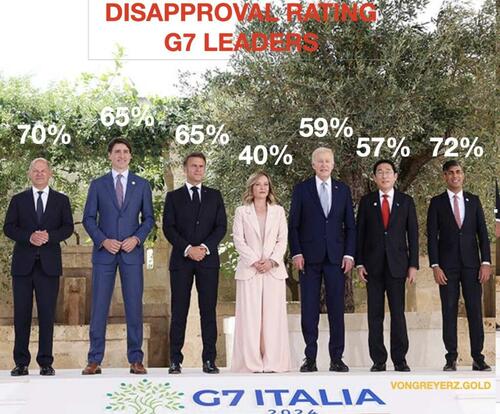
Just look at the picture above from the recent G7 meeting in Italy. With the exception of Italy’s Meloni, the remaining G7 leaders have disapproval ratings of 57% to 72%.
With elections in the UK & France this year, the ruling parties are guaranteed to lose. The French Presidential election is not until 2027 so Macron could be a lame duck for 3 more years. The French people are unlikely to accept that and might force him out before then.
Whoever is elected in France, the powerful trade unions are likely to bring the country to a halt.
UK’s Sunak is one of Britain’s most ineffective leaders in history. But the new Labour Prime Minister, Kier Starmer was not even seen to stand a chance 2-3 years ago. He will not be voted in, but Sunak will be voted out by the people. Next will be a very dark period in UK history with high taxes, high debt, poor leadership and political instability and hard times.
The US situation today is even worse, with a president who seems incapable of taking any decisions. Instead, the US is led by an unelected and unaccountable group of neocons who tell the president what to say and what to do. But even that is difficult for Biden to execute. Just his recent appearance in Italy at the G7 meeting confirms that.
He can obviously not be blamed for being senile. But he should no longer have the ultimate power.
The US election is likely to be a disaster. Looking at the poor health of Biden, it is unlikely that he will stand for re-election in November. Kamala Harris will clearly not stand for election. It would not be surprising to see Hillary Clinton ushered in as the Democratic candidate. Although Trump is loved by around half of the people, he is hated by the other half and thus a very divisive choice. And a rerun of the Clinton – Trump election could easily lead to trouble or insurgence in the US whoever wins.
Germany’s Scholz’ coalition might not make it to the 2025 election due to its unpopularity and the decline of the German economy.
In summary, the political stage will be a total mess in coming years and lack of strong leadership will not only bring political unrest but also social unrest.
FALL OF THE CURRENCY & DEBT DOMINOES
The currency domino has been falling ever since Nixon closed the gold window in 1971.
With high spending and deficits on top of Debt to GDP above 100% in many nations, the West in particular is facing a very dark period with galloping debt growth and collapsing currencies.
This will lead to debt defaults, bank defaults, more printing, higher interest rates and still higher deficits.
All currencies will accelerate their debasement process.
In such a scenario, there will be no winner. It is possible that the dollar due to demand will be slightly stronger than other Western currencies at least for a period.
But a temporary relative strength of the dollar should be totally ignored. There is no prize for coming 2nd or 3rd to the bottom. All currencies will lose dramatically in real terms which means against gold.
We must remember that we are now in the final collapse of the current monetary system. Since 1971 all currencies have lost 97-99% in real terms which means GOLD!
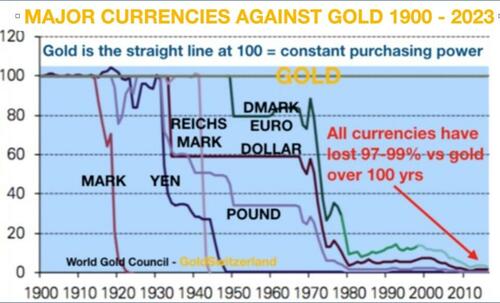
The final 1-3% fall (100% from now) will take place in the next 3-8 years. So, yet another currency system will be laid to rest.
This one lasted since 1913 so a bit over a century. Its demise was predestined the day it was born. It was only a matter of time. As always in history, the consequences will be much more far reaching than just the death of Money.
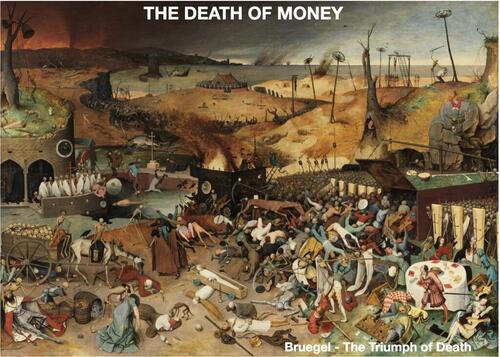
Debt and currency collapses happen hand in hand. They are partners in crime and are the inevitable consequence of sustained government deficit spending.
After a period of unlimited currency printing, the financial system will fail partly or totally.
Political and social unrest also follows, possibly civil war.
Governments under economic pressure normally start a war or escalate an existing one to divert the attention from domestic problems. A war is also a good excuse for printing more money.
FALL OF THE ASSET DOMINO
Initially there will be high inflation, possibly hyperinflation and high interest rates. Thereafter as the system implodes, inflated asset prices in stocks, bonds, property etc will crash by 50-100% in real terms.
Most sovereign bonds (if they are printed) will serve best as wallpaper.
I rate the chances of this chain of events taking place as very high, especially in the West.
Financial, economic, political and social collapses of this kind are nothing new as they have happened throughout history, albeit not on a scale of this magnitude.
FALL OF THE NUCLEAR WAR DOMINO
Will we have a nuclear war?
We obviously don’t need to worry about this option since if we have a global nuclear war, there will be very few, if any, people left on earth.
As the world potentially moves as close to a nuclear war as it can without starting one, we must ask ourselves, WHO IS RUNNING THE WORLD?
Well, no one individual of course. But the US leadership is probably the main contender when it comes to dictating, at their whim, to any country in the world.
This can be starting wars in a country which is no threat to the US. It can be controlling the global financial system through the dollar or regulating the banking system via edicts like FATCA requiring the world to report any dollar transaction to the US authorities. It can also involve coups in countries which the US leadership finds unacceptable or even eliminating enemies.
It can be sanctions or freezing of assets against countries whose actions the US leadership disapprove. The list is endless.
What is interesting is that the US people never has a say in any of these decisions. All the actions above and many more are taken by the US president and his advisors with zero accountability to the people.
None of that would be possible in for example Switzerland where people power rules through direct democracy.
What the world should ask itself is: How does it solve the extremely serious situation the world is in?
I am not talking about the Ukrainian war which, as Trump has indicated, could be stopped within a few days if the US stopped sending weapons and money to Ukraine.
Putin recently made it clear that what Russia wants is to keep the Russian speaking areas of Eastern Ukraine and no NATO membership for Ukraine. But no one is interested in exploring this.
Instead, there has just been a peace conference in Switzerland where neither Russia nor China was present. Such a conference is a total waste of time and money.
Without two of the mightiest military and economic powers on earth, one of which (Russia) is directly involved in the war, this conference will achieve absolutely nothing.
This is just posing for the cameras with a bland meaningless statement at the end.
So instead of these useless conferences, the leaders of China, Russia and the USA should get together to end the Ukraine war and then tackle the real problems facing the world like poverty, famine, crime, drugs, debt etc, etc.
Imagine what the combined brain power and resources of these countries could achieve assisted by many more nations.
But sadly, that is a dream that is unlikely to be realised.
Much easier to print money and start a war rather than to find REAL and sustainable solutions to the major global problems that the world is facing.
So, world leaders have a choice – pick up the phone and talk to your fellow leaders or start a war.
What sane leader would choose nuclear war before a small loss of ego and peace?
WEALTH PRESERVATION FOR FINANCIAL SURVIVAL
So, what can investors do to protect themselves?
Some DONT’S are obvious, like:
Don’t keep most of your wealth in a fragile banking system whether in cash or in securities –
With many banks likely to default, it might take too long before your assets are released, if ever!
Bail ins or forced investments are likely in government securities at low interest rates and for extended periods like 10 years or more.
Don’t hold sovereign bonds –
Many governments will default.
Don’t bet on inflation reducing your debt –
High interest rates or indexation of loans might make it impossible to repay borrowings.
Don’t forget that stocks have been inflated by massive credit expansion which will end.
The list of don’ts in the biggest global debt and asset bubble in history and is of course endless.
So, some DOs could be more useful –
Do hold a lot of physical gold and some physical silver in safe jurisdictions like Switzerland and possibly Singapore outside the banking systems –
Precious metals must be held in very safe non-bank vaults, in your name with direct access to the metals.
To minimise confiscation or freezing of your metals, best to keep them outside your country of residence.
Hold a meaningful amount of physical gold and silver –
Most of our clients who are HNW wealth preservation investors have more than 20% of their investment assets in gold and with a smaller percentage in silver due to its volatility.
Gold is up 9-10x in this century in most currencies, still.
THE REAL MOVE IN GOLD AND SILVER HASN’T STARTED YET
The move away from the dollar as the global trading currency is likely to accelerate over the next few years.
BRICS countries are whenever possible settling bilateral trading in their local currencies with gold as the ultimate settlement money. This will be a gradual move away from the dollar. At some point the move will accelerate as the need for trading via another nation’s currency will be seem superfluous, especially since final settlement can be in gold.
As I have made clear many times, the US confiscation of Russian assets will lead to central banks no longer holding dollar reserves but instead gold will be the only acceptable reserve asset.
The move by Central Banks to gold as a reserve asset will lead to a fundamental revaluation of gold over the next few years to a price which will be multiples of the current price.
The major increase in demand can only be satisfied by higher prices and not by more gold since the world cannot produce more than the current 3,000 tonnes p.a.
In my 55-year working life I have experienced 2 major bull markets in Gold.
The first one was from 1971 to 1980 with gold up 25X from $35 to $850.
The second one started in 2001 at $250 and has only started a move which will reach multiples of the current price.

But my 55 years of gold history is just over 1% of the long-term bull market in gold.
Since the emergence of the fiat money system, the gold bull market is sadly more a reflection of governments’ mismanagement of the economy leading to ever growing deficits and debts. In such a system, the price of gold mainly reflects the chronic debasement of paper money.
Governments and central banks are gold’s best friend.
They have without fail always destroyed the value of fiat money, by debasing the currency through deficit spending and debt creation.
For example, in the Roman Empire around 180 to 280 AD the Denarius Silver coin went from almost 100% silver content to 0%, replacing the silver with cheaper metals.
This obviously leads to the question, why should anyone hold fiat or paper money?
Well, in a sound economy with no deficits, virtually no inflation and a balanced government budget, holding cash that yields an interest return is absolutely fine.
But the world has not experienced such Shangri-La times since 1971 when Nixon closed the gold window.
Still, even at $2,320 today, gold in relation to money supply is as cheap as in 1970 when it was $35 or in 2000 when the gold price was $300.

WEALTH PRESERVATION AND LIFE’S PRIORITIES
With the falling of the dominoes outlined above, most people in the world will experience a lot more hardship than currently.
For anyone with savings, whether it is $100 or $100 million, wealth preservation should be a top priority. Gold and some silver in physical form safely stored outside the banking system should be an absolute priority.
As we encounter difficult times, helping family and friends is more important than anything else. This will be extremely important in order to deal with the trials which we will all encounter.
And please don’t forget that in addition to family and friends, some of the best things in life are free such as nature, books, music and hobbies.
|
|
[Pride Month]
10 Queer Books by Queer Authors to Read Before Pride Month Ends
What these books have in common is that they share stories of bravery, love and community.
Published:6/21/2024 2:19:12 PM
|
[Markets]
Price Discovery Equals Short Sales
Price Discovery Equals Short Sales
Authored by Douglas French via The Mises Institute,
Price discovery in commercial real estate, which had been frozen while sellers insisted on prices from the good ol’ ZIRP days, is starting to thaw. Real estate giant Related Companies has unloaded the property at 321 W. 44th St., New York City, for less than $50 million, reports Bloomberg.

Not only is that a 67 percent discount from the nearly $153 million that Related Fund Management paid for it in 2018, but also, the lenders, including Canadian Imperial Bank of Commerce, agreed to a “short sale.” For those who have forgotten 2008 or were too young, a “short sale” is when the lender agrees to a property sale for less than the outstanding amount on the mortgage. The owner loses everything, and the lender takes a large loss. In this case, the repayment to the lenders was more than cut in half as the property’s mortgage exceeded $100 million.
Another recent office building sale had Blackstone and its lender agreeing to sell 1740 Broadway for $186 million. Blackstone Inc. bought the building in 2014 for $605 million.
Pacific Investment Management Company (Pimco) expects more regional bank failures due to a “very high” concentration of troubled commercial real estate (CRE) loans on their books, Bloomberg reports.
John Murray, the head of Pimco’s global private commercial real estate team, told Bloomberg’s Laura Benitez that “the real wave of distress is just starting” for lenders to everything from malls to offices.
Ms. Benitez writes, “Contrary to some market expectations, larger banks have been disposing of some of their higher quality assets first to avoid deeper losses, according to Murray.”
That means banks are selling their best assets because they can receive prices at least equal to what they are carrying in loans on their balance sheets. There is no other reason to sell good loans but to generate liquidity.
“As stressed loans grow due to maturities, however, we expect that banks will start selling these more challenged loans to reduce their troubled loan exposures,” Mr. Murray said. Banks will take losses when these loans are unloaded, impairing capital and in some cases leading to bank failures.
Ms. Benitez writes, “The turmoil has been particularly felt among regional banks, which boosted their CRE exposure that in many cases is now worth only a fraction of their value at their peak.”
Not only are banks carrying a collective half a trillion dollars in unrealized losses on securities portfolios, but also, as Ms. Benitez explains, bank commercial real estate loan books are underwater as well.
“The combination of rising rates plus recessionary pressures creates real challenges for commercial real estate, from both a capital markets and fundamentals perspective,” Mr. Murray said.
Real challenges for the banks holding the paper as well.
|
|
[Democrats]
Democratic Dark Money Machine Quietly Adds Another Mystery Group to Its Ranks
It has no website, no employees, and its books are in the care of a powerful green consulting firm with close ties to the White House. It has also flooded Democratic groups with more than $35 million in untraceable cash since 2020, all while evading public detection—until now.
The post Democratic Dark Money Machine Quietly Adds Another Mystery Group to Its Ranks appeared first on Washington Free Beacon.
Published:6/20/2024 4:37:59 AM
|
[Markets]
'Manufacturing Obituaries': Media Falsely Reports Noam Chomsky's Death
'Manufacturing Obituaries': Media Falsely Reports Noam Chomsky's Death
Authored by Brett Wilkins via Common Dreams,
Some popular media outlets and international political figures came under fire Tuesday for falsely reporting the death of U.S. academic and social critic Noam Chomsky, who is fighting to recover in Brazil after suffering a massive stroke last year.
"Chomsky did not die. I just spoke to Valéria, his wife," said Brazilian journalist Cauê Seigner Ameni. "He is well," Valéria Chomsky confirmed to ABC's Chris Looft. Beneficência Portuguesa de São Paulo, a hospital in Brazil's largest city, said in a statement that Chomsky was discharged on Tuesday to continue his treatment at home, according to The Associated Press.
 picture alliance via Getty Images picture alliance via Getty Images
The New Statesman ran—and subsequently deleted—a Chomsky obituary Tuesday following rumors of the 95-year-old's passing. Other outlets including Jacobin kept or tweaked Chomsky obits, with telltale signs like the word "obituary" in their URLs belying their inaccuracy.
Commentators from across the political spectrum also posted reaction—from mournful on the progressive left to gleeful among liberals and right-wingers—to false reports of Chomsky's death.
"Shameful and sad that Valéria Chomsky had to deny news of Noam Chomsky's death over the phone here in Brazil, because a bunch of places decided to publish pre-written obituaries and posts at the first online rumor," Brazilian academic Sabrina Fernandes said on social media.
"Since no outlet that reported the death decided to post an errata, it only got worse," she added, condemning "the online scoop and attention industry... waiting... like vultures."
Responding to numerous reports of Chomsky's death in the Latin American corporate media, Mexico City-based Rutgers School of Communications professor Andrew Kennis—whose book Digital Age Resistance contains a foreword co-authored by Chomsky—told Common Dreams that "it is both a fitting and cruel irony that the fundamentally flawed, trillion-dollar-valued, conglomerate-owned, mainstream news media system has once again erred in its ways."
"No, Noam is not dead. Instead, he's struggling to recover with the unflagging dedication of his partner, who transported him the first chance Noam's health permitted her to do so to receive top-rate medical care in Brazil," Kennis added.
Some observers worked the title of one of Chomsky's more than 100 books—Manufacturing Consent, which he wrote with Edward Herman—into their commentary on the false reports.
"Chomsky is NOT dead. If Chomsky was dead, he would be turning in his grave to see how quickly rumors spread and how social media functions," said Croatian philosopher and Chomsky collaborator Srecko Horvat. "He might as well still call it: 'manufacturing obituaries'."
|
|
[Fantasy]
10 of the Best Cozy Fantasy and Science Fiction Reads That Will Help You Escape the World
Cozy books feel like a warm hug, but that doesn’t mean their authors avoid tough topics.
Published:6/15/2024 8:08:15 AM
|
[Markets]
Key Events This Week: Fed, CPI and PPI
Key Events This Week: Fed, CPI and PPI
With the (ridiculously manipulated propaganda) jobs report now in the history books, this week the whole financial world will be focused on Wednesday with two big events occurring: the latest FOMC and CPI (with PPI to follow on day later). Below, DB's Jim Reid previews the first two below but other events this week include NY Fed 1-yr inflation expectations today, UK employment data, US small business optimism and a 10yr UST auction tomorrow, China CPI and Japanese PPI on Wednesday, waking up to a mid-life crisis on Thursday alongside US PPI and a 30yr UST auction, with the BoJ decision and the US UoM consumer sentiment on Friday.
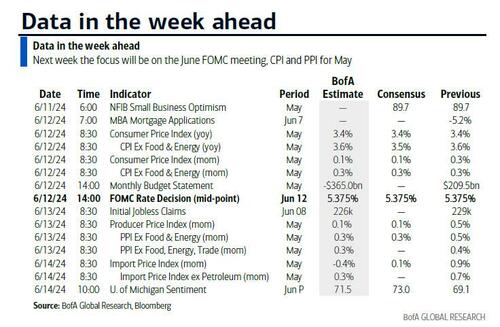
Before we delve deeper, it is fascinating to see the negative reaction of French bond markets this morning after the surprise news last night that Macron has called for snap legislative elections which will take place in two rounds on June 30th and July 7th. This is after his party trailed with 15% in the European Parliamentary (EP) elections with Le Pen's National Rally (RN) winning 32%. Although this was broadly in line with expectations, Macron is likely hoping to win back some momentum and hope a notable part of the EP results were a protest vote and also encourage other centrist parties to help rally round to limit the charge of Le Pen. His other hope would be that if RN have a bigger part in government, their appeal may diminish before the next Presidential elections in 2027. So a big gamble.
In terms of the wider EP elections the main takeaway is that even with the uncomfortable results in France and Germany, the centrist majority is holding as the far-right didn’t outperform expectations in aggregate. As the results have started to materialise the Euro is -0.44% lower as I type, at 1.0753 against the dollar, its weakest level in nearly a month.
Moving forward, Reid previews the main events of the week in more detail now. According to the DB strategist, it's not very often you have a US CPI released on the same day as a FOMC meeting and the former will certainly factor into the latest Fed Summary of Economic Projections (SEP). On Friday, a few US houses who were expecting summer Fed cuts pushed back their projections after the strong payroll number and this release will also influence the tone of the meeting. DB economists believe the new SEP forecasts are likely to revise core PCE inflation higher this year (2.8%), and move the median dot from three rate cuts to two with a desire for optionality for September perhaps the only thing preventing this moving nearer to DB's long standing expectation of a cut only arriving in December. The DB econ team also expects the 2025 median dot to move up by 25bps as well and the long-run dot to 2.75% (with risks it moves even higher).
Powell's press conference will no doubt offer nuances around any changes and will have the ability to put a dovish or hawkish spin on them. At this stage optionality will likely be preferred with little specific guidance.
May's CPI release hours earlier will cast a long shadow over the meeting. The DB Econ team expects headline CPI (+0.12% forecast vs. +0.31% previously) to come in softer than core (+0.27% vs. +0.29%), helped by declining gas prices last month. This would reduce the core YoY rate by a tenth to 3.5%, with the headline remaining steady at 3.4% (in-line with consensus). Under these forecasts the three-month annualized core rate would fall three-tenths to 3.8%, while the six-month annualized rate would remain at 4.0%. Obviously as ever rents will get a lot of attention to see if they are falling as the models suggest they should be and then for PPI on Thursday, the components that feed directly into core PCE (namely health care services, domestic airfares, and portfolio management) will be the main thing to watch.
For the Fed to cut rates in September (unlikely in our eyes), or earlier (only in an imminent crisis), inflation must fall sharply, or employment needs to weaken considerably. For the latter, Friday's payroll suggested that this will be tough to see in the data quickly enough. May's headline (+272k) and private (+229k) payroll gains were well above the +180k and +165k expected respectively with a 0.4% gain in average hourly earnings a tenth higher than expected. The diffusion index (63.4) was the highest level since January 2023 which shows that job growth has broadened out after narrow gains for a lot of the last year.
The other two big events of the week are the Chinese inflation and the BoJ. For the former, current median estimates on Bloomberg suggest the CPI may improve to +0.4% YoY in May from +0.3% in April, with the PPI also coming in higher relative to the previous reading (-1.5% vs -2.5% in April). For the latter, economists expect the target short-term interest rate to remain unchanged but highlights that the focus will be on guidance for JGB purchases. They also see changes including a reduction of the central bank's purchases from the current 6tn yen per month to 5tn yen.
Courtesy of DB, here is a day-by-day calendar of events
Monday June 10
- Data : US May NY Fed 1-yr inflation expectations, Japan May bank lending, Economy Watchers survey, April BoP current account balance, BoP trade balance, Italy April industrial production, Sweden April GDP, Norway and Denmark May CPI
- Central banks : ECB's Holzmann speaks
- Auctions : US 3-yr Notes ($58bn)
Tuesday June 11
- Data : US May NFIB small business optimism, UK April average weekly earnings, unemployment rate, May jobless claims change, Japan May M2, M3, machine tool orders, Canada April building permits
- Central banks : ECB's Villeroy, Rehn, Holzmann and Lane speak
- Earnings : Oracle, GameStop
- Auctions : US 10-yr Notes (reopening, $39bn)
Wednesday June 12
- Data : US May CPI, monthly budget statement, China May CPI, PPI, UK April monthly GDP, Japan May PPI, Germany April current account balance
- Central banks : Fed's decision, ECB's Guindos speaks
- Earnings : Broadcom
Thursday June 13
- Data : US May PPI, initial jobless claims, UK May RICS house price balance, Germany May wholesale price index, Italy Q1 unemployment rate, Eurozone April industrial production
- Central banks : Fed's Williams interviews US Treasury Secretary Yellen
- Earnings : Adobe, Wise
- Auctions : US 30-yr Bond (reopening, $22bn)
Friday June 14
- Data : US June University of Michigan survey, May import and export price indices, Japan April Tertiary industry index, capacity utilisation, Italy April trade balance, general government debt, Eurozone April trade balance, Canada April manufacturing sales, Sweden May CPI
- Central banks : BoJ decision, Fed's Goolsbee speaks, ECB's Lagarde, Lane and Vasle speak, BoE's inflation attitudes survey
Finally, focusing on just the US, Goldman notes that the key economic data releases this week are the CPI report on Wednesday and the PPI report on Thursday. The June FOMC meeting is on Wednesday. The post-meeting statement will be released at 2:00 PM ET, followed by Chair Powell’s press conference at 2:30 PM.
Monday, June 10
- 11:00 AM New York Fed 1-year inflation expectations, May (last 3.26%)
Tuesday, June 11
- 06:00 AM NFIB small business optimism, May (consensus 89.6, last 89.7)
Wednesday, June 12
- 08:30 AM CPI (mom), May (GS +0.11%, consensus +0.1%, last +0.3%); Core CPI (mom), May (GS +0.25%, consensus +0.3%, last +0.3%); CPI (yoy), May (GS +3.36%, consensus +3.4%, last +3.4%); Core CPI (yoy), May (GS +3.50%, consensus +3.5%, last +3.6%): We estimate a 0.25% increase in May core CPI (mom sa), the softest sequential pace since October. Our forecast reflects a 3% pullback in airfares and price weakness across consumer products, as indicated by Adobe online price data and consistent with Target’s announced price cuts. We also forecast a deceleration in car insurance rates (+1.0% vs. +1.8% in April) based on online price data. We assume another decline in new car prices (-0.3%) but a 1.1% rebound in the used car measure. We estimate stable inflation in the housing measures (primary rent +0.35%; OER +0.42%). We estimate a 0.11% rise in headline CPI, reflecting lower energy (-1.4%) and unchanged food prices. Our forecast composition is consistent with a 19bp increase in core PCE in May (mom sa).
- 02:00 PM FOMC statement, June 11-12 meeting: As discussed in our FOMC preview, we continue to expect the first rate cut in September, by which point we expect to have seen five straight months of better inflation news. After September, we expect quarterly rate cuts to a terminal rate of 3.25-3.5%. This implies a second cut in December for a total of two cuts in 2024, four more in 2025, and two more in 2026. At the June meeting, we expect the median forecast of 2024 Q4/Q4 core PCE inflation to rise 0.2pp to 2.8%. The GDP growth and unemployment rate projections should be little changed. We do not expect any significant changes to the FOMC statement or Chair Powell’s message. We expect the median forecast in the dot plot to show two cuts in 2024 (vs. three in March) to 4.875%, four cuts in 2025 (vs. three in March) to 3.875%, and three cuts in 2026 (unchanged) to 3.125%.
Thursday, June 13
- 08:30 AM Initial jobless claims, week ended June 8 (GS 225k, consensus 220k, last 229k): Continuing jobless claims, week ended June 1 (last 1,792k)
- 08:30 AM PPI final demand, May (GS +0.1%, consensus +0.1%, last +0.5%); PPI ex-food and energy, May (GS +0.3%, consensus +0.3%, last +0.5%); PPI ex-food, energy, and trade, May (GS +0.3%, last +0.4%)
- 12:00 PM New York Fed President Williams (FOMC voter) speaks: New York Fed President John Williams will moderate a discussion with Treasury Secretary Janet Yellen at an event hosted by the Economic Club of New York. A Q&A is expected. On May 30, Williams said, “I see the current stance of monetary policy as being well positioned to continue the progress we’ve made toward achieving our objectives… Looking at the broader context, the behavior of the economy over the past year provides ample evidence that monetary policy is restrictive in a way that helps us achieve our goals.” He added, “I expect overall PCE inflation to moderate to about 2½ percent this year, before moving closer to 2 percent next year… Overall, I see some of the recent inflation readings as representing mostly a reversal of the unusually low readings of the second half of last year, rather than a break in the overall downward direction of inflation.”
Friday, June 14
- 08:30 AM Import price index, May (consensus +0.1%, last +0.9%): Export price index, May (consensus +0.1%, last +0.5%)
- 10:00 AM University of Michigan consumer sentiment, June preliminary (GS 72.7, consensus 73.0, last 69.1): University of Michigan 5-10-year inflation expectations, June preliminary (GS 3.0%, consensus 3.0%, last 3.0%)
- 02:00 PM Chicago Fed President Goolsbee (FOMC non-voter) speaks: Chicago Fed President Austan Goolsbee will speak in a fireside chat at the Iowa Farm Bureau Economic Summit. A Q&A is expected. On May 10, Goolsbee said, “There isn’t at this time much evidence, in my view, that inflation is stalling out at 3%...we hit this bump [in Q1] and now I think we wait…I still don’t accept that we’re stuck at the last mile and that’s going to be the hardest. That’s one of the things we’re trying to determine – are we hung up at a higher level of inflation, which is what the last two and a half months say, or is that just a bump, which is what the previous seven months say?” He added, “If r-star is increasing, and maybe it is, why [is it increasing]?...My objection with the arguments that maybe r-star is changing is none of those empirical data contributions that would raise r-star have changed in the last six months.”
- 07:00 PM Fed Governor Cook speaks: Fed Governor Lisa Cook will give remarks on lessons from the American Economic Association Summer Program. Speech text is expected but a Q&A is not.
Source: DB, Goldman, BofA
|
|
[Entertainment]
Five of this year’s best graphic novels make perfect summer reads
These books by Maurice Vellekoop, Eddie Ahn, Nate Powell and others offer fresh stories and beautiful images.
Published:6/9/2024 8:41:12 AM
|
[Entertainment]
You'll Get a Kick Out of Abby Wambach and Glennon Doyle's Love Story
 You never know where or when true love is going to strike.
Consider Abby Wambach and Glennon Doyle, who met at a librarian convention in 2016. Both had new books to promote. Doyle's release, Love...
You never know where or when true love is going to strike.
Consider Abby Wambach and Glennon Doyle, who met at a librarian convention in 2016. Both had new books to promote. Doyle's release, Love...
Published:6/9/2024 2:49:42 AM
|
[Markets]
The Military-Industrial Complex Is Killing Us All
The Military-Industrial Complex Is Killing Us All
Authored by David Vine -Therisa (ISA) Arriola via CounterPunch.org,
We need to talk about what bombs do in war. Bombs shred flesh. Bombs shatter bones. Bombs dismember. Bombs cause brains, lungs, and other organs to shake so violently they bleed, rupture, and cease functioning. Bombs injure. Bombs kill. Bombs destroy.
Bombs also make people rich.
When a bomb explodes, someone profits. And when someone profits, bombs claim more unseen victims. Every dollar spent on a bomb is a dollar not spent saving a life from a preventable death, a dollar not spent curing cancer, a dollar not spent educating children. That’s why, so long ago, retired five-star general and President Dwight D. Eisenhower rightly called spending on bombs and all things military a “theft.”
The perpetrator of that theft is perhaps the world’s most overlooked destructive force. It looms unnoticed behind so many major problems in the United States and the world today. Eisenhower famously warned Americans about it in his 1961 farewell address, calling it for the first time “the military-industrial complex,” or the MIC.
Start with the fact that, thanks to the MIC’s ability to hijack the federal budget, total annual military spending is far larger than most people realize: around $1,500,000,000,000 ($1.5 trillion). Contrary to what the MIC scares us into believing, that incomprehensibly large figure is monstrously out of proportion to the few military threats facing the United States. One-and-a-half trillion dollars is about double what Congress spends annually on all non-military purposes combined.
Calling this massive transfer of wealth a “theft” is no exaggeration, since it’s taken from pressing needs like ending hunger and homelessness, offering free college and pre-K, providing universal health care, and building a green energy infrastructure to save ourselves from climate change. Virtually every major problem touched by federal resources could be ameliorated or solved with fractions of the cash claimed by the MIC. The money is there.
The bulk of our taxpayer dollars are seized by a relatively small group of corporate war profiteers led by the five biggest companies profiting off the war industry: Lockheed Martin, Northrop Grumman, Raytheon (RTX), Boeing, and General Dynamics. As those companies have profited, the MIC has sowed incomprehensible destruction globally, keeping the United States locked in endless wars that, since 2001, have killed an estimated 4.5 million people, injured tens of millions more, and displaced at least 38 million, according to Brown University’s Costs of War Project.
The MIC’s hidden domination of our lives must end, which means we must dismantle it. That may sound totally unrealistic, even fantastical. It is not. And by the way, we’re talking about dismantling the MIC, not the military itself. (Most members of the military are, in fact, among that the MIC’s victims.)
While profit has long been part of war, the MIC is a relatively new, post-World War II phenomenon that formed thanks to a series of choices made over time. Like other processes, like other choices, they can be reversed and the MIC can be dismantled.
The question, of course, is how?
The Emergence of a Monster
To face what it would take to dismantle the MIC, it’s first necessary to understand how it was born and what it looks like today. Given its startling size and intricacy, we and a team of colleagues created a series of graphics to help visualize the MIC and the harm it inflicts, which we’re sharing publicly for the first time.
The MIC was born after World War II from, as Eisenhower explained, the “conjunction of an immense military establishment” — the Pentagon, the armed forces, intelligence agencies, and others — “and a large arms industry.” Those two forces, the military and the industrial, united with Congress to form an unholy “Iron Triangle” or what some scholars believe Eisenhower initially and more accurately called the military-industrial–congressional complex. To this day those three have remained the heart of the MIC, locked in a self-perpetuating cycle of legalized corruption (that also features all too many illegalities).
The basic system works like this: First, Congress takes exorbitant sums of money from us taxpayers every year and gives it to the Pentagon. Second, the Pentagon, at Congress’s direction, turns huge chunks of that money over to weapons makers and other corporations via all too lucrative contracts, gifting them tens of billions of dollars in profits. Third, those contractors then use a portion of the profits to lobby Congress for yet more Pentagon contracts, which Congress is generally thrilled to provide, perpetuating a seemingly endless cycle.
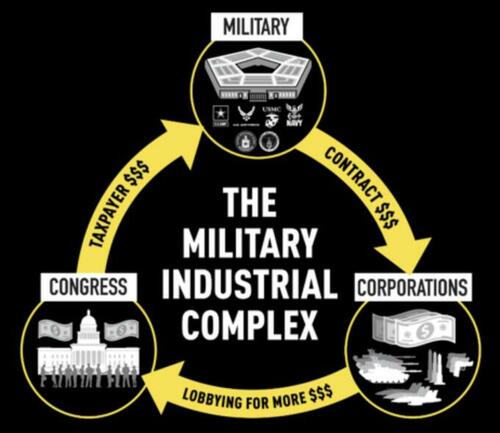
But the MIC is more complicated and insidious than that. In what’s effectively a system of legalized bribery, campaign donations regularly help boost Pentagon budgets and ensure the awarding of yet more lucrative contracts, often benefiting a small number of contractors in a congressional district or state. Such contractors make their case with the help of a virtual army of more than 900 Washington-based lobbyists. Many of them are former Pentagon officials, or former members of Congress or congressional staffers, hired through a “revolving door” that takes advantage of their ability to lobby former colleagues. Such contractors also donate to think tanks and university centers willing to support increased Pentagon spending, weapons programs, and a hyper-militarized foreign policy. Ads are another way to push weapons programs on elected officials.
Such weapons makers also spread their manufacturing among as many Congressional districts as possible, allowing senators and representatives to claim credit for jobs created. MIC jobs, in turn, often create cycles of dependency in low-income communities that have few other economic drivers, effectively buying the support of locals.
For their part, contractors regularly engage in legalized price gouging, overcharging taxpayers for all manner of weapons and equipment. In other cases, contractor fraud literally steals taxpayer money. The Pentagon is the only government agency that has never passed an audit — meaning it literally can’t keep track of its money and assets — yet it still receives more from Congress than every other government agency combined.
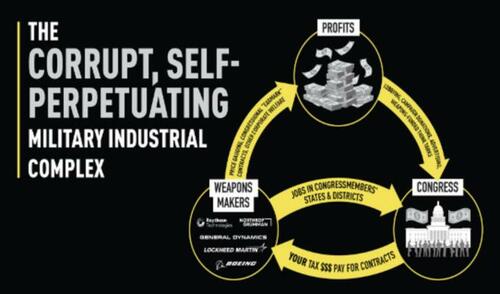
As a system, the MIC ensures that Pentagon spending and military policy are driven by contractors’ search for ever-higher profits and the reelection desires of members of Congress, not by any assessment of how to best defend the country. The resulting military is unsurprisingly shoddy, especially given the money spent. Americans should pray it never actually has to defend the United States.
No other industry — not even Big Pharma or Big Oil — can match the power of the MIC in shaping national policy and dominating spending. Military spending is, in fact, now larger (adjusting for inflation) than at the height of the wars in Vietnam, Afghanistan, or Iraq, or, in fact, at any time since World War II, despite the absence of a threat remotely justifying such spending. Many now realize that the primary beneficiary of more than 22 years of endless U.S. wars in this century has been the industrial part of the MIC, which has made hundreds of billions of dollars since 2001. “Who Won in Afghanistan? Private Contractors” was the Wall Street Journal‘s all too apt headline in 2021.
Endless Wars, Endless Death, Endless Destruction
“Afghanistan” in that headline could have been replaced by Korea, Vietnam, or Iraq, among other seemingly endless U.S. wars since World War II. That the MIC has profited off them is no coincidence. It has helped drive the country into conflicts in countries ranging from Korea, Vietnam, Cambodia, and Laos, to El Salvador, Guatemala, Panama, and Grenada, to Afghanistan, Libya, Somalia, and so many others.
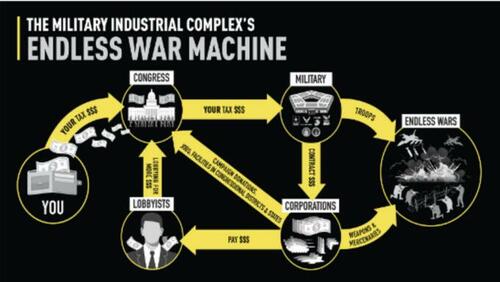
Deaths and injuries from such wars have reached the tens of millions. The number of estimated deaths from the post-9/11 wars in Afghanistan, Iraq, Pakistan, Syria, and Yemen is eerily similar to that from the wars in Vietnam, Laos, and Cambodia: 4.5 million.
The numbers are so large that they can become numbing. The Irish poet Pádraig Ó Tuama helps us remember to focus on:
one life
one life
one life
one life
one life
because each time
is the first time
that that life
has been taken.
The Environmental Toll
The MIC’s damage extends to often irreparable environmental harm, involving the poisoning of ecosystems, devastating biodiversity loss, and the U.S. military’s carbon footprint, which is larger than that of any other organization on earth. At war or in daily training, the MIC has literally fueled global heating and climate change through the burning of fuels to run bases, operate vehicles, and produce weaponry.
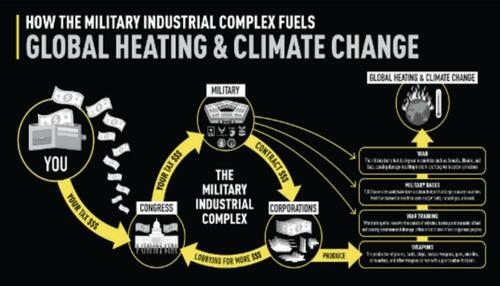
The MIC’s human and environmental costs are particularly invisible outside the continental United States. In U.S. territories and other political “grey zones,” investments in military infrastructure and technologies rely in part on the second-class citizenship of Indigenous communities, often dependent on the military for their livelihoods.
Endless Wars at Home
As the MIC has fueled wars abroad, so it has fueled militarization domestically. Why, for example, have domestic police forces become so militarized? At least part of the answer: since 1990, Congress has allowed the Pentagon to transfer its “excess” weaponry and equipment (including tanks and drones) to local law enforcement agencies. These transfers conveniently allow the Pentagon and its contractors to ask Congress for replacement purchases, further fueling the MIC.
Seeking new profits from new markets, contractors have also increasingly hawked their military products directly to SWAT teams and other police forces, border patrol outfits, and prison systems. Politicians and corporations have poured billions of dollars into border militarization and mass incarceration, helping fuel the rise of the lucrative “border-industrial complex” and “prison-industrial complex,” respectively. Domestic militarization has disproportionately harmed Black, Latino, and Indigenous communities.

An Existential Threat
Some will defend the military-industrial complex by insisting that we need its jobs; some by claiming it’s keeping Ukrainians alive and protecting the rest of Europe from Vladimir Putin’s Russia; some by warning about China. Each of those arguments is an example of the degree to which the MIC’s power relies on systematically manufacturing fear, threats, and crises that help enrich arms merchants and others in the MIC by driving ever more military spending and war (despite a nearly unbroken record of catastrophic failure when it comes to nearly every U.S. conflict since World War II).
The argument that current levels of military spending must be maintained for “the jobs” should be laughable. No military should be a jobs program. While the country needs job programs, military spending has proven to be a poor job creator or an engine of economic growth. Research shows it creates far fewer jobs than comparable investments in health care, education, or infrastructure.
U.S. weaponry has aided Ukrainian self-defense, though the weapons manufacturers are anything but altruists. If they truly cared about Ukrainians, they would have forgone any profits, leaving more money for humanitarian aid to that country. Instead, they’ve used that war, as they have Israel’s genocidal war on Gaza and growing tensions in the Pacific, to cynically inflate their profits and stock prices dramatically.
Discard the fearmongering and it should be clear that the Russian military has demonstrated its weakness, its inability to decisively conquer territory near its own borders, let alone march into Europe. In fact, both the Russian and Chinese militaries pose no conventional military threat to the United States. The Russian military’s annual budget is one-tenth or less than the size of the U.S. one. China’s military budget is one-third to one-half its size. The disparities are far larger if you combine the U.S. military budget with those of its NATO and Asian allies.
Despite this, members of the MIC are increasingly encouraging direct confrontations with Russia and China, aided by Putin’s war and China’s own provocations. In the “Indo-Pacific” (as the military calls it), the MIC is continuing to cash in as the Pentagon builds up bases and forces surrounding China in Australia, Guam, the Federated States of Micronesia, Japan, the Marshall Islands, the Northern Mariana Islands, Palau, Papua New Guinea, and the Philippines.
Such steps and a similar buildup in Europe are only encouraging China and Russia to strengthen their own militaries. (Just imagine how American politicians would respond if China or Russia were to build a single military base anywhere close to this country’s borders.) While all of this is increasingly profitable for the MIC, it is heightening the risk of a military clash that could spiral into a potentially species-ending nuclear war between the United States and China, Russia, or both.
The Urgency of Dismantling
The urgency of dismantling the military-industrial complex should be clear. The future of the species and planet depends on it.
The most obvious way to weaken the MIC would be to starve it of its lifeblood, our tax dollars. Few noticed that, after leaving office, former Trump-era Pentagon chief Christopher Miller called for cutting the Pentagon’s budget in half. Yes, in half.
Even a 30% cut — as happened all too briefly after the Cold War ended in 1991 — would free hundreds of billions of dollars annually. Imagine how such sums could build safer, healthier, more secure lives in this country, including a just economic transition for any military personnel and contractors losing jobs. And mind you, that military budget would still be significantly larger than China’s, or Russia’s, Iran’s, and North Korea’s combined.
Of course, even thinking about cutting the Pentagon budget is difficult because the MIC has captured both political parties, virtually guaranteeing ever-rising military spending. Which brings us back to the puzzle of how to dismantle the MIC as a system.
In short, we’re working on the answers. With the diverse group of experts who helped produce this article’s graphics, we’re exploring, among other ideas, divestment campaigns and lawsuits; banning war profiteering; regulating or nationalizing weapons manufacturers; and converting parts of the military into an unarmed disaster relief, public health, and infrastructure force.
Though all too many of us will continue to believe that dismantling the MIC is unrealistic, given the threats facing us, it’s time to think as boldly as possible about how to roll back its power, resist the invented notion that war is inevitable, and build the world we want to see. Just as past movements reduced the power of Big Tobacco and the railroad barons, just as some are now taking on Big Pharma, Big Tech, and the prison-industrial complex, so we must take on the MIC to build a world focused on making human lives rich (in every sense) rather than one focused on bombs and other weaponry that brings wealth to a select few who benefit from death.
This piece first appeared in TomDispatch.
David Vine, a TomDispatch regular and professor of anthropology at American University, is the author most recently of The United States of War: A Global History of America’s Endless Conflicts, from Columbus to the Islamic State. He is also the author of Base Nation: How U.S. Military Bases Abroad Harm America and the World, part of the American Empire Project. Theresa (Isa) Arriola is an assistant professor in the department of sociology and anthropology at Concordia University. She chairs Our Common Wealth 670 (OCW 670) on Saipan, a community advocacy group dedicated to research, education, and awareness about military planning in the Mariana Islands. She was born and raised on Saipan and is an Indigenous Chamorro woman. Her research interests center around militarism, indigeneity, sovereignty, and Oceania.
|
|
[Politics]
[John Ross] Short Circuit: A Roundup of Recent Federal Court Decisions
Frothy fonts, unprofessional death threats, and books about butts and farts.
Published:6/7/2024 5:45:14 PM
|
[Markets]
ECB Cuts Rates For The First Time Since 2019, Does Not "Pre-Commit To A Particular Rate Path"
ECB Cuts Rates For The First Time Since 2019, Does Not "Pre-Commit To A Particular Rate Path"
And so, the second G7 central bank to launch an easing cycle in the past 24 hours (the BOC was the first) is in the history books.
Moments ago the ECB confirmed that, as widely previewed and expected, it cut rates by 25bps as follows:
- ECB Cuts Deposit Facility Rate by 25bps to 3.75%; Est. 3.75%
- ECB Cuts Main Refinancing Rate by 25bps to 4.25%; Est. 4.25%
- ECB Cuts Marginal Lending Facility Rate by 25bps to 4.50%; Est. 4.50%
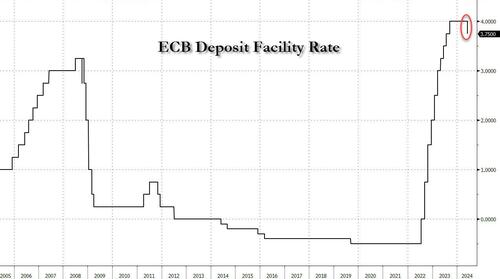
Commenting in its statement on the first ECB rate cut since 2019, the central bank said that "based on an updated assessment of the inflation outlook, the dynamics of underlying inflation and the strength of monetary policy transmission, it is now appropriate to moderate the degree of monetary policy restriction after nine months of holding rates steady. Since the Governing Council meeting in September 2023, inflation has fallen by more than 2.5 percentage points and the inflation outlook has improved markedly. Underlying inflation has also eased, reinforcing the signs that price pressures have weakened, and inflation expectations have declined at all horizons. Monetary policy has kept financing conditions restrictive. By dampening demand and keeping inflation expectations well anchored, this has made a major contribution to bringing inflation back down."
At the same time, despite the progress over recent quarters, the ECB noted that "domestic price pressures remain strong as wage growth is elevated, and inflation is likely to stay above target well into next year. The latest Eurosystem staff projections for both headline and core inflation have been revised up for 2024 and 2025 compared with the March projections. Staff now see headline inflation averaging 2.5% in 2024, 2.2% in 2025 and 1.9% in 2026. For inflation excluding energy and food, staff project an average of 2.8% in 2024, 2.2% in 2025 and 2.0% in 2026. Economic growth is expected to pick up to 0.9% in 2024, 1.4% in 2025 and 1.6% in 2026."
Translation: goodbye 2% inflation target.
Finally, in conclusion for those expecting guidance about more rate cuts, this is how the ECB previewed its next actions:
The Governing Council is determined to ensure that inflation returns to its 2% medium-term target in a timely manner. It will keep policy rates sufficiently restrictive for as long as necessary to achieve this aim. The Governing Council will continue to follow a data-dependent and meeting-by-meeting approach to determining the appropriate level and duration of restriction. In particular, its interest rate decisions will be based on its assessment of the inflation outlook in light of the incoming economic and financial data, the dynamics of underlying inflation and the strength of monetary policy transmission. The Governing Council is not pre-committing to a particular rate path.
Also of note, here are the ECB’s new economic projections:
- ECB Sees 2025 Inflation at 2.2%; Prior Forecast 2%
- ECB Sees 2026 Inflation at 1.9%; Prior Forecast 1.9%
Yes, the ECB raised its 2025 inflation target as it cuts rates.
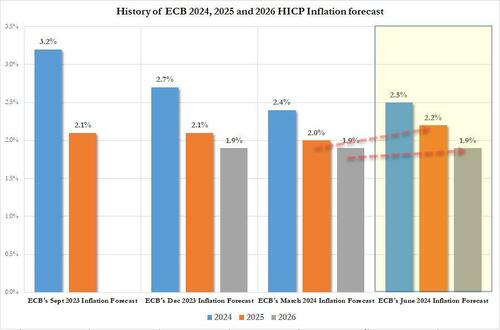
Bottom line: no surprises, with the ECB cutting rates as expected, and remaining murky on the future, but the take home message is clear: any 2% inflation target the central bank may have had is dead.
The market reaction was generally as expected, with the lack of dovish guidance lifting the EURUSD from 1.0863 to 1.09 over the course of 10-minutes.
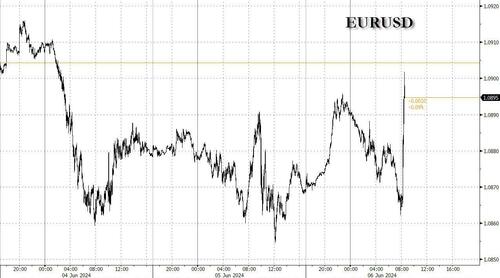
At the same time, Bund Sep'24 fell from 131.14 to 130.93 before then extending to a trough of 130.82 around eight minutes later. BTP-Bund yield spread has widened modestly from around 129bp to just over 130bp.
Equities also came under pressure: the Dax Jun'24 fell from 18739 to 18711 and then slipping further to 18686 10-minutes later
Summarizing the decision, Newsquawk writes that overall, the decision was largely as expected with the ECB cutting by 25bp and not committing to any rate path with decision ahead to be data-dependent and meeting-by-meeting. The details from the statement (see below) err on the hawkish side and as such, thus far. the ECB can be described as a hawkish-cut with data-dependence taking centre stage.
Within the statement the ECB acknowledged that the outlook for inflation has improved markedly, however despite recent progress ‘ domestic price pressures remain strong as wage growth is elevated, and inflation is likely to stay above target well into next year.' Furthermore, the ECB continues to pledge to keep policy “sufficiently restrictive for as long as necessary to attain the 2% goal. On that. HICP forecasts were lifted for 2024 and 2025 on the headline and both by more than expected, with the core views also raised as well. Furthermore, the 2026 GDP view was maintained defying some calls for a moderation.
|
|
[Entertainment]
Washington Post hardcover bestsellers
A snapshot of popular books.
Published:6/5/2024 8:08:22 AM
|
|
[Pride Month]
Drew Droege Shares His Picks for the 13 Best Queer Books to Read During Pride Month
These books tackle issues of sexuality, identity and community in the queerest ways possible.
Published:6/4/2024 1:04:41 PM
|
|
[Entertainment]
5 mystery novels to savor this summer
New books by Anthony Horowitz, Kellye Garrett, Marcia Muller, Tom Straw and Harini Nagendra.
Published:6/2/2024 8:07:15 AM
|
|
[]
WTAF?! Jonathan Turley DECIMATES DOJ's Legal Claim About Why They Can Withhold Biden/Hur Tapes (Thread)
Published:6/2/2024 8:07:14 AM
|
[Entertainment]
Show Off Your Pride with These 20 LGBTQ+ Reads
 Who says you have to go outside to celebrate Pride?
During the whole month of June, E! News is commemorating Pride Month by paying tribute to LGBTQI+ artists, fashion icons, business owners and...
Who says you have to go outside to celebrate Pride?
During the whole month of June, E! News is commemorating Pride Month by paying tribute to LGBTQI+ artists, fashion icons, business owners and...
Published:6/2/2024 6:01:30 AM
|
[Markets]
1 In 9 Children In The US Diagnosed With ADHD, COVID-19 A Potential Factor
1 In 9 Children In The US Diagnosed With ADHD, COVID-19 A Potential Factor
Authored by Amie Dahnke via The Epoch Times (emphasis ours),
 (Devonyu/iStock) (Devonyu/iStock)
Childhood attention deficit/hyperactivity disorder (ADHD) is becoming increasingly common, with a new study revealing that one in nine American kids have been diagnosed with the condition—equating to 7.1 million children.
Many more children in the U.S. have been diagnosed with ADHD recently. In 2022, there were 1 million more cases compared to 2016, potentially fueled by the COVID-19 pandemic’s effect on children’s mental health and virtual schooling putting symptoms on display.
Pandemic Stressors May Have Fueled Rise in ADHD
The research article, published in the Journal of Clinical Child & Adolescent Psychology, provided insight into how the COVID-19 pandemic potentially influenced ADHD diagnoses. The higher prevalence could reflect “a generally increasing awareness of and pursuit of care for ADHD and/or a reflection of poor mental health among children during the COVID-19 pandemic,” the researchers wrote.
Previous studies have shown that the COVID-19 pandemic wreaked havoc on the mental and social well-being of young people, who experienced stressors such as illness and death in the family and community, changes in parents’ work habits, disruptions in school life, decreased social interaction, and increased fear and uncertainty. A 2022 study found that these pandemic-related stressors “can increase symptoms of inattention, impulsivity, and hyperactivity.”
The COVID-19 pandemic likely helped encourage an increase in diagnoses, as previously unobserved ADHD symptoms were front and center in households when children attended school virtually, according to the new study.
Conversely, during the pandemic, schools faced greater challenges in providing support for those students, “may have led more parents to seek diagnoses to ensure access to support for their child,” the research team wrote.
What It Takes for a Child to Be Diagnosed
ADHD is one of the most common developmental conditions affecting children in the U.S. In the three-year span before the COVID-19 pandemic, nearly one in 10 children had received a diagnosis. To be diagnosed with the condition, a child must exhibit at least six symptoms of either inattention or hyperactivity-impulsivity for at least six months.
The symptoms must be severe enough to be “maladaptive and inconsistent with developmental level” or negatively impact social, academic, and occupational activities, according to the Diagnostic and Statistical Manual of Mental Disorders.
Common symptoms of inattention include difficulty maintaining attention during tasks or play, not following instructions, often losing items required for an activity or task (like a pencil for homework), or being forgetful in daily activities.
Examples of hyperactivity include fidgeting with hands or feet, leaving one’s seat in the classroom or situations where they’re expected to remain seated, or having difficulty playing quietly. Examples of impulsivity include difficulty waiting for their turn or often interrupting others.
ADHD Gender Gap Narrows
In the U.S., more boys than girls have typically been diagnosed with ADHD, but new data shows that the gap between the two sexes is narrowing. Before 2022, the boy-to-girl diagnosis ratio was 2:1, while in 2022, it dropped slightly to 1.8:1, according to the study.
Among children aged 3 to 17 with ADHD, 41.9 percent had mild cases, 45.3 percent moderate, and 12.8 percent severe. Certain factors were linked to more severe ADHD: being aged 6-11 (vs. adolescents), living in households with lower education or income levels, and having a co-occurring mental/behavioral/developmental disorder.
More white American children are diagnosed with ADHD than minority children, though the research team noted that “with increased awareness, such gaps in diagnoses have been narrowing or closing.”
Children with public health insurance had the highest prevalence levels, as did children whose caregivers’ highest level of education was high school.
ADHD in children was most common in the Northeast, Midwest, and South, compared to children living in the West.
The report notes that the prevalence of ADHD in children is higher in the United States than in other countries. The reason “may be the result of variation in availability of clinicians trained to diagnose and manage ADHD, state and local policies, and regional differences in demographic characteristics,” the research team wrote. Future research could determine the differences between clinical guidelines and practices across countries.
|
[Markets]
Did FDR Really Confiscate Everybody's Gold?
Did FDR Really Confiscate Everybody's Gold?
Authored by Mike Maharrey via Money Metals,
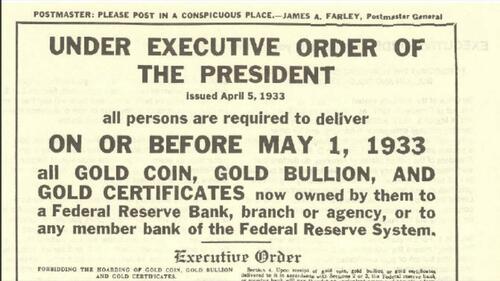
Did the U.S. government really try to confiscate Americans' gold?
The short answer is... well, there isn't a short answer. It's a complicated subject with more nuance than most people give it.
Yes, President Franklin D. Roosevelt did try to take most of the gold out of the public's hands. But the scheme didn't go quite as well as many people claim.
Still, some gold dealers use the confiscation story to try to scare you into only buying collectible coins because there was an exception in Roosevelt’s order for “gold coins having a recognized special value to collectors of rare and unusual coins.” They’ll say, “The government could come to take your Gold Eagles as they did in 1933, but not these collectible coins we’re selling.” Of course, these collectible coins come with higher premiums and bigger profits for the dealer.
You might call it a confiscation con because the reality is there wasn’t “confiscation” in the strict sense of the word.
So what actually happened?
On April 5, 1933, President Franklin D. Roosevelt signed Executive Order 6102. He justified the move based on the Trading with the Enemy Act of 1917, as amended by the Emergency Banking Act in March 1933.
At the time, the United States was in the grip of the Great Depression. A lot of people were redeeming paper dollars for physical gold because they were losing faith in the paper currency. This caused significant problems for the federal government because the dollar was tethered to gold, and thus, the printing of it was at least somewhat limited.
During a Fireside Chat a month before issuing the EO, Roosevelt claimed gold “hoarding during the past week has become an exceedingly unfashionable pastime,” and he said that it was undermining the banking system. The use of the word “hoarding” was almost certainly intentional because of its negative connotations.
This carried forward to EO6102. Stopping hoarding was the public rationale for the order, but it went far beyond merely taking large amounts of gold from “hoarders.” By creating an expansive definition of “hoarding,” the EO was designed to take virtually all gold coins and bars out of private hands and transfer them to the government.
“The term ‘hoarding’ means the withdrawal and withholding of gold coin, gold bullion, or gold certificates from the recognized and customary channels of trade. The term 'person' means any individual, partnership, association or corporation.”
In short, anyone who wanted to hold their gold as a form of savings was considered to be “hoarding.”
Under the order, private citizens, partnerships, associations, and corporations were required to turn in virtually all their gold.
The order allowed people to keep up to $100 in gold coins, along with gold “as may be required for legitimate and customary use in industry, profession or art within a reasonable time,” and “rare” coins.
It read, in part: “Deliver on or before May 1, 1933, to a Federal Reserve Bank or a branch or agency thereof or to any member bank of the Federal Reserve System all gold coin, gold bullion, and gold certificates now owned by them or coming into their ownership on or before April 28, 1933.”
In return, the Federal Reserve Bank would give individuals an equivalent amount in “any other form of coin or currency coined or issued under the laws of the United States” at the rate of $20.67 per ounce.
Once the government got the gold at that price, it did what governments do – it changed the price-fixing to its advantage, raising the price to $35 and devaluing the paper money people received in exchange for their gold.
Violators of the law were subject to up to a $10,000 fine and/or 10 years in prison.
Like so often happens today, Congress passed the Emergency Banking Act before the majority of members had even read the bill. It expanded The Trading With Enemy Act of 1917 (TWEA), a WWI statute still on the books today, prohibiting trade with enemies of the United States.
One provision in the 1917 law empowered the president to regulate or prohibit “under such rules and regulations as he may prescribe … any transactions in foreign exchange, export or earmarkings of gold or silver coin or bullion or currency … by any person within the United States.”
On March 6, 1933, President Roosevelt declared a national emergency under § 5(b) of the TWEA, authorizing him to declare a bank holiday to prevent the hoarding of gold. The President invoked this authority even though the section explicitly limited presidential power to wartime.
Congress then retroactively amended the section to allow the president to take action “during time of war or during any other period of national emergency declared by the president” when it passed the Emergency Banking Act three days later.
Provisions in the Emergency Banking Act gave the secretary of the Treasury the power to require all individuals and corporations to hand over all their gold coin, gold bullion, or gold certificates if in his judgment “such action is necessary to protect the currency system of the United States.”
This served as the legal justification for EO6102.
What Was the Motive Behind Roosevelt's Gold Confiscation Scheme?
Despite the window dressing and propaganda, Rosevelt’s order wasn’t a benevolent move to protect America from greedy gold hoarders. In truth, the government needed the gold.
With the dollar tied to gold, the Federal Reserve could not significantly increase the money supply during the Great Depression. It couldn’t simply fire up the printing press as it can today. The Federal Reserve Act required the central bank to hold enough gold to back at least 40 percent of the notes in circulation.
But the central bank was low on gold and up against the limit.
Since monetary stimulus – an increase in the supply of money – is the Keynesian response to an economic downturn, Roosevelt was between a rock and a hard place. He wanted the Fed to increase the money supply and support government spending but was limited by this partial gold standard.
By transferring gold from the public to the Federal Reserve, the central bank boosted its reserve holdings, allowing it to print more money than it was previously able to.
Gold confiscation was the second step in Roosevelt’s aggressive plan to weaken the gold standard.
EO6102 followed on the heels of Executive Order 6073, which Roosevelt issued just weeks prior, prohibiting banks from paying out or exporting gold.
A little over a year after the enactment of EO6102, the United States effectively went off the gold standard when Congress passed the Gold Reserve Act of 1934. In effect, this law transformed gold from a currency to a commodity.
One of the most significant provisions in the law erased the right of creditors to demand payment in gold. In practice, this forced debtors to make payments in whatever the government declared was legal tender. Gold couldn’t even be used as the basis for determining how much paper money was owed.
As noted above, when people were ordered to turn in their gold they were given a rate of $20.67 per ounce, but the government wasn’t done.
The war on sound money continued in 1934 when President Roosevelt issued a proclamation raising the fixed price for gold to $35 per ounce. This effectively boosted the value of gold on the Federal Reserve’s balance sheet by 69 percent.
By increasing its gold stores through the transfer of private gold to the Fed, and declaring a higher exchange rate, the Fed could circulate more paper money. In effect, the hoarding of gold by the government allowed it to inflate the money supply.
Was the Gold Confiscation Order Enforced?
The short answer is "barely."
EO6102 is often referred to as a gold confiscation order, and in principle, it was. Roosevelt effectively nationalized gold. But the word “confiscation” conjures up images of police breaking down doors to forcibly take people’s gold.
That’s not what happened.
The Federal Reserve collected plenty of gold, but only because many Americans turned it in voluntarily as an act of obedience. Some likely did so because they trusted the government, others out of a sense of patriotism, and some probably turned their gold in out of fear.
But generally speaking, federal agents did not search for private holdings or seize gold. People took their gold and gold certificates to the bank and received the promised compensation.
As Tom Woods noted in The Great Gold Robbery of 1933, “The paper currency they were receiving in exchange for the gold had always been redeemable in gold in the past, so few saw anything amiss in this coerced transaction, and most trusted the government’s assurances that this was somehow necessary in order to combat the Depression.”
The total amount of gold turned in to the Fed remains unclear because the central bank isn’t required to disclose detailed accounting. However, in their book A Monetary History of the United States, economists Milton Friedman and Anna Jacobson Schwartz estimated the amount was relatively small and that most people simply ignored the order.
According to their calculations, Americans turned in about 20 to 25 percent of gold held in private hands at the time. In other words, a large percentage of people simply ignored the order.
Friedman and Schwartz came to this conclusion when they found something wonky in the official government data. The amount of gold the government said it held (in dollar terms) before the confiscation order was abnormally low.
“If the estimates of gold lost and gold exported without record are added to the gold coin returned to the Treasury since 1934, we are still far short of accounting for even half of the $287 million. We therefore concluded that in Jan. 1934 the bulk of the $287 million was retained illegally in private hands.”
In effect, the Federal Reserve cooked the books to make it look like more gold was turned in than was. Economist David Henderson explains it this way:
“The government thought that x gold existed in, say, 1930. Then, when people were supposed to turn their gold over by law in 1934, the government calculated that there was only 0.8x. Rather than concluding that people were withholding 0.2x of gold, the government went back and said, ‘Oops, we overestimated the amount of gold in 1930. It must have been falling due to factors y and z.’"
Looking at gold coin mintage versus gold meltdown figures confirms the 20 to 25 percent turn-in rate, along with official gold reserve data.
This goes to show that, like most other federal actions, the gold confiscation actually depended primarily on the voluntary cooperation of the people.
That’s not to say the government didn’t try to enforce the orders.
Frederick Barber Campbell was the first person to find himself in federal crosshairs. He had over 5,000 ounces of gold on deposit at Chase National Bank. When the bank refused his request to withdraw the gold after Roosevelt issued EO6102, Campbell sued the bank, bringing himself to the attention of federal prosecutors.
A judge overturned the prosecution because the president signed EO6102 instead of the Treasury secretary as required under the Banking Act of 1933. But the court upheld the federal government’s authority to confiscate gold and still seized Campbell’s holdings.
Campbell was the only person prosecuted under EO6102
After the judge nullified the federal enforcement authority in EO6102, Roosevelt signed EO6260 to empower the Treasurer to make rules relating to gold confiscation, to allow for licensed individuals to hold gold, and to authorize federal prosecution under the direction of the Treasurer.
“Whoever willfully violates any provision of this Executive Order or of any license, order, rule, or regulation issued or prescribed hereunder, shall, upon conviction, be fined not more than $10,000, or, if a natural person, may be imprisoned for not more than 10 years, or both; and any officer, director, or agent of any corporation who knowingly participates in such violation may be punished by a like fine, imprisonment, or both.”
The Gold Reserve Act of 1934 also included provisions beefing up the power to prosecute individuals illegally holding gold.
“Any gold withheld, acquired, transported, melted or treated, imported, exported, or earmarked or held in custody, in violation of this Act or of any regulations issued hereunder, or licenses issued pursuant thereto, shall be forfeited to the United States, and may be seized and condemned … And in addition, any person failing to comply with the provisions of this Act or of any such regulations or licenses, shall be subject to a penalty equal to twice the value of the gold in respect of which such failure occurred.”
Following the pattern Campbell established, most of the prosecutions happened after people got caught in sting actions trying to illegally sell gold, or otherwise did things that brought attention to their “illegal” gold.
For instance, the government prosecuted a San Francisco diamond and jewelry merchant after he tried to sell thirteen $20 gold coins without a license. Gus Farber got busted when the buyer tipped off the Secret Service. Faber and his father, along with 12 other people, got caught up in the subsequent sting operation. Federal agents confiscated $24,000 in gold.
Other prosecutions followed a similar pattern. It’s unclear exactly how many people were prosecuted under the various orders and laws, but there weren’t a lot. Most criminal actions involved individuals trying to sell gold. There are no recorded cases of individuals being prosecuted merely because they had gold in their homes.
By and large, Roosevelt’s gold confiscation largely relied on voluntary compliance. The federal government made no effort to hunt down people who quietly ignored the order.
A lack of personnel and resources to enforce federal actions is an ongoing problem for the federal government. As Roger Sherman noted in 1787, “All acts of the Congress not warranted by the constitution would be void. Nor could they be enforced contrary to the sense of a majority of the States.”
The same holds true today. When people and the states refuse to cooperate or submit, the federal government has a hard time doing anything.
This article was adapted from a report published by the Tenth Amendment Center.
|
[Markets]
Get Up, Stand Up, Don't Give Up The Fight: Know Your Rights Or You Will Lose Them
Get Up, Stand Up, Don't Give Up The Fight: Know Your Rights Or You Will Lose Them
Authored by John & Nisha Whitehead via The Rutherford Institute,
“If a nation expects to be ignorant and free in a state of civilization, it expects what never was and never will be.”
- Thomas Jefferson
If America’s schools are to impart principles of freedom and democracy to future generations, they must start by respecting the constitutional rights of their students.

Take the case of Lucas Hudson.
With all the negative press being written about today’s young people, it’s refreshing to meet a young person who not only knows his rights but is prepared to stand up for them.
Lucas is a smart kid, a valedictorian of his graduating class at the Collegiate Academy at Armwood High School in Hillsborough County, Fla.
So, when school officials gave Lucas an ultimatum: either remove most of his speech’s religious references from his graduation speech—in which he thanked the people who helped shape his character, reflected on how quickly time goes by, and urged people to use whatever time they have to love others and serve the God who loves us—or he would not be speaking at all, Lucas refused to forfeit his rights.
That’s when Lucas’s father turned to The Rutherford Institute for help.
In coming to Lucas’ defense, attorneys for The Rutherford Institute warned school officials that their attempts to browbeat Lucas into watering down his graduation speech could expose the school to a First Amendment lawsuit.
Thankfully for Lucas, the school backed down, and he was able to deliver his speech as written.
It doesn’t always work out so well, unfortunately.
Over the course of The Rutherford Institute’s 42-year history, we have defended countless young people who found themselves censored, silenced and denied their basic First Amendment rights, especially when they chose to exercise their rights to free speech and religious freedom.
In case after case, we encounter an appalling level of ignorance on the part of public school officials who mistakenly believe that the law requires anything religious be banned from public schools.
Here’s where government officials get it wrong: while the government may not establish or compel a particular religion, it also may not silence and suppress religious speech merely because others might take offense.
People are free to ignore, disagree with, or counter the religious speech of others, but the government cannot censor private religious speech.
Unfortunately, you can only defend your rights when you know them, and the American people—and those who represent them—are utterly ignorant about their freedoms, history, and how the government is supposed to operate.
As Morris Berman points out in his book Dark Ages America, “70 percent of American adults cannot name their senators or congressmen; more than half don’t know the actual number of senators, and nearly a quarter cannot name a single right guaranteed by the First Amendment. Sixty-three percent cannot name the three branches of government. Other studies reveal that uninformed or undecided voters often vote for the candidate whose name and packaging (e.g., logo) are the most powerful; color is apparently a major factor in their decision.”
More than government corruption and ineptitude, police brutality, terrorism, gun violence, drugs, illegal immigration or any other so-called “danger” that threatens our nation, civic illiteracy may be what finally pushes us over the edge.
As Thomas Jefferson warned, no nation can be both ignorant and free.
Unfortunately, the American people have existed in a technology-laden, entertainment-fueled, perpetual state of cluelessness for so long that civic illiteracy has become the new normal for the citizenry.
In fact, most immigrants who aspire to become citizens know more about national civics than native-born Americans. Surveys indicate that half of native-born Americans couldn’t correctly answer 70% of the civics questions on the U.S. Citizenship test.
Not even the government bureaucrats who are supposed to represent us know much about civics, American history and geography, or the Constitution although they take an oath to uphold, support and defend the Constitution against “enemies foreign and domestic.”
For instance, a couple attempting to get a marriage license was recently forced to prove to a government official that New Mexico is, in fact, one of the 50 states and not a foreign country.
You can’t make this stuff up.
Those who gave us the Constitution and the Bill of Rights believed that the government exists at the behest of its citizens. The government’s purpose is to protect, defend and even enhance our freedoms, not violate them.
It was no idle happenstance that the Constitution opens with these three powerful words: “We the people.”
Those who founded this country knew quite well that every citizen must remain vigilant or freedom would be lost. As Thomas Paine recognized, “It is the responsibility of the patriot to protect his country from its government.”
You have no rights unless you exercise them.
Still, you can’t exercise your rights unless you know what those rights are.
“If Americans do not understand the Constitution and the institutions and processes through which we are governed, we cannot rationally evaluate important legislation and the efforts of our elected officials, nor can we preserve the national unity necessary to meaningfully confront the multiple problems we face today,” warns the Brennan Center in its Civic Literacy Report Card. “Rather, every act of government will be measured only by its individual value or cost, without concern for its larger impact. More and more we will ‘want what we want, and [will be] convinced that the system that is stopping us is wrong, flawed, broken or outmoded.’”
Education precedes action.
As the Brennan Center concludes “America, unlike most of the world’s nations, is not a country defined by blood or belief. America is an idea, or a set of ideas, about freedom and opportunity. It is these ideas that bind us together as Americans and have kept us free, strong, and prosperous. But these ideas do not perpetuate themselves. They must be taught and learned anew with each generation.”
There is a movement underway to require that all public-school students pass the civics portion of the U.S. naturalization test—100 basic facts about U.S. history and civics—before receiving their high-school diploma, and that’s a start.
Lucas Hudson would have passed such a test with flying colors.
On graduation day, Lucas stepped up to the podium and delivered his uncensored valedictorian speech as written, without any interference by school censors.
As Lucas’s father relayed to The Rutherford Institute:
“In the end, Lucas got to give his entire speech the way he wanted to give it, and everybody was paying attention. Nobody got hurt. Nothing bad happened. It was just a young man using the First Amendment rights to speak his mind regarding his personal beliefs. [Lucas] never thought a few sentences in a speech would create such a controversy in his world, but this speech turned into a defining moment for him. He will never be the same after this experience, but this permanent change is a good thing. When it mattered, Lucas stood up for himself, and when those he stood up against tried to push him down, [The Rutherford Institute] came to his aide and backed him up to make it a fair fight. I am comforted to know you are defending the rights of the people. These fights matter. Every time you defend the rights of one person, you defend the rights of every person. You helped my son fight for his rights against the school, and, in doing so, Hillsborough County Public Schools will think twice before infringing on the rights of future students. Your defense of Lucas became an inspiration for the students in his school and sparked a healthy and meaningful debate among the teachers, students, and parents about the value of the First Amendment and the need for limits on government control over our personal beliefs. You are fighting for good and doing important work. Don’t ever stop. Thank you, Rutherford Institute, for being there for my son when he needed you most.”
America needs more freedom fighters like Lucas Hudson and The Rutherford Institute.
It’s up to us.
We have the power to make and break the government.
We the American people—the citizenry—are the arbiters and ultimate guardians of America’s welfare, defense, liberty, laws and prosperity.
We must act—and act responsibly.
A healthy, representative government is hard work. It takes a citizenry that is informed about the issues, educated about how the government operates, and willing to make the sacrifices necessary to stay involved.
As I make clear in my book Battlefield America: The War on the American People and in its fictional counterpart The Erik Blair Diaries, it’s our job to keep freedom alive using every nonviolent means available to us.
As Martin Luther King Jr. recognized in a speech delivered on December 5, 1955, just four days after Rosa Parks was arrested for refusing to relinquish her seat on a Montgomery city bus: “Democracy transformed from thin paper to thick action is the greatest form of government on earth.”
Know your rights. Exercise your rights. Defend your rights. If not, you will lose them.
|
|
[Entertainment]
Washington Post paperback bestsellers
A snapshot of popular books.
Published:5/29/2024 8:10:28 AM
|
[Markets]
Is The Federal Reserve Just Winging It?
Is The Federal Reserve Just Winging It?
Authored by Mike Maharrey via Money Metals,
Are the central bankers at the Federal Reserve just winging it?
It sure seems that way if you step back and take a long view of their decision-making.
Fed officials project this aura of authority. You might imagine them as hyper-intelligent experts in the field of economics and finance making carefully calculated monetary policy decisions based on a thorough understanding of all the dynamics in the economy. After all, they must have risen to these important positions at the Fed based on their economic acumen, right?
Or maybe they are just politicians making stuff up as they go along.
A more accurate word picture would probably be a bunch of people wearing expensive suits throwing darts at a dartboard.

Current Fed Thinking
We just got the minutes from the most recent FOMC meeting held on April 30 and May 1. As you may recall, the committee elected to hold rates steady at 5.25 to 5.5 percent. But the messaging that came out of that meeting was relatively hawkish after several previous CPI reports showed stubbornly sticky price inflation.
In its official statement, the Committee conceded that rates will remain at this level into the foreseeable future.
“The Committee does not expect it will be appropriate to reduce the target range until it has gained greater confidence that inflation is moving sustainably toward 2 percent.”
During the post-meeting press conference, Powell admitted that he and his fellow central bankers don’t have a clue when that might happen.
“I would say my personal forecast is that we will begin to see further progress on inflation this year. I don't know that it will be enough, sufficient. I don't know that it won't. We're going to have to let the data lead us on that.”
The May meeting minutes reveal that the FOMC members were even more hawkish behind closed doors.
They lamented the lack of progress on the price inflation front.
“Participants observed that while inflation had eased over the past year, in recent months there had been a lack of further progress toward the Committee’s 2 percent objective. The recent monthly data had showed significant increases in components of both goods and services price inflation.”
And with price inflation still running hot, “The market-implied path for the federal funds rate through 2024 increased markedly, and federal funds futures rates suggested that market participants were placing lower odds on significant policy easing in 2024 than they did just before the March FOMC meeting."
In fact, according to the minutes, “Various participants mentioned a willingness to tighten policy further should risks to inflation materialize in a way that such an action became appropriate.”
In other words, as of May 1, the central bankers at the Fed weren’t thinking about rate cuts and they put further rate hikes back on the table.
What a Difference Six Weeks Makes
Now let’s take a trip back into the deep recesses of time known as March.
After the March FOMC meeting, the committee released its “dot plot” projecting the expected trajectory of interest rates over the next several years.
Based on the dot plot, the FOMC indicated that it still planned to cut interest rates three times this year. If it moved in typical 25-basis point increments, that would lower rates to between 4.5 and 4.75 percent by the end of the year.
The committee projected additional cuts in 2025, dropping rates to around 3 percent.
Now, stop and think about this. Six weeks ago, the FOMC was convinced that three rate cuts were the appropriate trajectory of monetary policy.
Six weeks later, we might need rate hikes.
Did I mention this flip-flop happened in just six weeks?
This doesn’t exactly inspire confidence that these people know what they’re doing, does it?
Now, you might say, “Well, Mike, monetary policy is a complex business. You can’t expect them to get it right every time.” And that might be a fair assessment. The problem is it doesn’t seem like they ever get it right.
Comparing the actual trajectory of rate cuts with the projections bear this out.
How bad is their track record?
Fund manager David Hay analyzed past dot plots and found the FOMC only got interest rate projections right 37 percent of the time. And as Hay pointed out, “They control interest rates!”
In other words, the people who set interest rates would make better guesses about where interest rates are heading by flipping a coin.
For instance, in March 2021, the FOMC projected the interest rate would still be zero in 2022. The actual 2022 rate was 1.75 percent. And in 2023, the vast majority of FOMC members thought the rate would still be at zero. The actual rate was over 5 percent.
If the FOMC members didn't have coins handy, maybe they should try throwing darts at a chart.
My point is we don’t have a good reason to believe anything Powell & Company said or to think their musings tell us anything about the central bank’s next moves.
I can’t help but think of other Fed predictions that were wildly wrong.
Do you remember when inflation was “transitory?”
Or how about back in 2007 when they emphatically assured us that the subprime mortgage problems were “contained.”
A year later, then Fed Chair Ben Bernanke told Congress that quantitative easing was a “temporary emergency measure” and once the crisis passed, the central bank would quickly shed the bonds it was buying from its balance sheet. He insisted that the Fed was not engaged in debt monetization. Sixteen years later, most of those assets are still on the books.
I’m just going to throw this out there – given the track record, maybe the mainstream should stop with the knee-jerk reactions every time words fall out of Jerome Powell or some other Fed official’s mouths.
After the minutes came out, stocks tanked and gold sold off, because we’re hawkish again. Just a week ago, stocks set new records and gold rallied because the CPI report was good (even though it wasn’t) making everybody think the Fed people would jump back on the rate cut train.
The fact of the matter, it’s all just wild guesses and speculation.
Instead of obsessing over the Fed’s open-mouth operations (doing monetary policy by talking), people would do better to look at the underlying fundamentals of the economy. Consider the massive levels of debt, the stagnating growth, the amount of money creation the central bank engaged in, and the fact that the economy runs on easy money, and then place all of this into the context of a higher interest rate environment. You’ll almost certainly come closer to anticipating the future than you will by listening to Fed officials blah, blah, blah.
Or you could just throw darts.
|
|
[]
This is the Terrible Review of 'Reacher' We've All Been Waiting For
Published:5/28/2024 10:21:41 PM
|
[Markets]
Blackrock Surpasses Grayscale As World's Largest Bitcoin ETF
Blackrock Surpasses Grayscale As World's Largest Bitcoin ETF
A month and a half after we first observed that the world's largest bitcoin fund, Grayscale's GBTC, had lost more than half of its assets since the approval of spot bitcoin ETFs in January in what was the year's first, and far less memorable "halving" event...
... and just over a week after Grayscale CEO Michael Sonnenschein unexpectedly resigned amid persistent, relentless outflows (courtesy of GBTC's 1.5% in fees), the flipping has officially taken place.
With today's ETF flows now in the books, the inevitable has finally happened, and after GBTC saw $105.2 million, or about 1530 bitcoin, withdrawn in its biggest one-day outflow in more than two weeks, while BlackRock's IBIT added $101.9 million, the latter has now surpassed the former, and Blackrock's IBIT has dethroned GBTC as the world's largest ETF with $19.795 billion in bitcoin, equivalent to roughly 288,670 bitcoin, vs $19.758 billion for GBTC.
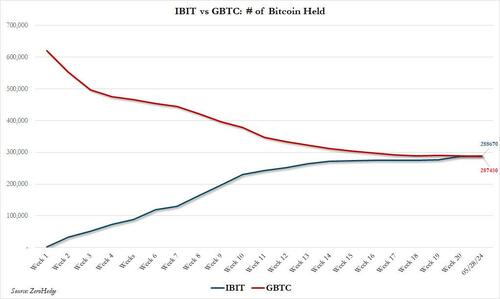
And so having taken over the crown as the world's largest bitcoin ETF, Larry Fink can focus on the one asset he is truly after in his pursuit of financial tokenization - ether - which just got spot ETF approval late last week, and which Blackrock will very soon dominate as the 2nd largest cryptocurrency sets off in its trek to hit $14,000 some time in 2025 with Larry Fink's blessing.
|
[Markets]
Everything You Need To Know As Trump Trial Heads To Verdict
Everything You Need To Know As Trump Trial Heads To Verdict
As lawyers in the criminal trial of former President Donald Trump prepare to deliver their summations today, and the jury makes ready to begin deliberating as soon as the middle of the week, speculation runs high as to whether proceedings will end in an acquittal, a guilty verdict, or a hung jury.
If President Trump is convicted, evidentiary concerns and Justice Juan Merchan’s conduct are likely to raise substantive issues for the defense to pursue at the appellate level, according to one legal expert.
But other judicial experts disagree, saying it is premature to try to assess the trial’s fairness.
The Epoch Times' Catherine Yang, lays out everything you need to know to catch up with the case.
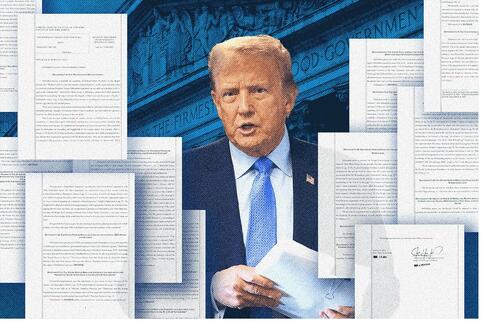
What Are the Charges?
Manhattan District Attorney Alvin Bragg charged President Trump with 34 counts of falsifying business records in the first degree, a class E felony.
The former president was charged under the statute New York Business Law 175.10, which states that “A person is guilty of falsifying business records in the first degree when he commits the crime of falsifying business records in the second degree, and when his intent to defraud includes an intent to commit another crime or to aid or conceal the commission thereof.”
The second crime in this case was the alleged violation of New York Election Law 17-152: “Conspiracy to promote or prevent election. Any two or more persons who conspire to promote or prevent the election of any person to a public office by unlawful means and which conspiracy is acted upon by one or more of the parties thereto, shall be guilty of a misdemeanor.”
The 34 records in this case consist of 11 checks cut to Michael Cohen, a former personal attorney to President Trump, and the corresponding vouchers and invoices. Prosecutors allege these payments, categorized as legal expenses, were reimbursement for money Mr. Cohen paid to Stephanie Clifford, better known as adult actress Stormy Daniels, as part of a scheme to influence the 2016 elections.
In order to prove their case, prosecutors need to show that President Trump had the intent to defraud—more specifically, the intent to conceal the alleged conspiracy—when causing the creation of the business records.
Who Testified?
David Pecker, former head of American Media, Inc. (AMI) and publisher of the National Enquirer, was the first to take the witness stand.
Over several days, he outlined an agreement with Mr. Trump and collaboration with Mr. Cohen as AMI purchased two stories that Mr. Pecker believed would harm the 2016 Trump campaign. Neither of the two deals Mr. Pecker was involved in are related to the current charges, but prosecutors argued they provide important context and evidence toward a conspiracy.
Next, longtime Trump assistant Rhona Graff testified, affirming that she had entered contact information for key people in the case into her contact management system, offering evidence that Mr. Trump was in touch with alleged co-conspirators.
 Manhattan District Attorney Alvin Bragg speaks at a press conference in New York City on Sept. 8, 2022. (Alex Kent/AFP via Getty Images) Manhattan District Attorney Alvin Bragg speaks at a press conference in New York City on Sept. 8, 2022. (Alex Kent/AFP via Getty Images)
Then Gary Farro, a banker formerly with First Republic Bank, took the witness stand to affirm the creation of accounts for Mr. Cohen’s LLCs, and confirm the $131,000 wire transfer.
Robert Browning, executive director of C-SPAN’s archives, took the witness stand to allow into evidence several video clips of President Trump campaigning. Philip Thompson, a regional director at Esquire Deposition Solutions, testified to the authenticity of a deposition transcript from another Trump case.
Lawyer Keith Davidson next testified, detailing his representation of Karen McDougal and later Ms. Clifford, and his dealings with Mr. Cohen to complete a settlement contract for Ms. Clifford. Several revealing texts were entered into evidence throughout his testimony, showing exchanges between Mr. Davidson and others.
Then, two members of the district attorney’s office were called to the witness stand. Forensic analyst Doug Daus had reviewed Mr. Cohen’s cell phones, and through his testimony phone records were admitted into evidence. Paralegal Georgia Longstreet had reviewed President Trump’s social media posts and several were entered into the record, including ones depicting a change in attitude toward Mr. Cohen.
Next, Hope Hicks, former Trump campaign communications director testified and affirmed then-candidate Trump’s schedule on key dates, allowing into evidence emails exchanged within the Trump campaign.
Jeffrey McConney, former Trump Organization comptroller, testified about his oversight of the process of accepting and processing Mr. Cohen’s invoices, which Mr. McConney categorized as legal expenses, allowing into evidence email exchanges about the payments. Deb Tarasoff, a bookkeeper for The Trump Organization who worked under Mr. McConney, testified she processed these invoices, cutting the checks Mr. Trump ultimately signed.
Sally Franklin with Random House was then called to the witness stand to read into the record several excerpts from Trump books on life and business advice. Later during the trial, Tracey Menzies with Harper Collins read into the records from other Trump books.
When Ms. Clifford took the witness stand, it was to a crowded courthouse. Ms. Clifford, whom the judge described as a “difficult to control” witness, gave salacious details in her testimony that led to the defense calling for a mistrial, which the judge denied on the basis that the issues could be resolved during cross-examination.
Next, Trump Organization employee Rebecca Manochio testified that she shipped checks from Trump Tower to Washington for President Trump to sign in 2017. Former Oval Office Director of Operations Madeleine Westerhout testified that she saw President Trump signing checks, which had been sent through FedEx to bodyguard Keith Schiller and later herself.
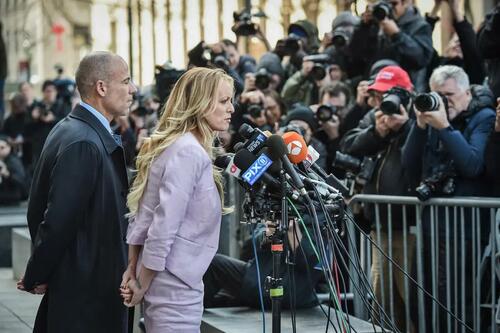 Adult film actress Stephanie Clifford, (C) also known as Stormy Daniels, speaks to the media next to her lawyer Michael Avenatti, after a court hearing in New York City on April 16, 2018. (Hector Retamal/AFP via Getty Images) Adult film actress Stephanie Clifford, (C) also known as Stormy Daniels, speaks to the media next to her lawyer Michael Avenatti, after a court hearing in New York City on April 16, 2018. (Hector Retamal/AFP via Getty Images)
Daniel Dixon with AT&T and Jennie Tomalin with Verizon testified to the authenticity of phone records that were then entered into evidence. Paralegal Jaden Jarmell-Schneider, with the district attorney’s office, created summary charts of records from Mr. Cohen’s phone the prosecutors believed relevant to the case.
Finally, Mr. Cohen testified as the final witness for the prosecutors, with testimony lasting a week.
The defense called few witnesses: Paralegal Danny Sitko, with defense attorney Todd Blanche’s office, had created summary charts of phone records between Mr. Cohen and attorney Robert Costello. Mr. Costello’s testimony refuted claims Mr. Cohen made that Mr. Costello was meant to keep tabs on him for Rudy Giuliani, who later became an attorney to President Trump.
Who Didn’t Testify?
Two people frequently mentioned in testimony were unavailable to the court. The first, Dylan Howard, chief content officer for AMI, initially brought the Clifford deal to the attention of Mr. Pecker and Mr. Cohen. Mr. Howard facilitated the purchase of the three stories mentioned at trial, and received and sent many texts shown in court exchanged between him and Mr. Davidson and Mr. Cohen. Mr. Howard now lives in Australia and is unable to travel due to a serious health condition.
Also unavailable was Allen Weisselberg, who is currently serving a five-month prison sentence for committing perjury in a separate civil fraud case that went to trial last fall. Mr. Weisselberg, the former CFO of The Trump Organization, came up with the idea to pay Mr. Cohen $420,000. Mr. Cohen could not testify as to why his reimbursement request for $130,000 was grossed up to $420,000, saying “I just wanted to get my money back.”
...
Will the Case Reach the Jury?
Defense attorneys made two requests for the judge to make a significant decision before turning things over to the jury: to dismiss the case or to find Mr. Cohen’s testimony not credible.
Justice Merchan is likely to issue a quick ruling on the motion, as he already instructed jurors to be present for closing arguments after the long weekend.
What Happens Next?
Justice Merchan asked jurors to prepare for a long day today.
Summations from both sides are expected to last the whole day, and the judge said his instructions to the jury would take an hour.
Prosecutors will sum up their case by reminding jurors of what they believe is the most compelling evidence. But for the defense, especially having called only two witnesses, this will be a key moment to present their own narrative.
Defense attorneys are expected to argue that nothing criminal occurred, as the nondisclosure agreements are legal, as is the payment of an attorney for legal services, and that the promotion of a person in an election through lawful means is not a crime.
On May 21, the judge held a charge conference with attorneys, who debated over what language would be used to instruct jurors on the applicable laws and their interpretation.
In some cases in which Justice Merchan rejected the attorneys’ proposed language, he said they could argue those points at summations on May 28.
The charge conference allowed both parties to present to the judge arguments about why certain language would prejudice their side, allowing the judge to put together an instruction script that avoids such prejudice.
How the judge delivers this interpretation of the law will inevitably influence the jury’s decision.
Should jurors be instructed that President Trump needed to have “willfully” concealed intent to defraud?
Should the instructions include an example explaining that a legal expense might not classify as a campaign expenditure?
Should jurors be told up front all the things prosecutors are not required to show?
Should jurors be given an example of what it means “to cause a false entry to be made"?
The jurors will work on May 29, when previously they have taken Wednesdays off, to begin deliberations while closing arguments are still fresh in their minds.
The jury’s job is to determine the facts of this case and decide whether those actions violated the law.
If the 12 jurors don’t come to a unanimous decision, the case will end in a mistrial.
There is no set time in which the jurors are required to return their verdict; a decision could be returned the same day or even take weeks.
Read more here...
|
[Markets]
They Want To Scare You With Myths Of "Unhampered Capitalism"
They Want To Scare You With Myths Of "Unhampered Capitalism"
Authored by George Fo4rd Smith via The Mises Institute,
Bad ideas are sometimes the hardest to dethrone. It’s probably accurate to say most people think of money as the paper currency printed by governments. And it is money in the sense that it functions as a medium of exchange, but is it sound? Is it vulnerable to inflation? Its very existence is evidence that it is, so why are so many people reluctant to switch to a money that isn’t?

There any many myths surrounding hard money currencies, and one of them is that money, both its nature and supply, is best left to the alleged guardian of our rights, the state. The fact that money came into existence on the market, and that its ultimate form and supply were determined by economic law, is disregarded. Money matters belong to the state because the state, unlike the rest of us, is in a position to remove itself from market discipline. Since the state is necessary to our survival, the story goes, it cannot do its job unless it can control the growth of money. Money, therefore, must be of such a nature that its supply can grow in accordance with the orders of a state-appointed committee.
Even the classical gold standard was under control of the state. When that control proved too limited for those eager for war, it was abandoned. The gold standard did not fail. States failed to keep the gold standard.
When Keynes unloaded his General Theory on the world in 1936 it was a manifesto of state economic law. Free-market economists would critique his work, but capitalism untethered scared the public. After 1929 it became the devil in fine suits. The fact that even top economists and industry leaders failed to see the Crash coming was especially unnerving.
Unaware of Austrian trade cycle theory, the public saw the market as an alluring evil, drawing people into its clutches with promises of riches then suddenly stripping them of their wealth. Fear, then, and not ideological persuasion led them to reject the market as it existed in the 1920s and along with it any notion that the unhampered market was self-regulating.
Prior to US entry into World War I, the government and its media allies worked hard trying to convince Americans that Germany was a threat to civilization itself. No such effort was required to scare them about the Depression. Unlike the Germans who were over there, the Depression was very painfully over here.
Robert Higgs’ outstanding book Neither Liberty Nor Safety: Fear, Ideology, and the Growth of Government underscores the importance of widespread fear for government growth. In his opening chapter, “Fear: The Foundation of Every Government’s Power,” he contends that, contrary to the positions of David Hume, Ludwig von Mises, Murray Rothbard, and others, public opinion is not the bedrock of government. Public opinion rests on something deeper and more primordial: fear. After the Great Crash, the man in the street feared the market, and the governments of Herbert Hoover and Franklin D. Roosevelt were eager to oblige. Gold, by then, had been corrupted enough to take the fall.
Whether the public still feared the market six years later was immaterial because neither major party offered a free-market candidate for election. But FDR knew the importance of keeping the public uneasy. In his State of the Union address of 1936, he told listeners, “In thirty-four months we have built up new instruments of public power. In the hands of a people’s Government this power is wholesome and proper. In hands under control of an economic autocracy such power would provide shackles for the liberties of the people.”
It’s difficult to believe Americans would fall for the notion of a wholesome people’s government, but the times were ripe for collectivist ideas as long as they were served up properly.
FDR won reelection that year by a huge landslide.
It’s been said that FDR saved capitalism by co-opting the radical left into his New Deal. Without FDR, in other words, we would be living under full fascism instead of quasi fascism. The free market was still useful, especially the name, but only if government-appointed bureaucrats regulated it, never mind the contradiction. Exactly which regulations were needed was a big unknown, but as a way of emphasizing the new in New Deal, government would experiment until it found the right combination. How would they know if the system of rugged individualism that favored the big guys was adequately harnessed? By looking at the economy. Every trouble spot, for the government, acted like a magnet, the attraction of which was in direct proportion to the potential votes at stake.
The Highly Regulated Free Market
So successful were FDR and his successors in saving capitalism that finding something today that isn’t taxed, regulated, subsidized, cartelized, forbidden, mandated, or bound like a mummy in endless red tape is a near impossibility. We can get a feel for the massive number of regulations the market is subjected to on the federal level alone by browsing the electronic version of the Code of Federal Regulations, updated daily by the Office of the Federal Register. Joe Biden, as president, has the whole economy in his hands. As Higgs points out, with passage of “the National Emergencies Act (1976) and the International Emergency Economic Powers Act (1977), nearly all economic liberties in this country exist at the sufferance of the president. If he decides to take over the economy, he possesses ample statutory power to do so.”
What was once an economy with a strong element of freedom has become an economy of rent-seeking special interests, or as Albert Jay Nock expressed it, people using politics to gain an “uncompensated appropriation of wealth produced by others.” In accordance with Garet Garrett’s thesis of a revolution within the form and the word, the old names have been quite useful for getting people to look the wrong way, as we saw in 2008 when George W. Bush announced he was abandoning free-market principles to save the free market.
The forgotten man of the Depression, whether Charles Sumner’s or FDR’s, was fearful, and considering the intellectual ammunition at his disposal, it’s easy to see why. But what can one say about today? Should people be fearful of the economic mess governments have created? Not necessarily. More people are beginning to understand, if only vaguely, that politics has brought the roof down, and that a sound economy is impossible without something politically indifferent supporting it: sound money.
Austrian critics are debunking the claims about gold’s role in the Great Depression, pointing out that the straw-man gold exchange standard of the 1920s and early 1930s was another government solution destined to collapse. Ben Bernanke’s statement that the longer a country remained committed to gold, the deeper its depression and the later its recovery is being seen as grossly misleading, at best.
(Earlier in his commentary Bernanke explained that the gold standard of the 1920s was a reconstituted version of the gold standard that had endured prior to World War I. Abandoning a pseudo–gold standard makes sense only if an honest monetary system replaces it. As it was, the country moved from one controlled system to one much worse.)
Unlike the poor souls of the Depression era, anyone on planet earth who is wired and can read English (and certain other languages) can access a vast literature of economic theory, applications, and criticism from an Austrian School perspective at Mises.org. It would be impossible to deal with today’s misinformation without the many works of Austrian analysis, most of which are accessible to a lay audience. In their absence we could well be the fearful captives of an FDR simulator like Joe Biden.
|
[Markets]
Bitcoin & The Wrong Lessons From Pizza Day
Bitcoin & The Wrong Lessons From Pizza Day
Authored by Jimmy Song via BitcoinMagazine.com,
The following is an excerpt on Bitcoin Pizza Day from "Fiat Ruins Everything" by Jimmy Song. Visit the Bitcoin Magazine Store to order a print, digital or audio copy of the book.
Pizza Day is often viewed with a sense of regret.

The well-known story goes like this: many years ago, Laszlo Hanyecz bought two Papa John’s pizzas, and in return, some fortunate person received 10,000 BTC.236 This tale resembles that of Peter Minuit purchasing Manhattan Island for a mere $24. It’s hard to believe such a transaction took place, considering the current value.
The story has several intriguing aspects. It marked the first real-world good or service purchased with Bitcoin. It also established Bitcoin’s price; since the two pizzas cost around $41, one BTC was approximately $0.0041.
Another aspect of this narrative is Laszlo, a pioneer in mining Bitcoin using GPUs (graphics processing units). He spent around 100,000 BTC on pizzas, as he made similar deals multiple times throughout the month. In a way, he’s the Santa Claus of this story, giving away value almost flippantly.
RENT-SEEKING FANTASIES
Pizza Day often triggers daydreams of becoming a Bitcoin billionaire through a single brilliant trade. Many people don’t fantasize about being Laszlo, as they aren’t GPU programming experts. However, they can easily imagine being the person on the bitcointalk forums offering to buy Bitcoin for a couple of pizzas.
The idea of having made such a trade sparks envy, as we all secretly resent the person who actually executed it. We perceive them as lucky, as if they had won the lottery.
These fantasies stem from a fiat mentality, where the value hierarchy is rooted in fiat money. The desire is to be lucky rather than skilled. People would prefer making money without working, versus earning it by providing valuable goods and services.
It’s revealing that the regret lies in missing out on luck rather than innovation. In a fiat-driven world, it’s easier to dream about being the person who sold the pizza, rather than the one who had the skill and foresight to mine with GPUs. This mindset prioritizes fiat accomplishments—getting lucky with money—over real achievements, which involve earning money by providing value to the market. Most people would rather ride the coattails of an innovator than be one themselves.
BITCOIN REGRET
We all have our Bitcoin regret stories. I remember learning about Bitcoin in February 2011. I tried to find a way to buy it using a credit card, but I couldn’t. I attempted mining on Amazon Web Services and didn’t find any blocks solo-mining for two days. I began the process of moving dollars into Mt. Gox, but when the price dropped from $1 to $0.90, I decided it was too much of a hassle to set up. I could have bought Bitcoin at $0.90, but I didn’t. It’s one of the biggest regrets of my life.
Everyone has different regret stories. Perhaps you heard about Bitcoin back in June 2011 when it ran up to $30 and regret not buying it then. Maybe you discovered Bitcoin in April 2013 when it reached $266, or later that year in December 2013 when it soared to $1,100. Or perhaps it was in 2017 when it hit $2,500, $5,000, and then $19,000. Or even more recently, in March 2020 when Bitcoin crashed to under $4,000, or later that year when it was breaking $10,000. Anyone who’s heard about Bitcoin at any point in its history has a regret story.
Bitcoin regret stories are like bad-beat stories in poker. Everyone has them, and they are fantasies about different, luckier outcomes. They are unproductive stories because the feelings of regret come from a fantasy that assumes virtues that are not common.
THE CHALLENGE OF HOLDING
In these regret stories, we often overlook something. What if we had bought Bitcoin when we first heard about it? How would we have handled the subsequent challenges? Would we have had the diamond hands to hold through the 85% drawdowns in 2011, 2013, 2014, and 2018?
When you fantasize about the Pizza Day story, do you ever consider the difficulty of holding during the tough times in 2011, 2013, 2014, and 2018? There’s a tendency to assume that we would have had the conviction that we possess now, like how a time traveler might feel. I’ve experienced those drawdowns firsthand, and let me tell you, most people didn’t have that conviction, and they sold. Many believe they would have held strong through all the difficult times, but like the original O.J. Simpson verdict, that assumption goes against all evidence.
Holding 10,000 BTC wasn’t uncommon back in 2010. Many people had a significant amount of Bitcoin because they were worth pennies at the time, but where are they now? Most of them sold when the Bitcoin price doubled or tripled and never looked back.238 They viewed Bitcoin as a plaything and didn’t grasp its revolutionary nature. So, they sold it to buy a new computer, a new bike, or a new car.
SHATTERING YOUR DREAMS
Had you sold Laszlo two pizzas for 10,000 BTC in 2010, you probably would have sold them in the new few years. To think otherwise is hubris. Most people back then didn’t understand what Bitcoin was, and there were no educational resources explaining why you should hold. We now have an abundance of resources for understanding Bitcoin.239 In 2023, it’s much easier to comprehend that Bitcoin is a better form of money than anything that came before. Back in 2010, it was much more difficult. Do you still think you would have had diamond hands?
To hold Bitcoin is to have a deep conviction about what it is. There are necessary virtues to be a long-term holder. Holders understand the fundamental value of Bitcoin being sound money and can thus withstand the 85% drawdowns that occur regularly. Only the truly extraordinary managed to hold from 2010, and you likely would not have been one of those people.
But suppose you beat the odds and had conviction. You held through 2011 and even the first bubble in 2013. Would you have had the foresight to withdraw to your wallet before Mt. Gox collapsed in 2013?240 Or if you used another exchange before then, would you have gotten out before they exit-scammed?241 We say “not your keys, not your coins” now, but back then, this was not common practice. Many people had to be burned for that lesson to become a meme. Even with conviction, there’s a good chance you would have been one of the many who suffered.
There were also other dangers, like the advent of altcoins starting in 2011. How many Bitcoins would you have lost in Geistgeld,242 Feathercoin,243 and MasterCoin?244 There were also numerous scams, including Pirate40245 and others who promised high returns by running Ponzi schemes. Would you have avoided those? There were also several ASIC startups that sold machines that weren’t built yet. Would you have avoided getting duped by Butterfly Labs246 or TerraMiner?247 How about the cloud mining services248 that took your Bitcoin and paid out only a fraction over the next 12 months? Would you have avoided these tempting offers that ended up diminishing many Bitcoin stacks? You would have needed the instinct to get in on Bitcoin early while not falling for these similar-sounding investments, which frankly is not an easy needle to thread.
Looking back on those dangers, it’s a miracle that people made it past those years with any Bitcoin at all. Many OGs are like Vietnam veterans, reflecting on the times when they were fortunate to escape the numerous hazards.
BUILDING CONVICTION IS CHALLENGING
Developing deep conviction is not easy, and for early adopters, it was especially difficult. Remember, everyone was calling Bitcoin a scam back then. Even now, it takes years of study and unwavering resolve to develop that conviction. Back in 2010-2013, having Bitcoin conviction was as rare as a physically-fit government health official.
Going against conventional wisdom and following your convictions requires a great deal of courage, which many people lack. Consider what happened during COVID-19. How many people had the conviction to voice opinions against the mainstream narrative in March 2020? That’s the level of conviction you had to possess to hold Bitcoin through those early years.
In 2023, we have numerous resources that help us save in Bitcoin. Podcasts, books, and videos are available to help us navigate this space, not only to develop the conviction but also to adopt best practices for holding. The early years were a minefield of traps to lose your Bitcoin. It’s much easier these days to avoid those traps, but back then, there weren’t OGs who could warn you about them. The resources that exist now and the Bitcoin memes we have today (“Not your keys, not your coins.”) are not propaganda. They are the fruit of hard-earned experience.
BITCOIN DERANGEMENT
Studying the early individuals in the Bitcoin space reveals a troubling pattern. Almost every non-technical Bitcoin advocate pre-2013 is now promoting an altcoin. Why have so many early adopters become Bitcoin-deranged?
We can find some answers by looking at the fiat world of lottery winners. Years after winning, numerous lottery winners end up worse off than before they won the lottery. They are ill-equipped to manage the windfall, and many find themselves with greater debt, damaged relationships, and a worse life. Some even commit suicide. While not everyone experiences such negative outcomes, enough do that many lottery agencies proactively offer assistance.
Unfortunately, bad outcomes have been the fate of many early Bitcoin adopters. At some point in the last decade, they either fell victim to scams or became scammers themselves. As a result, many of them have turned against Bitcoin.
So, to further shatter your daydream, there’s a good chance that if you had gotten in early, you would be an altcoin scammer or would have been scammed by an altcoin. These are serial scammers with no qualms about lying, cheating, or stealing their way to wealth. They exist in a rent-seeking nightmare of shattered dreams. That’s not a desirable fate, and it’s something I wouldn’t wish on my worst enemy.
LEVEL UP YOUR CONVICTIONS
For many, Pizza Day is an opportunity to indulge in time-traveling fantasies where they daydream about being wealthy. This mindset often leads people to explore altcoins, as it stems from the fiat money mentality. Essentially, Pizza Day is a fantasy about being lucky and not having to work. In other words, it represents a rent-seeking desire on a grand scale.
Fiat money has fostered a consumerist mentality, which exacerbates the urge to rent seek. Governments capitalize on this desire through lotteries, profiting from the allure of easy wealth. Altcoins exploit the same yearning. Unfortunately, Pizza Day often reinforces this mentality, focusing on the desire to be fortunate rather than skilled.
Instead, Pizza Day should serve as a reminder that forming conviction is no easy task. True conviction demands knowledge, wisdom, and courage—virtues that require time, energy, and effort to develop. Rather than envying early adopters and fantasizing about joining their ranks, we should strive to cultivate the conviction needed to hold through challenging times and provide value in the process. As the saying goes in the Bitcoin community, “It’s still early.”
On Pizza Day, commit to leveling up your convictions.
TEN THINGS YOU BOUGHT INSTEAD OF BITCOIN
- 1-
That sleek, irresistible Apple gadget you just had to have, only to replace it two years later with an even shinier, more irresistible version.
- 2 -
Green gems in Clash of Clans, because clearly, the defense of your virtual village was of greater importance than securing your financial future.
- 3 -
A college degree with about as much relevance to your current job as a penguin waddling through the Sahara Desert.
- 4 -
Litecoin, the less secure, less functional cousin of Bitcoin— because who needs the real deal when you can settle for something much worse?
- 5 -
A dating app subscription that merely solidified your status as forever alone.
- 6 -
Steam games on sale, eagerly awaiting their debut in your library, wondering when they’ll finally bask in the glow of your screen.
- 7 -
That exercise equipment now serving as an exquisite clothes rack, because let’s face it, the allure of the couch is simply too strong to resist.
- 8 -
An online class you signed up for, attended just long enough to say “hello” and “goodbye,” then promptly ghosted.
- 9 -
The, uh, “adult entertainment” that left you feeling deflated and questioning your life choices the next day.
- 10 -
An MLM product from a Facebook friend that you abandoned quicker than you can say “pyramid scheme.”
* * *
Click here to order a copy of "Fiat Ruins Everything: How Our Financial System is Rigged and How Bitcoin Fixes It", by Jimmy Song.
|
[Markets]
The Incoming Commercial Real Estate Crisis No One Seems Prepared For
The Incoming Commercial Real Estate Crisis No One Seems Prepared For
Authored by Kevin Stocklin via The Epoch Times (emphasis ours),
It has been a year since a string of U.S. regional bank failures, together with the collapse of global heavyweight Credit Suisse, caused many to fear that a major financial crisis was imminent.
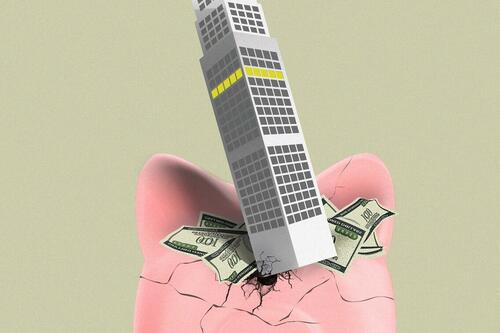 (Illustration by The Epoch Times, Shutterstock) (Illustration by The Epoch Times, Shutterstock)
But, by the summer of 2023, the panicked withdrawals by frightened depositors largely subsided.
In February, however, New York Community Bank (NYCB) appeared to resurrect the crisis when it announced $2.4 billion in losses, fired its CEO, and faced credit downgrades from rating agencies Fitch and Moodys.
In what has become a familiar tale for U.S. regional banks, NYCB’s share price plummeted by 60 percent virtually overnight, erasing billions of dollars from its market value, and its depositors fled en masse.
“I think that there’s more to come,” Peter Earle, a securities analyst and senior research fellow at the American Institute for Economic Research, told The Epoch Times.
Underlying this year’s turbulence is the fact that many regional banks are sitting on large portfolios of distressed commercial real estate (CRE) loans. according to Mr. Earle. And many are attempting to cope through a process called “extend and pretend,” in which they grant insolvent borrowers more time to pay in hopes that things will get better.
“There is trouble out there, and most of it probably won’t be realized because of the ability to roll some of these loans forward and buy a few more years, and maybe things will recover by then,” he said.
“But all it does is it kicks the can down the road, and it basically means a more fragile financial system in the medium term.”
NYCB’s problem was an overwhelming exposure to New York landlords who were struggling to stay solvent. At the start of this year, the bank had on its books more than $18 billion in loans to multifamily, rent-controlled housing developments.
This situation was particularly concerning given that NYCB had been the safe-haven institution that rescued Signature Bank, another failing regional bank, in March 2023.
Much of what took down banks such as Signature Bank in last year’s banking crisis was an unmanageable level of deposits from high net worth and corporate clients that were too large to be insured by the Federal Deposit Insurance Corporation (FDIC).
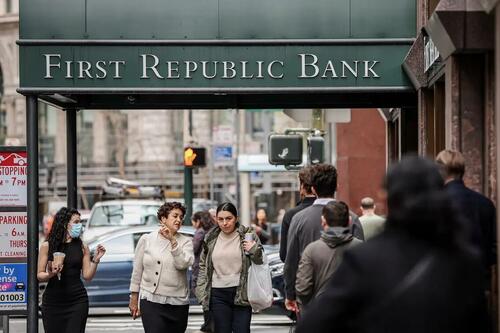 People walk by the First Republic Bank headquarters in San Francisco on March 13, 2023. (Justin Sullivan/Getty Images) People walk by the First Republic Bank headquarters in San Francisco on March 13, 2023. (Justin Sullivan/Getty Images)
In Signature Bank’s case, about 90 percent of its deposits were uninsured, and depositors rushed to withdraw their money when the bank came under stress from losses in the cryptocurrency market.
Another source of stress for regional banks was their inability to cope with an aggressive series of interest rate hikes by the Federal Reserve to combat inflation. Many banks that held large bond portfolios yielding low fixed rates found that the value of these portfolios declined sharply, creating unrealized losses.
While these portfolios, often made up of U.S. Treasury securities, were considered safe from a credit perspective, they were subject to market risk, and their loss of value sparked concerns about the banks’ solvency in the event they had to be sold. As stock traders rushed to sell the shares of banks with large exposures to interest rate risk, customers became spooked and raced to withdraw their money.
Consequently, unrealized losses quickly became actual losses as banks were forced to sell bonds and loans at a loss in an increasingly futile attempt to make panicking depositors whole.
Rate Hikes Cease, Problems Remain
Today, while interest rates remain high, they are relatively stable. And yet concerns about the health of U.S. regional banks remain because of their large exposure through CRE, including office buildings, multifamily housing units, and retail spaces.
While CRE loans make up about 13 percent of the balance sheets of the biggest U.S. banks, they make up 44 percent of regional banks’ lending portfolios. CRE loans designated as nonperforming doubled as a percentage of U.S. banks’ portfolios from 0.4 percent in 2022 to 0.81 percent by the end of 2023.
In total, there are about 130 regional banks in the United States, with a little more than $3 trillion in assets. These banks, which each have between $10 billion and $100 billion in assets, are typically more exposed to the boom and bust of local markets but also to specific sectors within those markets where they have been able to operate profitably.
While other credit sectors, such as home mortgages, car loans, and corporate loans, are generally the domain of larger financial institutions, regional banks have found a profitable niche in lending to real estate investors. But in the past several years, commercial landlords have been taking hits from two directions.
Since the introduction of lockdowns and the rise of work-at-home culture during the COVID-19 pandemic, many corporations have viewed office rents as a cost ripe for cutting.
According to an April CRE report by Commercial Edge, the office vacancy rate across the United States was 18.2 percent as of March, an increase of 1.5 percent over the prior year.
“U.S. office vacancy rates have increased in recent years as companies embrace remote and hybrid work and re-examine their office footprints,” the report reads. “The increases are not concentrated in just one market or sector.”
Read more here...
|
|
[Entertainment]
Washington Post hardcover bestsellers
A snapshot of popular books.
Published:5/22/2024 7:04:05 AM
|
[Markets]
Ukrainian Special Recon Commander Confirmed That Kharkov's Border Was Undefended
Ukrainian Special Recon Commander Confirmed That Kharkov's Border Was Undefended
Authored by Andrew Korybko via Substack,
BBC published a report over the weekend about how “The Russians simply walked in, Ukrainian troops in Kharkiv tell BBC”, citing special reconnaissance commander Denis Yaroslavsky.

According to him, “There was no first line of defence. We saw it. The Russians just walked in. They just walked in, without any mined fields. Either it was an act of negligence, or corruption. It wasn’t a failure. It was a betrayal.”
Here are three background briefings to familiarize the reader with this subject before proceeding:
* 2 December 2023: “Ukraine Is Bracing For A Possible Russian Offensive By Fortifying The Entire Front”
* 28 February 2024: “The Ukrainian Intelligence Committee Is Preparing For The Worst-Case Scenario”
* 18 March 2024: “Putin’s Talk Of Setting Up A ‘Sanitary/Security Zone’ In Ukraine Hints At A Potential Compromise”
To summarize, Zelensky ordered the armed forces late last year to prepare for a new Russian offensive sometime during this one, which the Ukrainian Intelligence Committee predicted less than three months ago could occur in May or June. President Putin then warned in mid-March that his country could carve out a buffer zone in Ukraine to stop the shelling of nearby Russian cities and cross-border raids against neighboring regions. Russia’s fresh push into Kharkov Region therefore clearly wasn’t a surprise.
This makes it all the more shocking though that its forces “simply walked in”, after which it made such progress in the span of just a few days that Kiev panicked by replacing the senior commander responsible for defending this front. No personnel changes can rewind the clock and build the border fortifications that Zelensky assumed were constructed by now.
Kharkov is Ukraine’s second-largest city, so if it was left largely undefended, then other less significant border ones are probably undefended too.
Russia might therefore expand its incipient Kharkov offensive to neighboring Sumy Region if that’s indeed the case, thus exacerbating Ukraine’s already dire conscription and logistics crisis to the point of collapse in an attempt to achieve a decisive military breakthrough for finally ending this conflict. It’s unclear, however, whether Russia would attempt to enter Ukraine once again from Belarus after La Repubblica claimed earlier in the month that this could trigger a conventional NATO intervention.
Russia wants to deter that from happening, but if it’s not successful, then it at least wants to ensure that NATO troops remain west of the Dnieper. That’s why it announced tactical nuclear weapons exercises last week in order to showcase its associated potential for destroying any large-scale NATO invasion force that tries to cross that river en route to directly clashing with Russia on its borders. Since the Kremlin has a track record of self-restraint, it might therefore eschew the Belarusian option, at least for now.
Shoigu’s replacement as Defense Minister by professional economist Belousov lends credence to the abovementioned assessment since the latter is unlikely to consider the hoped-for benefits of once again entering Ukraine from Belarus to be worth the reported risks. President Putin could always overrule him as the Commander-in-Chief, but if there were any credible indications that he was considering anything of the sort, then Western satellites would have already presumably captured proof of the preparations.
For that reason, observers shouldn’t expect a redux of early 2022’s Belarusian-originating offensive, especially since video evidence from January suggests that this front isn’t anywhere near as undefended as Kharkov Region’s border was. Instead, it’s possible that Russia’s incipient Kharkov offensive could expand to neighboring Sumy Region to re-open the northeastern front in order to facilitate a breakthrough across the Donbass and Zaporozhye ones for expelling Kiev from Russia’s new regions.
It remains to be seen whether that’ll happen, but the BBC’s candid report about how Russia simply walked into Ukraine’s Kharkov Region despite half a year of allegedly building border fortifications there proves that it can’t be ruled out either. As Ukrainian special reconnaissance commander Yaroslavsky told them, “Either it was an act of negligence, or corruption. It wasn’t a failure. It was a betrayal”, which might go down in the history books as one of the Russian special services’ greatest achievements.
|
[Markets]
HPV Vaccination May Trigger Rare And Often Misdiagnosed Autoimmune Brain Disease
HPV Vaccination May Trigger Rare And Often Misdiagnosed Autoimmune Brain Disease
Authored by Megan Redshaw, J.D. via The Epoch Times (emphasis ours),
 (Kateryna Kon/Shutterstock) (Kateryna Kon/Shutterstock)
New research suggests the human papillomavirus vaccine (HPV) can trigger a rare autoimmune brain disorder that causes psychiatric or neurological symptoms following vaccination—and is easily mistaken as psychosis in its early stages.
A recently published study in Current Medicinal Chemistry identified a possible relationship between anti-N-methyl-d-aspartate (NMDA) receptor encephalitis and HPV vaccination.
Anti-NMDA receptor encephalitis is an acute autoimmune disorder where the body creates antibodies against the N-methyl-D-aspartate receptors in the brain. NMDA is a receptor of the amino acid glutamate. Glutamate is the most abundant excitatory neurotransmitter released by the brain’s nerve cells and plays a crucial role in learning and memory formation.
When the anti-NMDA antibodies attack the brain, they disrupt normal brain signaling, causing swelling—or encephalitis—and a host of neuropsychiatric symptoms such as hallucinations, cognitive disturbances, paranoia, aggression, epilepsy, movement disorder, impaired consciousness, and speech disorders. It’s these symptoms that often cause the condition to be misdiagnosed in its early stage as psychosis.
The Study
The paper’s author, Hsiuying Wang, is a professor of statistics at the National Yang Ming Chiao Tung University. She looked at microRNA (miRNA) biomarkers to explore the relationship between anti-NMDA receptor encephalitis and vaccination.
“Although vaccines, such as the HPV vaccine, do not directly induce autoimmune diseases, they can potentially induce an autoimmune response or worsen pre-existing autoimmune conditions in certain individuals,” Ms. Wang told The Epoch Times.
Ms. Wang performed a literature search and identified 16 microRNA (miRNA) biomarkers of HPV and studied biomarkers associated with anti-NMDA receptor encephalitis. The analysis revealed at least four miRNA biomarkers that the two conditions commonly share.
According to The Journal of Nutritional Biochemistry, miRNAs regulate a range of developmental and physiological processes and are useful biomarkers for cancer and other diseases.
Using a phylogenetic tree, Ms. Wang then analyzed the relationship of the miRNA biomarkers associated with HPV and anti-NMDA receptor encephalitis, as well as for other viruses related to anti-NMDA receptor encephalitis. A phylogenetic tree is a diagram that illustrates the evolutionary relationships between different organisms.
The study found a high degree of similarity between miRNA biomarkers associated with HPV and anti-NMDA receptor encephalitis or related vaccines when compared to overall miRNAs.
“While the direct causal connection between HPV and anti-NMDA receptor encephalitis is minimal, insights from the microRNA biomarker study underscore the importance of not overlooking the potential link between this condition and HPV vaccination,” Dr. Wang said.
“Therefore, in cases where individuals receiving the HPV vaccine develop psychiatric or neurological symptoms, a diagnosis of anti-NMDA receptor encephalitis should be considered after ruling out other complications,” she added.
Association With COVID-19 Vaccines
Anti-NMDA receptor encephalitis was first identified in 2007 by researchers who saw the condition in women with ovarian tumors. It has since become the second most common immune-mediated encephalopathy and has presented after numerous viral illnesses, including Epstein-Barr and COVID-19. It is also associated with vaccines, including H1N1, yellow fever, TdaP-IPV booster, and COVID-19, primarily in young women.
Another notable characteristic of anti-NMDA receptor encephalitis is that it may be triggered by tumors due to the cross-reactivity with NMDA receptors in tumors containing brain cells. Ovarian, neuroendocrine, mediastinal teratomas, testicular teratomas, and small-cell lung carcinoma have all been reported to be associated with anti-NMDA antibodies.
In a 2021 case report in Frontiers in Neurology, researchers describe a female in her 20s who developed anti-NMDA receptor encephalitis after receiving her first dose of Pfizer’s COVID-19 vaccine. Within a week of being vaccinated, she went to the emergency department complaining of frequent urination.
Her family said she had “increasingly frequent” episodes of anxiety, decreased mental acuity, insomnia, and a “fixation” that she had irritable bowels and kidney disease. Additionally, she experienced delusions that she had COVID-19 and her body was “shutting down,” motor dysfunction, and a transient inability to understand or speak. However, her labs were normal and a physical examination only revealed tachycardia and hypertension, so she was released. The next day she returned and was kept for observation.
After removing her clothes and having a bowel movement on the floor, she was transferred to an inpatient psychiatric unit where she was treated with antipsychotics. She returned to the emergency department after experiencing a seizure, and her cerebral spinal fluid (CSF) revealed anti-NMDA receptor encephalitis.
“The constellation of symptoms (spontaneous defecation, catatonia, sudden encephalopathy without metabolic or infectious findings) coupled with the preliminary CSF results and the history of deterioration after SARS-CoV-2 vaccination led to a strong clinical suspicion of an autoimmune-mediated encephalitis driven by the vaccine,” the paper’s authors wrote.
The researchers said anti-NMDA receptor encephalitis was not considered when the patient initially came to the emergency room because she was experiencing primary symptoms of psychiatric diseases and had no signs of a fever, systemic infection, or inflammation.
Similarly, a 2022 study published in the Journal of Epilepsy Research found that Pfizer’s COVID-19 vaccine may activate anti-NMDA receptor antibodies present before vaccination. According to the case report, a 20-year-old female who unknowingly had an ovarian tumor developed anti-NMDA receptor encephalitis one day after receiving Pfizer’s COVID-19 vaccine.
Her initial symptoms included abnormal behavior, disturbances in comprehension and reading, repetitive questions, and sending inappropriate text messages to friends. Three days after vaccination, the patient experienced a grand mal seizure that took her to the emergency department, where her CSF revealed anti-NMDA receptor encephalitis. After proper treatment, she “returned to usual life.”
|
[Entertainment]
Book It To the Beach With These Page Turning Summer Reads
 Beach chair, sunscreen and your cutest sunglasses.
These are just some of the most important staples when packing a bag for a day at the beach. But right near the top of the list—after SPF, of...
Beach chair, sunscreen and your cutest sunglasses.
These are just some of the most important staples when packing a bag for a day at the beach. But right near the top of the list—after SPF, of...
Published:5/20/2024 10:42:32 AM
|
|
[Culture]
Portrait of a Collaborator
The French Resistance looms large in our collective memory of the Second World War. The chain-smoking, beret-clad partisan is a stock character in countless movies and TV shows; more soberly, the genuine heroics of the maquis have been chronicled in thousands of books, articles, and documentaries. Such has been the prominence of these portrayals that […]
The post Portrait of a Collaborator appeared first on The American Conservative.
Published:5/19/2024 4:33:24 PM
|
[Entertainment]
The Biggest Changes Bridgerton Season 3 Made From the Books
 This story contains spoilers from Bridgerton season three and the first four Bridgerton books.
Dear gentle reader, season three of Bridgerton is finally upon us. Well, the first half anyway.
The...
This story contains spoilers from Bridgerton season three and the first four Bridgerton books.
Dear gentle reader, season three of Bridgerton is finally upon us. Well, the first half anyway.
The...
Published:5/19/2024 8:16:21 AM
|
|
[]
Fantasy Author Brandon Sanderson Sold Out His Religion To The LGBTQ Agenda
Published:5/18/2024 1:06:03 PM
|
[Markets]
Oil Tanker Struck By Missile Off Yemen Coast
Oil Tanker Struck By Missile Off Yemen Coast
As Ukrainian drones relentlessly target Russia's energy complex, tensions in the Middle East are once again rising. Early Saturday, Agence France-Presse reported that a crude oil tanker was hit by a missile off the coast of Yemen. These mounting geopolitical risks underscore the possible need for a higher risk premium on Brent crude prices.
Maritime security firm Ambrey told AFP News that the oil tanker was near the Bab el-Mandeb strait and about ten nautical miles southwest of the city of Mokha at the time of the incident.

Ambrey indicated the Panama-flagged oil tanker was hit by a missile and that there was a fire in the steering gear flat.
Since November, Iran-backed Houthi rebels have been attacking commercial vessels linked to Western nations passing through the Bab el-Mandeb strait and the Red Sea, mostly in response to their support for Israel in the war against Hamas in Gaza.
In recent weeks, Yahya Saree, spokesperson for the terror group, warned in a televised speech that rebels intend to target Israel-linked ships in the eastern Mediterranean.

With President Biden's Operation Prosperity Guardian failing to defend maritime traffic in the region, Iran and their proxy groups have successfully severed a major shipping route for some Western companies, forcing them to divert around the Cape of Good Hope.
We have outlined one major example of Biden's failures in the Red Sea:
In April, the international shipping industry pleaded with the United Nations for help, urging increased military patrols along key shipping routes in the Middle East. We have pointed out several maritime chokepoints, including the Suez Canal, Bab-El Mandeb Strait, and Strait of Hormuz, through which a quarter of all global trade flows, are experiencing increased conflict.

In a recent note, MUFG provided a global snapshot of the world's maritime chokepoints.
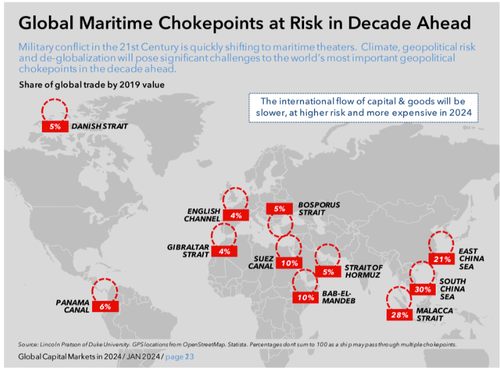
In markets, Brent crude prices have traded between $80/bbl and $90/bbl this year on rising geopolitical tensions in the Middle East and Eastern Europe. Last month, there was fear that the Israel-Iran conflict would send Brent prices into triple-digit territory. However, prices have since declined to the $83 handle.
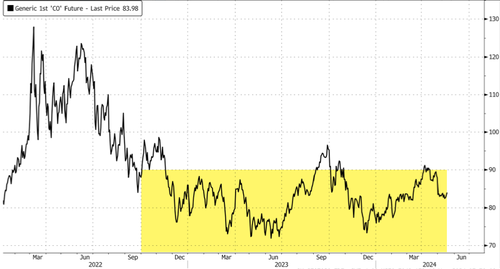
This chaos is a sign of weakness from the West as the world fractures into a multipolar state. More turmoil and disruptions in global supply chains are yet more evidence oil prices will stay elevated unless central banks plunge the world into a global depression.
Rapidan Energy Group commented on this incident: "The latest attack is yet another reminder of an underpriced geopolitical risk premium in oil as multiple armed actors remain undeterred by US-led diplomacy and maritime coalitions."
|
[Markets]
The Decay Of Everyday Life
The Decay Of Everyday Life
Authored by Charles Hugh Smith via OfTwoMinds blog,
So where does this leave us? We're on our own.

This month I've described what can be summarized as The Decay of Everyday Life: the erosion of the fundamental elements of everyday life: work, opportunity, social mobility, security and well-being, which includes civility, conviviality and a functional, competent social-political order.
In other words, Everyday Life includes far more than the financial statistics of Gross Domestic Product (GDP), the stock market, wealth and income. Everyday Life is fundamentally about relationships, agency (i.e. control of one's life and ownership of one's work), the fulfillment of life's purposes (livelihood, family, friends, community and self-growth), leisure time and the experiences of everyday living, both the stressors and the joys.
As I've explored in recent posts, the experiential elements of Everyday Life have decayed over the past 40 years: life is more difficult and less secure in ways that are not offset by technological advances. Indeed, the most highly touted technological advances (Internet and mobile phones) have increased the burdens of shadow work and introduced new pathways of addiction and stress that have reduced well-being. Rather than being free, they include structures of control that we have yet to grasp, much less limit.
Here are my recent posts:
The Decay of Everyday Life echoes the title of one of the more important books I've long recommended, The Structures of Everyday Life Civilization and Capitalism, 15th-18th Century Volume 1 by Fernand Braudel. The book outlines how changes in the economic structure led to changes in everyday life.
The structures I outline in the five posts describe the economic structures that shape our daily lives and the political and social structures we inhabit. While I focus attention on the way globalization and financialization have hollowed out our economy and increased the precarity of labor, in the larger context we can identify these structural drivers of decay:
1. The balance between labor and capital has been skewed to capital for 50 years. Labor's political power and share of the economy has declined while capital's political and economic power has become dominant. This has driven income-wealth inequality to extremes that are destabilizing the economy and the political-social orders.
Increasing the sums labor can borrow to keep afloat only works until debt service consumes all disposable income, crushing consumption. The end result is mass default of debt and the erasure of debt-based "assets" held by the financial elites (top 10%).
Labor will have to restore the balance with capital or the system will collapse in disorder. History is rather definitive about this causal chain.
2. Process and narrative control have replaced outcomes as the operative mechanisms and goals of the status quo. The illusions of limitless "progress" and "prosperity" have generated a mindset in which outcomes no longer matter, as "progress" and "prosperity" are forces of Nature that can't be stopped, so we can luxuriate in Process--completing forms and compliance documents, submitting reports to other offices, holding endless meetings to discuss our glacial "progress", mandating more Process, elevating managers who excel at Process--with the net result that building permits that were once issued in a few days now take months, bridges take decades to build, and incompetence reigns supreme.
To obscure the dismal outcomes--failure, delays, poor quality, errors--narrative control is deployed, expanded and rewarded. The managerial class has been rewarded and advanced not for generating timely, on-budget, high-quality outcomes, but for managing Process and Narrative Control: everything's going great, and if it isn't, the fault lies elsewhere.
The net result of this structure is that the competent either quit in disgust or or assigned to Siberia, while the incompetent are elevated to the highest levels of corporate and public-sector management.
3. The dominance of monopolies and cartels has fatally distorted markets and politics, undermining the foundations of everyday life. By eliminating competition and buying political-regulatory complicity, monopolies and cartels lock in ample, stable profits, profits that are increased by squeezing labor and reducing the quality and quantity of goods and services, to the point that quality services and goods are either luxuries available only to the elite or simply unavailable at any price, as the knowledge, systems and values required to produce high-quality goods and services have been irrevocably lost.
4. The dominance of digital communications in everyday life has increased the unpaid shadow work we're forced to do and injected new forms of narrative control, digital hypnosis, addiction and derangement into daily life that cannot be reversed in any meaningful way other than drastically limiting our exposure to the toxic flood tide.
So where does this leave us? We're on our own. The status quo is incapable of unwinding the fatal distortions generated by the dominant economic structures, and so it is also incapable of "saving" us from being seated at the banquet of consequences. This is why the only rational response is to focus on increasing our Self-Reliance.
Rather than becoming enraptured by the apologists and cheerleaders proclaiming everything's great, launching a lifeboat and setting a course for land is a strategy with much higher odds of success.
* * *
Become a $3/month patron of my work via patreon.com.
Subscribe to my Substack for free
|
[Markets]
The Trouble With World Government
The Trouble With World Government
Authored by Jeffrey Tucker via The Epoch Times,
Well, at least that’s one setback for world government.
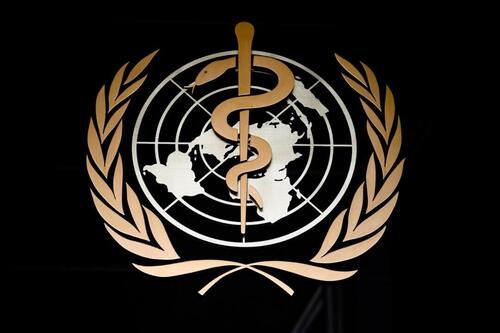
A court in Australia has told the government’s own eSafety Commission that Elon Musk is correct: One country cannot impose censorship on the world. The company X, formerly known as Twitter, must obey national law but not global law.
Mr. Musk seems to have won a very similar fight in Brazil, where a judge demanded not just a national but global takedown. X refused and won. For now.
This really does raise a serious issue: How big of a threat are these global government institutions?
Dreamy, dopey, and often scary intellectuals have dreamed of global government for centuries. If you are rich enough and smart enough, the idea seems to be the perennial temptation. The list of advocates includes people who otherwise have made notable contributions: Albert Einstein, Isaac Asimov, Walter Cronkite, Buckminster Fuller, and many others.
Often the dream comes alive following huge upheavals such as war and depression. Or a pandemic period such as the one we’ve just gone through. The use of “disinformation” as a cross-border test case of global government power is designed to deploy a new strategy of governance in general, one that disregards national control in favor of global control.
That has always been the dream. In history, for example, following the Great War, we saw the creation of the League of Nations, which was a forerunner to the United Nations, at the urging of President Woodrow Wilson. Both were seen by the intellectual class as necessary building blocks for what they really wanted, which was a binding world state.
This is not a conspiracy theory. It’s what they said and what they wanted.
In 1919, H.G. Wells, inspired by the League, became so excited about the idea that he wrote a sweeping reinterpretation of world history that extended from the ninth century B.C. until that present moment. It was called “The Outline of History.”
The goal of the book was to turn on its head the popular Whig theory from the previous century, which saw history as the story of ever more freedom for individuals and away from powerful states. Wells told a story of tribes turning to nations and then to regions, with ever less power to the people and ever more to dictators and planners. His purpose was to chronicle and defend exactly this.
It was a huge bestseller at a time when the appetite for books was voracious because they were becoming affordable and there was a burning passion in the population for universal education. The thesis of his book, however valuable in some historical respects, was genuinely bizarre. He imagined a future world state ruled by a tiny elite of the smartest people who would plan all economies, information flows, migration patterns, and governance systems while crushing national ambitions, free enterprise, traditions, and constitutions.
It was crazy stuff and didn’t really happen. But the efforts never stopped among a certain class of intellectuals. Following World War II, we saw similar efforts, the U.N. being only one. In the agreement hammered out at Bretton Woods in 1944, we had forged the World Bank and International Monetary Fund (IMF), which were seen as the basis of a global planning apparatus, together with a new world monetary system.
None of this worked out either. The IMF and World Bank ended up being well-funded sinecures for elite academics but not really the financial basis of a world state. The U.N. turned into a disappointment for many. The efforts at global management of trade finally came to fruition with the World Trade Organization, but that machinery has proven mostly toothless and unable to stop the sweeping turning back on free trade that has taken place over the past five years. Today, no nation really fears that entity.
The drive to unite Europe was advertised as a liberal move to inspire cooperation on trade and travel and to make economic cooperation possible. But that was just the pitch. The reality of the European Union was the creation of a mean bureaucracy in Brussels that would override the sovereignty of nations and force deference to a new central state in Europe that actually had no historical precedent. It was an experiment in region-wide government planning.
Britain was always a reluctant member, but when its worst fears were realized, the people voted to leave the whole thing. The result was Brexit, a political movement that panicked elites all over the world. They saw the plans of decades going up in smoke. Boris Johnson became prime minister with the task of making Brexit happen, but his rule was confounded at every step. Finally, the COVID-19 pandemic came along to upend his entire tenure.
One way to understand the COVID-19 pandemic response is as a further experiment in world government, a way for the elites to broadcast to the entire planet that they can achieve global cooperation when they want to.
In most every nation, the response was the same in terms of timing and protocol. Social distancing was everywhere, and masks, too. The breakup of gatherings including worship, along with idiotic schemes such as one-way grocery aisles, were imposed everywhere. The slogans (“We are all in this together”) and signage (wash hands, keep distance, mask up) were also the same.
It was creepy in the extreme, especially when you consider the way it all happened at once, even though we knew for sure that there are huge hemispheric differences in the way respiratory pathogens spread. Something can be a problem in New York but not in Sydney. Why did this happen all at once? The message seemed to be: This is just what we do in a global pandemic.
What they did not tell anyone is that none of this constituted “common sense public health measures” but rather amounted to an experiment without any precedent in the history of humanity. Nowhere had all this cockamamie stuff ever been implemented. Only crazy people had recommended them in the past, but the crazies somehow carried the day. There was a message behind the entire effort: We are the government, and we rule the world, populists’ resentment be damned.
In the aftermath, the World Health Organization (WHO) has picked up the mantle to goad the nations of the world to give up their sovereignty and agree to implement the same protocols anytime that the WHO demands it. They have this treaty or agreement that they have been shopping around the planet for signers. At first, it seemed to be in the bag. But with the calamity of the COVID-19 pandemic response in the rearview mirror, it turned out to not be so easy.
The group REPPARE started looking carefully at this agreement and the amendments and saw that the entire thing rested on faulty premises, twisted thinking, and fiscal profligacy. Governments around the world are now flat-out rejecting the offer to give up their control over nations. It appears now that the World Health Organization’s agreement is in trouble. We are even starting to see movements in the direction of leaving the WHO completely, just as President Donald Trump attempted to do back in 2017.
No question that a nascent world government is in operation today. It is hugely influential over media, technology, and the operation of the internet. It is managing global money flows and asset prices. It aims to reduce national sovereignty to mere brand names of the same thing and make it impossible for the will of the voters to prevail in any policy outcomes. It consists of large and well-funded elites that swim between the public and private sectors and operate through foundations and nongovernmental organizations. It is utterly detached from democratic processes.
“Nothing more disastrous could happen in the field of international economic relations than the realization of such plans,” Ludwig von Mises wrote in 1944. “It would divide the nations into two groups—the exploiting and the exploited; those restricting output and charging monopoly prices, and those forced to pay monopoly prices. It would engender insoluble conflicts of interests and inevitably result in new wars.”
In other words, like all government actions, the results of a world government would end in the opposite of the promise: not peace but war, not prosperity but poverty, not health but sickness, not a better environment but a worse one. It would be a prison for the world and utterly unworkable. People of the world need to be on the lookout for what is happening and reject it whenever the opportunity presents itself to do so.
For this reason, we should cheer anytime global government impositions such as censorship experience a setback. Government in one country causes enough trouble. A unitary government ruling all countries would doom what’s left of civilization.
|
[Markets]
Common Medications For ADHD Linked To Increased Risk Of Glaucoma
Common Medications For ADHD Linked To Increased Risk Of Glaucoma
Authored by Marina Zhang via The Epoch Times (emphasis ours),
Common drugs prescribed to treat attention-deficit/hyperactivity disorder (ADHD) are associated with an increased risk of glaucoma, a recent Canadian study found.
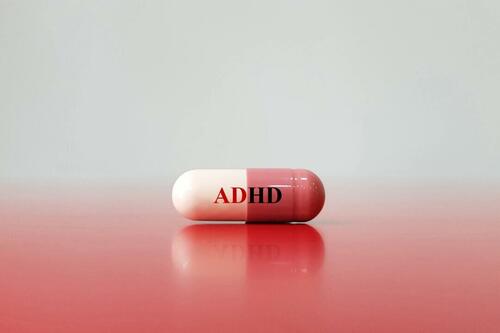 (joel bubble ben/Shutterstock) (joel bubble ben/Shutterstock)
Glaucoma is a progressive eye disease that causes vision loss. Angle-closure glaucoma is a subtype that contraindicates with popular ADHD drugs.
Dr. Rami Darwich, an ophthalmology resident and the study’s lead author, told The Epoch Times that the study “does not establish causation but rather highlights an elevated risk of glaucoma.”
Common ADHD Drugs
Many popular ADHD drugs are sympathomimetic drugs, meaning they activate the sympathetic nervous system to help people focus. However, their downstream effects can inadvertently contribute to elevated eye pressure.
High eye pressure is a significant risk factor for glaucoma, though Dr. Darwich added that some glaucoma has developed even without significant pressure changes in recent years.
Common ADHD drugs include sympathetic stimulants such as methylphenidate and amphetamines. These are often first-line treatments for people with ADHD due to their greater efficacy. Psychostimulants are effective for about 70 percent of ADHD patients.
Non-sympathomimetic drugs, such as atomoxetine, increase chemicals in the brain to help the brain work and concentrate. Atomoxetine is usually prescribed when the patient is unresponsive to first-line drugs.
The study authors followed 240,257 newly prescribed subjects who took either methylphenidate, amphetamines, atomoxetine, or a combination of these drugs for a year or more.
Study participants were then followed and compared to people who had not taken ADHD drugs to determine glaucoma risks.
People who took amphetamines and atomoxetine had a higher risk of angle-closure glaucoma (ACG), while people who took methylphenidate had a higher risk of open-angle glaucoma (OAG).
Our eyes are made up of fluids. Comparing a person’s eyes to a sink, Dr. Darwich explained that ACG occurs when “the drainage pipe of the sink gets blocked, causing the water (fluid inside your eye) to build up suddenly.”
With OAG, “the drainage pipe is open, but it’s like it’s clogged or narrow, so the water (fluid inside your eye) drains too slowly,” he said.
One might experience “severe eye pain, headache, and blurred vision” with ACG. “It can feel like there’s pressure building up in your eye.”
OAG is more chronic and doesn’t present with noticeable symptoms at first. Over time, blind spots can appear in the periphery, which can then progress to the center of one’s vision. However, much of the eye damage has already been done by that stage.
The authors also noted that atomoxetine and amphetamines were weakly linked to the development of OAG, though they said the correlation wasn’t statistically significant.
How ADHD Drugs Contribute to Glaucoma
The authors were surprised that methylphenidate was not strongly linked to ACG, which is contraindicated by psychostimulants that activate the nervous system.
In general, sympathomimetic drugs such as methylphenidate and amphetamines are not recommended for individuals with known or suspected ACG.
Since these medications activate the sympathetic nervous system—the system that prepares the body for fight or flight—the pupils dilate, which can mechanically obstruct the eye’s natural drainage pathway. This fluid buildup can increase eye pressure and damage the optic nerves, causing glaucoma and progressive vision loss.
OAG is more common than ACG, though it has a lower risk of vision loss, and its link to ADHD drugs is not well-established.
Methylphenidate, the drug shown to increase the risk of OAG, has also been found to be toxic to eye cells. The three medications studied have also been known to induce redox reactions, which may lead to oxidative damage, potentially impairing optical nerves and affecting eye health.
People whose bodies don’t properly metabolize ADHD drugs may also be at greater risk of drug-related glaucoma.
“Given the prevalence of ADHD medication use (medically and recreationally), further studies are needed to confirm our findings and investigate associations of ADHD medication use and glaucoma,” the authors wrote.
|
|
[Entertainment]
Washington Post paperback bestsellers
A snapshot of popular books.
Published:5/15/2024 7:16:33 AM
|
[Markets]
Mass Starvation: Here's Why Most Of America Is Completely Unprepared
Mass Starvation: Here's Why Most Of America Is Completely Unprepared
Authored by Brandon Smith via Alt-Market.us,
The concept of mass starvation has not been in the forefront of American society for a very long time. Even during the Great Depression the US was majority agrarian and most people knew how to live off the land. In fact, the US has never suffered a true national famine. There have been smaller regional instances of famine (such as during the Dust Bowl in the 1930s), but nothing coming remotely close to the kinds of famines we have seen in Asia, the Eastern Bloc, Africa or the Middle East in the past 100 years.

Even Western Europeans dealt with major famines during the World Wars (like the Dutch Famine) and that experience has left an imprint on their collective consciousness. Most Americans, on the other hand, don’t get it. Because we have lived in relative security and economic affluence for so long the idea of ever having to go without food seems “laughable” to many people. When the notion of economic collapse is brought up they jeer and call it “conspiracy theory.”
Compared to the Great Depression, the US population today is completely removed from agriculture and has no idea what living off the land means. These are not things that can be learned in a few months from books and YouTube videos; they require years of experience to master.
I will say that things have changed dramatically in the past two decades I have been writing for the liberty media. When I started back in 2006 the preparedness movement was incredibly small and often people were afraid to broach such topics in public forums.
In the past several years preparedness culture has EXPLODED in popularity. Millions of Americans are now dedicated survival experts with extensive preps and firearms training. Prepping and shooting is no longer the realm of tinfoil hat “crazies”, now it’s considered cool.
The credit crash of 2008-2009 certainly helped wake people up to the reality of economic instability in the US. Then the covid pandemic, the lockdowns and the attempts at medical tyranny really shocked Americans out of their stupor. Everything we “conspiracy theorists” have been warning about was suddenly confirmed in the span of a couple of years. Every time globalists and governments create a crisis they only inspire more preppers.
The greater problem in terms of famine is not that individual Americans are not aware of the threat; many of them are. The problem is that our infrastructure and logistical systems are designed to fail and there’s not much the average citizen can do about it.
The just-in-time freight system is perhaps one of the worst ever devised in terms of community redundancy. Any disruption no matter how minor could cut off supplies to a town or city for days or weeks. Then there’s the interdependency that comes with food being produced outside most states. If your state does not have a solid agricultural base then it will be reliant on outside food sources during a crisis. What guarantees are there that your region will be able to secure food from elsewhere?
Furthermore, most of the populace, even those that are preparing, have never experienced large scale starvation events before. It’s difficult to adapt mentally to a threat that one has never seen.
I suggest people who want to know what starvation feels like practice it from time to time. Try fasting for 24 hours, then try fasting for 48 hours. See how many days you can go without eating (just be sure to drink plenty of water). My maximum was seven days (after months of practice), and what I found was that after day three the hunger pangs actually stop altogether. You don’t go crazy, you don’t get violent; at most you might get tired, but you will also be surprised at how heightened your thinking becomes and how much energy you still have.
The human body can survive for three weeks or more without a single bite of food. My suspicion is that initial panic over potential hunger is the thing that causes the most violence during famines. People encounter starvation and lose their minds within the first three days. First-stage stomach pains and fogginess causes them to react without thinking and this leads to the widespread riots and other crisis events we are used to seeing in history during food shortages.
Fasting is a way to educate yourself on what it means to starve; it’s not as bad as it seems as long as you have some fat stores in your body. When you hit the point of muscle loss and organ deprivation, that’s when things change and the possibility of death arises. Having some familiarity with the feeling of true hunger will help you to avoid panic should the real thing ever occur in the future.
The greater problem is not what you can endure, though. Watching people you care about starve is much more difficult. This is not something you can practice for and it could be a far more powerful motivator when it comes to looting and crime during a crash.
The goal of course is to avoid famine altogether. Food storage is the foundation of any survival plan. Anyone who claims that jumping right into agriculture and hunting and wild edibles is the solution has never actually had to survive off the land in their lives. The reality is, finding enough food and growing enough food to live on is difficult for most people even in normal times.
During collapse, crops are often difficult to plant safely. They can be stolen or destroyed easily and require large communities of people to maintain and protect. Even smaller gardens can draw attention from undesirables and are hard to hide.
Hunting might be useful initially if you live in a rural area, but you won’t be the only person with the same idea and animals will move out of a region quickly if they are being hunted on a daily basis. You’ll have to go further and further out to find them and that’s risky during a crisis.
Wild edibles are nice in spring and summer when they are plentiful, but then again, if you’re hiking around expending more calories that you can get from these plants then the entire exercise is pointless. I tend to find that wild edibles proponents are the most delusional when it comes to the logistics of survival. Survivalists who think they’re going to run to the woods and live off of the random plants they find will probably die.
Growing food, hunting food and foraging food are all supplemental measures, especially in the first years of any crisis event. Without a primary emergency supply most people will not make it. Food storage has been a mainstay of civilization for thousands of years for a reason – It works. When larger secure communities are established then agriculture can return and self sustaining production makes food storage less important. Until then, what you have in your basement or your garage is the only thing that’s going to keep you alive.
Unfortunately, there are some people out there who think they don’t need to store supplies because they plan to take from other people. Firstly, anyone who makes this their Plan A is probably a psychopath and I have zero empathy for them. Secondly, such people won’t stay alive very long. With every violent encounter the risk of injury or death increases; looters and raiders will be whittled down rather quickly as they get picked off by people defending their resources.
It’s not like the movies, folks; marauders will disappear swiftly during a crash. After the first year I would be surprised if any of these individuals or groups still exist.
In the meantime, the initial stages of collapse are going to be a shock for many Americans. It could be a grid down event, an economic collapse, a supply chain collapse, etc., but the panic associated with hunger will be ever present. People who understand the nature of famine can avoid panic and organize for safety. They will survive and thrive. People who don’t understand famine will freak out in the first week without food and make detrimental mistakes.
Mental preparedness is just as important as physical preparedness. Keep that in mind as we move forward into uncertain times.
* * *
One survival food company, Prepper All-Naturals, has proactively dropped prices to allow Americans to stock up ahead of projected hikes in beef prices. Their 25-year shelf life steaks currently come at a 25% discount with promo code “invest25”.
|
[Markets]
The Latent Fascism Of Today’s Anti-Fascists
The Latent Fascism Of Today’s Anti-Fascists
Authored by Aaron Kheriaty via the Brownstone Institute,
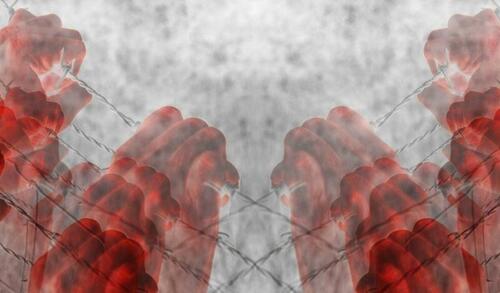
"Nothing can have as its destination anything other than its origin. The contrary idea, the idea of progress, is poison." -Simone Weil
The terms “fascist” and “fascism” are continuously bandied about today. But those who use these words most seem to understand them least, such that many of today’s self-styled anti-fascists paradoxically take on the central features of fascism to an extraordinary degree.
We can see contemporary fascist tendencies manifesting on both ends of the political spectrum — not only among white supremacists but also in the character types described by Eugene Rivers as “trust fund Becky with the good hair revolutionary communist” or “white boy Carl the anarchist from the Upper East Side who is a junior at Sarah Lawrence.”
Fascism is obviously worth opposing, but to be truly anti-fascist requires an understanding of how this ideology manifests in history and what the word actually designates. Already by the end of World War II, George Orwell noted that the term “fascist” was used so indiscriminately that it had become degraded to the level of a swearword synonymous with “bully.”
Contrary to popular belief, fascism does not represent counterrevolutionary or reactionary opposition to progressive ideas in the name of tradition. Many thinkers advanced this mistaken interpretation during the postwar period, including, among others, Umberto Eco’s list of “Ur-Fascist” features published in the New York Review of Books in 1995, Theodore Adorno’s concept of the “authoritarian personality” described in his influential 1950 book of that title, Wilhelm Reich (1946) and Eric Fromm’s (1973) psychoanalytic interpretations of repressive systems, and Antonio Gramsci’s (1929) widely accepted myth that fascism was a counterrevolutionary movement of the “petit bourgeois.”
The common mistake of all these interpretations involves generalizing the idea of fascism to include any movement that is either authoritarian or inclined to defend the past. This interpretation stems from an axiological faith (that is precisely the right word) in the value of modernity in the wake of the French Revolution.
Modernity is taken to be an inevitable and irreversible process of secularization and human progress, in which the question of transcendence — whether broadly Platonic or Christian — has entirely vanished, and in which novelty is synonymous with positivity. Progress rests upon the ongoing expansion of technology and individual autonomy. Everything, including knowledge, becomes a tool to pursue affluence, comfort, and well-being.
According to this faith in modernity, to be good is to embrace the progressive direction of history; to be evil is to resist it. Since fascism is clearly evil, it cannot be a development of modernity itself but must be “reactionary.” On this view fascism includes all those who fear worldly progress, have a psychological need for a strong social order to protect them, venerate and idealize a past historical moment, and so endow a leader with immense power to instantiate this.
“According to this interpretation,” Augusto Del Noce wrote, “Fascism is a sin against the progressive movement of history;” indeed, “every sin boils down to a sin against the direction of history.”
This characterization of fascism is almost entirely mistaken and misses its central features. Giovanni Gentile, the Italian “philosopher of fascism” and Benito Mussolini’s ghostwriter, penned an early book on the philosophy of Karl Marx. Gentile attempted to extract from Marxism the dialectic core of revolutionary socialism while rejecting Marxist materialism. As the authentic interpreter of Marxist thought, Lenin naturally rejected this heretical move, reaffirming the unbreakable unity between radical materialism and revolutionary action.
Like Gentile, Mussolini himself spoke of “what is alive and what is dead in Marx” in his speech on May 1, 1911. He affirmed Marx’s core revolutionary doctrine — the liberation of man through the replacement of religion by politics — even while he rejected Marxist utopianism, which was the aspect of Marxism that made it a kind of secular religion. In fascism, the revolutionary spirit separated from materialism becomes a mystique of action for its own sake.
Scholars of fascism have noted both a “mysterious proximity and distance between Mussolini and Lenin.” In the 1920s Mussolini was constantly glancing in the rearview mirror at Lenin as a rival revolutionary in a kind of mimetic dance. In his will to dominate, Mussolini spontaneously identified himself with the Fatherland and with his own people; however, there was no trace in this of any tradition that he affirmed and defended.
In its origins and aims fascism is thus not so much a reactionary-traditionalist phenomenon, but a secondary and degenerative development of Marxist revolutionary thought. It represents a stage in the modern process of political secularization that started with Lenin. This claim may occasion controversy, but a philosophical and historical examination of fascism reveals it to be accurate.
We easily miss these features if we focus exclusively on the obvious political opposition between fascism and communism during the Spanish Civil War and World War II. The fact that their philosophies share common genealogical roots and revolutionary ideals means neither that Lenin was a fascist (he was not) nor that fascism and communism are the same thing (they are not and fought to the death to prove it). Keep in mind, however, that an enemy of my enemy is not necessarily my friend.
Fascism understands itself to be a revolutionary and progressive manifestation of power. As in communism, fascism replaces traditional religious principles with a secular religion in which the future — rather than an idealized past or meta-historical ideals — becomes an idol. Politics replaces religion in the quest to liberate humankind. Contrary to popular characterizations, fascism makes no attempt to preserve a heritage of traditional values against the advance of progress (one only has to look at fascist architecture for confirmation of this). Instead, it proceeds as the unfolding in history of a wholly novel and unprecedented power.
Nazism was not so much an extreme form of fascism but the mirror image inversion of communism (the revolution in reverse). It added to fascism’s features its own origin myth, which necessarily had to reach back to pre-history. Its odious blood-and-soil socialist nationalism inverted Marxist universalism, but likewise resulted in the most extreme expression of colonialism. As with fascism and communism, Nazism was always ahistorical and entirely uninterested in preserving anything meaningful from the past.
Rather than looking back to history or to trans-historical values, fascism strains forward and advances by means of a “creative destruction” that feels entitled to overturn everything standing in its way. Action for its own sake takes on a particular aura and mystique. The fascist unflinchingly appropriates and commandeers various sources of energy — whether human, cultural, religious, or technical — to remake and transform reality. As this ideology presses its advance, it makes no attempt to conform to any higher truth or moral order. Reality is simply that which must be overcome.
Like the postwar interpreters of fascism mentioned above, many today mistakenly believe that fascism is grounded in strong metaphysical truth claims — that fascist authoritarian personalities somehow believe they possess a monopoly on the truth. On the contrary, as Mussolini himself explained with absolute clarity, fascism is entirely grounded in relativism:
If relativism signifies contempt for fixed categories and for those who claim to be the bearers of objective immortal truth, then there is nothing more relativistic than fascist attitudes and activity. From the fact that all ideologies are of equal value, we fascists conclude that we have the right to create our own ideology and to enforce it with all the energy of which we are capable.
The horrors of World War II were misdiagnosed by the postwar intellectuals’ mistaken interpretation of fascism and Nazism: these ideologies, and the bloodbath they unleashed, represented not the failure of the European tradition but the crisis of modernity — the outcome of the age of secularization.
What are the ethical consequences of fascism? Once value is attributed to pure action, other people cease to be ends in themselves and become mere instruments, or obstacles, to the fascist political program. The logic of the fascist’s “creative” activism leads him to deny other people’s personhood and individuality, to reduce persons to mere objects. Once individuals are instrumentalized, it no longer makes sense to speak of moral duties towards them. Others are either useful and deployed or they are useless and discarded.
This accounts for the extraordinary narcissism and solipsism characteristic of fascist leaders and functionaries: anyone who embraces this ideology acts as though he is the only person who really exists. The fascist lacks any sense of the purpose of law, or any reverence for a binding moral order. He embraces instead his own raw will to power: laws and other social institutions are mere tools deployed in the service of this power. Because the fascist’s action requires no ultimate end, and conforms to no transcendent ethical norm or spiritual authority, various tactics can be embraced or discarded at whim — propaganda, violence, coercion, desecration, erasure, etc.
Although fascists fancy themselves creative, their actions can only destroy. Taboos are torn down indiscriminately and at will. Symbols rich with meaning — moral, historical, religious, cultural — are ripped from their context and weaponized. The past is nothing but an ideological tool or cipher: one can rummage around in history for useful images or slogans to deploy in service of expansive power; but wherever it is not useful for this purpose, history is discarded, defaced, toppled, or simply ignored as though it never existed.
What are fascism’s stated ideals — what is it supposedly for? By design, this is never made entirely clear, except to say that novelty for its own sake assumes a positive value. If anything is held sacred it is violence. As in Marxism, the word “revolution” takes on an almost magical, mystical significance. But as I explained in Part II of this series, the ideology of total revolution only ends up strengthening the present order and the stronghold of the elites, by burning away those residual elements of tradition that make possible a moral critique of this order.
The result is nihilism. Fascism celebrates an optimistic (but empty) cult of victory through force. In a reactionary backlash, neo-fascist “anti-fascists” mirror this spirit by a pessimistic passion for the defeated. In both cases, the same spirit of negation prevails.
With this description in mind, we can understand why the word “fascism” logically boomerangs back on many of today’s self-styled anti-fascists. The practical upshot for our culture wars is not merely that the cure might be worse than the disease, but that the most radical “cure” in this case just is the disease. The danger is that a thinly veiled fascism — marching mendaciously under an anti-fascist banner — will overtake and absorb legitimate attempts to cure our ills, including ethically valid attempts to cure the cancer of racism or address other societal injustices.
The same faith in modernity that led to mistaken interpretations of fascism after World War II also forces contemporary history and politics into unhelpful categories. If we question this axiological faith in the idea of modernity, we can establish a clearer view of 20th-century ideologies and their current manifestations. This entails neither automatically identifying the modernist or progressive view as anti-fascist, nor equating all forms of traditionalism (at least potentially) with fascism.
In fact, the distinction between traditionalists (if I must use this unsatisfying term) and progressives is apparent in the different ways they oppose fascism. By tradition I don’t mean reverence for a static repository of fixed forms or a desire to return to an idealized period of the past; rather, I refer to the etymological meaning of that which we “hand on” (tradere) and thereby make new. A culture that has nothing of value to bequeath is a culture that has already perished. This understanding of tradition leads to a critique of modernity’s premise of inevitable progress — a groundless myth we should discard precisely to avoid repeating the horrors of the 20th century.
This critique of modernity, and the rejection of ethics as “the direction of history,” leads to other insights regarding our present crisis. Rather than the standard left-right, liberal-conservative, progressive-reactionary categories of interpretation, we can see instead that the real political divide today is between perfectists and anti-perfectists. The former believe in the possibility of complete liberation of humanity through politics, whereas the latter regard this as a perennial error grounded in a denial of inherent human limitations. The acceptance of such limitations is elegantly expressed in Solzhenitsyn’s insight that the line between good and evil passes first neither through classes, nor nations, nor political parties, but right through the center of every human heart.
We are all aware of the horrifying consequences that follow when fascism slides, as it readily does, into totalitarianism. But consider that the defining feature of all totalitarianisms is not concentration camps or secret police or constant surveillance — though these are all bad enough. The common feature, as Del Noce pointed out, is the denial of the universality of reason. With this denial, all truth claims are interpreted as historically or materially determined, and thus, as ideology. This leads to the assertion that there is no rationality as such — only bourgeois reason and proletariat reason, or Jewish reason and Aryan reason, or black reason and white reason, or progressive reason and reactionary reason, and so forth.
One’s rational arguments are then taken to be mere mystifications or justifications and are summarily dismissed: “You think such-and-such only because you are [fill in the blank with various markers of identity, class, nationality, race, political persuasion, etc.].” This marks the death of dialogue and reasoned debate. It also accounts for the literally “loopy” closed-loop epistemology of contemporary social justice advocates of the critical theory school: anyone who denies being a [fill-in-the-blank epithet] only further confirms that the label applies, so one’s only option is to accept the label. Heads-I-win; tails-you-lose.
In such a society there can be no shared deliberation rooted in our participation in a higher Logos (word, reason, plan, order) that transcends each individual. As happened historically with all forms of fascism, culture — the realm of ideas and shared ideals — is absorbed into politics, and politics becomes total war. From within this framework, one can no longer admit any conception of legitimate authority, in the enriching etymological sense of “to make grow,” where we also derive the word “author.” All authority is instead conflated with power, and power is nothing but brute force.
Since persuasion through shared reasoning and deliberation is pointless, lying becomes the norm. Language is not capable of revealing truth, which compels assent without negating our freedom. Instead, words are mere symbols to be manipulated. A fascist does not attempt to persuade his interlocutor, he merely overpowers him — using words when these serve to silence the enemy or deploying other means when words will not do the trick.
This is always how things begin, and as the internal logic unfolds, the rest of the totalitarian apparatus inevitably follows. Once we grasp fascism’s deep roots and central features, one essential consequence becomes clear. Anti-fascist efforts can succeed only by starting from the premise of a universal shared rationality. Authentic anti-fascism will therefore always seek to employ nonviolent means of persuasion, appealing to evidence and to the conscience of one’s interlocutor. The problem is not just that other methods of opposing fascism will be pragmatically ineffective, but that they will unwittingly but inevitably come to resemble the enemy they claim to oppose.
We can look to Simone Weil as an authentic and exemplary anti-fascist figure. Weil always wanted to be on the side of the oppressed. She lived this conviction with exceptional single-mindedness and purity. As she relentlessly pursued the idea of justice inscribed in the human heart, she passed through a revolutionary phase, followed by a gnostic phase, before she finally rediscovered the Platonic tradition — the perennial philosophy of our shared participation in the Logos — with its universal criterion of truth and the primacy of the good. She arrived here precisely through her anti-fascist commitments, which entailed a rebellion against every delusional deification of man. Weil emerged from the modern world and its contradictions the way a prisoner emerges from Plato’s cave.
After volunteering to fight with the Republicans in the Spanish Civil War, Weil broke with the illusory anti-fascism of Marxist revolutionary thought. Recognizing that, in the end, “evil produces only evil and good produces only good,” and “the future is made of the same stuff as the present,” she discovered a more enduring anti-fascist position. This led her to call the destruction of the past “perhaps the greatest of all crimes.”
In her last book, written a few months before she died in 1943, Weil elaborated on the limits of both fascist vitalism and Marxist materialism: “Either we must perceive at work in the universe, alongside force, a principle of a different kind, or else we must recognize force as being the unique and sovereign ruler over human relations also.”
Weil was thoroughly secular prior to her philosophical conversion and her subsequent mystical experiences: her rediscovery of classical philosophy occurred not through any sort of traditionalism, but by living the ethical question of justice with full intellectual honesty and total personal commitment. In pursuing this question to the end, she came to see that human self-redemption — fascism’s ideal — is actually an idol. Those who want to be truly anti-fascist would do well to explore Weil’s writings. I will give her the last word, which contains the seeds of the way out of our crisis. In one of her last essays, she offers us not a counsel of facile optimism, but a beautiful thought about our unconquerable receptivity to grace:
At the bottom of the heart of every human being, from earliest infancy until the tomb, there is something that goes on indomitably expecting, in the teeth of all experience of crimes committed, suffered, and witnessed, that good and not evil will be done to him. It is this above all that is sacred in every human being.
Republished from The Simone Weil Center
Aaron Kheriaty, Senior Brownstone Institute Counselor, is a Scholar at the Ethics and Public Policy Center, DC. He is a former Professor of Psychiatry at the University of California at Irvine School of Medicine, where he was the director of Medical Ethics.
|
[Markets]
The Proof Of Censorship Is…Censored
The Proof Of Censorship Is…Censored
Authored by Jeffrey A. Tucker via the Brownstone Institute,

It’s not been a good week for the Censorship Industrial Complex.
The machine has been built and put into action over nearly a decade but largely in secret. Its way of doing business has been via surreptitious contacts with media and tech companies, intelligence carve-outs in “fact-checking” organizations, payoffs, and various other clever strategies, all directed toward boosting some sources of information and suppressing others. The goal has always been to advance regime narratives and curate the public mind.
And yet, based on its operations and insofar as we can tell, it had every intention of remaining secret. This is for a reason. A systematic effort by government to bully private sector companies into a particular narrative while suppressing dissent contradicts American law and tradition. It also violates human rights as understood since the Enlightenment. It was a consensus, until very recently, that free speech was essential to the functioning of the good society.
Four years ago, many of us suspected censorship was going on, that the throttling and banning was not merely a mistake or the result of zealous employees stepping out of line. Three years ago, the proof started to arrive. Two years ago, it became a flood. With the Twitter files from a year ago, we had all the proof we needed that the censorship was systematic, directed, and highly effective. But even then, we only knew a fraction of it.
Thanks to discovery from court cases, FOIA requests, whistleblowers, Congressional inquiries thanks to the very narrow Republican control, and some industrial upheavals such as what happened at Twitter, we are overwhelmed with tens of thousands of pages all pointing to the same reality.
The censors developed a belief at the highest levels of control in government that it was their job to govern what information the American people would and would not see, regardless of the truth. The actions became truly tribal: our side favors banning gatherings, closing schools, says the Hunter Biden laptop is a fake, favors masking, mass vaccination, and mail-in voting, and denies the import of voter fraud and vaccine injury, whereas their side takes the opposite approach.
It was a war over information, undertaken in total disregard for the First Amendment, as if it doesn’t even exist. Moreover, the operation was not only political. It clearly involved intelligence agencies that were already hip deep in the “all-of-society” pandemic response.
“All of Society” means all, including the information you receive and are allowed to distribute.
A vast swath of unelected bureaucrats took it upon themselves to manage all knowledge flows in the age of the Internet, with the ambition to turn the main source of news and sharing into a giant American version of Pravda. All of this occurred right under our noses – and is still going on today.
Indeed, censorship is a full-on industry now, with hundreds and thousands of cut-outs, universities, media companies, government agencies, and even young people in school studying to be disinformation specialists, and bragging about it on social media. We are just one step away from a New York Times article – as follow-ups to their recent praise of the Deep State and also government surveillance – with a headline like “The Good Society Needs Censors.”
Incredibly, the censorship is so pervasive now that it is not even reported. All these revelations should have been front page news. But so captured is the news media today that there are very few outlets that even bother to report the fullness of the problem.
Not receiving nearly enough attention is the new report from the Committee on the Judiciary and the Select Subcommittee on the Weaponization of the Federal Government of the US House of Representatives.
Running nearly 1,000 pages including documentation (however many pages are purposely blank), we have here an overwhelming amount of evidence of a systematic, aggressive, and deeply entrenched effort on the part of the federal government, including the Biden White House and many agencies including the World Health Organization, to tear out the guts of the Internet and social media culture and replace them with propaganda.
Among the well-documented facts are that the White House directly intervened in Amazon’s own marketing methods to deprecate books that raised doubts about the Covid vaccine and all vaccines. Amazon responded reluctantly but did what it could to satisfy the censors. All these companies – Google, YouTube, Facebook, Amazon – became acquiescent to Biden administration priorities, even to the point of running algorithmic changes by the White House before implementation.
When YouTube announced that it would take down any content that contradicted the World Health Organization, it was because the White House instructed them to do so.

As for Amazon, which is like every publisher in wanting full freedom to distribute, they faced intense pressure from government.
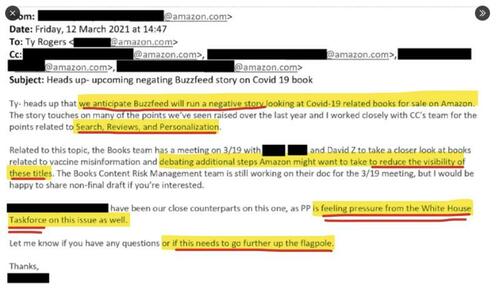
These are just a few of thousands of pieces of evidence of routine interference from government against social media companies, either directly or through various government-funded cut-outs, all designed to enforce a certain way of thinking on the American public.
What’s amazing is that this industry was allowed to metastasize to such an extent over 4-8 years or so, with no legal oversight and very little knowledge on the part of the public. It’s as if there is no such thing as the First Amendment. It’s a dead letter. Even now, the Supreme Court seems confused, based on our reading of the oral arguments over this whole case (Murthy v. Missouri).
One gets the sense when reading through all this correspondence that the companies were more than a bit rattled by the pressure. They must have wondered a few things: 1) is this normal? 2) do we really have to go along? 3) what happens to us if we just say no?
Probably every corner grocery store in any neighborhood run by a crime syndicate in history has asked these questions. The best answer is to do what you can in order to make them go away. This is precisely what they did time after time. After a while, the protocol probably begins to feel normal and no one asks anymore the basic questions: is this right? Is this freedom? Is this legal? Is this just the way things go in the US?
No matter how many high officials were involved, how many in the C-suites of big companies participated, however many editors and technicians of the best credentials played along, there can be no question that what took place was an absolute violation of speech rights that very likely exceeds anything we’ve seen in US history.
Keep in mind that we only know what we know, and that is severely truncated by the force of the machinery. We can safely assume that the truth actually is far worse than we know. And further consider that this censorship is keeping us from knowing the full story about the suppression of dissidents, whether medical, scientific, political, or otherwise.
There might be millions in many professions who are suffering right now, in silence. Or think of the vaccine-injured or those who have lost loved ones who were forced to get the shot. There are no headlines. There are no investigations. There is almost no public attention at all. Most of the venues that we once thought would police such outrages have been compromised.
To top it off, the censors are still not backing down. If you sense a lessening of the grip for now, there is every reason to believe it is temporary. This industry wants the entire Internet as we once conceived of it completely shut down. That’s the goal.
At this point, the best means of defeating this plan is widespread public outrage. That is made more difficult because the censorship itself is being censored.
This is why this report from the US House of Representatives needs to be widely shared so long as doing so is possible. It could be that such reports in the future will themselves be censored. It could also be the last such report you will ever see before the curtain falls on freedom completely.
Jeffrey Tucker is Founder, Author, and President at Brownstone Institute. He is also Senior Economics Columnist for Epoch Times, author of 10 books, including Life After Lockdown, and many thousands of articles in the scholarly and popular press. He speaks widely on topics of economics, technology, social philosophy, and culture.
|
[Markets]
The Land Of The Setting Sun: The Currency Crisis Of Japan Has Just Started
The Land Of The Setting Sun: The Currency Crisis Of Japan Has Just Started
By Tuomas Malinen of The MT Malinen substack
On Tuesday, we shortly commented the flash crash and the (assisted) recovery of the Japanese Yen between Friday and Monday, 26-29 April, on the GnS Economic’s Deprcon Outlook. In this entry, I will detail the reasons behind the crash, which go way back in history starting from the post-WWII growth model of the Japanese economy, leading to the the financial crash of early 1990s. They imply that the currency crisis of Japan is far from over.
Boom and bust
The Japanese economy was devastated in the Second World War, which created a need for a major reconstruction effort. Japanese also switched their model of governance to democracy, which laid the foundation for a stable society supportive of investments. The economic boom after WWII was fueled by financial regulation that kept the nominal interest rate below inflation and successful economic reforms that supported, e.g., neutral recruiting of labor and education. The mandarins at the Ministry of Finance issued ceiling on interest rates of both lending and deposit rates, which led to a notable investment boom. Export sector grew fast with the composition of the exports changing from toys and textiles to bicycles and motorcycles and further to steel, automobiles and electronics over the decades.
Japanese government began to deregulate the financial sector in the early 1980's, following a global trend. Also, in the mid-1980's, the Bank of Japan (BoJ) tried to aggressively limit the appreciation of yen (because it decreased country's trade surplus), by cutting interest rates. These led to a rapid growth in the supplies of money and credit. A financial boom ensued.
The credit expansion led to notable gains in the real estate and stock markets, where bubbles grew to massive sizes. By the late 1980's, the price index for residential real estate in the six largest Japanese cities had 58-folded from 1955. During the 1980's alone, the price of real estate increased by a factor of six. At the peak, the value of Japanese real estate was double of that in the US. According to the chatter at the time, the market value of land under the Imperial Palace in Tokyo was greater than the market value of all real estate in California. The Nikkei stock market index rose 40000 percent from early 1949 till late 1989, with massive increase during the 1980's. In the late 1980's, the market value of Japanese equities was twice the market value of US equities.
The real estate and stock market booms were highly connected. A substantial portion of firms listed in the Tokyo Stock Exchange were real estate companies, which held considerable positions in property of major cities. Construction activity surged due to the combination of booming real estate prices and financial deregulation. Banks held large volumes of real estate and stocks, whose increasing value led to appreciation of banking stocks. Borrowers were usually required to pledge real estate as collateral, which meant that increase in the value of the real estate increased the value of the collateral enabling banks to increase their loan portfolio and grow in size. Also industrial firms bought real estate as the profit it produced was many times higher than that of, e.g., producing steel and automobiles. There was a 'perpetual motion machine' of ever-increasing prices and financial wealth, until suddenly there was not.
In the mid-1989, the BoJ started to rise interest rates, with the obvious effort to prick the asset bubbles. It succeeded. The stock market peaked at the last trading day in 1989, and fell over 38 percent in 1990. It bottomed out in Spring 2003 after falling close to 80 percent from the peak (Nikkei actually broke its previous record, set on December 29, 1989, on February 22 this year). The fall in real estate prices was slower, but extensive. For example, commercial real estate fell close to one-tenth of its peak value. Because the collateral of the banking sector was tightly connected to real estate, its value collapsed. Many industrial firms suffered crippling losses from their investments in the real estate.
The collapse of stock markets and real estate wiped out a large chunk of capital of banks, which in collaboration with the declining value of bank collateral, hurdled the banking sector into insolvency. Credit creation collapsed and the economy tumbled. A financial crisis set in.
The bailout
After the crash of the real estate sector, majority of the large Japanese banks remained bankrupt for most of the 1990's. It was a tradition in Japan to socialize the losses of the banking sector, and regulatory authorities were reluctant to close banks considered bankrupt.
While the BoJ was somewhat slow to respond to the crisis, it started to lower its target interest rate in 1991, which eventually reached zero in early 1999. When the crisis intensified, the BoJ started to act as lender of last resort, the main task of a central bank in a crisis, but it also bailed out several financial institutions. This was mostly done by providing funds to different bodies, including the Housing Loan Administration assuming bad loans from the off-balance sheet, or jusen, companies banks had created to provide mortgages and the New Financial Stablization Fund, which provided capital both to banks and private financial institutions. This was very exceptional as central banks do usually provide only liquidity, not capital, to banks not to mention to private financial companies.
Facing a public anger over bank bailouts in the early stages of the crisis, the government allowed, and in some cases even encouraged, banks to extend loans to ailing businesses. Government, e.g., allowed for accounting gimmicks which, with the lacking transparency, enabled banks to downplay their loan losses and overstate their capital.
These measures saved the financial sector, but at a heavy cost. Because the banking sector was not restructured, bank lending collapsed and was diverted towards ailing unprofitable companies. The reason for this was simple: banks tried to avoid further losses from bankruptcies.
After the implosion of the asset bubbles, the domestic non-traded goods sector held the largest share of unprofitable companies. While bank lending to exporting (trading goods) sector diminished in the 1990’s, bank lending to the non-traded good sector actually increased. Thus, Japanese banks kept extending lines of credit to unprofitable firms to avoid losses that would have occurred if the firms would have gone bust. This zombified the Japanese economy.
So, while government policies were effective in restoring some trust to financial sector, they let the "zombie" banks to linger. They were kept standing without recapitalization or clearing their books. Subsidies from the government and ‘zombie-lending’ from banks kept unprofitable firms operating, but also blocked creation of new firms, because when banks use their diminished lending capacity to support ailing companies, the funding for risky new enterprises dries up. The old unprofitable firms also tie private capital, which could otherwise be used to support the creation of new businesses. This leads to a vicious loop of depressed innovation, falling production and diminishing profits. As a result, the Japanese economy stagnated. Moreover, these policies led to misallocation of credit on a massive scale, fall in the investment rate, and a prolonged slump in productivity.
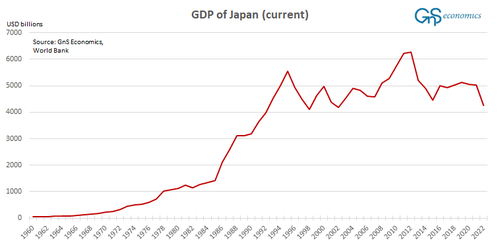 (Note that you should not use inflation corrected, or “real”, gross domestic product nor GDP per capita to measure the economic development of a county with decades-long deflation and declining population.) (Note that you should not use inflation corrected, or “real”, gross domestic product nor GDP per capita to measure the economic development of a county with decades-long deflation and declining population.)
The drag
When the private sector becomes infested with so called zombie companies, which are able to stand only with the help of easy credit, it becomes a serious drag to the economy. This is clearly visible in the growth of the Total Factor Productivity of Japan.
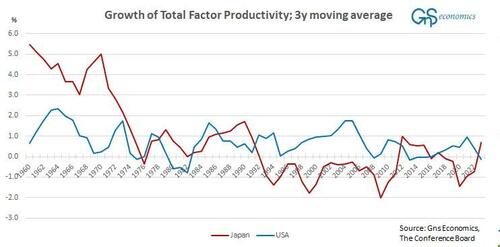
The figure above presents the three-year moving average of the growth of the TFP. We can see a rather clear collapse in the growth rate of the TFP of Japan from around 1992 lasting till 2012. In 2018, the TFP growth fell negative again, and spiked in 2023. The U.S. series provides a reference point.
You can think of the TFP as a your productivity at work. If your productivity increases, you (usually) earn more income, which makes you able increase your livings standards and, e.g. to pay back your loans. However, if your productivity stagnates, or even starts to fall, you earn less income, which starts to eat into your living standards, unless you support it (artificially) through borrowing. Moreover, if a considerable share of this borrowing does not go into productive investments, which would increase your productivity and thus income stream in the future, you just go deeper into debt with your ability pay it back hindered. This is exactly what happened to Japan. Because her productivity fell for a very long time, the only way to keep the living standards and the economy afloat was through massive government borrowing and monetary stimulus (low interest rates). Due to this, the ability of the Japanese government to pay back its debt has diminished as the economy has now grown, while the debt pile has grown to a monstrous size.
The problem Japan currently faces can thus be depicted as follows:
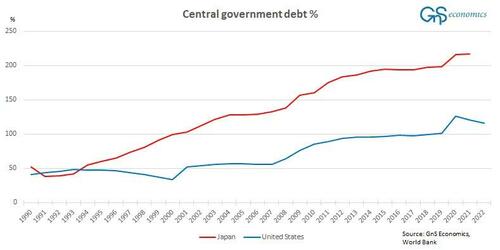
After the crisis of early 1990's, the leaders of Japan decided not to let the economy to crash, because of e.g. cultural issues. In Japan, bankruptcies are considered highly shameful often leading to suicides. While the bailout of the Japanese economy was understandable culturally, the fact is that the restructuring of the Japanese economy after the financial crisis was an utter failure. Another country which experienced a financial crash at the same time, but recovered quite remarkably, is Finland.
Currency crisis
Currency and debt crises tend to be deeply intertwined. This is because the foreign exchange value of a currency reflects the trust of international investors and businesses on the keeper of the currency, i.e. the government of a country.
Essentially, a currency crisis or a crash is an “attack” on the exchange value of the currency in the markets. If the foreign exchange (FX) rate is fixed or pegged, this attack will test central banks (the monetary authority) commitment to the peg. The current view is that the timing of the attacks is not predictable (forecastable). If the FX-rate is fixed or pegged, market participants expect the policy of monetary authorities will be inconsistent with the peg and they will try to force authorities to abandon the peg, thus validating their expectations.
What matters for speculators are the internal economic conditions with respect to external conditions set for the currency (like stable FX-rate) . If these are incompatible in some meaningful way, like when the government has an unsustainable debt burden, monetary authorities face a trade-off between external and domestic goals for the exchange rate. In these circumstances, random shocks in the foreign exchange markets, called sunspots, can trigger an attack on the external value of the currency. This means that, when internal economic conditions are deteriorating, due to e.g. an unsustainable sovereign debt load, random events or shocks, can break the trust of investors leading them to sell the currency in the exchange markets causing the (external) value of the currency to drop suddenly or even to crash.
If a country holds a large external debt pile, a crashing currency will naturally increase its (foreign-currency) value threatening to create a wave of defaults. This applies to private entities, as well as to local and central governments. A currency crash is often expected to lead to interest rate rises by the monetary authority to defend the FX-rate of the currency. However, if the government holds a large amount of debt, higher interest rates can easily succumb the government under interest payments, which will eventually lead to a sovereign default. Rising interest rates would thus lead to further deterioration of trust by investors in the currency of a highly indebted government. This is why the Bank of Japan is trapped. If it would start to raise rates, the debt service burden of the Japanese government would rapidly become unsurmountable.
Conclusions
The bailout of the Japanese economy in early 1990s, which caused the slump in productivity leading to the very high indebtedness of the Japanese government, is the main culprit behind the ‘flash crash’ of the Japanese Yen. On April 26, it seems, a ‘sunspot’ triggered the selling. The response of the monetary authority, i.e., the BoJ, was to start to defend the yen at USDJPY pair of 160. Its intervention (buying of yen) pushed the pair to under 153 on May 3, where it has started to creep back up.
As the underlying problems of the Japanese economy have not gone anywhere, the attack on the yen in the markets is likely to continue and escalate, again, at some point. The question is, what is the breaking point in the USDJPY pair after which investors start to flee? Moreover, we should remember that monetary authorities have their limits, while markets don’t. Thus, it is very likely that the currency crisis of Japan has but just started. See my other post for analysis on its implications.
|
[Markets]
Is China's Oil Demand Set For A Major Bounce Back?
Is China's Oil Demand Set For A Major Bounce Back?
By Simon Watkins of OilPrice.com
Since the mid-1990s, China’s extraordinary economic expansion almost singlehandedly drove a supercycle in key commodities prices it required to power such growth, including oil and gas. In 2013, it became the world’s largest net importer of total petroleum and other liquid fuels and, as late as 2017, its still high rate of economic growth allowed it to overtake the U.S. as the largest annual gross crude oil importer in the world. Late 2019 saw much of this activity grind to a halt as Covid hit the country, and the economic slowdown was exacerbated by its Draconian ‘zero-Covid’ policy that saw complete shutdowns of major economic centres at the slightest hint of infection. However, 2023 saw it achieve its official gross domestic product (GDP) growth target of “around 5 percent” – posting 5.2 percent in the end. The same official target is in place this year, with the key questions for oil markets being whether this will be achieved and if so, how easily?

16 April saw China’s National Bureau of Statistics release the country’s Q1 GDP figure, which showed a 5.3 percent year-on-year increase. This was way above consensus analyst expectations of 4.6 percent and was also a rise from the Q4 2023’s 5.2 percent. “Aside from the continued decline in the property sector, policy support is filtering through investment,” Eugenia Victorino, head of Asia strategy for SEB in Singapore exclusively told OilPrice.com. “With property sales now 60 percent lower than their mid-2021 peak, transaction volumes are now comparable to levels last seen in 2012,” she added. “Investments in other sectors are also picking up, particularly in manufacturing and energy production and supply, and in the coming months, infrastructure investment will also start to accelerate on the back of fiscal stimulus,” she said. “The strong performance in the first two months of the year suggests that an economic recovery is underway,” she underlined. March’s key Caixin/S&P Global China manufacturing purchasing managers’ index (PMI) also came in very bullish. At 51.1 in the month, up from 50.9 in February (above 50.0 indicates expansion), it was the strongest since February 2023. “Overall, China’s manufacturing sector continued to improve in March, with expansion in supply and demand accelerating, and overseas demand picking up,” said Caixin Insight Group senior economist, Wang Zhe. April’s Caixin China General Manufacturing PMI also increased - to 51.4, beating estimates of 51 – and recording the sixth straight month of growth in factory activity. New orders rose the most in over a year and foreign sales increased at the fastest pace for nearly three-and-a-half years.
This robust performance across several major sectors in China’s economy – including, crucially manufacturing – is in sharp contrast to the growth drivers seen last year. In the immediate aftermath of Covid, the country’s growth became reliant on just reopening the economy and removing negative policies - property, consumer, and geopolitics - rather than on aggressive stimulus, to drive activity, Rory Green, chief China economist for GlobalData.TSLombard exclusively told OilPrice.com at the time. “For the first time, a cyclical recovery in China [was] being led by household consumption, mainly services, as there [was] a great deal of pent-up demand and savings - about four percent of GDP - following three years of intermittent mobility restrictions,” he said. In terms of the effect that this had on oil prices at the time, it is apposite to note that transportation accounts for just 54 percent of China’s oil consumption, compared to 72 percent in the U.S. and 68 percent in the European Union. In 2022 and early 2023, net oil and refined petroleum imports were eight percent lower by volume than the pre-Covid peak, with infrastructure and export-oriented manufacturing partly offsetting lower mobility and less property construction. At that phase of China’s economic rebound, then, oil demand did increase, but the scale of this was far from sufficient to drive oil prices significantly higher on its own. This was even more the case, as China continued where possible to buy oil from Russia at a substantial discount.
Before this ‘Covid Phase’, China had already undergone several transitions in its core economic growth model, the effects of which continue to be felt to this day. From 1992 to 1998, its annual economic growth rate was basically between 10 to 15 percent; from 1998 to 2004 between 8 to 10 percent; from 2004 to 2010 between 10 to 15 percent again; from 2010 to 2016 between 6 to 10 percent, and from 2016 to the 2019 between 5 to 7 percent. For much of the period from 1992 to the middle 2010s, much of China’s massive economic growth was founded on a huge energy-intensive expansion of its manufacturing capabilities. This also involved the mass migration of new workers from the countryside and into the cities, which required a huge energy-intensive infrastructure build-out. Even after some of China’s growth began to switch into the less energy-intensive service sectors, its investment in energy-intensive infrastructure build-out remained very high. This pattern continued for many years, alongside the third phase of China’s economic growth, which was the rise of a middle class that powered domestic consumption-led demand for goods and services. All these phases had the net result of markedly increasing China’s demand for oil and gas.
Although this ‘Post-Covid Phase’ of growth currently looks like one that will see powerful drivers from several sectors of China’s economy – including manufacturing - it does not necessarily mean that oil prices will feel the full effects of this. The key reason here is that China continues to buy oil at greatly reduced prices not just from Russia, but also from Iran and Iraq too, through various mechanisms analysed in full in my new book on the new global oil market order. Despite sanctions in place on the first two of these countries, the U.S. is happy to look the other way for the most part, as oil demand being satisfied ‘off the official books’ ultimately feeds through into lower demand elsewhere in the global energy markets, so reducing bullish price pressure. Additionally, China does not want to encourage higher oil prices from any of those multitude of Middle Eastern countries over which it has developed an influence because the U.S. and several of its key allies remain China’s major export customers. The U.S. alone still accounts for over 16 percent of its export revenues. Rising energy prices in these countries could again fuel inflation and cause interest rates to rise, bringing the prospect of economic slowdown with them, as was seen in the aftermath of Russia’s invasion of Ukraine in 2022. According to a senior source in the European Union’s (E.U.) energy security complex spoken to exclusively by OilPrice.com recently, the economic damage to China – directly through its own energy imports and indirectly through damage to the economies of its key export markets in the West – would dangerously increase if the Brent oil price remained over US$90-95 pb for more than one quarter of a year.
Rising energy prices also have direct ramifications in U.S. presidential elections, in which China does not want to be seen playing a part, at least overtly. Longstanding estimates are that every US$10 pb change in the price of crude oil results in a 25-30 cent change in the price of a gallon of gasoline, and for every 1 cent that the average price per gallon of gasoline rises, more than US$1 billion per year in consumer spending is lost, adversely affecting the U.S. economy. Historically, around 70 percent of the price of gasoline is derived from the global oil price. This feeds through into the second part of this equation, as also analysed in full in my new book, which is that since the end of World War I in 2018, the sitting U.S. president has won re-election 11 times out of 11 if the economy was not in recession within two years of an upcoming election. If it was in recession in this timeframe, then only 1 sitting president has won out of 7 times (although even the 1 is debatable).
|
|
[AANHPI Heritage Month]
10 Must-Read Fantasy Novels for AANHPI Heritage Month
We’ve rounded up the best fantasy novels by AANHPI authors—must-read books filled with action, glamour, folklore and practical magic.
Published:5/8/2024 11:12:49 AM
|
|
[Entertainment]
Washington Post hardcover bestsellers
A snapshot of popular books.
Published:5/8/2024 8:24:09 AM
|
|
[New York State Criminal Case Against Trump (71543-]
Prosecutors Mine ‘How To Get Rich’ and Other Trump Books For Quotes
Donald J. Trump’s books provided prosecutors with passages they believe can help their case, as they argue that he knew that his company falsified business records to cover up a hush-money payment to Stormy Daniels.
Published:5/7/2024 12:24:24 PM
|
[Markets]
Systematic Review Reveals Many COVID-19 Vaccine Recipients Experienced New-Onset Psychosis
Systematic Review Reveals Many COVID-19 Vaccine Recipients Experienced New-Onset Psychosis
Authored by Naveen Athrappully via The Epoch Times (emphasis ours),
Individuals who took COVID-19 vaccines were found to have later suffered from psychosis, with Pfizer and AstraZeneca shots linked to most of the cases.
 A 1-year-old child receives a Pfizer COVID-19 vaccination in Seattle, Wash., on June 21, 2022. (David Ryder/Getty Images) A 1-year-old child receives a Pfizer COVID-19 vaccination in Seattle, Wash., on June 21, 2022. (David Ryder/Getty Images)
The peer-reviewed systemic review, published in the Frontiers in Psychiatry journal on April 12, examined cases of new-onset psychosis among people who took the vaccines. Psychosis refers to symptoms that occur when an individual has difficulty differentiating between reality and fantasy, with hallucinations and delusions being two key types. The review looked at 21 articles describing 24 cases of psychosis symptoms following vaccination. The researchers concluded that “data suggest a potential link between young age, mRNA, and viral vector vaccines with new-onset psychosis within 7 days post-vaccination.”
“Collecting data on vaccine-related psychiatric effects is crucial for prevention, and an algorithm for monitoring and treating mental health reactions post-vaccination is necessary for comprehensive management.”
Out of the 24 cases, 13 were female. The median age of participants was 36 years. Twenty-two patients (91.2 percent) had no specific history of somatic illness and comorbidities.
In 33.3 percent of the cases, administration of the Pfizer mRNA vaccine “potentially induced adverse psychiatric events,” the study said. The viral vector AstraZeneca vaccine was linked to psychotic symptoms in 25 percent of cases.
In 45.8 percent of incidences, psychotic symptoms were reported after the first shot and in fifty percent after the second dose.
“Almost all reviewed cases (95.8 percent) presented with psychotic symptoms, such as hallucinations (visual, auditory, olfactory, and tactile) and delusions (mostly persecutory and delusions of reference).”
The most common form of hallucination was auditory, experienced in 54.2 percent of the cases, while visual hallucinations were experienced by 12.5 percent of patients.
“Motor disturbances, such as increased or decreased motor activity and bizarre behavior, were mentioned in 83.3 percent of cases. In 3 (12.5 percent) cases, a suicidal attempt was described.”
The psychotic symptoms mostly lasted for a period of one and two months.
The patients were treated using various methods including antipsychotics and steroids, but only 12 out of the 24 made a full recovery. The remaining suffered from “residual symptoms such as decreased emotional expressions, low affect, or residual psychotic symptoms.”
In one case, the patient reported a positive COVID-19 test result. “Previous studies have shown that individuals with documented comorbidities and a history of COVID-19 infection exhibit a statistically significant increase in adverse events following vaccination,” the study noted.
Researchers speculated that inflammatory conditions following vaccination may be a reason behind the psychosis. The study found elevated C-reactive protein levels and mild to moderate leukocytosis—high white blood cell count—as the most common blood abnormalities. Both conditions have links with inflammation.
Another hypothesis suggested in the study was that post-vaccination psychosis could suggest a manifestation of autoimmune anti-NMDA encephalitis, a condition in which the immune system targets the brain neurons by mistake and causes inflammation.
Researchers noted that instances of anti-NMDA encephalitis have been repeatedly reported after vaccinations against infections like influenza, pertussis, yellow fever, and typhus.
“Considering the potential link between post-vaccination psychosis and autoimmune anti-NMDA encephalitis, it is advisable to consider immunological screening in individuals presenting psychiatric symptoms post-COVID-19 vaccination.”
A third possible reason suggested in the study is that the various speculations and uncertainties regarding the safety of COVID-19 vaccines could lead to people experiencing “significant stress,” which could end up triggering the development of psychiatric reactions.
The authors received financial support for the review, with the article-processing charge funded by Riga Stradins University, Latvia. Researchers declared no conflicts of interest in the study.
Post-Vax Psychosis Cases
Episodes of psychosis after taking COVID-19 shots have been detailed in several case studies. In one instance, a 15-year-old boy from Taiwan was sent to hospital two days after taking the second Pfizer shot. He was screaming and exhibiting agitation and uncontrollable limb stretching.
Other bizarre behaviors included sitting up and lying down frequently. The child was prescribed antipsychotics yet his behaviors continued to persist after being discharged for more than a month.
The doctors then put the boy under a steroid regimen, which is anti-inflammatory and helps calm down an overactive immune system. His symptoms then improved.
In another case from Brazil, a woman in her 30s, who was previously healthy, developed refractory psychosis within 24 hours of taking an mRNA COVID-19 shot. The woman had disorganized thoughts, was aggressive, and believed she was being persecuted at the hospital.
Even though she was treated with mood stabilizers and antipsychotics, her behavior showed improvements only after four months of hospitalization. However, her psychosis continued.
A May 2022 review described the case of an 18-year-old woman who developed psychotic symptoms on the same day she took the first dose of AstraZeneca vaccine.
“Symptoms started few hours after the vaccination with irrelevant talk. Over the next three days, it progressed to irritability, delusions of persecution and reference, and visual hallucinations.”
Another case study detailed the situation of a 45-year-old woman with no family history or personal history of mental disorders who ended up developing psychosis a month after she received a COVID vaccine. She quit her 18-year-old job abruptly and displayed erratic behaviors.
|
|
[Entertainment]
‘Night Watch,’ ‘King: A Life,’ among 2024 Pulitzer Prize winners
Here are the books that were named winners and finalists in the categories of fiction, history, biography, memoir, poetry and general nonfiction.
Published:5/6/2024 4:59:35 PM
|
[Markets]
"Stunning On Multiple Levels": DOJ Admits To Evidence Tampering In Trump Classified Docs Case
"Stunning On Multiple Levels": DOJ Admits To Evidence Tampering In Trump Classified Docs Case
Special Counsel Jack Smith's team admitted on Friday that key evidence in Trump's classified documents case was altered or manipulated - leaving two different chronologies; one that was digitally scanned vs. what's in the actual boxes.
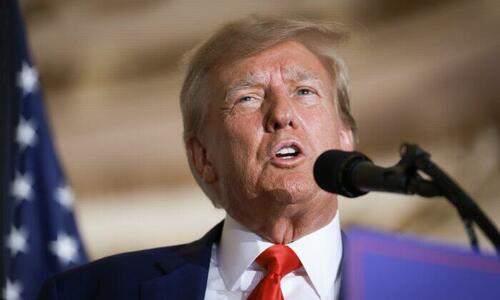
Smith also misled the court, after originally telling U.S. District Judge Aileen Cannon that the boxes remained "in their original, intact form as seized," when in a footnote they conceded that they removed classified documents and left placeholder sheets, which prosecutors acknowledged has created an "inconsistent" record - in which some of the documents are no longer in the same order as they appear in digital scans made in the fall of 2022.
"The Government acknowledges that this is inconsistent with what Government counsel previously understood and represented to the Court," the footnote reads, according to Just the News.
The finding comes after Cannon ordered a review into whether the FBI may have seized legally privileged records in response to a request from Trump co-defendant Walt Nauta.
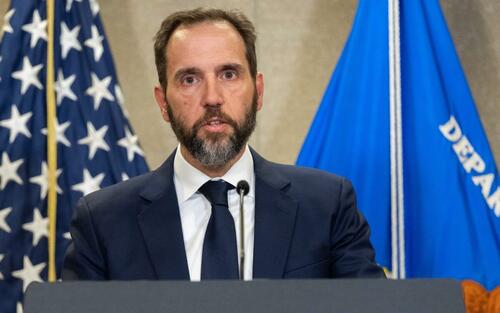
"Since the boxes were seized and stored, appropriate personnel have had access to the boxes for several reasons, including to comply with orders issued by this Court in the civil proceedings noted above, for investigative purposes, and to facilitate the defendants' review of the boxes," wrote Smith's team in the Friday filing.
"There are some boxes where the order of items within that box is not the same as in the associated scans," the filing continues.
The organization of the documents in storage boxes at Mar-a-Lago is likely to be an important part of Trump‘s defense. His team is expected to argue the documents were stored in the White House in chronological order on the days that Trump received them, and that staff simply boxed them up and sent them to his home without him accessing them or knowing they contained classified information.
Smith’s team tried to downplay the problem and argued it’s not a reason for a delay in Trump’s case.
But several legal experts told Just the News the court filing essentially is an admission of evidence tampering, and could be problematic. -Just the News
"Prosecutors and investigators should never tamper with or alter evidence in their possession, including the order of documents in a box because one never knows what may become relevant or crucial to a court or jury later in a case," Alan Dershowitz told Just the News.
"This admission is stunning on multiple levels," said defense attorney Tim Parlatore, who worked on Trump’s team earlier in the classified documents case but no longer is involved, adding that the revelation "reinforces the incompetence" of prosecutors "in conducting basic criminal investigations and prosecutions that I observed when I was on the team.
"But at a deeper level, the loss of specific document locations is a destruction of exculpatory evidence," Parlatore added. "I went through all of the boxes at NARA and the document order was important because it was clear to us that the boxes had been untouched since leaving the White House.

"For prosecutors who are trying to prove that the defendants knowingly possessed these documents to then destroy the evidence that would undermine that claim is a very serious violation," he said.
In response to the filing, Trump said on Truth Social that "Deranged Jack has admitted in a filing in front of Judge Cannon to what I have been saying happened since the Illegal RAID on my home ... that he and his team committed blatant Evidence Tampering by mishandling the very Boxes they used as a pretext to bring this Fake Case."

Smith's Excuses
The prosecution offered several explanations for the manipulated evidence.
"There are several possible explanations, including the above-described instances in which the boxes were accessed, as well as the size and shape of certain items in the boxes possibly leading to movement of items," reads the filing. "For example, the boxes contain items smaller than standard paper such as index cards, books, and stationary, which shift easily when the boxes are carried, especially because many of the boxes are not full."
That said, Just the News also notes that altered evidence has featured prominently in previous political scandals.
Erasure of an 18 1/2 minute segment of Richard Nixon’s White House tapes became a very important aspect of the Watergate scandal.
The Iran-Contra scandal exploded during the Reagan years with the revelation that documents were shredded before they could be obtained by investigators.
The Hillary Clinton classified email scandal became more complicated in 2015 with the revelation that her team used a "Bleach Bit" program to erase emails on her secret computer server, and had email devices destroyed.
As Judicial Watch's Tom Fitton suggests, this is "Yet more reason to throw out this sham prosecution."
And as the Epoch Times notes, the case was brought against President Trump and others over their alleged violation of federal law in handling documents marked classified. Defendants have pleaded not guilty.
Neither Mr. Nauta nor other defendants in the case have responded yet to the new filing.
Mr. Nauta’s request for an extension is one of many documents that are under seal, or unavailable for perusal.
In another recent filing, President Trump’s team said that the case should be dismissed because prosecutors are motivated by “improper political animus,” pointing in part to how White House lawyers worked with the National Archives and Records Administration on its referral to the Department of Justice and how President Joe Biden has said that he was “making sure” President Trump “does not become the next president again.”
Prosecutors opposed the dismissal request but their opposition was filed under seal.
Read the filing below (via Just the News):
|
|
[Uncategorized]
Portland State: Police Recover ‘Improvised Weapons’ Left Behind in Library by Pro-Hamas Mob
The mob trashed the library. They stole rare books and comic books.
The post Portland State: Police Recover ‘Improvised Weapons’ Left Behind in Library by Pro-Hamas Mob first appeared on Le·gal In·sur·rec·tion.
Published:5/2/2024 7:19:25 PM
|
[Markets]
Fighting Monsters
Fighting Monsters
Authored by CJ Hopkins via off-guardian.org,
 Fighting monsters by serbiandude Published: Jan 3, 2023 Fighting monsters by serbiandude Published: Jan 3, 2023
So, I gave a little speech about art, and war. The Internationale Agentur für Freiheit, a Berlin art and cultural association, asked me to do that to open their exhibition, Make Art Not War. I couldn’t turn them down.
As my readers may have noticed, I haven’t had very much to say about “The War on Hamas,” or “The War on Gaza,” or “The Liquidation of Gaza,” or whatever you want to call it. (It doesn’t look like much of a “war” to me, but then, nothing really has for quite a while.)
I wrote about it in October and November of last year. And I said a few things about it in my speech. But, mostly, I’ve been trying to keep my mouth shut. I don’t have much to contribute to the … well, I can’t really call it a discussion, or debate, or an argument. It feels like people screaming slogans into each other’s faces, accusing each other of this and that, and calling each other names, and so on. Which … I get why people are inclined to do that. I’m not. But I get why other folks are. So, I think it’s best if I just shut my pie hole (as much as possible) and let folks do that.
It isn’t going to change what’s happening. GloboCap (or whatever you call the system we’re all living under) has been occupying, destabilizing, and restructuring the Middle East for decades. It’s not going to stop. It is going to continue. As the restructuring of the West is going to continue.
GloboCap doesn’t have anything else to do.
Anyway, before I ramble on any further, here’s the English version of the speech I gave at the exhibition. Many thanks to those of you who attended … and apologies again for my German. I’ll get the hang of it one of these days.
Fighting Monsters
The name of this exhibition is “Make Art not War.” So I’m going to say a few things about art, and war. You’re not going to like all of them. Or at least I hope not. If you did, I wouldn’t be a very good artist, but I might be a pretty good propagandist.
I grew up in the 1960s and 70s. In the USA. The war was on television. In Vietnam. Cambodia. Cuba. The Middle East. Then in El Salvador. Nicaragua. Iran. Libya. Yugoslavia. Afghanistan. Iraq. The list goes on and on. I am almost 63 years old. All my life we’ve been at war. Not just Americans. All of us. People. Someone always at war with someone. And all my life there have been other people calling for peace. Protesting the war. Whatever war it was at the time.
If you read a little history, as I like to do sometimes, you will learn that someone has been at war with someone over something since the dawn of civilization. Certainly Western civilization. The history of Western art and literature begins with war. Genocidal war. The Illiad is a poem about a genocidal war. Rape. Mass murder. The slaughter of children. Most of Shakespeare’s plays are about war, or are set during a war, or have something to do with someone killing someone over something.
Some of that history happened right here. There are bunkers below us where people sheltered during the bombing raids in the Second World War. Legend has it the Stasi operated listening stations right here in these rooms. When I first arrived in Berlin, twenty years ago, I lived in a sublet on this street. This was my neighborhood, the Bötzowviertel. There were still bullet holes in the facades of buildings. People died here. Civilians. Children. Women were raped here. Families were dragged out of their homes and sent to the death camps here. This is Berlin. You know the history. I don’t need to recite all the details.
What’s my point? Well, my point is … that is war. Indiscriminate killing. Rape. Mass atrocities. That’s what war is. That is what it has always been. And we’ve been doing it to each other since the dawn of civilization. It is not going to stop. We are not going to stop it. Art is certainly not going to stop it. We are, whether we like it or not, a violent species, human beings. It isn’t all we are, but it is part of what we are. We are also lovers, teachers, healers, artists, and other beautiful things. But sometimes we are vicious killers. Monsters. Genocidal monsters.
A crazy old German philosopher once warned us, “beware that, when fighting monsters, you yourself do not become a monster.” He was joking, of course. There are no monsters. Or, rather, there are only monsters, on every side of every war. In a war, there are no good guys and bad guys. There is just our side and the other side. Our atrocities and their atrocities. And whoever wins gets to write the history.
That’s it. The rest is propaganda. Their propaganda and our propaganda. Of course, our propaganda is not propaganda. Our propaganda is just the truth. Because we’re not monsters. They are the monsters.
This is Day 202 of Israel’s war on Hamas, or its liquidation of Gaza, depending on your perspective. I haven’t said too much about it publicly. I said a few things about it when it began. That didn’t go well. No one was listening. The propaganda from both sides was already deafening. I described the Hamas attack as mass murder. My pro-Palestinian readers didn’t like that. I described Israel as a typical mass-murdering nation-state, no different than the United States of America, Germany, France, Spain, The Netherlands, the Soviet Union, the British empire, the Ottoman empire, the Holy Roman Empire, or any other mass-murdering nation-state or empire. My pro-Israeli readers didn’t like that. Neither side wanted to hear about history. The history of asymmetric warfare, or terrorism, depending on your perspective. The history of nation-states and empires. They wanted to hear a story about monsters. About the monsters on the other side.
I told you you weren’t going to like everything I said, right?
OK, let me say a few things about art now. If you didn’t like what I said about war, maybe you’ll like what I say about art. I can’t speak for other artists, but I’ll tell you why I think I became an artist, and what I have been trying to do as an artist.
I haven’t been trying to stop any wars. Or to pacify the human species. I don’t know how to do either of those things. And I am not a fan of propaganda. I confess, I have engaged in it from time to time, but mostly what I’ve been trying to do is deprogram minds, starting with my own.
We are all, by the time we realize we exist, the products of programming, ideological conditioning. I believe it is the job of artists to undo that, or at least to marginally interfere with it. That’s what art, and artists, did for me. They introduced me to my mind. My programmed mind. They forced me to think, and to see, and listen. They taught me to question, to pay attention. They dared me to deprogram my mind, and provided me with the tools to do it. OK, sure, some mind-altering drugs also helped, but it was artists that introduced me to those drugs. Then they introduced me to the monster I’ve been fighting.
I have been fighting this monster, in my art, in my mind, and out in the world for as long I remember. You have to fight it everywhere at once. To fight it in your mind, you have to fight it out in the world. And to fight it out in the world, you have to fight it in your mind.
Let me tell you about the monster.
The monster is legion. It goes by many names. It wears many faces. They change over time. William S. Burroughs called it “The Control Machine.” Some people call it the corporatocracy. I call it global capitalism. The monster doesn’t care what we call it. It doesn’t care who we are, what our politics are, or which side of what war we think we are on. It doesn’t care what we believe, which religion we profess. It couldn’t care less how we “identify.”
All it cares about is power. All it cares about is control.
It is everywhere, and nowhere. It has no country. No nationality. It doesn’t exist. It is everything, and nothing. It is the non-existent empire occupying the entire planet. It has no external enemies because there is no outside, not anymore. So there is no real war. There are only insurrections, carried out by rebels, traitors, terrorists.
The monster, our non-existent empire, is the first global empire in human history. It is not a group of evil people. It is maintained by people, but they are all interchangeable. It has no headquarters. There is no emperor. There isn’t any “Bastille” to storm. It is a logos. A system. An operating system.
It has no politics, no ideology. Its official ideology is “reality.” Thus it has no political opposition. Who would argue against or oppose “reality”? Lunatics. Extremists. The terminally deranged. And thus there are no dissidents, no opposing political parties. There are only apostates, heretics, blasphemers, sowers of discord, “reality” deniers.
It manufactures “reality.” Whatever “reality” it needs. The War on Terror. The War on Populism. The War on the Virus. The War on the Weather. The War on Hate. The War on Whatever. It doesn’t matter. It is all the same war. The same “Clear-and-Hold” op. The same counterinsurgency. It has been for about 30 years.
If things seem crazy, if you’re wondering what’s happening, that is what’s happening. That is all that is happening. That is all that has been happening since the end of the Cold War.
The empire is eliminating internal resistance, any and all forms of internal resistance. The monster is monsterizing everything and everyone. Transforming societies into markets. It doesn’t have anything else to do. It is erasing values. It is dissolving borders. It is “sensitivity-editing” culture. Synchronizing everything and everyone in conformity to its only value … money. Rendering everything a commodity.
It is the apotheosis of liberal democracy, the part where the monster does away with democracy, with the simulation of democracy, and proclaims itself “democracy.” It is global-capitalist Gleichschaltung.
That’s the monster I have been fighting.
Which makes me a terrorist. A conspiracy theorist. A Russian propagandist. A Covid denier. A right-wing extremist. An anti-vaxxer. An anti-Semite. A transphobic racist. An enemy of “democracy.” A Hamas supporter. A Donald Trump supporter. An AfD supporter. Whatever the official enemy happens to be today.
It makes me a criminal. A thought criminal. An art criminal.
Which I literally am. The German authorities are prosecuting me for disseminating art. For tweeting art. Pictures. Words. They banned one of my books. So maybe I’m marginally interfering with their ideological conditioning, with their programming, with their New Normal Gleichschaltung op.
If so, good, because, if I can quote another German, “art is not a mirror held up to reality, it is a hammer to shape reality with.”
And I’ll go a little further than Brecht. Every work of art we make shapes reality one way or another, whether we intend it to or not. It either feeds the monster or it fucks with the monster. The monster out there, and the monster in here, inside us, all of us … because it’s all the same monster.
Thank you, all of you who are fucking with the monster. That is all. Let’s keep it up.
CJ Hopkins is an award-winning American playwright, novelist and political satirist based in Berlin. His plays are published by Bloomsbury Publishing and Broadway Play Publishing, Inc. His dystopian novel, Zone 23, is published by Snoggsworthy, Swaine & Cormorant. Volumes I and II of his Consent Factory Essays are published by Consent Factory Publishing, a wholly-owned subsidiary of Amalgamated Content, Inc. He can be reached at cjhopkins.com or consentfactory.org.
|
|
[e92c8167-01e7-5e09-8509-a128db482009]
Author Ransom Riggs announces new fantasy series 'Sunderworld' following success of 'Miss Peregrine' books
Ransom Riggs, known for the bestselling "Miss Peregrine" series, is set to release his new series "Sunderworld" this summer, published by Dutton Books for Young Readers.
Published:5/1/2024 9:30:05 AM
|
|
[Entertainment]
Washington Post paperback bestsellers
A snapshot of popular books.
Published:5/1/2024 8:10:00 AM
|
[Markets]
Maté: What 10 Years Of US Meddling In Ukraine Have Wrought (Spoiler Alert: Not Democracy)
Maté: What 10 Years Of US Meddling In Ukraine Have Wrought (Spoiler Alert: Not Democracy)
Authored by Aaron Maté via RealClear Investigations,
In successfully lobbying Congress for an additional $61 billion in Ukraine war funding, an effort that ended this month with celebratory Democrats waving Ukrainian flags in the House chamber, President Biden has cast his administration’s standoff with Russia as an existential test for democracy.
“What makes our moment rare is that freedom and democracy are under attack, both at home and overseas,” Biden declared in his State of the Union address in March. “History is watching, just like history watched three years ago on January 6th.”
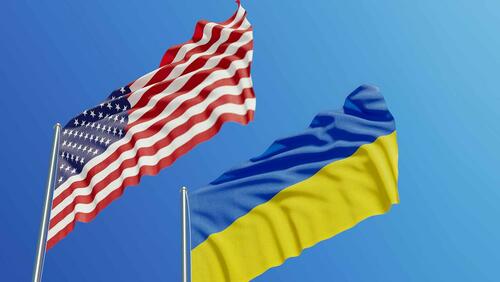
While Biden’s narrative is widely accepted by Washington’s political establishment, a close examination of the president and his top principals’ record dating back to the Obama administration reveals a different picture. Far from protecting democracy from Kyiv to Washington, their role in Ukraine looks more like epic meddling resulting in political upheaval for both countries.
Over the last decade, Ukraine has been the battleground in a proxy war between the U.S. and Russia – a conflict massively escalated by the Kremlin’s invasion in 2022. The fight erupted in early 2014, when Biden and his team, then serving in the Obama administration, supported the overthrow of Ukraine’s elected president, Viktor Yanukovych. Leveraging billions of dollars in U.S. assistance, Washington has shaped the personnel and policies of subsequent Ukrainian governments, all while expanding its military and intelligence presence in Ukraine via the CIA and NATO. During this period, Ukraine has not become an independent self-sustaining democracy, but a client state heavily dependent on European and U.S. support, which has not protected it from the ravages of war.
The Biden-Obama team’s meddling in Ukraine has also had a boomerang effect at home.
As well-connected Washington Beltway insiders such as Hunter Biden have exploited it for personal enrichment, Ukraine has become a source of foreign interference in the U.S. political system – with questions of unsavory dealings arising in the 2016 and 2020 elections as well as the first impeachment of Donald Trump. After years of secrecy, CIA sources have only recently confirmed that Ukrainian intelligence helped generate the Russian interference allegations that engulfed Trump’s presidency. House Democrats' initial attempt to impeach Trump, undertaken in the fall of 2019, came in response to his efforts to scrutinize Ukraine’s Russiagate connection.
This account of U.S. interference in Ukraine, which can be traced to fateful decisions made by the Obama administration, including then-Vice President Biden and his top aides, is based on often overlooked public disclosures. It also relies on the personal testimony of Andrii Telizhenko, a former Ukrainian diplomat and Democratic Party-tied political consultant who worked closely with U.S. officials to promote regime change in Ukraine.
Although he once welcomed Washington’s influence in Ukraine, Telizhenko now takes a different view. “I'm a Ukrainian who knew how Ukraine was 30 years ago, and what it became today,” he says. “For me, it's a total failed state.” In his view, Ukraine has been “used directly by the United States to fight a [proxy] war with Russia” and “as a rag to make money for people like Biden and his family.”
The State Department has accused Telizhenko being part of a "Russia-linked foreign influence network." In Sept. 2020 it revoked his visa to travel to the United States. Telizhenko, who now lives in a western European country where he was granted political asylum, denies working with Russia and says that he is a whistleblower speaking out to expose how U.S. interference has ravaged his country. RealClearInvestigations has confirmed that he worked closely with top American officials while they advanced policies aimed at severing Ukraine’s ties to Russia. No official contacted for this article – including former CIA chief John Brennan and senior State Department official Victoria Nuland – disputed any of his claims.
A Coup in 'Full Coordination' With the U.S.
The Biden team’s path to influencing Ukraine began with the eruption of anti-government unrest in November 2013. That month, protesters began filling Kyiv’s Maidan Nezalezhnosti (Independence Square) after then-President Viktor Yanukovych, a notoriously corrupt leader, delayed signing a European Union (EU) trade pact. To members of what came to be known as the Maidan movement, Yanukovych’s decision was a betrayal of his pledge to strengthen Western ties, and a worrying sign of Russian allegiance in a country haunted by its Soviet past.
The reality was more complex. Yanukovych was hoping to maintain relations with both Russia and Europe – and use competition between them to Ukraine’s advantage. He also worried that the EU’s terms, which demanded reduced trade with Russia, would alienate his political base in the east and south, home to millions of ethnic Russians. As the International Crisis Group noted, these Yanukovych-supporting Ukrainians feared that the EU terms “would hurt their livelihoods, a large number of which were tied to trade and close relations with Russia.” Despite claims that the Maidan movement represented a “popular revolution,” polls from that period showed that Ukrainians were evenly split on it, or even majority opposed.
After an initial period of peaceful protest, the Maidan movement was soon co-opted by nationalist forces, which encouraged a violent insurrection for regime change. Leading Maidan’s hardline contingent was Oleh Tyahnybok of the Svoboda party, who had once urged his supporters to fight what he called the “Muscovite-Jewish mafia running Ukraine.” Tyahnybok’s followers were joined by Right Sector, a coalition of ultra-nationalist groups whose members openly sported Nazi insignia. One year before, the European Parliament condemned Svoboda for “racist, anti-Semitic and xenophobic views” and urged Ukrainian political parties “not to associate with, endorse or form coalitions with this party.”
Powerful figures in Washington took a different view: For them, the Maidan movement represented an opportunity to achieve a longtime goal of pulling Ukraine into the Western orbit. Given Ukraine’s historical ties to Russia, its integration with the West could also be used to undermine the rule of Russian President Vladimir Putin.
As the-late Zbigniew Brzezinski, the influential former national security adviser to President Jimmy Carter, once wrote: “Without Ukraine, Russia ceases to be a Eurasian empire.” Two months before the Kyiv protests erupted, Carl Gershman, head of the National Endowment for Democracy, dubbed Ukraine “the biggest prize” in the West’s rivalry with Russia. Absorbing Ukraine, Gershman explained, could leave Putin “on the losing end not just in the near abroad" – i.e, its former Soviet satellites – "but within Russia itself.” Shortly after, senior State Department official Nuland boasted that the U.S. had “invested more than $5 billion” to help pro-Western “civil society” groups achieve a “secure and prosperous and democratic Ukraine.”
Seeking to capitalize on the unrest, U.S. figures including Nuland, Republican Sen. John McCain, and Democratic Sen. Chris Murphy visited Maidan Square. In a show of support for the movement’s hardline faction, which went beyond supporting the EU trade deal to demand Yanukovych’s ouster, the trio met privately with Tyahnybok and appeared with him on stage. The senators' mission, Murphy said, was to “bring about a peaceful transition here.”
The Maidan Movement’s most significant U.S. endorsement came from then-Vice President Joe Biden. “Nothing would have greater impact for securing our interests and the world’s interests in Europe than to see a democratic, prosperous, and independent Ukraine in the region,” Biden said.
According to Andrii Telizhenko, a former Ukrainian government official who worked closely with Western officials during this period, the U.S. government’s role went far beyond those high-profile displays of solidarity.
“As soon as it grew into something, into the bigger Maidan, in the beginning of December, it basically was full coordination with the U.S. Embassy,” Telizhenko recalls. “Full, full.”
When the protests erupted, Telizhenko was working as an adviser to a Ukrainian member of Parliament. Having spent part of his youth in Canada and the United States, Telizhenko’s fluent English and Western connections landed him a position helping to oversee the Maidan Movement’s international relations. In this role, he organized meetings with and coordinated security arrangements for foreign visitors, including U.S. Ambassador Geoffrey Pyatt, Nuland, and McCain. Most of their briefings were held at Kyiv’s Trade Unions Building, the movement’s de-facto headquarters in the city’s center.
Telizhenko says Pyatt routinely coordinated with Maidan leaders on protest strategy. In one encounter, the ambassador observed Right Sector members assembling Molotov cocktails that would later be thrown at riot police attempting to enter the building. Sometimes, the U.S. ambassador disapproved of his counterparts’ tactics. “The U.S. embassy would criticize if something would happen more radical than it was supposed to go by plan, because it's bad for the picture,” Telizhenko said..
That winter was marked by a series of escalating clashes. On February 20, 2014, snipers fatally shot dozens of protesters in Maidan square. Western governments attributed the killings to Yanukovych's forces. But an intercepted phone call between NATO officials told a different story.
In the recorded conversation, Estonian foreign minister Urmas Paet told EU foreign secretary Catherine Ashton that he believed pro-Maidan forces were behind the slaughter. In Kyiv, Paet reported, “there is now stronger and stronger understanding that behind the snipers, it was not Yanukovych, but it was somebody from the new [opposition] coalition.”
In a bid to resolve the Maidan crisis and avoid more bloodshed, European officials brokered a compromise between Yanukovich and the opposition. The Feb. 21 deal called for a new national unity government that would keep him in office, with reduced powers, until early elections at year’s end. It also called for the disarmament of the Maidan forces and a withdrawal of riot police. Holding up its end of the bargain, government security forces pulled back. But the Maidan encampment's ultra-nationalist contingent had no interest in compromise.
“We don’t want to see Yanukovych in power,” Maidan Movement squadron leader Vladimir Parasyuk declared that same day. “… And unless this morning you come up with a statement demanding that he steps down, then we will take arms and go, I swear.”
In insisting on regime change, the far-right contingent was also usurping the leadership of more moderate opposition leaders such as Vitali Klitschko, who supported the power-sharing agreement.
“The goal was to overthrow the government,” Telizhenko says. “That was the first goal. And it was all green-lighted by the U.S. Embassy. They basically supported all this, because they did not tell them to stop. If they told them [Maidan leaders] to stop, they would stop.”
Yet another leaked phone call bolstered suspicions that the U.S. endorsed regime change. On the recording, presumably intercepted in January by Russian or Ukrainian intelligence, Nuland and Pyatt discussed their choice of leaders in a proposed power-sharing government with Yanukovich. Their conversation showed that the U.S. exerted considerable influence with the faction seeking the Ukrainian president’s ouster.
Tyahnybok, the openly antisemitic head of Svodova, would be a “problem” in office, Nuland worried, and better “on the outside.” Klitschko, the more moderate Maidan member, was ruled out as well. “I don’t think Klitsch should go into government,” Nuland said. “I don’t think it’s necessary. I don’t think it’s a good idea.” One reason was Klitschko's proximity to the European Union. Despite her government’s warm words for the European Union in public, Nuland told Pyatt: “Fuck the EU.”
The two U.S. officials settled on technocrat Arseniy Yatsenyuk. “I think Yats is the guy,” Nuland said. By that point, Yatsenyuk had endorsed violent insurrection. The government’s rejection of Maidan demands, he said, meant that “people had acquired the right to move from non-violent to violent means of protest.”
The only outstanding matter, Pyatt relayed, was securing “somebody with an international personality to come out here and help to midwife this thing.” Nuland replied that Vice President Joe Biden and his senior aide, Jake Sullivan, who now serves as Biden’s National Security Adviser, had signed on to provide “an atta-boy and to get the deets [details] to stick.”
Just hours after the power-sharing agreement was reached, Nuland’s wishes were granted. Yanukovich, no longer protected by his armed forces, fled the capital. Emboldened by their sabotage of an EU-brokered power-sharing truce, Maidan Movement members stormed the Ukrainian Parliament and pushed through the formation of a new government. In violation of parliamentary rules on impeachment proceedings, and lacking a sufficient quorum, Oleksandr Turchynov was named the new acting president. The Nuland-backed Yatsenyuk was appointed Prime Minister.
In a reflection of their influence, at least five post-coup cabinet posts in national security, defense, and law enforcement were given to members of Svoboda and its far-right ally Right Sector.
“The uncomfortable truth is that a sizeable portion of Kyiv’s current government – and the protesters who brought it to power – are, indeed, fascists,” wrote Andrew Foxall, now a British defense official, and Oren Kessler, a Tel Aviv-based analyst, in Foreign Policy the following month. While denying any role in Yanukovich’s ouster, the Obama administration immediately endorsed it, as Secretary of State John Kerry expressed “strong support” for the new government.
In his memoir, former senior Obama aide Ben Rhodes acknowledged that Nuland and Pyatt “sounded as if they were picking a new government as they evaluated different Ukrainian leaders.” Rather than dispel that impression, he acknowledged that some of the Maidan “leaders received grants from U.S. democracy promotion programs.”
In 2012, one pro-Maidan group, Center UA, received most of its more than $500,000 in donations from the U.S. Agency for International Development (USAID), the National Endowment for Democracy, eBay founder Pierre Omidyar, and financier George Soros.
By its own count, Soros’ International Renaissance Foundation spent over $109 million in Ukraine between 2004 and 2014. In leaked documents, a former IRF board member even bragged that its partners “were the main driving force and the foundation of the Maidan movement,” and that without Soros’ funding, “the revolution might not have succeeded.” Weeks after the coup, an IRF strategy document noted, “Like during the Maidan protests, IRF representatives are in the midst of Ukraine’s transition process.”
Jeffrey Sachs, a Columbia University professor who advised Ukraine on economic policy in the early 1990s, visited Kyiv shortly after the coup to consult with the new government.
“I was taken around the Maidan where people were still milling around,” Sachs recalls. “And the American NGOs were around there, and they were describing to me: ‘Oh we paid for this, we paid for that. We funded this insurrection.’ It turned my stomach.” Sachs believes that these groups were acting at the behest of U.S. intelligence. To go about “funding this uprising,” he says, “they didn't do that on their own as nice NGOs. This is off-budget financing for a U.S. regime-change operation.”
Weeks after vowing to bring about a “transition” in Ukraine, Sen. Murphy openly took credit for it. “I really think that the clear position of the United States has in part been what has helped lead to this change in regime,” Murphy said. “I think it was our role, including sanctions and threats of sanctions, that forced, in part, Yanukovych from office.”
The Proxy War Gets Hot
Far from resolving the unrest, Viktor Yanukovych’s ouster plunged Ukraine into a war.
Just days after the Ukrainian president fled to Moscow, Russian special forces stormed Crimea’s local parliament. The following month, Russia annexed Crimea following a hasty, militarized referendum denounced by Ukraine, the U.S., and much of the world. While these objections were well-founded, Western surveys of Crimeans nonetheless found majority support for Russian annexation.
Emboldened by the events in Crimea, and hostile to a new government that had overthrown their elected leader Yanukovych, Russophile Ukrainians in the eastern Donbas region followed suit.
On April 6 and 7, anti-Maidan protesters seized government buildings in Donetsk, Luhansk, and Kharkiv. The Donetsk rebels declared the founding of the Donetsk People’s Republic. The Luhansk People’s Republic followed 20 days later. Both areas announced independence referendums for May 11.
As in Crimea, Moscow backed the Donbas rebellion. But unlike in Crimea, the Kremlin opposed the independence votes. The organizers, Putin said, should “hold off on the referendum in order to give dialogue the conditions it needs to have a chance.”
In public, the Obama administration claimed to also favor dialogue between Kyiv and the Russia-backed rebels in eastern Ukraine. Behind the scenes, a more aggressive plan was brewing.
On April 12, CIA chief John Brennan slipped into the Ukrainian capital for secret meetings with top officials. Russia, whose intelligence services ran a network of informants inside Ukraine, publicly outed Brennan’s visit. The Kremlin and Yanukovych directly accused Brennan of encouraging an assault on the Donbas.
The CIA dismissed the allegation as “completely false,” and insisted that Brennan supported a “diplomatic solution” as “the only way to resolve the crisis.” The following month, Brennan insisted that “I was out there to interact with our Ukrainian partners and friends.”
Yet Russia and Yanukovych were not alone in voicing concerns about the CIA chief’s covert trip. “What message does it send to have John Brennan, the head of the CIA in Kiev, meeting with the interim government?” Sen. Murphy complained. “Does that not confirm the worst paranoia on the part of the Russians and those who see the Kiev government as essentially a puppet of the West?... It may not be super smart to have Brennan in Kiev, giving the impression that the United States is somehow there to fight a proxy war with Russia.”
According to Telizhenko, who attended the Brennan meeting and spoke to RCI on record about it for the first time, that’s exactly what the CIA chief was there to do. Contrary to U.S. claims, Telizhenko says, “Brennan gave a green light to use force against Donbas,” and discussed “how the U.S. could support it.” One day after the meeting, Kyiv announced an “Anti-Terrorist Operation” (ATO) against the Donbas region and began a military assault.
Telizhenko, who was by then working as a senior policy adviser to Vitaliy Yarema, the First Deputy Prime Minister, says he helped arrange the Brennan gathering after getting a phone call from the U.S. embassy. “I was told there was going to be a top secret meeting, with a top U.S. official and that my boss should be there,” he recalls. “I was also told not to tell anyone.”
Brennan, he recalls, arrived at the Foreign Intelligence Office of Ukraine in a beat-up gray mini-van and a coterie of armed guards. Others in attendance included U.S. Ambassador Pyatt, Acting President Oleksandr Turchynov, foreign intelligence chief Victor Gvozd, and other senior Ukrainian security officials.
After a customary exchange of medals and souvenir trophies, the topic turned to the unrest in the Donbas. “Brennan was talking about how Ukraine should act,” Telizhenko says. “A plan to keep Donbas in Ukraine’s hands. But Ukraine’s army was not fully equipped. We only had stuff in reserves. They discussed plans for the ATO and how to keep Ukraine’s military fully armed throughout.” Brennan’s overall message was that “Russia is behind” the Donbas unrest, and “Ukraine has to take firm, aggressive action to not let this spread all over.”
Brennan and Pyatt did not respond to a request for comment.
Two weeks after Brennan’s visit, the Obama administration offered yet another high-level endorsement of the Donbas operation when then-Vice President Biden visited Kyiv. With Ukraine facing “unrest and uncertainty,” Biden told a group of lawmakers, it now had “a second opportunity to make good on the original promise made by the Orange Revolution” – referring to earlier 2004-2005 post-electoral upheaval that blocked Yanukovych, albeit temporarily, from the presidency.
Looking back, Telizhenko is struck by the contrast between Brennan’s bellicosity in Donbas and the Obama administration’s lax response to Russia’s Crimea grab one month prior.
“After Crimea, they told us not to respond,” he said. But beforehand, “the Americans scoffed at warnings” that Ukraine could lose the peninsula. When Ukrainian officials met with Pentagon counterparts in March, “we gave them evidence that the little green men” – the incognito Russian forces who seized Crimea – “were Russians. They dismissed it.” Telizhenko now speculates that the U.S. permitted the Crimean takeover to encourage a conflict between Kyiv and Moscow-backed eastern Ukrainians. “I think they wanted Ukraine to hate Russia, and they wanted Russia to take the bait,” he said. Had Ukraine acted earlier, he believes, “the Crimea situation could have been stopped.”
With Russia in control of Crimea and Ukraine assaulting the Donbas with U.S. backing, the country descended into a full-scale civil war. Thousands were killed and millions displaced in the ensuing conflict. When Ukrainian forces threatened to overrun the Donbas rebels in August 2014, the Kremlin launched a direct military intervention that turned the tide. But rather than offer Ukraine more military assistance, Obama began getting cold feet.
Obama, senior Pentagon official Derek Chollet recalled, was concerned that flooding Ukraine with more weapons would “escalate the crisis” and give “Putin a pretext to go further and invade all of Ukraine.”
Rebuffing pressure from within his own Cabinet, Obama promised German Chancellor Angela Merkel in February 2015 that he would not send lethal aid to Ukraine. According to the U.S. Ambassador to Germany, Peter Wittig, Obama agreed with Merkel on the need “to give some space for those diplomatic, political efforts that were under way.”
That same month, Obama’s commitment gave Merkel the momentum to finalize the Minsk II Accords, a pact between Kyiv and Russian-backed Ukrainian rebels. Under Minsk II, an outmatched Ukrainian government agreed to allow limited autonomy for the breakaway Donbas regions in exchange for the rebels’ demilitarization and the withdrawal of their Russian allies.
Inside the White House, Obama’s position on Ukraine left him virtually alone. Obama’s reluctance to arm Ukraine, Chollet recalled, marked a rare situation “in which just about every senior official was for doing something that the president opposed.”
One of those senior officials was the State Department’s point person for Ukraine, Victoria Nuland. Along with allied officials and lawmakers, Nuland sought to undermine the Minsk peace pact even before it was signed.
As Germany and France lobbied Moscow and Kyiv to accept a peace deal, Nuland addressed a private meeting of U.S. officials, generals, and lawmakers – including Sen. McCain and future Secretary of State Mike Pompeo – on the sidelines of the annual Munich Security Conference. Dismissing the French-German diplomatic efforts as an act of appeasement, Nuland outlined a strategy to continue the war with a fresh influx of Western arms. Perhaps mindful of the optics of flooding Ukraine with military hardware at a time when the Obama administration was claiming to support to a peace agreement, Nuland offered a public relations suggestion. “I would like to urge you to use the word ‘defensive system’ to describe what we would be delivering against Putin’s offensive systems,” Nuland told the gathering.
The Munich meeting underscored that while President Obama may have publicly supported a peace deal in Ukraine, a bipartisan alliance of powerful Washington actors – including his own principals – was determined to stop it. As Foreign Policy magazine reported, “the takeaway for many Europeans ... was that Nuland gave short shrift to their concerns about provoking an escalation with Russia and was confusingly out of sync with Obama.”
As Nuland and other officials quietly undermined the Minsk accords, the CIA deepened its role in Ukraine. U.S. intelligence sources recently disclosed to the New York Times that the agency has operated 12 secret bases inside Ukraine since 2014. The post-coup government’s first new spy chief, Valentyn Nalyvaichenko, also revealed that he established a formal partnership with the CIA and MI6 just two days after Yanukovych’s ouster.
According to a separate account in the Washington Post, the CIA restructured Ukraine’s two main spy services and turned them into U.S. proxies. Starting in 2015, the CIA transformed Ukraine’s military intelligence agency, the GUR, so extensively that “we had kind of rebuilt it from scratch,” a former intelligence official told the Post. “GUR was our little baby.” As a benefit of being the CIA's proxy, the agency even funded new headquarters for the GUR’s paramilitary wing and a separate division for electronic espionage.
In a 2016 congressional appearance, Nuland touted the extensive U.S. role in Ukraine. “Since the start of the crisis, the United States has provided over $760 million in assistance to Ukraine, in addition to two $1 billion loan guarantees,” Nuland said. U.S. advisers “serve in almost a dozen Ukrainian ministries,” and were helping “modernize Ukraine’s institutions” of state-owned industries.
Nuland’s comments underscored an overlooked irony of the U.S. role in Ukraine: In claiming to defend Ukraine from Russian influence, Ukraine was subsumed by American influence.
Boomeranging Into U.S. Politics
In the aftermath of the February 2014 coup, the transformation of Ukraine into an American client state soon had a boomerang effect, as maneuvers in that country increasingly impacted U.S. domestic politics.
“Americans are highly visible in the Ukrainian political process,” Bloomberg columnist Leonid Bershidsky observed in November 2015. “The U.S. embassy in Kyiv is a center of power, and Ukrainian politicians openly talk of appointments and dismissals being vetted by U.S. Ambassador Geoffrey Pyatt and even U.S. Vice President Joe Biden.”
One of the earliest and best-known cases came in December 2015, when Biden threatened to withhold $1 billion in aid unless Ukraine fired its prosecutor general, Viktor Shokin, whom the vice president claimed was corrupt. When Biden’s threat resurfaced as an issue during the 2020 election, the official line, as reported by CNN, was that “the effort to remove Shokin was backed by the Obama administration, European allies” and even some Republicans.
In fact, from Washington’s perspective, the campaign for Shokin’s ouster marked a change of course. Six months before Biden’s visit, Nuland had written Shokin that “We have been impressed with the ambitious reform and anti-corruption agenda of your government.”
And as RCI recently reported:
An Oct. 1, 2015, memo summarizing the recommendation of the [U.S.] Interagency Policy Committee on Ukraine stated, “Ukraine has made sufficient progress on its [anti-corruption] reform agenda to justify a third [loan] guarantee.” … The next month, moreover, the task force drafted a loan guarantee agreement that did not call for Shokin’s removal. Then, in December, Joe Biden flew to Kyiv to demand his ouster.
No one has explained why Shokin suddenly came into the crosshairs. At the time, the prosecutor general was investigating Burisma, a Ukrainian energy firm that was paying Hunter Biden over $80,000 per month to sit on its board.
According to emails obtained from his laptop, Hunter Biden introduced his father to a top Burisma executive less than one year before. Burisma also retained Blue Star Strategies, a D.C. consulting firm that worked closely with Hunter, to help enlist U.S. officials who could pressure the Ukrainian government to drop its criminal probes.
Two senior executives at Blue Star, Sally Painter and Karen Tramontano, formerly worked as top aides to President Bill Clinton.
According to a November 2015 email sent to Hunter by Vadym Pozharsky, a Burisma adviser, the energy firm’s desired “deliverables” included visits from “influential current and/or former US policy-makers to Ukraine.” The “ultimate purpose” of these visits would be “to close down” any legal cases against the company’s owner, Mykola Zlochevsky. One month after that email, Joe Biden visited Ukraine and demanded Shokin’s firing.
Telizhenko – who worked in Shokin’s office at the time, and later worked for Blue Star – said the evidence contradicts claims that Shokin was fired because of his failure, among other things, to investigate Burisma. “There were four criminal cases opened in 2014 against Burisma, and two more additionally opened by Shokin when he became the Prosecutor General,” recalls Telizhenko. “So, whenever anybody says, ‘There were no criminal cases, nobody was investigating Burisma, Shokin was fired because he was a bad prosecutor, he didn't do his work’ ... this was all a lie. No, he did his work.”
In a 2023 interview, Hunter Biden’s former business partner, Devon Archer, said Shokin was seen as a “threat” to Burisma. Both of Shokin’s cases against Burisma were closed after his firing.
Ukraine Meddling vs. Trump
While allegations of Russian interference and collusion would come to dominate the 2016 campaign, the first documented case of foreign meddling originated in Ukraine.
Telizhenko, who served as a political officer at the Ukrainian embassy in Washington, D.C., before joining Blue Star, was an early whistleblower. He went public in January 2017, telling Politico how the Ukrainian embassy worked to help Hillary Clinton’s 2016 election campaign and undermine Trump’s.
According to Telizhenko, Ukraine’s D.C. ambassador, Valeriy Chaly, instructed staffers to shun Trump’s campaign because “Hillary was going to win.”
Telizhenko says he was told to meet with veteran Democratic operative Alexandra Chalupa, who had also served in the Clinton White House. “The U.S. government and people from the Democratic National Committee are approaching and asking for dirt on a presidential candidate,” Telizhenko recalls. “And Chalupa said, ‘I want dirt. I just want to get Trump off the elections.’”
Starting in early 2016, U.S. officials leaned on the Ukrainians to investigate Paul Manafort, the GOP consultant who would become Trump’s campaign manager, and avoid scrutiny of Burisma, as RCI reported in 2022. “Obama’s NSC hosted Ukrainian officials and told them to stop investigating Hunter Biden and start investigating Paul Manafort,” a former senior NSC official told RCI. In January 2016, the FBI suddenly reopened a closed investigation into Manafort for potential money laundering and tax evasion connected to his work in Ukraine.
Telizhenko, who attended a White House meeting with Ukrainian colleagues that same month, says he witnessed Justice Department officials pressing representatives of Ukraine’s Corruption Bureau. “The U.S. officials were asking for the Ukrainian officials to get any information, financial information, about Americans working for the former government of Ukraine, the Yanukovych government,” he says.
By the time Telizhenko spoke out, Ukrainian officials had already admitted intervening in the 2016 election to help Clinton’s campaign. In August, Ukraine’s National Anti-Corruption Bureau (NABU) released what it claimed was a secret ledger showing that Manafort received millions in illicit cash payments from Yanukovych’s party. The Clinton campaign, then in the early stages of its effort to portray their Republican rival as a Russian conspirator, seized on the news as evidence of Trump’s “troubling connections” to “pro-Kremlin elements in Ukraine.”
The alleged ledger was first obtained by Ukrainian lawmaker Serhiy Leshchenko, who had claimed that he had received it anonymously by mail. Yet Leshchenko was not an impartial source: He made no effort to hide his efforts to help elect Clinton. “A Trump presidency would change the pro-Ukrainian agenda in American foreign policy,” Leshchenko told the Financial Times. For him, “it was important to show ... that [Trump] is [a] pro-Russian candidate who can break the geopolitical balance in the world.” Accordingly, he added, most of Ukraine’s politicians were “on Hillary Clinton’s side.”
Manafort, who would be convicted of unrelated tax and other financial crimes in 2018, denied the allegation. The ledger was handwritten and did not match the amounts that Manafort was paid in electronic wire transfers. Moreover, the ledger was said to have been stored at Yanukovych’s party headquarters, yet that building was burned in a 2014 riot by Maidan activists.
Telizhenko agrees with Manafort that the ledger was a fabrication. “I think the ledger was just made up because nobody saw it, and nobody got the official documents themselves. From my understanding it was all a toss-up, a made-up story, just because they could not find any dirt on the Trump campaign.”
But with the U.S. media starting to amplify the Clinton campaign’s Trump-Russia conspiracy theories, a wary Trump demanded Manafort's resignation. “The easiest way for Trump to sidestep the whole Ukraine story is for Manafort not to be there,” Newt Gingrich, the former House speaker and a Trump campaign adviser, explained.
The 2016 Russian Hacking Claim
The release of the Manafort ledger and cooperation with the Democratic National Committee was not the end of Ukraine’s 2016 election interference.
A recent account in the New York Times revealed that Ukrainian intelligence played a vital role in generating CIA allegations that would become a foundation of the Russiagate hoax – that Russia stole Democratic Party emails and released them via WikiLeaks in a bid to help elect Trump. Once again, CIA chief Brennan played a critical role.
In the Times’ telling, some Obama officials wanted to shut down the CIA’s work in Ukraine after a botched August 2016 Ukrainian intelligence operation in Crimea turned deadly. But Brennan “persuaded them that doing so would be self-defeating, given the relationship was starting to produce intelligence on the Russians as the C.I.A. was investigating Russian election meddling.” This “relationship” between Brennan and his Ukrainian counterparts proved to be pivotal. According to the Times, Ukrainian military intelligence – which the CIA closely managed – claimed to have duped a Russian officer into “into providing information that allowed the C.I.A. to connect Russia’s government to the so-called Fancy Bear hacking group.”
“Fancy Bear” is one of two alleged Russian cyber espionage groups that the FBI has accused of carrying out the 2016 DNC email theft. Yet this allegation has a direct tie not just to Ukraine, but to the Clinton campaign. The name “Fancy Bear” was coined by CrowdStrike, a private firm working directly for Clinton’s attorney, Michael Sussmann. As RealClearInvestigations has previously reported, CrowdStrike first accused Russia of hacking the DNC, and the FBI relied on the firm for evidence. Years after publicly accusing Russia of the theft, CrowdStrike executive Shawn Henry was forced to admit in sworn congressional testimony that the firm “did not have concrete evidence” that Russian hackers took data from the DNC servers.
CrowdStrike’s admission about the evidentiary hole in the Russian hacking allegation, along with the newly disclosed Ukrainian intelligence role in generating it, were both kept under wraps throughout the entirety of Special Counsel Robert Muller’s probe into alleged Russian interference. But when Trump sought answers on both matters, he once again found himself the target of an investigation.
In late September 2019, weeks after Mueller’s halting congressional testimony – which left Trump foes dissatisfied over his failure to find insufficient evidence of a Russian conspiracy – House Democrats kicked off an effort to impeach Trump for freezing U.S. weapons shipments in an alleged scheme to pressure Ukraine into investigating the Bidens. The impeachment was triggered by a whistleblower complaint about a phone call between Trump and Ukrainian President Volodymyr Zelensky two months prior. The "whistleblower" was later identified by RealClearInvestigations as Eric Ciaramella, an intelligence official who had served as Ukraine adviser to then-Vice President Biden when he demanded Shokin’s firing and to the Obama administration’s other key point person for Kyiv, Victoria Nuland.
Yet Trump’s infamous July 2019 phone call with Zelensky was not primarily focused on the Bidens. Instead, according to the transcript, Trump asked Zelensky to do him “a favor” and cooperate with a Justice Department investigation into the origins of Russiagate, which, he asserted, had Ukrainian links. Trump specifically invoked CrowdStrike, the Clinton campaign contractor that had generated the allegation that Russia had hacked the Democratic Party emails. CrowdStrike’s allegation of Russian interference, Trump told Zelensky, had somehow “started with Ukraine.”
More than four years after the call, and eight years after the 2016 campaign, the New York Times’ recent revelation that the CIA relied on Ukrainian intelligence operatives to identify alleged Russian hackers adds new context to Trump’s request for Zelensky’s help. Asked about the Times’ disclosure, a source familiar with Trump's thinking confirmed to RCI that the president was indeed referring to a Ukrainian role in the Russian hacking allegations that consumed his presidency. “That’s why they impeached him,” the source said. “They didn’t want to be exposed.”
Trump's First Impeachment
The first impeachment of Donald Trump once again inserted Ukraine into the highest levels of U.S. politics. But the impact may have been even greater in Ukraine.
When Democrats targeted Trump for his phone call with Zelensky, the rookie Ukrainian leader was just months into a mandate that he had won on a pledge to end the Donbas war. In his inaugural address, Zelensky promised that he was “not afraid to lose my own popularity, my ratings,” and even “my own position – as long as peace arrives.”
In their lone face-to-face meeting, held on the sidelines of the United Nations General Assembly, Trump tried to encourage Zelensky to negotiate with Russia. “I really hope that you and President Putin can get together and solve your problem,” Trump said, referring to the Donbas war. “That would be a tremendous achievement."
But Ukraine’s powerful ultra-nationalists had other plans. Right Sector co-founder Dmytro Yarosh, commander of the Ukrainian Volunteer Army, responded: “No, he [Zelensky] would lose his life. He will hang on some tree on Khreshchatyk [Kyiv’s main street] – if he betrays Ukraine” by making a peace with the Russian-backed rebels.
By impeaching Trump for pausing U.S. weaponry to Ukraine, Democrats sent a similar message. Trump, the final House impeachment report proclaimed, had “compromised the national security of the United States.” In his opening statement at Trump’s Senate trial, Rep. Adam Schiff – then seeking to rebound from the collapse of the Trump-Russia conspiracy theory – declared: “The United States aids Ukraine and her people, so that we can fight Russia over there, and we don’t have to fight Russia here.”
Other powerful Washington officials, including star impeachment witness William Taylor, then serving as the chief U.S. diplomat in Ukraine, pushed Zelensky toward conflict.
Just before the impeachment scandal erupted in Washington, Zelensky was “expressing curiosity” about the Steinmeier Formula, a German-led effort to revive the stalled Minsk process, which he “hoped might lead to a deal with the Kremlin,” Taylor later recounted to the Washington Post. But Taylor disagreed. “No one knows what it is,” Taylor told Zelensky of the German plan. “Steinmeier doesn’t know what it is ... It’s a terrible idea.”
With both powerful Ukrainian ultra-nationalists and Washington bureaucrats opposed to ending the Donbas war, Zelensky ultimately abandoned the peace platform that he was elected on. “By early 2021,” the Post reported, citing a Zelensky ally, “Zelensky believed that negotiations wouldn’t work and that Ukraine would need to retake the Donetsk and Luhansk regions ‘either through a political or military path.’”
The return of the Biden team to the Oval Office in January 2021 appears to have encouraged Zelensky’s confrontational path. By then, polls showed the rookie president trailing OPFL, the opposition party with the second-most seats in parliament and headed by Viktor Medvedchuk, a Ukrainian mogul close to Putin.
The following month, Zelensky offered his response to waning public support. Three OPFL-tied television channels were taken off the air. Two weeks later, Zelensky followed up by seizing the assets of Medvedchuk’s family, including a pipeline that brought Russian oil through Ukraine. Medvedchuk was also charged with treason.
Zelensky’s crackdown drew harsh criticism, including from close allies. “This is an illegal mechanism that contradicts the Constitution,” Dmytro Razumkov, the speaker of the parliament and a manager of Zelensky’s presidential campaign, complained.
Yet Zelensky won praise from the newly inaugurated Biden White House, while hailed his effort to “counter Russia’s malign influence.”
It turns out that the U.S. not only applauded Zelensky’s domestic crackdown, but inspired it. Zelensky's first national security adviser, Oleksandr Danyliuk, later revealed to Time Magazine that the TV stations' shuttering was “conceived as a welcome gift to the Biden Administration.” Targeting those stations, Danyliuk explained, “was calculated to fit in with the U.S. agenda.” And the U.S. was a happy recipient. “He turned out to be a doer,” a State Department official approvingly said of Zelensky. “He got it done.”
Just days after receiving Zelensky’s “welcome gift” in March 2021, the Biden administration approved its first military package for Ukraine, valued at $125 million. That same month, Ukraine’s National Security and Defense Council approved a strategy to recover all of Crimea from Russian control, including by force. By the end of March, intense fighting resumed in the Donbas, shattering months of a relatively stable ceasefire.
Russia offered its own reaction. Two days after its ally Medvedchuk’s assets were seized in February, Russia deployed thousands of troops to the Ukraine border, the beginning of a build-up that ultimately topped 100,000 and culminated in an invasion one year later.
The Kremlin, Medvedchuk claimed, was acting to protect Russophile Ukrainians targeted by Zelensky’s censorship. “When they close TV channels that Russian-speaking people watched, when they persecute the party these people voted for, it touches all of the Russian-speaking population,” he said.
Medvedchuk also warned that the more hawkish factions of the Kremlin could use the crackdown as a pretext for war. “There are hawks around Putin who want this crisis. They are ready to invade. They come to him and say, ‘Look at your Medvedchuk. Where is he now? Where is your peaceful solution? Sitting under house arrest? Should we wait until all pro-Russian forces are arrested?’ ”
A Whistleblower Silenced
on Alleged Biden Corruption
Along with encouraging a proxy war with Russia in Ukraine, the first Trump impeachment also promoted the highly dubious Democratic Party narrative that scrutiny of Ukrainian interference in U.S. politics was a “conspiracy theory” or “Russian disinformation.” Another star impeachment witness, Lt. Col. Alexander Vindman, who leaked the Trump/Zelensky phone call to Ciaramella, testified that Telizhenko – who had blown the whistle on Ukrainian collusion with the DNC – was “not a credible individual.”
Telizhenko was undeterred. After detailing reliable evidence of Ukrainian’s 2016 election interference to Politico, Telizhenko continued to speak out – and increasingly drew the attention of government officials who sought to undermine his claims by casting him as a Russian agent.
Beginning in May 2019, Telizhenko cooperated with Rudy Giuliani, then acting as Trump’s personal attorney, in his effort to expose information about the Bidens’ alleged corruption in Ukraine. During Giuliani’s visits to Ukraine, Telizhenko served as an adviser and translator.
That same year, Telizhenko testified to the Federal Election Commission (FEC) as part of a probe into whether the DNC’s 2016 collusion with the Ukrainian embassy violated campaign finance laws. By contrast, multiple DNC officials refused to testify. Telizhenko then cooperated with a separate Senate probe, co-chaired by Republicans Chuck Grassley and Ron Johnson, on how Hunter Biden’s business dealings impacted U.S. policy in Ukraine.
By the lead-up to the 2020 election, Telizhenko found himself the target of a concerted effort to silence him. As the Senate probed Ukraine, the FBI delivered a classified warning echoing Democrats’ talking points that Telizhenko was among the “known purveyors of Russian disinformation narratives” about the Bidens. In response, GOP Sen. Johnson dropped plans to subpoena Telizhenko. Nevertheless, Telizhenko’s communications with Obama administration officials and his former employer Blue Star Strategies were heavily featured in Johnson and Grassley’s final report on the Bidens’ conflicts of interest in Ukraine, released in September 2020.
The U.S. government’s claims of yet another Russian-backed plot to hurt a Democratic Party presidential nominee set the stage for another highly consequential act of election interference. On October 14, 2020, the New York Post published the first in a series of stories detailing how Hunter Biden had traded on his family name to secure lucrative business abroad, including in Ukraine. The Post’s reporting, based on the contents of a laptop Hunter’s had apparently abandoned in a repair shop, also raised questions about Joe Biden’s denials of involvement in his son’s business dealings.
The Hunter Biden laptop emails pointed to the very kind of influence-peddling that the Biden campaign and Democrats routinely accused Trump of. But rather than allow voters to read the reporting and judge for themselves, the Post’s journalism was subjected to a smear campaign and a censorship campaign unparalleled in modern American history. In a statement, a group of more than 50 former intelligence officials – including John Brennan, the former CIA chief – declared that the Hunter Biden laptop story “has all the classic earmarks of a Russian information operation.” Meanwhile, Facebook and Twitter prevented the story from being shared on their social media networks.
The FBI lent credence to the intelligence veterans’ false claim by launching a probe into whether the laptop contents were part of a “Russian disinformation” campaign aiming to hurt Biden. The bureau initiated this effort despite having been in possession of Hunter Biden’s laptop, which it had verified as genuine, for almost a year. To buttress innuendo that the laptop was a Russian plot, a CNN report suspiciously noted that Telizhenko had posted an image on social media featuring Trump holding up an edition of the New York Post’s laptop story.
In January 2021, shortly before Biden took office, the U.S. Treasury Department followed suit by imposing sanctions on Telizhenko for allegedly “having directly or indirectly engaged in, sponsored, concealed, or otherwise been complicit in foreign influence in a United States election.”
Treasury, however, did not release any evidence to support its claims. Two months later, the department issued a similar statement in announcing sanctions on former Manafort aide Konstantin Kilimnik, whom it accused of being a "known Russian Intelligence Services agent implementing influence operations on their behalf." Treasury’s actions followed a bipartisan Senate Intelligence report that also accused Kilimnik of being a Russian spy. As RealClearInvestigations has previously reported, neither the Treasury Department or Senate panel provided any evidence to support their allegations about Kilimnik, which were called into question by countervailing information that RCI brought to light. Just like Telizhenko, Kilimnik had extensive contacts with the Obama administration, whose State Department treated him as a trusted source.
The U.S. government’s endorsement of Democratic claims about Telizhenko had a direct impact on the FEC investigation into DNC-Ukrainian collusion, in which he had testified. In August 2019, the FEC initially sided with Telizhenko and informed Alexandra Chalupa – the DNC operative whom he outed for targeting Paul Manafort – that she plausibly violated the Federal Election Campaign Act by having “the Ukrainian Embassy... [perform] opposition research on the Trump campaign at no charge to the DNC.” The FEC also noted that the DNC “does not directly deny that Chalupa obtained assistance from the Ukrainians nor that she passed on the Ukrainian Embassy’s research to DNC officials.”
But when the Treasury Department sanctioned Telizhenko in January 2021, the FEC suddenly reversed course. As RealClearInvestigations has previously reported, the FEC closed the case against the DNC without punitive action. Democratic commissioner Ellen Weintraub even dismissed allegations of Ukrainian-DNC collusion as “Russian disinformation.” As evidence, she pointed to media reports about Telizhenko and the recent Treasury sanctions against him.
Yet Telizhenko’s detractors have been unable to adduce any concrete evidence tying him to Russia. A January 2021 intelligence community report, declassified two months later, accused Russia of waging “influence operations against the 2020 US presidential election” on behalf of Trump. It made no mention of Telizhenko. The Democratic-led claims of Telizhenko’s supposed Russian ties are additionally undermined by his extensive contact with Obama-Biden administration officials, as journalist John Solomon reported in September 2020.
Telizhenko says he has “no connection at all” to the Russian government or any effort to amplify its messaging. “I’m ready,” he says. “Let the Treasury Department publish what they have on me, and I’m ready to go against them. Let them show the public what they have. They have nothing ... I am ready to talk about the truth. They are not.”
Epilogue
Just as Telizhenko has been effectively silenced in the U.S. establishment, so has the Ukrainian meddling that he helped expose. Capturing the prevailing media narrative, the Washington Post recently claimed that Trump has “falsely blamed Ukraine for trying to help Democratic rival Hillary Clinton,” which, the Post added, is “a smear spread by Russian spy services.” This narrative ignores a voluminous record that includes Ukrainian officials admitting to helping Clinton.
As the Biden administration successfully pressured Congress to approve its $61 billion funding request for Ukraine, holdout Republicans were similarly accused of parroting the Kremlin. Shortly before the vote, two influential Republican committee chairmen, Reps. Mike Turner of Ohio and Mike McCaul of Texas, claimed that unnamed members of their caucus were repeating Russian propaganda. Zelensky also asserted that Russia was manipulating U.S. opponents of continued war funding: “When we talk about the Congress — do you notice how [the Russians] work with society in the United States?”
Now that Biden has signed that newly authorized funding into law, the president and his senior aides have been handed the means to extend a proxy war that they launched a decade ago and that continues to ravage Ukraine. In yet another case of Ukraine playing a significant role in domestic U.S. politics, Biden has also secured a boost to his bid for reelection. As the New York Times recently observed: “The resumption of large-scale military aid from the United States all but ensures that the war will be unfinished in Ukraine when Americans go to the polls in November.”
|
[Markets]
Does The CIA Run America?
Does The CIA Run America?
Authored by Jeffrey Tucker via The Epoch Times,
We’ve all surely had dark thoughts that the CIA is really running the United States, including many media venues. Maybe that’s been true for decades and we just didn’t know it. If so, let’s just say that it would explain a tremendous amount of what has otherwise been clouded in secrecy.

How would this be possible? Knowledge is power while secret knowledge is full control. Even fake knowledge means power and control, such as we found out in the phony Russiagate investigation early in Trump’s term. They hounded the new administration for years under a completely fake scenario in which Russia somehow got Donald Trump elected.
Yes, that was an intelligence operation all along, one directly designed to overthrow an election, a “color revolution” on our own soil.
How dare an agency not elected by the people, and evading oversight and public accountability, put itself ahead of the Constitution and the rule of law? It’s been going on for many decades as the agencies have gained ever more power, even to the point of forcing a full lockdown of America and even the world under false pretense.
None of this is verifiable precisely because of the secrecy involved. It’s not as if the intelligence community is going to send out a press release: “Democracy in America is an illusion. We know because we control nearly everything, plus we aspire to control even more.”
The incredulous among us will shoot back: look at what you are saying! Your conspiracy theory is non-falsifiable. The less evidence you have for it, the more you believe it. How in the world can we argue with you? Your position is not really plausible but there is nothing we can do to convince you otherwise.
Let’s grant the point. Still, let’s not dismiss the theory completely. Based on a New York Times (NYT) piece that appeared last week, it contains more than a grain of truth. The article is titled: “Campaign Puts Trump and the Spy Agencies on a Collision Course.”
Quote: “Even as president, Donald J. Trump flaunted his animosity for intelligence officials, portraying them as part of a politicized ‘deep state’ out to get him. And since he left office, that distrust has grown into outright hostility, with potentially serious implications for national security should he be elected again.”
Ok, let’s be clear. If the intelligence community led by the CIA is not the “deep state,” what is?
Further, it is proven many times over that the Deep State is in fact out to get him. This is not even controversial. Indeed, there is no reason for these journalists to write the above as if Donald Trump is somehow consumed by some kind of baseless paranoia.
Let’s keep going here: “Trump is now on a possible collision course with the intelligence community .... The result is a complicated and possibly destabilizing situation the United States has never seen before: deep-seated suspicion and disdain on the part of a former and perhaps future president toward the very people he would be relying on for the most sensitive information he would need to perform his role if elected again.”
Wait just a moment. You are telling us that all previous presidents have had a happy relationship with the CIA? That’s rather interesting to know. And deeply troubling too, since the CIA has been managing regime change the world over for a very long time, and is now directly involved in U.S. politics at the most intimate level.
Any president worth his salt should absolutely have a hostile relationship with such an agency, if only to establish clear civilian control over the government, without which it’s not possible to say that we live in a Constitutional republic.
And now, according to the NYT, we have one seeking the Presidency who does not defer to the agency and that this is destabilizing and deeply problematic. Who does that suggest really rules this country?
Is the NYT itself guilty of the most extreme conspiracy theory imaginable, or is it just stating facts as we know them? I’m going to guess that it is the latter. In this case, every single American should be deeply alarmed.
Crazy huh? As for the phrase “never seen before,” we have to push back. What about George Washington, Thomas Jefferson, Andrew Jackson, James Polk, and Calvin Coolidge? They were all previous presidents, according to the history books that people once read.
There was no CIA back then. If you doubt this, I’m pretty sure that your favorite AI engine will confirm it.
One must suppose that when the NYT says “never seen before,” it means in the post-war period. And that very well might be true. John F. Kennedy defied them. We know that for certain. The mysteries surrounding his murder won’t be solved fully until we get the documents. But the consensus is growing that this murder was really a coup by the CIA, a message sent as a lesson to every successor in that office.
Think of that: we live in a country today where most people readily admit that the CIA probably killed the president. Amazing.
It’s intriguing to know at this late date that the Watergate “scandal” was not what it appeared to be, namely an intrepid media holding government to account. Even astute observers at the time believed the mainstream narrative. Now we have plenty of evidence that this too was nothing but a deep state attack on a president who had lost patience with it and provoked another coup.
All credit to my brilliant father who speculated along these lines at the time. I was very young with only the vaguest clue about what was happening. But I recall very well that he was convinced that Richard Nixon was set up in a trap and unfairly hounded out of office not for the bad things he was doing but for standing up to the Deep State.
If my own father, not a particularly political person, knew this for certain at the time, this must have been a strong perception even then.
You hear the rap that these agencies—the CIA is one but there are many adjacent others—are not allowed by law to intervene in domestic politics. At this point and after so much experience, this comes across to me like something of a joke. We know from vast evidence and personal testimony that the CIA has been manipulating political figures, narratives, and outcomes for a very long time.
How involved is the CIA in journalism today? Well, as a traditionally liberal paper, you might suppose that the NYT itself would be highly skeptical of the CIA. But these days, they have published a long string of aggressively defensive articles with titles like “It Turns Out that the Deep State Is Awesome” and “Government Surveillance Keeps Us Safe.” We can add this last piece to the list.
So let’s just say it: the NYT is CIA. So too is Mother Jones, Rolling Stone, Slate, Salon, and many other mainstream publications, including major tech companies like Google and Microsoft. The tentacles are everywhere and ever more obvious. Operation Mockingbird was just the beginning. The network is everywhere and the practice of manipulating the news is wholly normalized.
Once you start developing the ability to see the markings, you simply cannot unsee them, which is why people who think and write about this can come across as crackpot crazy after a while.
Have you considered that maybe the crackpots are exactly right? If so, shouldn’t we, at bare minimum, seek to support a Presidential candidate with a hostile relationship to the intelligence community?
Indeed, that ought to be a bare minimum standard of qualification. There is simply no way we can restore civilian control of government and constitutional government until this agency can be thoroughly reigned in or abolished completely.
|
[Markets]
These States Are Making It Illegal For Illegal Immigrants To Enter
These States Are Making It Illegal For Illegal Immigrants To Enter
Authored by Darlene McCormick Sanchez via The Epoch Times (emphasis ours),
Conservative states across the country—Florida, Iowa, Louisiana, Tennessee, Georgia, and Oklahoma—are taking border security matters into their own hands, proposing or passing legislation targeting illegal immigration.
 (Illustration by The Epoch Times, Shutterstock, Getty Images) (Illustration by The Epoch Times, Shutterstock, Getty Images)
The Oklahoma legislature just passed a bill designed to prohibit illegal immigrants from entering or living in the state.
HB 4156 states: “A person commits an impermissible occupation if the person is an alien and willfully and without permission enters and remains in the State of Oklahoma without having first obtained legal authorization to enter the United States.”
The bill passed the state House and Senate by wide margins and Gov. Kevin Stitt, a Republican, is expected to sign it into law.
The legislature declared the issue a crisis in the state and stated in the bill: “Throughout the state, law enforcement comes into daily and increasingly frequent contact with foreign nationals who entered the country illegally or who remain here illegally.
“Often, these persons are involved with organized crime such as drug cartels, they have no regard for Oklahoma’s laws or public safety, and they produce or are involved with fentanyl distribution, sex trafficking, and labor trafficking.”
Under the new law, a conviction related to “impermissible occupation” would be considered a misdemeanor, punishable by up to one year in a county jail, a fine of up to $500, or both.
Subsequent offenses are felonies, punishable by up to two years in prison, a fine of up to $1,000, or both.
Illegal immigrants who are barred from the country or have been issued a removal order by an immigration judge, and then enter Oklahoma will face a felony charge carrying a possible sentence of up to two years in prison, a fine of up to $1,000, or both.
In all instances, those found guilty must leave Oklahoma within 72 hours of being convicted or released from custody.
 A prison cell block at the El Reno Federal Correctional Institution in El Reno, Okla., on July 16, 2015. (Saul Loeb/AFP via Getty Images) A prison cell block at the El Reno Federal Correctional Institution in El Reno, Okla., on July 16, 2015. (Saul Loeb/AFP via Getty Images)
The law requires police to collect fingerprints, photographs, and biometric data, which will be cross-checked with Oklahoma State Bureau of Investigation databases.
“The failure of the federal government to address this issue … has turned every state into a border state,” said bill sponsor state Rep. Charles Mr. McCall said in a statement.
“Those who want to work through the process of coming to our country legally are more than welcome to come to Oklahoma; we would love to have them here. We will not reward [illegal immigration] in Oklahoma, and we will protect our state borders.”
U.S. border authorities have apprehended more than 9 million illegal immigrants nationwide under President Joe Biden, according to Customs and Border Protection (CBP) data.
Under the administration’s catch-and-release policy, many have been released into the United States and have taken up residence all over the country.
Texas’ law, Senate Bill 4, makes it a state crime to enter Texas outside legal ports of entry.
The new law was set to go into effect in March, but has been blocked and is currently tied up in the courts.
New Iowa, Tennessee, and Georgia Laws
Earlier this month, Iowa’s Republican Gov. Kim Reynolds signed Senate File 2340 into law.
The new law, which goes into effect July 1, makes it a misdemeanor to be in the state or attempt to enter the state after being deported, denied admission to the United States, or if an individual has an outstanding deportation order.
Being in the state illegally becomes a felony under certain circumstances such as the accused having two or more misdemeanor convictions involving drugs or crimes against a person.
As with the Texas law, it gives judges the discretion to drop the charges if the illegal immigrant agrees to return to the country from which he or she entered the United States.
“Those who come into our country illegally have broken the law, yet Biden refuses to deport them,” Ms. Reynolds stated in a news release.
“This bill gives Iowa law enforcement the power to do what he is unwilling to do: enforce immigration laws already on the books.”
Tennessee Gov. Bill Lee signed a new law this month that requires law enforcement agencies to communicate with federal immigration authorities if they discover people are in the country illegally, requiring in most cases cooperation in the process of identifying, catching, detaining, and deporting them.
 Texas Gov. Greg Abbott holds a press conference at Shelby Park in Eagle Pass, Texas, on Feb. 4, 2024. (Sergio Flores/AFP via Getty Images) Texas Gov. Greg Abbott holds a press conference at Shelby Park in Eagle Pass, Texas, on Feb. 4, 2024. (Sergio Flores/AFP via Getty Images)
The law takes effect July 1.
“When there is an interaction with law enforcement, it’s important that the appropriate authorities are notified of the status of that individual,” Mr. Lee, a Republican, told reporters after signing the bill into law. “I think that makes sense. So, I’m in support of that legislation.”
Members of the Tennessee House blamed President Biden’s lack of border enforcement for the necessity of the law.
“President Biden’s administration has delivered this pain to our doorsteps,” Tennessee state Rep. Chris Todd said on the House floor.
In Georgia, lawmakers passed House Bill 1105 that would require jailers to check the immigration status of inmates.
The bill is part of an ongoing political response to the February slaying of nursing student Laken Riley on the University of Georgia campus, allegedly by an illegal immigrant from Venezuela.
The man, Jose Antonio Ibarra, was arrested in February on murder and assault charges in the death of the 22-year-old.
Immigration officials say Mr. Ibarra, 26, crossed into the United States illegally in 2022. The Department of Homeland Security confirmed to Sen. Lindsey Graham(R-S.C.) that Mr. Ibarra was paroled into the country illegally due to “capacity problems” at border detention facilities
The Georgia bill was sent to Republican Gov. Brian Kemp’s desk on April 3 and awaits his signature, at which time most measures would take effect immediately.
Louisiana, Arizona, New Hampshire
Texas’ neighbor, Louisiana, is considering the passage of SB 388, a GOP-led bill that would allow state police to arrest suspected illegal immigrants within the state.
The law passed the chamber on April 8 along party lines and headed to the House, also controlled by Republicans.
“Louisiana is one step closer to securing our border and addressing our illegal immigration crisis,” Republican state Sen. Valarie Hodges, the bill’s sponsor, posted on X.
 A National Guard soldier looks across the Rio Grande to Mexico on the border in Eagle Pass, Texas, on May 23, 2022. (Allison Dinner/AFP via Getty Images) A National Guard soldier looks across the Rio Grande to Mexico on the border in Eagle Pass, Texas, on May 23, 2022. (Allison Dinner/AFP via Getty Images)
The battleground state of Arizona passed a law similar to Texas’ HB 4, but its Democratic Gov. Katy Hobbs vetoed it.
That inspired the Legislature to draft a ballot measure to be put to voters in November that would require businesses to use E-verify. E-verify is a voluntary federal online service for employers to check an employee’s eligibility to work in the United States against Department of Homeland Security and Social Security records.
New Hampshire, which is Republican-led, passed SB 504 allowing police to bring criminal trespassing charges against people suspected of illegally entering the United States from Canada. The measure must be approved by the House to advance.
Cities and Counties
Cities and counties in red and blue states are also pushing back in creative ways to stop illegal immigrants from coming into their jurisdictions.
“They’re basically dumped on their doorstep,” said Jessica Vaughan, director of policy studies at the Center for Immigration Studies, a “pro-immigrant, low-immigration” think tank.
In June 2023, New York City under Democratic Mayor Eric Adams sued more than 30 New York local governments alleging they issued unlawful executive orders prohibiting temporary housing for illegal immigrants in their jurisdictions.
Counties such as Orange and Rockland in upstate New York were successful in using local zoning laws to stop the mayor from busing illegal immigrants to live in their hotels.
The state Supreme Court granted Rockland a temporary restraining order against the mayor’s plan after the county argued that local zoning laws bar hotels from operating as shelters.
Orange County was granted a similar ruling.
Likewise, zoning was used by the city of Taunton, Massachusetts, to stop illegal immigrants from living in hotels, Ms. Vaughan said.
In May 2023, the state was paying millions of dollars to house some 120 homeless and migrant families at a local hotel long-term.
 A bus carrying illegal immigrants from Texas arrives at Port Authority Bus Terminal in New York City on Aug. 10, 2022. A bus carrying illegal immigrants from Texas arrives at Port Authority Bus Terminal in New York City on Aug. 10, 2022.
Taunton city leaders filed a lawsuit against the hotel, claiming it violated its occupancy limit for nearly four months. The city aims to collect $114,600 in fines.
Residents in these small communities often struggle with housing and obtaining services that illegal immigrants get for free, Ms. Vaughan noted.
“Now paying taxes, essentially, to support these illegal migrants in their town. The schools have to accommodate them. And that’s a huge cost on the local taxpayers,” she said.
In Colorado’s Mesa County, commissioners passed a resolution in February declaring the county a “non-sanctuary county,” and denying shelter and services to illegal aliens sent there by the state or federal government, she said.
Commissioners also passed a resolution to send a letter to Denver Mayor Mike Johnston informing him the county doesn’t plan to help the city deal with its illegal immigrant surge.
Ms. Vaughan said that she believes other states are waiting to see what happens with some of Texas’ laws, such as SB 4, which are aimed at deterring illegal immigration.
“I think the feeling among most state and local officials that I’ve talked to about it is that they are watching and waiting and hoping that the court will draw some boundaries for them on what they can and cannot do,” she said.
Florida’s Laws
When it comes to making life more difficult for illegal immigrants through legislation, Florida has proven as aggressive as Texas.
Besides beefing up law enforcement to help the U.S. Coast Guard spot migrants and sending the Florida National Guard to Texas, Florida Gov. Ron DeSantis has approved laws to deter illegal aliens from staying in the Sunshine State.
The Republican governor signed SB 1718 in 2023, which was criticized by the left as one of the most anti-illegal immigrant pieces of legislation in the country.
Read more here...
|
[Markets]
"Our Enemy, The Fed"
"Our Enemy, The Fed"
Authored by George Ford Smith via The Mises Institute,
The first thing to know about Dr. Thomas E. Woods, Jr.’s’ book Our Enemy, the Fed is he’s giving it away. Click the link, get your copy and read the whole book. Clearly, such intellectual charity is not only rare but in the educational spirit of Mises.org. The subject matter is light-heavy but Woods, author of the bestseller Meltdown (reviewed here), navigates it with the smooth skill of a master, making the reader experience satisfying from beginning to end.
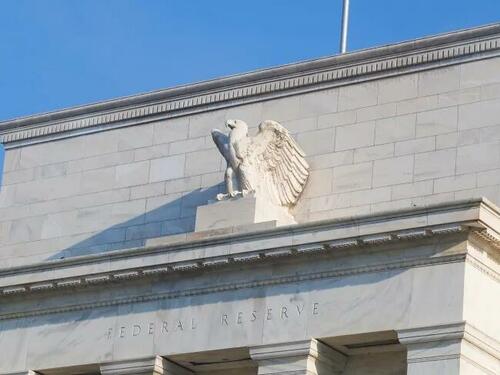
The title reflects another insight, paralleling as it does Albert Jay Nock’s Our Enemy, the State. Most of us were raised to believe government and its agencies serve our best interests. As libertarian scholarship has shown the truth is the exact opposite, particularly with government’s sleazy relationship with money and banking.
Admittedly, it’s a hard idea to accept since it involves a pernicious breach of trust, but Woods makes it abundantly clear. To our overlords we are easily-duped chattel.
Until Ron Paul decided to run for president and his End the Fed came along in 2009, the general public was mostly blind to the Fed’s existence. Austrians aside, the few who knew something about it — mostly university-trained economists on the take from the Fed — considered it a vital part of an advanced industrial economy. Yet the Fed had been around for 96 years when Dr. Paul’s book emerged. Given that it’s in charge of the money we use how did it remain in the shadows for tax-burdened citizens for nearly a century? What’s up with that?
The Federal Reserve Bank of St. Louis tells us the Fed’s congressional assignment is “to promote maximum employment and price stability.” (Bold in original) For these it talks about interest rates, and its aim is to increase the money supply so that prices rise gently at or around a 2 percent rate.
How gentle is a two percent rate? After 10 years of two percent monetary inflation, it would take $121.90 to buy what $100 bought in year one. But that’s over a decade, and you might not notice it unless you’re one of the hungry poor not on welfare. The Fed’s inflation of the money supply has been ongoing since it began operations in 1914, draining 96 percent of the dollar’s purchasing power.
On what planet is a 96 percent devaluation considered stability? Its real purpose is to inflate then assure us it makes good sense. Never mind the boom - bust cycle it creates along with the debauchery of our currency. We’re being gaslighted. Where did all the newly-created money go?
Dr. Paul, who had a long career in Congress whose confrontations with Fed Chairmen Alan Greenspan and Ben Bernanke have become legendary in libertarian circles, tells us:
Law permits this highly secretive, private bank to create credit at will and distribute it as it sees fit.
The chairman of the Federal Reserve can blatantly inject in a public hearing that he has no intention of revealing where the newly created credit goes and who benefits. When asked, he essentially answered, “It’s none of your business,” saying that it would be “counterproductive” to do so. [My italics]
The picture I get is of people in a hideout somewhere — in this case, the FOMC meeting in the Eccles building in Washington, D.C. — cranking out money then injecting it into the economy in some mysterious manner, while telling us in Keynesian doublespeak their operations keep us safe and prosperous.
Is it really hard to fathom that those in charge might be up to no good?
Woods comes out swinging
After defining the Federal Reserve System — the Fed — as the American central bank enjoying “a government-granted monopoly on the creation of legal-tender money,” Woods proceeds to evaluate the Fed from a broad or macro perspective.
What exactly did the Fed fix? Christina Romer who served under Obama as Chair of his Council of Economic Advisors found that “recessions were in fact not more frequent in the pre-Fed than the post-Fed period.” Even comparing the periods of 1796-1915 to post-WW II — thus omitting the Great Depression of 1930-1945 — “economist Joseph Davis finds no appreciable difference between the length and duration of recessions as compared to the period of the Fed.”
Woods takes us back through American history to see how banking and credit developed. Government, which has no money of its own, befriends ones that have it. During the period between the expiration of the first Bank of the US and the creation of the Second Bank of the US — 1811-1817 — the government granted banks the privilege of expanding credit unsecured by deposits while allowing them to tell depositors attempting to withdraw their money to “come back in a couple of years.” While banks could be charged with legal counterfeiting and embezzlement, Woods does not use the terms. In fact, nowhere in the book does he use the words “counterfeit” or “embezzle.”
When the Second Bank of the US started inflating in 1817 it created the Panic of 1819. He writes:
The lesson of that sorry episode — namely, that the economy gets taken on a wild and unhealthy ride when the money supply is dramatically and artificially increased and then suddenly reduced — was so obvious that even the political class managed to figure it out.
Many inflationists before the panic became hard-money believers after. Condy Raguet and Daniel Raymond, a disciple of Alexander Hamilton, became hard-money advocates and wrote books on economics. John Quincy Adams cited the hard-money Bank of Amsterdam “as a a model to emulate.”
But the inflationists persisted and pushed for more government intervention, and Unit banking in particular:
In the nineteenth century, nearly all American states instituted a regulation known as unit banking, which limited all banks to a single office. No branch banking was allowed, whether intrastate or interstate. The obvious result was a very fragile and undiversified banking system in which banks could be brought to ruin if local conditions turned sour.
Fractional-reserve banking is a major cause of bank panics. But the US went further. Other countries did not “cripple their banking systems” with unit banking laws. Canada, in particular, had no unit banking laws and no banking panics. The Bank of Canada did not emerge until 1934:
As Milton Friedman was fond of pointing out, although the Great Depression claimed over 9,000 American banks, the number of banks that failed in Canada at that time was zero. American bank panics, it turns out, were in large part the result of government intervention — in the form of unit banking — in the first place.
Yet it was the market and the imposed pseudo-gold standard that took the blame, and Americans got Hoover’s meddling then FDR’s New Deal.
Later in the book Woods mentions the hands-off approach to the depression of 1920-1921, “which saw unemployment shoot up to 12.4 percent and production decline by 17 percent. Wholesale prices fell by 56 percent.” And the Fed kept its printing press quiet. According to the National Bureau of Economic Research the depression was over by the summer of 1921.
Falling prices are bad?
One of the strongest parts of Woods’ book is his treatment of deflation — falling prices. It is only in the inflationary world of larcenous economics that falling prices are the “It” to be avoided.
A few of the points he makes:
-
Increasing the money supply to support increased production is a fallacy. “Any supply of money can facilitate any number of transactions.”
-
The money supply under a hard money system grows “relatively slowly, and the supply of other goods and services increases more rapidly. With these goods and services more abundant with respect to money, their prices fall.”
-
The claim that people would stop buying things if they knew prices would fall ignores the fact that people “value goods in the present more highly than they do the same goods in the future. This factor offsets the desire to wait indefinitely for a lower price.”
-
If deflation is anticipated entrepreneurs and the firms they deal with would adjust their bids accordingly.
-
With the increase in money’s purchasing power people could save simply by hoarding.
-
Who’s hurt the most by deflation? The power centers in society — government and Wall Street. We hear hysteria over deflation because it hurts the establishment the most, “and only the mildest concern about inflation, which hurts everyone else.”
Conclusion
Tom Woods has published another gem and is giving it away. The war we’re fighting now depends for its outcome on sound information and, as always, personal integrity. Never forget, the Fed must go. His book provides much of the intellectual ammunition needed to neutralize the enemy and avoid repeating the mistakes that brought us this mess in the first place.
|
[Markets]
Is Dune A Copy Of Our Real World
Is Dune A Copy Of Our Real World
By Michael Every of Rabobank
The Golden Path
USD/JPY is at 155, a fresh 34-year high, with the Yen slumping 10.2% year-to-date and suggestion that intervention may not come until we get to 160, a level last seen in 1986. USD/CAD is off recent lows at 1.37 but under pressure (as noted by Christian Lawrence): some suggest the Loonie could fall as far as 2 (so CAD/USD at 0.5) a decade from now. So, a higher US dollar. Which FX dominoes haven’t fallen yet, and when might they?
Australian CPI data suggest it will be hard to cut rates in 2024, as the median Sydney house price moves up to A$1.6m with them at 4.35%. Mexican CPI surprised to the upside, also suggesting further rate cuts may not roll out as had been priced in. Bank Indonesia shocked markets with a 25bp rate hike to 6.25% to try to relieve downwards pressure on IDR. So, what looks like higher rates for longer than had been expected. What breaks where, and when?
Geopolitical tensions will also be higher for longer. Europe made a dawn raid on a Chinese firm as Politico says: ‘EU to China: Open your public markets or we’ll close ours’. US Secretary of State Blinken is in Beijing against headlines warning of US sanctions on Chinese banks for helping Russia. President Biden signed the TikTok divest-or-ban bill, which Bloomberg warns will see China target US firms in kind. US military aid is already flowing to Taiwan, Ukraine, and Israel: the US is planning to convert old Pacific oil platforms to military bases; Ukraine was striking Russian energy targets even before it got access to new, longer-range US missiles; and Israel is closer to moving against Hamas in Rafah and Hezbollah in Lebanon, if not Iran (for now). The New Statesman echoes warnings made here since the mid-2010s: ‘The age of danger: order is breaking down as the great powers take sides in multiple wars’.
Economic policy also continues to get more populist: although it has no chance of happening, President Biden has proposed a 44.6% capital gains tax, the highest in US history, and a 25% tax on unrealized gains by high net-worth individuals. More realistic, perhaps, France’s opposition has proposed financing the country’s green transition with entirely with QE.
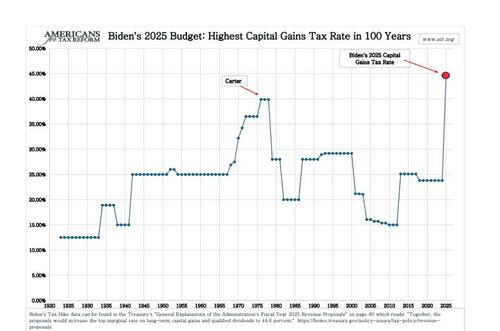
Let’s be frank, it’s hard to see a ‘Golden Path’ for markets ahead. It’s even harder to see ‘The Golden Path’ - a global economic system that allows maximum market/personal freedoms, yet with minimal inequality both domestically and internationally, and so socioeconomic and geopolitical stability. Yet absent that Path, we end up Hamiltonianism or mercantilism, economic war, real war, and a Great-Power-struggle ‘age of danger’.

Bloomberg just made reference to this (‘Geostrategy Industrial Complex Is a Win-Win’) vis-à-vis the real economy, noting corporate and foreign policy elites are talking more to each other, “which is good for both sides”. Yet financial markets continue to ignore foreign policy elites! Where are the macro forecasts adjusted for a world of Great Power struggles? Most still look remarkably similar to ones without that backdrop. (By contrast, note our ‘geopolitical’ work on Europe’s growth and inflation.) Where are the FX, rates, equity, credit, commodity, and property scenarios for a world of Great Power struggles? Again, most still look remarkably similar to ones without that backdrop – correct me if I am wrong, but it seems only our Fed watcher Philip Marey is predicting Trump tariffs would be a roadblock to ongoing Fed cuts in 2025.
Let’s be Frank Herbert.
Bloomberg also praises Hollywood’s ‘Dune 2’ for predicting the future better than Fukuyama for its old-and-new high-tech, feuding Great Houses struggling for control of the Spice without which the economy can’t function, as religion sweeps people to violent jihad. That comparison is true, but there is a deeper parallel to our present situation. Those who have read the Dune series repeatedly know all that backdrop supports two central overarching themes:
-
First: “Don’t follow charismatic leaders.” Paul Atreides is no hero: he is directly responsible for the deaths of 61 billion people.
-
Second: “The Golden Path.” Paul doesn’t have the stomach to follow through on what he needs to do for mankind, but his son, Leto II, does. **SPOILER ALERT** He fuses himself with a sandworm to become a dictator for 3,500 years, destroying Spice, space travel, and the economy, to teach people “a lesson they will remember in their bones”: that once they can break free of his reign, which he eventually allows, they should become as diverse and far-flung as possible to never allow anyone or anything to threaten them in their entirety again.
The conflict between humanity's stated desire for peace and their actual need for volatility is the central message of the Dune series.
We built a centralised neoliberal global system that repressed volatility as QE Spice flowed. But while Great Houses thrived, and some got very rich selling shadow-bank Spice derivatives, that system only increased, not decreased, our fundamental vulnerabilities to key threats. Returning to a world of Great Power struggles may ironically create healthier economic systems and societies over time, in some respects.
True, that likely won’t allow such free markets. But while we need some volatility to get stronger --think of Taleb’s anti-fragility-- we don’t need other kinds, like a sandworm swallowing us whole (or the financial market equivalent as past vol-repression has to be unwound), or people launching jihads at home or abroad. Which there is rather too much of right now.
So, Trump fusing with a sandworm may teach us all a geopolitical lesson “in our bones”: does his orange skin reflect excess McMelange consumption even if his eyes aren’t blue-in-blue?
Back to markets: the God Emperor of Dune, Leto II, maintains a complete monopoly on melange, the real currency in the universe; but apart from that, the books don’t say much about rates or FX. I’m just not sure what the Golden Level of rates is on our Golden Path. Then again, neither do central banks. And financial markets mostly have their heads deep in the sand.
|
|
[21d9c609-5cd6-58ad-a120-dfb83c1e42f3]
Arizona House lawmakers pass bill to repeal 1864 abortion ban
Arizona House Democrats on Wednesday passed a bill to repeal a near-total abortion ban from 1864 on the books in the state.
Published:4/24/2024 3:18:00 PM
|
|
[biographies]
The Best New Biographies and Memoirs to Read in 2024
These are stories of trauma and recovery, art as politics and politics as art, and lessons spread across books that will make you rethink your own life.
Published:4/24/2024 10:28:13 AM
|
|
[Entertainment]
Washington Post hardcover bestsellers
A snapshot of popular books.
Published:4/24/2024 7:12:04 AM
|
[Markets]
The Regime That Doesn't Care
The Regime That Doesn't Care
Authored by Jeffrey Tucker via The Epoch Times,
We’ve all come across warnings against doom scrolling.
This is the practice of waking up in the morning, scouring headlines, seizing on the bad news, and dwelling on the darkness. You do this during downtimes in the day and in the evening. Your mood worsens, permanently.
It cannot be good for the human spirit.
The term implies that we are somehow looking for doom because it gives us a dopamine rush or something. Testing this idea, I’ve variously tried to avoid doing that. But there is a problem. It is impossible to avoid simply because the bad news is so ubiquitous. In fact, I’ve come to distrust any venues that are not reporting it!
Many people have concluded that if we are looking for something other than doom, we should leave what we called “the news” entirely and focus on culture, religion, philosophy, history, art, poetry, or find something practical and productive to do.
I recently met a wonderful Mennonite family living in Amish country in Pennsylvania. They live a completely unplugged life: no cell phones, no internet, no TV. There are only books, community worship, farming, tending to livestock, shopping at local stores, and visiting with neighbors.
I never could have imagined that there would come a time when I would say to those who have completely seceded from modern life: you might be doing it the right way. There is something truly brilliant about the choices you have made.

Sure, they have created a bubble for themselves, one of their own choosing as an extension of their understanding of their faith tradition. One point I observed: they surely seemed happy. Not in a fake way that we see on social media but authentically happy.
Once you leave that world and dip back into normal life, it’s just undeniable. The headlines are filled with tragedy at home and abroad, much of it an outgrowth of population despair. The list is familiar: learning loss, substance addiction, suicide ideation, public and private violence, massive and well-earned distrust of everything and everyone, raging conflict at all levels of society.
It’s hard consolation that so many predicted this outcome of the pandemic response. We knew from the empirical literature that unemployment is associated with suicide, that isolation is connected with personal despair, that loss of community leads to psychopathology, that dependency on substances produces ill health.
So many warned of this outcome from what governments did. In many ways, the world before lockdowns seemed fixable. Afterwards, too much is broken and ruined to imagine redemption.
A good example for me is mainstream corporate media. There was a time when I could listen to NPR or read the New York Times (NYT) and disagree but think: well, that’s a perspective I reject but still I benefit from knowing it. It seemed like we were all part of the same national conversation.
This is no longer true. What made the difference? Probably the realization that they are not just confused or pushing some biased outlook but rather actively covering up and lying. Realizing that is incredibly disorienting.
There is something about pretending that the lockdowns and all that followed were completely normal that discredits them. They do it constantly. Sometimes the media will report on learning loss or the suicide epidemic or rising ill health in the population. But there seems to be this studious attempt to pretend that no one knows why it is happening.
Or my least favorite tactic: pretending as if the pandemic necessitated all this and that it was not an outgrowth of deliberate decision-making on the part of elites.
This stuff makes me want to scream: they locked us down when it was totally unnecessary!
As my friend Aaron Kheriaty often observes, they believe we are stupid. They actually think we cannot make connections, have no memory, no knowledge of anything serious, and will just eat up their porridge of baloney daily while exercising no critical intelligence over any of it.
This rubs me wrong particularly on the subject of the mRNA shots designed to address the virus. We know for certain that they were oversold and failed in all the ways they were supposed to succeed. We are further flooded with evidence of their harms both from personal experience and the scientific literature.
But do we read or hear about this in the legacy media? Absolutely not. Even when it is overwhelmingly clear that the shot should be considered a possible cause in the sudden rise of heart attacks, sudden death, turbo cancers, and maladies of all sorts, this whole subject is somehow unsayable in the corporate media.
The silence on this topic is so conspicuous and apparent that it discredits everything else. And what is the reason for it? Well, pharma advertising provides a stunning 75 percent of revenue for mainline television. That’s an astounding number. The networks are simply not going to bite the hand that feeds them.
That’s true for TV and probably something similar applies to everything else too.
What does this mean for the rest of us? It means that every time we turn on the TV, we are risking getting propagandized by companies that are seriously in league with the government to generate the highest possible revenue stream for themselves regardless of the consequences.
And why zero focus on vaccine injury? Incredibly, the companies themselves are indemnified against liability for any harms they cause. Just think about the implications of this. Even if you know for sure that you have been harmed by a product you were forced or otherwise manipulated to take, there is almost nothing you can do about it.
That’s an incredible fact, and goes a very long way toward explaining the silent treatment.
The discrediting of major media in this context reveals a deeper and more terrifying truth. Much of the elite class of economic and social managers do not have our best interests in mind. Once you realize this, the color of the world changes for you. Once you gain that insight, there is pretty much no going back from it.
Millions have come to this realization over the last four years. It has changed us as people. We desperately want to live normal happy lives but we are overwhelmed by what we’ve learned. It’s like the curtain was pulled back and we have seen what is really going on. The whole of official culture is screaming at us to ignore that man behind the curtain.
I’ve recently taken my own advice and thrown myself into reading history as a refuge. My choice was probably not the best if my goal was to brighten my spirits. I have been reading “The Vampire Economy” by German economist and financier Gunter Reimann, published in 1939 (and which I scanned and uploaded with the author’s permission).
The book was written as the Nazi Party had gained full control of government (and everything else) and the full war in Europe was about to commence with the German invasion of Poland.
Reimann brilliantly dissects the reality of a regime that cared nothing for the spreading suffering of the people.
“Nazi leaders in Germany do not fear possible national economic ruin in wartime,” he writes.
“They feel that, whatever happens, they will remain on top, that the worse matters become, the more dependent on them will be the propertied classes. And if the worst comes to the worst, they are prepared to sacrifice all other interests to maintain their hold on the State. If they themselves must go, they are ready to pull the temple down with them.”
That’s a bracing analysis and it could apply to many regimes in history, not just the Nazis. Indeed, good government in history has rarely been the norm. Power often benefits from suffering. As Americans we are not used to thinking this way about our elites. But it is probably time to realize that this trajectory is very much in play.
This might be the most striking change among millions of Americans over the last five or so years. We’ve come to realize that our leaders in so many sectors of American life (or global life, for that matter) do not favor our best interests. This is a troubling realization but it explains so much. It’s why the elites did not care about the harms of lockdowns or untested shots and are unconcerned about inflation, mass immigration, the rise of crime, squatting and the insecurity of property, exploding government debt, growing population surveillance, or anything like the normal rules of civilized life.
The regime, in the broadest possible way we can conceive of that term, simply doesn’t care. Even worse, it grows and benefits at our expense. They know it. We know it. They like it this way.
|
[Markets]
N.Y. Gives Trump The Anne Boleyn Treatment
N.Y. Gives Trump The Anne Boleyn Treatment
Authored by Richard Porter via RealClear Politics,
Jury selection is underway now complete in the case of The People of the State of New York vs. Donald J. Trump, which alleges that the defendant lied to his own check register, and lied to the general ledger of his own company, when the invoice given to him by his lawyer was paid and recorded by someone else, and that the misstatement he made to himself in his own records was done “with the intent to defraud and intent to commit another crime and aid and conceal the commission thereof.”

It is often noted that this is the first time that a former U.S. president is being tried for a crime, although Ulysses S. Grant may (or may not) have been cited for speeding in his carriage. The federal government chose not to prosecute Bill Clinton, who lied under oath during a sexual harassment lawsuit and then dissembled again about sex before a grand jury. Clinton lost his law license, settled the case on unfavorable terms, and was sanctioned by both federal and Arkansas state courts.
So, this is a first. And let’s be honest about who is doing what to whom and why.
The prosecutor elected in New York County of New York state indicted Trump, after Trump announced his 2024 run for president, for allegedly violating New York Penal Laws 175.05 and 175.10 seven years ago.
That local prosecutor, Alvin Bragg, is a member of the Democratic Party – and the voters who elected Bragg and from whom the jury will be chosen support the Democratic Party. In 2016, the people of New York County voted 87% for Hillary Clinton and 10% for Donald Trump, and in 2020, 87% for Joe Biden and 12% for Donald Trump. In other words, the jury pool is chosen from one of the most partisan jurisdictions in the country – a place where almost all the judges are Democrats as well.
So the Democratic prosecutor elected in the second most Democratic county in the United States will try the former Republican president and current putative Republican Party presidential nominee before a Democrat-appointed judge and a jury drawn from a pool 87% of whom voted against him (and who are being asked if they watch Fox News or listen to talk radio in the screening process).
One wonders if the law even matters. But let’s review the two statutes at issue to highlight what the law requires the prosecution to prove. First, the prosecutor must prove that Trump violated the relevant statute, which requires a finding that he falsified business records with intent to defraud – that he “makes or causes a false entry in the business records of an enterprise.”
By the way, falsifying business records in the second degree is a misdemeanor, not a felony. Moreover, New York’s statute of limitations requires that misdemeanor prosecutions be commenced within two years of the commission of the act, meaning that under the last provision, this case should never have been filed.
Bragg elevated this misdemeanor into a felony by including New York Penal Law 175.10 in the indictment – falsifying business records in the first degree. That statute reads this way:
“A person is guilty of falsifying business records in the first degree when he commits the crime of falsifying business records in the second degree, and when his intent to defraud includes an intent to commit another crime or to aid or conceal the commission thereof.”
There are other obvious difficulties with this case beyond the credibility of the witnesses (a porn star who denied any affair numerous times and a disbarred lawyer convicted of perjury).
For example, why does the entry in the check register or the general ledger matter at all? When would those entries, as opposed to the allegedly false invoices, be shown to anyone for any nefarious purpose? And were the entries even false? Was there any intent to fool someone to obtain something in making the entries – who was the target of the allegedly false entry in private books and records? If there’s no mark, no victim, then how could there be an “intent to defraud”? Defraud whom? And what is the other crime that the person making the book entry intended to commit or hide? If the other crime is not a New York crime but a federal crime, does every county prosecutor in the United States, including Alvin Bragg, have the jurisdiction to enforce an alleged federal crime indirectly through a state crime?
We shall see.
The political nature of this trial is obvious, and unprecedented in the United States. Even with irrefutable DNA evidence that Bill Clinton committed perjury, the special prosecutor declined to press criminal charges against him. In America’s recent past, prosecutors tended to exhibit a modicum of restraint. Those days are apparently gone.
I reviewed an interesting law review article of political show trials down through history, from the trial of Socrates in Athens to the famous show trials in the 1930s Stalinist Soviet Union, curious to see if I could find historical precedent for this trial.
The closest precedent is probably Anne Boleyn’s trial for adultery in 1536. It was about sex, the trial was in a hostile jurisdiction controlled by her accuser, and the whole point of the exercise was to lop off the head of someone who stood in the way of the regime’s continuity. But that’s what Democrats have lusted for since Donald Trump first arrived on the scene, isn’t it? They made no secret of it.
Richard Porter is a lawyer in Chicago and National Committeeman to the RNC from Illinois.
|
|
[Entertainment]
Washington Post paperback bestsellers
A snapshot of popular books.
Published:4/17/2024 8:27:32 AM
|
[Markets]
House Managers To Deliver Mayorkas Impeachment Articles To Senate
House Managers To Deliver Mayorkas Impeachment Articles To Senate
Authored by Mark Tapscott via The Epoch Times (emphasis ours),
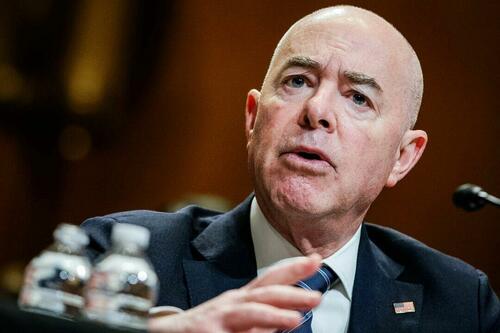 U.S. Secretary of Homeland Security Alejandro Mayorkas at the U.S. Capitol, on April 10, 2024. (Samuel Corum/Getty Images) U.S. Secretary of Homeland Security Alejandro Mayorkas at the U.S. Capitol, on April 10, 2024. (Samuel Corum/Getty Images)
Two counts of impeachment against Secretary of Homeland Security Alejandro Mayorkas, approved on Feb. 13 by the House of Representatives, are to be formally presented to the U.S. Senate today.
Eleven House members previously named as impeachment managers will walk from the lower chamber through Statuary Hall in the Capitol and then to the Senate in a brief ceremony that has been repeated only 17 times since the first Congress in 1789. House Democrats did so twice after impeaching former President Donald Trump in 2020 and 2021.
Eight of the 17 Senate impeachment trials resulted in convictions, while nine ended without convictions. A two-thirds majority of the Senate is required to convict an impeached officer of the federal government. Neither former President Donald Trump, former President Bill Clinton in 1998, nor President Andrew Johnson in 1868 were convicted.
Senate rules require the House managers to read the two counts in the Senate chamber. Then Senate Senate President Pro Tempore Patty Murray (D-Wash.) will swear the senators in as jurors. A written summons will be issued to Mr. Mayorkas for him to appear, which he may or may not choose to heed.
The senators will then have an opportunity to adopt rules governing how the trial will be conducted. The rules adopted by the Senate in 1986 were in place for the Clinton and Trump trials.
Senate Majority Leader Chuck Schumer (D-N.Y.) is expected to enter a motion either to dismiss or table the two impeachment counts against Mr. Mayorkas. Earlier this year, Mr. Schumer described the House impeachment action as a “sham.”
With public anger over the more than 8 million illegal immigrants allowed to enter the country under President Joe Biden, Mr. Schumer is determined to avoid a public trial during which the House managers can be expected to present evidence demonstrating Mr. Mayorkas acted at the direction of the chief executive.
Senate Republicans, led by senators Ted Cruz of Texas, Mike Lee of Utah, John Kennedy of Louisiana, Ron Johnson of Wisconsin, Eric Schmitt of Missouri, and Roger Marshall of Kansas will attempt to bring multiple points of order against Mr. Schumer’s motion.
If any one of the GOP points of order is approved by a simple majority of the Senate, the motion will be defeated and the trial will commence. But Ms. Murray is not obligated under Senate rules to recognize any of the senators offering points of order, so none of their objections may be heard on the Senate floor.
Should the Senate trial go forward, the House managers will present their evidence, and defenders of Mr. Mayorkas from among the Senate Democratic majority will respond. At some point thereafter, a rollcall vote will be taken, which is expected to fail to reach the required two-thirds for conviction.
At that point, Mr. Mayorkas will be able to continue performing his duties but he will go into the history books as only the second presidential cabinet member to be impeached.
The first was Secretary of War William W. Belknap, who resigned in 1876 after the House passed five counts of impeachment against him. The Senate failed to convict Mr. Belknap, who was appointed by President Ulysses S. Grant.
Article I of the measure accuses Mr. Mayorkas of a “willful and systemic refusal to comply with the law” and claims that “in large part because of his unlawful conduct, millions of aliens have illegally entered the United States on an annual basis with many unlawfully remaining in the United States.”
“His refusal to obey the law is not only an offense against the separation of powers in the Constitution of the United States, it also threatens our national security and has had a dire impact on communities across the country,” it reads.
Article II accuses Mr. Mayorkas of breaching the public’s trust by having “knowingly made false statements, and knowingly obstructed lawful oversight of the Department of Homeland Security, principally to obfuscate the results of his willful and systemic refusal to comply with the law.”
 Senate Majority Leader Chuck Schumer (D-N.Y.) speaks to the press after the Democratic Party's weekly luncheon at the U.S. Capitol, on March 6, 2024. (Mandel Ngan/AFP via Getty Images) Senate Majority Leader Chuck Schumer (D-N.Y.) speaks to the press after the Democratic Party's weekly luncheon at the U.S. Capitol, on March 6, 2024. (Mandel Ngan/AFP via Getty Images)
The 20-page impeachment resolution contains two articles with multiple examples of laws Mr. Mayorkas is alleged to have ignored or refused to enforce and illustrations of his blocking congressional oversight, including not producing requested copies of documents.
 Democratic House impeachment managers, led by Rep. Jamie Raskin (D-Md.), walk out of the Senate Chamber in the Capitol, on Feb. 13, 2021. (J. Scott Applewhite/AP Photo) Democratic House impeachment managers, led by Rep. Jamie Raskin (D-Md.), walk out of the Senate Chamber in the Capitol, on Feb. 13, 2021. (J. Scott Applewhite/AP Photo)
The House managers, all Republicans, include Mr. Green, House Foreign Affairs Committee chairman Reps. Mike McCaul of Texas, Andy Biggs of Arizona, Clay Higgins of Louisiana, Ben Cline of Virginia, Michael Guest of Mississippi, Andrew Garbarino of New York, August Pfluger of Texas, Harriet Hageman of Wyoming, Marjorie Taylor Greene of Georgia, and Laurel Lee of Florida.
|
|
[Markets]
UnitedHealth swings to a loss but stock surges after adjusted profit beats views
Health insurer books a near $700 million hit from Change Healthcare hack during the quarter, sees more costs coming
Published:4/16/2024 6:54:26 AM
|
|
[]
You're Not Going to Believe How Much Biden's Student Loan Bribe Will Cost Taxpayers
Published:4/13/2024 10:54:16 AM
|
|
[World]
With French under fire, Mali uses AI to bring local language to students
As the popularity of French wanes, RobotsMali is using AI to create books in Bambara.
Published:4/13/2024 1:08:04 AM
|
[Markets]
The Political Left Has Proven Beyond A Doubt That They Are Authoritarians
The Political Left Has Proven Beyond A Doubt That They Are Authoritarians
Authored by Brandon Smith via Alt-Market.us,
Nearly 20 years ago when I started my work in the independent media the common mantra among my peers was noting the existence of the “false left/right paradigm” – The idea that Democrats and Republicans were essentially the same and were working towards the same exact authoritarian goals. This was before the Ron Paul movement and the libertarian/patriot shift within conservative circles when Neocons (fake conservatives) dominated all Republican discourse.

In the 16 years since there has been some interesting developments at the state level, with a return to true conservative and constitutional principles. Conservative ideals were on the verge of death in the early 2000s, but thanks to Ron Paul and others there has been a resurgence. The false left/right paradigm still applies in many ways and we have to remain vigilant, but the most blatant RINO frauds are quickly losing favor.
Nihilists (and paid federal provocateurs) will constantly claim we aren’t making any progress, but consider this: Decades ago conservatives used to clamor to defend people like John McCain, Lindsay Graham or Mitt Romney, now they despise such fakes (McCain was hated by most conservatives well before he died). Times are changing; this is a fact, and we need to acknowledge the positive move forward.
This is not to say that Americans should rely on politics to fix our national problems, but it would be a lie to claim that there are no political representatives on our side. A common argument against right leaning movements is that conservative ideals are “poorly defined” and that we “don’t stand for anything.” This is simply not true. In fact, it’s leftists that are constantly changing their positions like they have schizophrenia. Conservatives have been far more consistent in comparison.
The guidelines are relatively easy to understand – Conservatives and liberty activists support a return to constitutional governance, the protection of the Bill of Rights, free markets, meritocracy, the right to choose associations, truth in media, secure borders, the protection of children from exploitation, keeping America out of foreign entanglements, moral and accountable leadership, etc. The degree to which leaders can adhere to these parameters determines how much trust they earn, and trust is the only currency that matters these days.
Do we disagree on certain nuances of these issues? Of course. We aren’t like leftists following a central hive mind, always afraid of being canceled by the mob; we argue. That’s not necessarily a bad thing as long as we unify on basic tenets and principles.
Democrats (and leftists in general) on the other hand have gone in the complete opposite direction. If there was ever a time when the average leftist and conservative could find common ground, that time was LONG gone. Many leftists used to be pro-individual rights; today they argue incessantly against personal liberty as if it’s dangerous to society. They used to be anti-war; now they froth at the mouth over countries like Russia and press for WWIII without any rational thought. Their methods have become violent, vicious, egregious in execution as they adopt an “ends justify the means” approach.
The political left does not care about what is right. They do not care about what is true. They only care about “winning.”
It is this leftist infatuation with the dark side that is driving the US to the edge of civil war. Would a candidate like Trump be taken as seriously under normal political conditions? It’s hard to say – He wasn’t taken very seriously in 2012. However, when Democrats started to go full bore authoritarian suddenly Trump became very appealing to conservative voters.
Why? Because he represents a big middle finger to the communists, a bull in the china shop. If you want to piss off authoritarian Democrats trying to control what you say and what you think, you put Trump in their faces for another 4 years. Does this fix our underlying national problems? No, not in the slightest. In fact, I still believe Trump distracts patriots from what really needs to be done. I’m convinced that, at this stage, only war will resolve the issue. Voting for Trump is a good way to enrage the woke cry-bullies, and I wouldn’t fault anyone for wanting that, but any real return to honor and order would have to be implemented by the public, not the government.
The deeper problem is one of unavoidable cultural division – Conservatives and patriots cannot live side-by-side with rabid leftists, nor can we accept a leftist controlled government. They have proven beyond a shadow of a doubt that they intend to destroy every aspect of western culture and institute a regime of oppression.
So much has happened recently that I fear many Americans will become overwhelmed and forget the recent trespasses of leftists. In case you had any doubts at all or know people that still defend them, here are just a handful of examples of the worst authoritarian crimes committed by Democrats in the past four years alone…
Weaponizing The Legal System Using Selective Prosecution
When Democrats talk about “equity” in criminal justice, what they are referring to is the unbalanced application of law depending on the ethnicity or political beliefs of the people being charged. The most blatant example being the kangaroo court for the Jan 6th event and their attempt to lock up conservative protesters as “insurrectionists.”
Not a single death occurred due to protesters, property damage was minimal and capitol police INCITED the riot by firing rubber bullets and CS gas into the otherwise peaceful crowd. Yet, the protesters were painted by Dems and the media as monsters trying to “destroy democracy.”
Compare this to the Democrat response to the BLM and Antifa riots across the US since 2016 in which dozens were killed, thousands of police injured, billions in property damage and multiple government buildings attacked. These people tried to hold the country hostage, yet, the vast majority of those that were actually arrested were released and never charged by Democrat District Attorneys and prosecutors. The media even portrayed them as heroes.
If Jan 6th had been a far-left protest, there would have been no commission and no one would be in jail for 10-20 years today. There are numerous examples of selective prosecution targeting patriots and the message is clear – “If you defy us in any way, we have no problem misusing the legal system to crush you.”
Pandemic Hysteria And Medical Tyranny
Did some Republicans initially support the covid lockdowns? Yes. When it became clear that covid was a non-threat did they end the lockdowns in their own states? Yes, surprisingly most of them did.
Half the states in the US (all red states) blocked attempts to continue the pandemic lockdowns. These same states also passed legislation to disrupt any future attempts at lockdowns or vaccine passports. And, all the governors and legislators involved were accused by Democrats and the media of “killing Americans” because of their defense of freedom.
In reality, these states along with conservatives across the country defeated a draconian agenda that almost brought the US to the brink of full spectrum medical tyranny. Democrats and globalists tried to use covid as an opportunity to institute sweeping anti-liberty mandates without checks and balances. Some of rules they wanted to put in place included:
-
Forced vaccination.
-
No employment for the unvaccinated.
-
No access to public spaces for the unvaccinated.
-
No access to normal medical treatment for the unvaccinated.
-
House arrest for the unvaccinated.
-
Fines for the unvaccinated.
-
Jail time for people speaking against the mandates or vaccines.
-
Government tracking of the unvaccinated.
-
Taking children away from the unvaccinated.
-
Secret vaccination of children at public schools without knowledge of parents.
-
Mass online censorship of anyone presenting information contrary to the government narrative.
Some Democrats including Biden even threatened to go “door-to-door” to vaccinate individuals, though the official position was that they would instead seek to “make life so hard” for the unvaxxed that anyone in refusal would eventually be forced to comply. Luckily their plans failed. The CDC published a bunch of unverified stats claiming most Americans were vaccinated, no one took the boosters and the agenda fizzled into the background. That said, it’s important that we never forget what happened.
The true nature of the political left was exposed from 2020-2023, and the difference between conservatives and leftists was made undeniably clear – Red states were made free. Blue states tried to keep authoritarianism in place. Democrats embraced medical tyranny, conservatives did not. Conservatives left blue states (and blue cities) in droves because they were oppressive, red states gained millions of people and turned a deeper shade of red. This is reality.
Targeting Children For Indoctrination And Exploitation
There’s no surer sign of authoritarianism than a group that recruits children as foot soldiers using political indoctrination under the noses of parents. Democrats and the woke movement have taken the mask off completely when it comes to America’s youth.
The widespread used of woke symbols such a pride flags in public schools and libraries. The use of drag queen performances (often sexual) as a means to normalize baseless gender fluid theories, mental illness and sexual aberration. State government funding of sexualized content including graphic lessons and books for young kids. The list goes on and on.
I can’t think of anything more insidious and evil as the leftist attempt to hijack American children as a weapon for their political coup. And make no mistake, the woke movement is not a movement for equality, it’s a communist and collectivist insurgency. They see children as tools, not as people.
Democrats are going so far as to pass laws allowing children to engage in sex change procedures including hormone blockers and surgeries without parental consent. This is a monstrous policy that needs to be snuffed out immediately. Children are not capable of consent.
Again, all this is being done in the name of winning. What is moral or ethical never crosses their minds.
Mass Censorship And The Demonization Of “Radical Speech”
Who nominated the Democrats to become the arbiters of acceptable speech? Well, they nominated themselves, and the protections of the 1st Amendment are being quietly degraded every day we allow them to continue acting as if they are the thought police.
The new term being thrown around in 2024 is “radical speech”, meaning any speech that runs contrary to “diversity, equity and inclusion” requirements, or any speech that contradicts the preeminence of the official narrative. Understand that “radical speech” is an arbitrary label; one has to consider what the legitimate consequences are and what the intent is.
For a Democrat, any speech that is detrimental to their goal of extorting public support for their policies suddenly becomes “radical.” The label is designed to elicit images of terrorism and fascism, as if mere words are magical and can compel the public to do great evil without them realizing it. This is childish fantasy based on projection. It’s leftists (collectivists) that believe words have magical powers, and so they put great emphasis on controlling speech in general.
I would partially agree, only in the fact that lies do have power to evoke emotional responses, but the only way to combat lies is with the truth. Anyone who says that the best way to combat lies is to use mass censorship is a liar. Democrats lean heavily on mass censorship, as we have seen with nearly every Big Tech social media platform and corporate news platform in the past few years.
The bottom line is this – When someone tells you exactly who they are, believe them. When a group of people show through a host of actions that they are authoritarians, they should not be allowed anywhere near power. It’s time to rethink our ongoing political relationship here in America and consider whether or not we should continue to live with a political movement that has made it so abundantly clear that they are hostile to freedom.
* * *
If you would like to support the work that Alt-Market does while also receiving content on advanced tactics for defeating the globalist agenda, subscribe to our exclusive newsletter The Wild Bunch Dispatch. Learn more about it HERE.
|
|
[]
Librarian Encouraged Libraries to Have Books and You Won't Believe What Happened Next
Published:4/10/2024 4:27:24 PM
|
|
[]
Pathetic and Weak: Scrabble Introduces 'Less Competitive', 'More Inclusive' Version for Gen Z
Published:4/10/2024 4:04:26 PM
|
[Markets]
Treasury Debt - Pristine Collateral Or A Red Flag
Treasury Debt - Pristine Collateral Or A Red Flag
Via Charts and Parts Substack,
Intro
Spoiler alert: we have another red flag in the treasury market.
The latest talk is to eliminate treasury holdings from the SLR (Supplemental Liquidity Ratio) calculation, which is used to determine how much banks need to set-aside to help “manage risk”.

Seen This Show Before
The Covid crisis brought about market chaos. To manage the steep and fast decline, The Fed jumped into action and cut rates to zero and birthed QE infinity. They also eliminated the banks’ reserve requirements. The rule sounds just like it reads: banks no longer had to hold any reserves against deposit liabilities. We already know there is nothing more permanent than a temporary government program, so this reckless policy still exists today.
We’ll remind our readers that we try to over-simply to make a point. The system and web of rules are extremely complex, especially when it comes to the plumbing of the treasury market.
Another handout occurred last year when we witnessed more bank failures than the 2008 GFC (Great Financial Crisis). The big accommodative move to save the system was to allow banks to mark their (treasury) bond portfolio at “par” (100%), to avoid taking portfolio losses. This was timely and convenient, as the TLT (Treasury Bond ETF) lost roughly 30% in 2022. As a result of the 2022 bond market route (worst ever), the system is stuck with a pile of losses on the books.
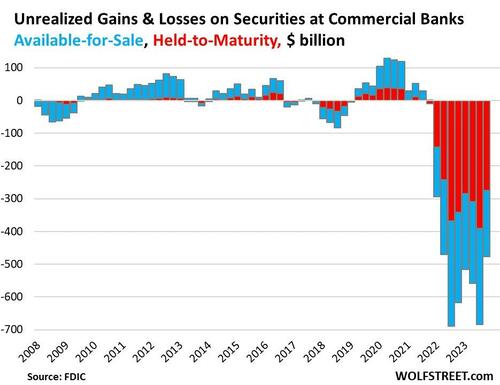
Liquidity vs. Transparency
All these rule changes are meant to help “liquify” the system, thus reduce the odds of a systematic shock of sorts. But these new rules come at the expense of transparency. We’re never quite sure who is holding what, thus we can lose track of where the land mines reside.
By allowing banks to not “mark-to-market” we lose transparency and more importantly, we lose more price discovery. Because the government buys their own bonds, long ago we lost price discovery of the most important price of all - interest rates: the price of “money”.
For 10-years we saw interest rates manipulated lower as debts and deficits soared ever higher. This meant that the US (and many other countries) were able to borrow at cheaper and cheaper rates, even as their debts and deficits were ballooning. We will reiterate a favorite C&P quote from a recent presentation, “This is an amazingly simple divergence (rates lower and debt higher) that defies every rule, concept, and bit of logic in financial markets.”
Third Times a Charm
The new SLR rule change could allow banks to be an endless buyer of treasury debt.
Through that lens, this rule makes a lot of sense. Especially as treasury issuance is testing the Covid highs even though the emergency is long gone.
Said another way, we supposedly have a strong economy, yet the Treasury is selling/issuing bonds at a rate last seen during the Covid crisis.
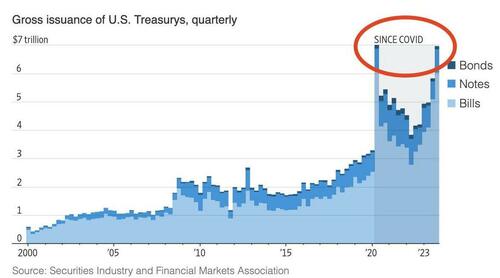
The Close
How convenient for the banks -- to be able to buy treasuries, take no haircut, and not have to worry about mark-to-market losses. All just in time, as issuances are taking on a life of their own.
It is also worth noting that our deeper dive into The Great Taking revealed that the bond market is also fractionalized (not enough to go around/some bonds held on the books by more than one owner).
It sounds like a risky proposition to keep calling our government bonds “pristine collateral”, “risk-free”, or a “safe-haven asset”.
|
[Markets]
Insurers Spy On Houses Via Aerial Imagery, Seeking Reasons To Cancel Coverage
Insurers Spy On Houses Via Aerial Imagery, Seeking Reasons To Cancel Coverage
Insurance companies across the country are using satellites, drones, manned airplanes and even high-altitude balloons to spy on properties they cover with homeowners policies -- and using the findings to drop customers, often without giving any opportunity to address alleged shortcomings.
“We’ve seen a dramatic increase across the country in reports from consumers who’ve been dropped by their insurers on the basis of an aerial image,” United Policyholders executive director Amy Bach tell the Wall Street Journal. Reasons can range from shoddy roofing to yard clutter and undeclared trampolines.
Much of this surveillance is done via the Geospatial Insurance Consortium, which boasts of its coverage of 99% of the US population.
 The Geospatial Insurance Consortium provides imagery insurers use to study roof condition and look for risky property attributes (via GIC) The Geospatial Insurance Consortium provides imagery insurers use to study roof condition and look for risky property attributes (via GIC)
In pitching its ability to provide high-resolution "imagery and insights" for property reviews, GIC says insurers can use the service to "review risk and exposure on a building such as proximity of vegetation to the structure, whether a roof needs updating, and verify the exact location for a policy."
“If your roof is 20 years old and one hailstorm is going to take it off, you should pay more than somebody with a brand new roof,” Allstate CEO Tom Willson told the Journal, unapologetically and ominously adding that, where the company's use of digital imagery is concerned, "there's even more to come."
Wilson framed aerial spying as a pricing issue, but many consumers are finding that companies are using it to suddenly drop their coverage altogether.
The Journal describes the experience of northern California resident Cindy Picos, who was dropped by CSAA Insurance last month, with the company saying aerial imagery revealed that her roof had aged beyond its life expectancy. She paid for an inspection of her own, which found the roof was good for another decade. CSAA wasn't impressed, and said its decision was final. The firm also refused to share its photos, though it now says it's changed that policy and will let customers see them -- if they ask.
Another Californian, CJ Sveen, was dropped by AAA Homeowners Insurance after their reconnaissance discovered "clutter" in his yard. An indignant Sveen told ABC7 that he uses his yard as a workshop "Apparently they have some pictures and they noticed clutter. I find that offensive. How dare you judge me because of my stuff!"
In AAA's defense, clutter isn't just about aesthetics. It could present a fire hazard, attract rodents that harm the structure, present a physical danger to visitors, and obstruct firefighters' ability to quickly contain a fire at the premises.
 Would you cover this house? CJ Sveen's homeowners policy was cancelled after aerial imagery captured clutter in his yard Would you cover this house? CJ Sveen's homeowners policy was cancelled after aerial imagery captured clutter in his yard
Another California couple had their policy torn up by AAA after overhead photography found their swimming pool had been drained. The aging pair said they emptied it because their grandchildren had grown up and they no longer used it. Empty pools are prone to cracking for lack of counter-pressure from water; they can also "float" up from the earth, creating hazardous conditions.
Former Michigan Farmers Insurance agent Nichole Brink told the Journal she quit the company last year over her concern that it was aggressively using aerial imagery to chase off customers, and even using shots that were two or three years old. "It’s like they’re using anything as an excuse to get people off their books,” she said. Farmers says it gives policyholders at least 60 days to challenge the company's findings or remedy shortcomings.
It's probably no coincidence that Californians are frequently targeted for non-renewal via overhead spy technology. Insurers are aggressively paring back their business in the state, as the state's thicket of regulations has blocked insurers' ability to adequately charge for coverage in a state cursed by wildfires and earthquakes.
Last year, for example, State Farm said it would no longer issue new homeowners policies in the Golden State. The, in March, the company took the more draconian step of opting not to renew 72,000 property and commercial apartment policies. AIG bailed on the state in 2022.
|
[Markets]
America Is Hurtling Toward A Full-Blown Hot Civil War
America Is Hurtling Toward A Full-Blown Hot Civil War
Authored by Justin Smith via The Burning Platform blog,
It never ceases to amaze me at how little so many people in this country have done to train their minds to critically analyze information. They have eyes to see and ears to see, and yet, somehow the truth of any major issue still seems to evade them, or they simply refuse to recognize the truth with it standing right in front of them, slapping them in the face.
So many things are currently plumb damned fouled up by this Biden regime and going awry on their own through the dynamics set in motion by this anti-American, lawless regime, that it’s nearly impossible to properly address them all in a single commentary. But I’ve tried to give the Reader as comprehensive an assessment as I possibly can with this piece.
Michael Savage, a longtime renown radio host, was fond of noting that “liberalism is a mental disorder” and we’re witnessing the result of its heavy utilization for far too many years without being grounded in common sense and a certain amount of pragmatic realism. And so here we are, on the cusp of the final fall of America, short of a miracle from God or true patriots taking a firm stand with rifles in hand and refusing to give an inch of ground and any further movement towards the new world order desired by our amerikkan commies.
It might sound quaint and out of touch with what some have now accepted as “the new normal”, but I say we should all wrap ourselves in the American Flag and send out the clarion call for a rush of strong, capable men to come to the aid of their country, in a manner as never before.
~ J.O.S.

“I may be crazy. But it’s no measure of health to be well-adjusted to a profoundly sick society.” ~ Ivor Browne, Professor Emeritus of Psychiatry at the University College Dublin [2017]
In an ideal and perfect world, all Americans would be following a righteously guided conscience and their better angels, and they could trust that their elected leaders were doing likewise; but, we live in a far from perfect world or society, and the fools of the country have abandoned Christian kindness, the Golden Rule and humanity for the evil of trans-humanism. Heartwarming words advocating for true freedom and liberty are far and few between in today’s society and political arenas, in a manner not too unlike the years between 1850 and 1860 that led to the Civil War; and tho’ some on both side of the political aisle still exude goodness in a way that makes each day seem a bit brighter, by and large, the Democratic Party has been completely infiltrated by Marxist-Maoist Communists, who are driving the nation towards the darkest tyranny and bloodiest days ever witnessed in America, as they attempt to stamp out the tenderness and beauty in each person’s soul and reduce us all to mere mindless cogs in their authoritarian machine.
Look around. Half or more of America’s citizenry have lost their minds and are six steps or more removed from reality, either due to the mind-numbing communist indoctrination they have absorbed from their “education” in the public school system, something genetic or a trauma from their life, some new maniacal drug that has them hooked and out of their minds, or a combination of all three.
Some would suggest that we set about immediately reforming public education to promote and defend the ideas that originally built America, but we don’t have time to change hearts and minds to counter a movement that started over a hundred years ago and now sits on the cusp of being able to solidify its current stranglehold on America, if the tide swings its way in the 2024 Election or they are able to steal the election through current fraud facilitating mechanisms. Although we can still move to properly educate the next generation in a newly reformed education system or through homeschool, now is the time to organize and assemble those within the country who already know and hold to the truth of American principles and all the freedom and liberty that follow — time to gather our like-minded American patriots and those Lions of Liberty who have had enough of witnessing this America we love so well so sorely abused, put upon and assaulted.
It doesn’t help when we have self-serving, corrupt people in high office promising to save the gullible and ill-informed from their hell and the misery it brings, if only they will support more madness to be placed in U.S. code. Vote for more economy killing “climate change” change regulations and initiatives and “we’ll put more money on your EBT cards, courtesy of Uncle Sam and the American taxpayer”. “Help us make sure the government has the final say over everybody’s children and can kill babies as they exit the birthing canal, and we’ll make certain you get privilege over all other Americans”, one can almost hear Traitor Joe whispering in some dimly lit concert hall. “You can be a champion among champions”, they say — “Let us help you change your gender”.
And if anyone stands in your way in the pursuit of any evil, it is they who will be called evil and fallen upon by the full weight of the U.S. Federal Government.
Oh yea. And as if that isn’t bad enough, Biden is now moving as fast as he can to forgive $144 billion more in student loans. He plans to announce this on Monday, April 8th 2024, and for anyone with eyes to see, this is simply corruption at its worst and Biden buying votes in the upcoming presidential election. What a slap in the face of Americans who couldn’t afford to go to college but now will be forced to bear the tax burden this move will bring.
I see the immorality growing every day, the people who revel in its evil, freaks from some futuristic sideshow that bodes ill and speaks to the destruction of humanity. and with each passing day, I find myself moving farther and farther away from those with whom I have little or nothing in common with, adrift from most of humanity too. Not in any manner that lends itself to any sadness over my situation, but rather as if to say “whew” in a realization of the relief that has come by way of my separation from those I despise most.
It’s sort of like I’m standing on the river bank watching the “ship of fools” sailing over the river falls in denial of their own mortality, thinking their crazy ideas will save them and hold them invincible, or worse, knowing they are going to die and not caring who they drag to Hell along with them. They think we’re crazy for defending America’s righteous and true founding principles and virtues and the liberty associated with them, and we think them mad for denying God, reality and the best mankind has to offer in exchange for an evil, unrestrained, immoral freedom that is no freedom at all, a bringer of Death.
Since 1965, the communists within the federal government, Congress and many state and local governments have essentially separated us and pitted us against one another as one aggrieved group or another, some special interest and through identity politics and racial hatred. They broke us into tribes and acted as if the represented each, all the while setting in place mechanisms that made us serfs to the government, The Leviathan, and reducing us all to poverty as they have gradually destroyed the bulk of the middle class in our country. The Constitution is so degraded and eroded now that any tyrant can impose his will by way of one flourish of a pen, which Traitor Joe has done through 118 executive orders, bypassing Congress and the U.S. Supreme Court.
We have a national debt that’s rapidly approaching $35 trillion and counting, that to be sure rests on the shoulders of both parties, but it couldn’t have arrived to this abysmal point without both Marxist-Maoists and RINOs accepting the tenets of the Marxist-Keynesian Modern Monetary Theory and the notion that any one nation could print and borrow an endless supply of money forever without any terrible consequence, which is currently being proven wrong. Our people struggle to pay for food and rent and new high mortgage rates have put home ownership out of reach for this new Generation Z that is coming up and expecting a successful way of life to be attainable in some form or fashion, even tho’ many of them are a great part of the problem, some thirty percent claiming to be either queer themselves or supportive of the LGBTQ sickness running rampant through American society, advocating for every known sexual perversion and deviancy one might care to mention.
Several decades ago, I realized every government in the world was using a Keynesian debt-based system, printing money as if there was no end to real assets or backing for it. Basically, the world had gone mad, as the greed of its so-called “leaders” knew no bounds, and the various governments of the world basically accepted the use of monopoly money. The charade is ongoing and the casino open, that is, ’til those at the very top decide to call in their markers and usher in the final forced phase of The Great Reset.
In 2008, as I watched the near total collapse of our economic system and heard George [Bush] say that we had to temporarily abandon the free market capitalist system in order to save it, I received a strong sense that America may have peaked and was as good as it was going to get from there on out. I had a feeling that things were only going to continue to decline, especially as one major corporation after the next receive a taxpayer funded bailout after being deemed “too big to fail”.
In unbelievable fashion, when the largest economic collapse in U.S. history hit in March 2020, to be followed by the Covid Lockdowns, pushed and kept going for years by traitors to America, such as Dr Anthony Fauci and Dr Deborah Birx, many of us saw it for the fraud it was. Still, whole swaths of our cultural freedoms and norms were very nearly destroyed, as a timid American people complied, by and large, because they couldn’t simply stand on their hind feet and tell the government despots “NO”. Even now, as many careers no longer exist and jobs are disappearing like cotton-candy on a rainy day, far too many, especially the communists among us, hold to the delusion that all is well and deny that out-of-control spending and massive national debt really do matter for the health of the nation’s economy.
Who could have possibly known at the time — other than those Deep State bad actors behind the curtain — that this was a dire harbinger of things to come and but one of the first precursors to a validation of this current system of economic fascism as the preeminent and defining feature of what everyone still mistakenly calls our “free market capitalist system”. Who knew that — if one believes Obama and now Biden — the cure for debt was more debt; the cure for greed was more greed, and that envy of the neighbors’ possessions was perfectly acceptable, even if one easily walked on over to take them by force, through armed robbery. And who could have foreseen that every Marxist-Maoist of the Democratic Party would become modern day Jezebels, condemning the innocent by way of one false accusation after another, paving the way for a vile new phenomena and way of life for the misguided youth of America.
But never in my wildest imagination did I expect to see every single government institution corrupted to its very core and heavily infiltrated by men and women seeking to destroy traditional America — to “transform America” — and bring great harm to all Americans in the process, as evil was called “good” and good was called “evil”, turning the world upside down as foretold in Isaiah 5:20, as we all witnessed in 2020, driven by the Democratic Party Communists and fascists and globalists of the country, for the most part. Never did I expect to see U.S. science so corrupted and in denial of real science, reality itself, as supposedly “educated” people were soon trying to convince the entire nation that men could really become women and women could become men — that men actually have periods and can have babies.
And as the American people continue to fail to mount a strong and passionate rejection or effective defense against the current climate change directives from the Biden regime, the Biden regime has just recently [January 26th] ordered our international export of natural gas and natural gas extraction to be placed on hold; and it’s still on hold as of this writing [April 5th], while its impact on the environment is further scrutinized. And in the meantime, the movement towards greater control over our society by way of a digital currency is gaining momentum.
I don’t think the Biden regime is going to be able to control much of anything once they completely destroy America’s energy infrastructure and our efficacy as an worldwide energy powerhouse, as we were under the Trump administration. It’s going to be damned difficult to control anything without electricity, fossil fuels or heat, and all hell will be unleashed once Americans start being forced to sit in the dark, shivering in the cold or sweltering in the heat.
When I hear Rachel “Mad-Cow” Maddow and Chris “Cry-baby” Matthews talking about Republicans who support Trump being members of a cult with “crazy ideas”, I think how ironic, that they are perfectly describing themselves and their ilk. They are so insane that they don’t even recognize themselves in that description or what it is that they don’t know; they call themselves “the normal people” as their despot leader, Traitor Joe, dismantles and tears the American republic down around the shoulders of all Americans.
In listening to many proponents of the Democratic Party Communist platform and agenda — Representative Alexandria Ocasio-Cortez, Senator Nancy Pelosi and Senator Chuck Schumer for three in particular — I cannot help but wonder when did the wards for the mentally ill release all the inmates. And so here we are in America, where the inmates of mental institutions, federal prisons, Illegal Aliens, drug dealers and sexual deviants and child predators are running the country and the Oval Office today.
I have noted in several past articles, I do believe the “united States” is currently hurling down a path on a fast track to a full blown, hot civil war. What will emerge will either be a nation squashed under an iron-fisted communist government or a people united in freedom and liberty under a limited government, restrained from ever growing or overreaching as the current Federal System has allowed and the Biden regime has done, trampling on the entire Constitution and our Inalienable God-given Rights in the process.
Although I refuse to accept any excuse for the far-reaching, incredible and massive ignorance of so many of my countrymen in this day of the internet and information, with books aplenty in every public library too, there are an unbelievable number who accumulate scores, even hundreds, of bits and pieces of the bigger picture without the ability or the will to put them together to reach any worthwhile conclusion aimed at formulating a proper course of action to resist this current totalitarian-minded movement and save themselves, their families and communities and America herself. They do not currently seem to have any real sense of urgency, unless one looks at leadership in Texas and Florida and the current manufactured border crisis.
Twenty-five state governors stood alongside Governor Abbot of Texas in the border dispute with the Biden regime, and the Governor of South Carolina sent his own National Guardsmen to the border to assist the Texas National Guard and Texas’s various law enforcement agencies who are in this struggle for America’s survival. So although I was speaking of the average citizen in the preceding paragraph, there are some holding key positions who see the rapidly approaching existential threats to all America and are reacting with a high level of urgency and accordingly, using everything within their power to stop this one segment of the madness emanating from the Biden regime.
America has been cleaved into two separate and antithetical ideologies — two opposing worldviews — with the communists and radical takers of the country supporting a dark vision of tyranny and the conservatives and independent producers supporting the light of truth and a vision of freedom and liberty. They are both hanging in the balance and waiting for gravity or some monumental event to throw the lever that moves them to act and take the country by storm, with the Democrats willing to use every illegal means imaginable.
The heavy infiltration of Illegal Aliens from many foreign countries that are unfriendly or outright enemies of America is one more dynamic and issue of concern for all who love America, since they will certainly come down on the side which is trying to destroy America. No one should be oblivious to the fact that various “sleeper cells” of Hamas and Hezbollah have been in America for several decades now. Taken in conjunction with thousands of military aged Chinese men entering the country illegally the coming chaos will be Biblical in proportion to anything we have witnessed in all American history.
Nineteenth century French economist and writer, Frederic Bastiat could have been speaking of America today and the situation She currently finds Herself, as he once stated:
“When misguided public opinion honors what is despicable and despises what is honorable, punishes virtue and rewards vice, encourages what is harmful and discourages what is useful, applauds falsehood and smothers truth under indifference or insult, a nation turns its back on progress and can be restored only by the terrible lessons of catastrophe.”
Americans from all across the country have either been complicit in this current treason to “fundamentally transform America”, into something strange and foreign to the Founding, or they have simply been so complacent as to allow the country to fall to her enemies-from-within, in a manner that’s proving fairly damned tough to counter for the moment due to a litany of reasons, from lawfare against conservative and independent patriots to the outright targeting of American patriots by the FBI and the DOJ. But basically, the nation is just about to reap the full, terrible consequences of what was sown so many decades ago, and everyone had better prepare as best as they can.
We can’t stop what is headed down the road towards us, no matter if we stopped all unnecessary spending or the invasion at the border today — not if we outlawed all deviancy, abuse of children through gender assignment and men competing in women’s sports, or started drilling for oil and gas like crazy overnight. The die has been cast, and no one single man or woman, sitting in the Oval Office, can change what is coming, not Trump or RFK, JR or anyone else who wants to give it a try.
All good and decent Americans, who can still remember what America used to be or who have been well taught from childhood and know what a great nation — an exceptional nation — She has been in years gone by, will soon be forced to fight against enemies-from-within and foreign enemies supported by the World Economic Forum and the United Nations, so that our friends, families and communities can survive this period and freedom and liberty shall not perish in our land. And as we fight, we must pray and hope that our side emerges victoriously from the din and cacophony of the conflagration and chaos, in order that we may purge the land of those who hate America and restore Her to a land that truly understands what “equality under the law” actually means, to be governed in a manner that actually defends and protects the Inalienable God-given Rights for all, restoring America as something better than She has been in a long, long time.
This is the war that lays ahead of us, looming just over the horizon, and our very lives and the lives of our loved ones depend on our success. The death of America as She has stood is guaranteed, unless liberty-minded patriots rise from the ashes of the next civil war. That is the reality and the future we now must face.
Keep ringing the bell … the Liberty Bell and the sound of Freedom from sea to shining sea.
|
[Markets]
Combating "Hate": The Trojan Horse For Precrime
Combating "Hate": The Trojan Horse For Precrime
Authored by Conor Gallagher via Naked Capitalism,
Philip K. Dick’s 1956 novella The Minority Report created “precrime,” the clairvoyant foreknowledge of criminal activity as forecast by mutant “precogs.” The book was a dystopian nightmare, but a 2015 Fox television series transforms the story into one in which a precog works with a cop and shows that data is actually effective at predicting future crime.
Canada is trying to enact a precrime law along the lines of the 2015 show, but it is being panned about as much as the television series. Ottawa’s online harms bill includes a provision to impose house arrest on someone who is feared to commit a hate crime in the future. From The Globe and Mail:
The person could be made to wear an electronic tag, if the attorney-general requests it, or ordered by a judge to remain at home, the bill says. Mr. Virani, who is Attorney-General as well as Justice Minister, said it is important that any peace bond be “calibrated carefully,” saying it would have to meet a high threshold to apply.
But he said the new power, which would require the attorney-general’s approval as well as a judge’s, could prove “very, very important” to restrain the behaviour of someone with a track record of hateful behaviour who may be targeting certain people or groups…
People found guilty of posting hate speech could have to pay victims up to $20,000 in compensation. But experts including internet law professor Michael Geist have said even a threat of a civil complaint – with a lower burden of proof than a court of law – and a fine could have a chilling effect on freedom of expression.
While this is a dangerous step in Canada, I also wonder if this is where burgeoning “anti-hate” programs across the US are headed. The Canadian bill would also allow “people to file complaints to the Canadian Human Rights Commission over what they perceive as hate speech online – including, for example, off-colour jokes by comedians.”
There are now programs in multiple US states to do just that – encourage people to snitch on anyone doing anything perceived as “hateful.”
The 2021 federal COVID-19 Hate Crimes Act began to dole out money to states to help them respond to hate incidents. Oregon now has its Bias Response Hotline to track “bias incidents.”
In December of 2022, New York launched its Hate and Bias Prevention Unit. Maryland, too, has its system – its hate incidents examples include “offensive jokes” and “malicious complaints of smell or noise.”
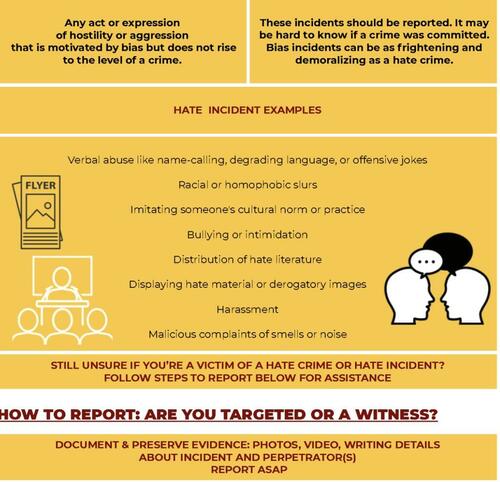
Maryland also has its Emmett Till Alert System that sends out three levels of alerts for specific acts of hate. For now, they only go to black lawmakers, civil rights activists, the media and other approved outlets, but expansion to the general populace is under consideration.
California vs. Hate, a multilingual statewide hotline and website that encourages people to report all acts of “hate,” is coming up on its one-year anniversary, reportedly receiving a mere 823 calls from 79% of California’s 58 counties during its first nine months of operation. It looks like the program is rolling out even more social media graphics in a bid to get more reports:

A key question is why states like California are rushing to expand the definition of hate. Officials in the Golden State like Governor Gavin Newsom claimed it was because of a rise in reported hate crimes – up 33 percent from 2020 to 2021. A deeper look at the data, however, shows that Newsom is guilty of cherry picking. From Public:
But convictions of hate crimes have been flat. In 2012 there were 107 hate crime convictions in California. In 2021, there were 109, according to the same data. It’s possible that hate crimes really did rise by 80%, and juries decided not to give prosecutors convictions. …But it’s also possible that convictions stayed the same because there was no increase in prosecutable hate crimes. And it may be that Californian prosecutors simply labeled more crimes as “hate” crimes because they were primed to do so by the media’s 700% – 1,000% increased focus on racism between 2011 and 2020.
I’m likely omitting other states with similar programs, but it’s clear that there is a push across the country. No doubt, these efforts to eliminate hate also have other benefits for the ruling class.
In a state like California or New York, there is the added bonus that the program ends up being a massive giveaway to a key part of the Democratic base – the nonprofit industrial complex that is helping to bring this system into existence.
These programs also help spread fear that hate is around every corner, which could allow for an erosion of rights under the guise of eradicating “hate.”
There’s also the issue of who is providing the definitions for hate that go beyond the laws already on the books for hate crimes. The California Senate Public Safety Committee analysis stated the following about the CA vs. Hate program:
A hate incident is an action or behavior motivated by hate but legally protected by the First Amendment right to freedom of expression.
That leads to the question of why the state is encouraging people to report and is collecting information on legally protected “behavior.” And where does the expanded definition come from? The committee stated the following:
Define hate incidents with language provided by the Anti-Defamation League.
The Anti-Defamation League (ADL) is a non-governmental organization based in the US, whose stated mission is “to stop the defamation of the Jewish people, and to secure justice and fair treatment to all.”
But there’s a little more to it than that. In May 2022, Jonathan Greenblatt, CEO of the ADL, announced that, “Anti-Zionism is anti-Semitism.” He also labeled groups that want equal rights for Palestinians in Israel as “extremists” and likened Israel critics to white supremacists. More from Boston Review:
…the ADL has consistently sought to undermine the left, leveling a charge akin to dual loyalty: that the American left’s calls for redistribution of power, its solidarity with global movements, and its prioritization of people over states threaten the very concept of the state. Indeed the ADL, in addition to its stated mission of shoring up U.S. support for Israel, is deeply loyal to the U.S. state. The second is that the ADL has waged a long, vigorous, and successful campaign, alongside AIPAC, specifically to characterize Arab American political organizing as dual loyalty.
Maybe this isn’t an organization that should be defining hate for US governments. We have the International Holocaust Remembrance Association (IHRA) for that.
In March South Dakota became the 35th state to codify the IHRA’s working definition of antisemitism. The law requires the consideration of the definition of antisemitism when investigating unfair or discriminatory practices.That definition includes the traditional elements of antisemitism but also inserts elements that could move the state of Israel under antisemitic protections. Consider the following from the IHRA’s definition:
-
Denying the Jewish people their right to self-determination, e.g., by claiming that the existence of a State of Israel is a racist endeavor.
-
Applying double standards by requiring of it a behavior not expected or demanded of any other democratic nation.
-
Drawing comparisons of contemporary Israeli policy to that of the Nazis.
A 2022 UK study published in Springer Nature found the following about the IHRA’s definition:
…pro-Israel activists can and have mobilised the IHRA document for political goals unrelated to tackling antisemitism, notably to stigmatise and silence critics of the Israeli government. This causes widespread self-censorship, has an adverse impact on freedom of speech, and impedes action against the unjust treatment of Palestinians. We also identify intrinsic problems in the way the definition refers to criticism of Israel similar ‘to that leveled against any other country’, ambiguous wording about ‘the power of Jews as a collective’, lack of clarity as to the Jewish people’s ‘right to self-determination’, and its denial of obvious racism.
Despite that effect, and despite the 2021 Hate Crimes Act, which provided more money and more programs to collect data on all “hate incidents,” there are still complaints that it all still isn’t enough because they don’t prevent “hate” but only address what takes place afterwards. To fix that, a precrime system will be necessary.
***
Predictive policing – which uses computer systems to help direct the deployment of police to crime hotspots – has been widely discredited as biased and worthless.
The Markup found that predictive policing does not work – at all. It took a look at efforts by Geolitica, known as PredPol until a 2021 rebrand, and its software that ingests data from crime incident reports and produces daily predictions on where and when crimes are most likely to occur. From The Markup:
We examined 23,631 predictions generated by Geolitica between Feb. 25 to Dec. 18, 2018 for the Plainfield Police Department (PD). Each prediction we analyzed from the company’s algorithm indicated that one type of crime was likely to occur in a location not patrolled by Plainfield PD. In the end, the success rate was less than half a percent.
It is also biased, despite efforts to make it less so. MIT Technology Review points out:
…many developers of predictive policing tools say that they have started using victim reports to get a more accurate picture of crime rates in different neighborhoods. In theory, victim reports should be less biased because they aren’t affected by police prejudice or feedback loops.
But a University of Texas study found this method still led to significant errors:
For example, in a district where few crimes were reported, the tool predicted around 20% of the actual hot spots—locations with a high rate of crime. On the other hand, in a district with a high number of reports, the tool predicted 20% more hot spots than there really were.
While these predictive policing spatial models prove biased, what if to counter those criticisms you begin to roll out programs to “protect” minorities by preventing hate crimes? Could an approach that treats each individual as a collection of data points (including any “hate incidents”) be predictive of a future hate crime?
Efforts to do just that date back to at least the early 1970s. When UCLA tried to set up a center for the study of violence.The Center for the Long-Term Study of Life-Threatening Behavior was intended to re-think human functioning itself in terms of data and was going to compile behavioral data to understand crimes that were “in formation.”
The center never officially opened its doors, however, as it got caught in the backlash against psychosurgery when groups like the Black Panthers and Nader’s Raiders protested against it.
But the rethink of humans as a collection of data points that can predict crimes in formation never really went away, and is now inching closer to becoming a reality. What is Canada’s proposed law other than a method to use data to measure “dangerousness” and preemptively punish suspects?
As MIT Technology Review pointed out above, there are efforts underway to use victim reports to counteract bias, but the University of Texas study was still trying to use them to predict where a crime might occur and not who might commit the crime.
I should point out that it’s unclear what states are doing with all the info collected from reported hate incidents, particularly the details on the alleged perpetrators. I reached out to the California Civil Rights Division weeks ago to get an answer but have yet to receive a response.
There is a clear line of thinking that these hate incidents can be predictive of future crime, however. That’s what the Canadian bill claims. Back in 2019 NYU researchers claimed to use AI to show that “online hate” could be predictive of offline violence. Could all these efforts to gather data on hate “incidents” be laying the groundwork for precrime detention along the lines of what Canada is attempting?
For those who would like to see the adoption of a precrime system, one of the benefits of focusing on individuals and hate crimes is that it could help diffuse the bias criticism of predictive policing from groups typically suspicious of increased law enforcement powers. Indeed, many of the groups helping to implement the hate incident hotlines in US states are nonprofits focused on minority groups.
As the state efforts above show, the definition of what constitutes a bias or hate “incident” are slippery and many interested parties would like to shape that definition. Again, there are already hate crime laws on the books, and I have yet to encounter an explanation for why these laws are so ineffective that it’s necessary to encourage people to rat on one another in order to gather data on hate incidents.
Placed alongside burgeoning censorship efforts, it begins to make more sense. If we look at Canada’s effort to establish official pre-hate-crime law enforcement, it’s one that would mark the official end of free speech and lead to a dystopian society revolving around the fear of being targeted – either by an individual or AI.
Even without official precrime laws on the books, there are already ways that these efforts to combat “hate” are attempting to stifle speech. Naked Capitalism readers don’t have to look far for errors (or intentional targeting) in this system as Google’s AI targeted this site for “hateful content” among other alleged sins.
And there’s the issue with “hate.” It could mean a racist comment or action; it could also now refer to criticism of Israeli policy or a thought crime against the ruling class. It apparently does not refer to elite policy in California, for example, where the gap in life expectancy between the richest and poorest percentiles increased to 15.51 years in 2021 (which seems like the hateful result of hateful policies if you ask me). What happens if Californians begin to make hateful comments about that fact?
We don’t have to only look to fiction like Minority Report for answers. California’s own history provides a great example of the real use of these burgeoning programs to purportedly combat “hate.”
The California Criminal Syndicalism Act of 1919 prohibited speech that suggested the use of violence for political aims. It came at a time when workers were winning important battles in the class war raging across the state. California started locking up Wobblies en masse. As Malcolm Harris describes in his book Palo Alto:
Wobblies filled San Quentin, the Bay Area’s only prison, on bullshit charges that could hold them for up to 14 years. In Southern California, the police teamed with a resurgent KKK to bust the waterfront union, and the IWW was lucky if the cops decided to merely stand by and watch. …By the end of the decade, the state organization was jailed and beaten into submission.
|
[Markets]
Maybe The Academic Bubble Is Finally Popping
Maybe The Academic Bubble Is Finally Popping
Authored by Jeffrey A. Tucker via The Epoch Times (emphasis ours),
 (Emily Karakis/Unsplash.com) (Emily Karakis/Unsplash.com)
Commentary
Academia has fallen on hard times, most signified by the disgrace of Harvard. When high-paid, high-status professors are revealed as plagiarists, and then kept on with high six-figure salaries anyway, and when others are fired for opposing inhumane COVID-19 controls, one has to wonder.
Such places have only their intellectual integrity; when that falls, what are they left with other than their $51 billion endowment?
Let’s just use Harvard as a proxy for universities generally. How are they faring these days? Is the generation that is now in a position to decide to attend them—rather than develop an actual skill in a trade—and choose to give up four years and hundreds of thousands of dollars really going to take the bait?
It appears that this is seriously in doubt. The last of the last generation born in the 20th century, so-called Generation Z, has entered college and faces the decision to continue on the path or take a different route. It so happens that skills-based trades are paying huge salaries right now. That’s because there is a massive shortage of people who know how to do stuff.
This happens when you have fifty years in which millions have been trained to be one or another form of “intellectual” (or “mind worker”) even as the market for such “skills” has long been saturated.
Plus the job is awful in any case, contrary to what had long been promised. Most members of the professional managerial class of highly educated desk sitters are wholly miserable people. Most of their lives are spent following orders and fitting into the bureaucracy, with little or no creativity, much less adventure. All you get is a fancy title and some social status within some circles, and even that is changing.
As for academic jobs, truly, do you know a happy and wholly content professor or university administrator? I’ve personally never known any professional more willing to kvetch about his or her job, telling tales of amazing intrigue, perfidy, and backstabbery. One always wants to ask, “Why don’t you leave?” but we know the truth. There is nowhere to go. Academic jobs are hard to come by and extremely difficult to convert from one institution to another.
Such people have no other skills.
It’s about time that young people realize that there are other ways to pursue a career. We might finally have reached the point at which people are going their own way rather than following the prescribed path for the illusion of upward social mobility.
The Wall Street Journal (WSJ) reports:
“Long beset by a labor crunch, the skilled trades are newly appealing to the youngest cohort of American workers, many of whom are choosing to leave the college path. Rising pay and new technologies in fields from welding to machine tooling are giving trade professions a face-lift, helping them shed the image of being dirty, low-end work. Growing skepticism about the return on a college education, the cost of which has soared in recent decades, is adding to their shine.
“Enrollment in vocational training programs is surging as overall enrollment in community colleges and four-year institutions has fallen. The number of students enrolled in vocational-focused community colleges rose 16 percent last year to its highest level since the National Student Clearinghouse began tracking such data in 2018. The ranks of students studying construction trades rose 23 percent during that time, while those in programs covering HVAC and vehicle maintenance and repair increased 7 percent.”
Plus, come on, how cool is it to be a welder? That’s amazing. Same with being an electrician, a plumber, a cook, a builder, or just about anything else where you use your hands. These days, the money is great to accompany the adventure. Actually doing things seems to be gaining traction.
For the fourth year, “median annual pay for new construction hires has eclipsed earnings for new hires in both the professional services and information sectors—such as accountants or IT maintenance workers,” the WSJ reports.
Apparently, a major factor here driving this is the pandemic lockdowns in the following sense. Lots of kids saw their parents working from home for two years during this time. Seeing them sit at the dining room table and stare at screens all day, and then interact with colleagues only through more apps and platforms, and then finding out that this is precisely what they do at work all the time, kind of drained away the romance.
Who wants to do that? Let’s just say not everyone.
Plus, it is not unknown to white males that they are not exactly in high demand in a professional workplace beset by diversity, equity, and inclusion preferences for anyone but them. No one wants to be in a profession in which you are discriminated against—and denounced and shamed relentlessly—based on factors you cannot change, such as biology.
Why not get into a field that cares nothing about your sex and race and instead judges you by your skills and character? That seems far more appealing.
The WSJ further reports: “In a survey of high school and college-age people by software company Jobber last year, 75 percent said they would be interested in vocational schools offering paid, on-the-job training. The rise of generative AI is changing the career calculus for some young people. The majority of respondents Jobber surveyed said they thought blue-collar jobs offered better job security than white-collar ones, given the growth of AI.
“Nearly 80 percent of respondents in Jobber’s survey said their parents wanted them to go to college. Professions dominated by college-educated workers generally earn more over time. Professional and business services workers, for example, make a median $78,500 compared with $69,200 in construction, according to ADP.”
The point about parents is interesting. I’ve been predicting for decades that the college bubble would pop. But it hasn’t. The reason is parents. They want the best possible path forward for kids. They might not know for sure that a college degree will guarantee a good life, but surely it can help. Plus a degree is something they “can always fall back on.”
You know the line and the intuition. It’s a Boomer-born attitude that comes from the postwar experience with the GI Bill. An entire generation was led to believe that putting newly returned soldiers into college formed the basis of postwar prosperity and put millions into the middle class.
As a result, we’ve had generations of parents who have strongly recommended college to their kids. And they have been willing to pay the big bucks to make it possible, even once it became impossible to “work your way through college.” Parents just kept paying. And then the student loan market fired up to pick up the slack from what the parents could not afford. This saddled at least two generations with six-figure debts as they started their careers.
This entire calculation is a massive error.
What it forgets is that giving up four years between the ages of 18 and 22 sitting at a desk rather than gaining valuable career experience is a massive opportunity cost that comes at the prime of life. Indeed, it sets you back. Then if you end up in a lucrative profession, you still have to take vocational training in the form of professional certifications—the start of your actual education about which no one prepared you.
That’s the major cost of college: what you otherwise would be doing during those four years that you did not do. By comparison even with the dollar expense associated with tuition and books, that’s a huge cost. The ensuing debt, meanwhile, is an egregious way to start off a life.
What exactly would pop this bubble? It would take a generation of kids who decide to defy their own parents’ wishes and pursue a genuine skill rather than waste time memorizing what professors tell them and spitting it back on tests. Is that happening finally? It seems so. Apparently, it was the lockdowns that broke the spell. Kids look at their parents’ boring lives and have decided that they want to do something more interesting.
Good. This college stuff has been the rage since the end of World War II. Despite its persistence, it makes no sense. Before World War II, the pattern for men was to develop skills as a teen, finish one’s education with high school, and start being an adult. For women, it was the same, contrary to myth. They were typically fully employed until marriage and starting a family and then left the workplace to raise a family.
There were outliers, of course, but the pattern generally held, and it worked. As for college and intellectual pursuits, they grew up with civilization itself, but higher education was for a subset of the population that felt the call toward what we used to call the “life of the mind.” It makes no sense to universalize that calling by force.
There are other ways to have a good life besides being able to hang a degree on the wall. Indeed, that piece of paper might not amount to much at all, and come at too high a price.
Views expressed in this article are opinions of the author and do not necessarily reflect the views of The Epoch Times or ZeroHedge.
|
[Markets]
The Single Wisest Thing You Can Do With Your Money
The Single Wisest Thing You Can Do With Your Money
Authored by Doug Casey via InternationalMan.com,
There’s a great deal more to becoming rich than buying the right investments and hoping for the best. The most important element in your strategy to win the battle for investment survival is your own psychology. You’ve heard that your attitude helps your health and your golf score; it’ll also improve your earning power.
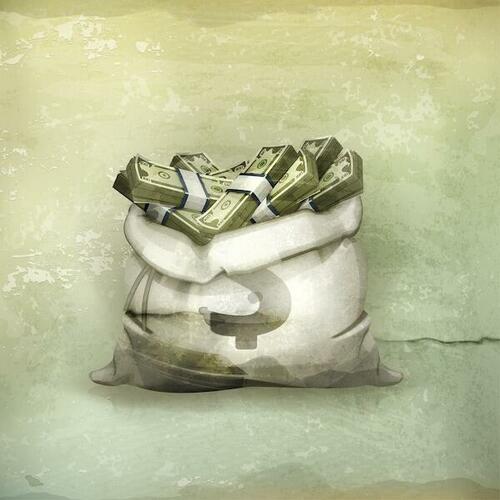
It’s not enough to liquidate your past financial mistakes. It’s more important to liquidate counterproductive attitudes, approaches, and methods of dealing with problems. The results that someone gets in life are an indication of how sound his approach toward life is. A sound philosophy of life gives good results. People with chaotic, unproductive, unhappy lives usually don’t have anyone to blame but themselves. They rarely have a strategy for living and thus have no foundation on which to build a strategy for investing.
There’s plenty of good advice available on the subject. Marcus Aurelius’ Meditations, Ben Franklin’s autobiography, Norman Vincent Peale’s Power of Positive Thinking, Frank Bettger’s How I Raised Myself from Failure to Success in Selling, and Maxwell Maltz’s Psycho-Cybernetics are all helpful.
One of the important things about the Greater Depression is that it will give you a chance to put your philosophy of life to the test. Almost anyone can get by in good times, but the years to come will separate the real winners from losers. Many will taste the thrill of victory or the agony of defeat firsthand; they won’t need the vicarious pleasure of Saturday afternoon TV sports to experience life.
There is, of course, no guarantee that just because you’ve developed a workable strategy that you won’t still be a casualty in the battle for financial survival. There is such a thing as plain bad luck. But, as Damon Runyon said, the bread may not always go to the wise, nor the race to the swift, nor the battle to the strong—but that’s the way to bet.
Tilt the odds in your favor by developing pro-survival attitudes, and the law of large numbers will take care of the rest.
There are, of course, an almost infinite number of valid attitudes. Anything that works for you is as good as anything that works for me. But since the next step in the strategy (consolidation) deals with gathering physical goods, I don’t want to leave any false impressions.
You may be able to salt away ten bags of silver, a thousand Krugerrands, and enough food to open a restaurant chain, but that’s not nearly as important as knowing how to get them all back again if you should lose them for any reason.
That’s one thing no one can ever take away from you, and you can never lose: your attitude towards life.
Scrooge McDuck had the right attitude.
One of the most formative stories I’ve ever read was an Uncle Scrooge comic written in 1953 by Carl Barks at Walt Disney Studios.
It finds Scrooge McDuck at play in his binful of money, diving and wallowing in it, doing what he likes best. As he leaves his bin to go out for his daily routine, it turns out that his nephew, Donald Duck, has decided to play a prank on him by putting a fake newspaper on the park bench with the headline “Coins and Banknotes Now Worthless!…Congress Make Fish the New Money of the Land.”
Scrooge sees it and is stunned. All his cash is worthless. He plops against a tree thinking that he hasn’t even one little minnow with which to buy a crust of bread. By the next frame of the comic book, however, the courageous old duck has picked himself up and is ready to get back in the race, saying, “Well, there’s no cause crying over bad luck. I’ll get a job and start life all over again.”
Soon we find him down at the waterfront talking to a fisherman. He offers to paint the man’s boat for a sackful of fish. Scrooge earns his fish and takes them to a clothing store where business is bad. He trades the fish for a raincoat. Back at the waterfront, he trades the raincoat to another fisherman for two sacks of fish.
Since the fish are getting heavy to carry around, Scrooge trades the two bags to a farmer for an old horse, then trades the horse for ten sacks of fish.
By the end of the day, Scrooge has a mountain of fish: three cubic acres’ worth. As much of the new money as he had of the old. He looks at the cold, clammy fish and asks himself…how to count the new money? By the pound or by the inch? How to keep it? And how to spend it before it goes bad?
Sorrowfully he realizes that fish isn’t as nice to play with as his old money. Fish don’t feel good and they smell bad.
All of the sudden, he doesn’t want to be rich anymore. He hires a trucking fleet to take the mountain of fish to Donald, who always wanted to be rich. Donald’s house is buried under dead fish.
Donald’s joke backfired, but Scrooge proved his point: You can start from scratch if you have the right attitude and come out ahead if you play your cards right.
Scrooge didn’t have a fish to his name when he had to start over, a lot less than you’ll have if you liquidate all your unneeded possessions. They’re costing you money, and tying you down. Transform the junk you’ve accumulated into cash, which you can redeploy the way Scrooge McDuck might.
The next step in your plan is to start earning to add to your grubstake—that is, create more money. It was key to Scrooge’s second fortune, and it’s key to yours.
But it’s necessary to have the skills necessary to provide goods and services to others. Scrooge made his fish fortune by his skills at business, but there are thousands of others.
Gaining Skills
One of the most important parts of taking control of your life as a step to prospering in the years to come is to educate yourself and gain skills. That means a lot more than just logging eight years in high school and college. Going to college is one thing, but learning to make money is something else. Most people today appear to believe going to college is necessary for getting ahead. It’s not. It may actually be a hindrance.
A lot of people seem to think that simply going to college will bestow an education. In reality, all most people get is a diploma, which is very different. Eric Hoffer, the San Francisco longshoreman who never completed high school but has written such profound books as The True Believer, is an outstanding example of the difference between going to college and getting an education.
Practical, marketable skills are often better acquired in trade schools, through self-teaching efforts, and through experience working from the bottom up in a field. A lot of teachers who finished first in their class couldn’t run a successful hot dog stand and are hardly in a position to help their students learn survival skills.
It would be a tragic mistake to devote all your resources to accumulating gold, hoarding commodities, devising clever tax schemes, and speculating, to the neglect of much more basic intangibles. The government may negate a lot of your efforts through its inflation, taxes, and regulations. And even if you overcome them, market risk—a bad judgement, an unexpected development, a failed brokerage house—can wipe you out. As can fraud, theft, a fire, or a war.
And in the environment coming up, all of those things and many others like them could be greater dangers than they have been in the past. The only thing that’s permanently secure is what you carry in your head: your attitude, your knowledge, your skills.
Who knows what skills may be required in the years to come? What you’re doing now, be it teaching school, practicing law, laying brick, or selling insurance, may be in low demand. But preparing French cuisine, fixing autos, keeping books, or offering financial counsel may be in high demand. Or perhaps the other way around.
The single wisest thing you can do with your money is not buy gold. It’s to take courses and acquire knowledge in other fields, as unrelated to what you are now doing as possible. Anything related to science, and particularly, technology would seem especially suitable. Computer science, medicine, mechanics, agriculture, and electronics are all going to remain in demand.
In the TV series Star Trek, the supremely knowledgeable Mr. Spock bailed the crew out as often as anyone. It’s hard to imagine him unemployed, for that reason. More knowledge can only increase your understanding of the way the world works now, and if it stops working the way it presently does, you’ll be able to continue. It will then no longer be the end of the world if you lose your present job.
And a lot of people will.
* * *
Most people have no idea what really happens when an economy collapses, let alone how to prepare… How will you protect yourself during the next crisis? Legendary speculator Doug Casey’s latest report will show you exactly how. Click here to get it now.
|
|
[66cb5e59-d720-5313-93a9-15cddc3b986d]
Eoin Colfer continues Juniper Lane series with 'Guardians of Cedar Wood'
Irish author Eoin Colfer, best known for his 'Artemis Fowl' books, is continuing his Juniper Lane series with 'Guardians of Cedar Wood,' scheduled to be released in 2025.
Published:4/4/2024 2:28:27 PM
|
[Markets]
The Great Escape From Government Schools
The Great Escape From Government Schools
Authored by Jim Bovard via The Libertarian Institute,
After enduring bullshit school shutdowns during the COVID pandemic, many students concluded that school itself must be bullshit and have skipped attending classes. Government bureaucrats are panicking since subsidies are tied to the number of students’ butts in chairs each day. Duke University Professor Katie Rosanbalm lamented that, thanks to the pandemic, "Our relationship with school became optional."
School absences have "exploded" almost everywhere, according to a New York Times report last week. Chronic absenteeism has almost doubled amongst public school students, rising from 15% pre-pandemic to 26% currently. Compulsory attendance laws are getting trampled far and wide.
The New York Times suggested that “something fundamental has shifted in American childhood and the culture of school, in ways that may be long lasting.” Connecticut Education Commissioner Charlene M. Russell-Tucker commented, “There is a sense of: ‘If I don’t show up, would people even miss the fact that I’m not there?'” The arbitrary, counterproductive school shutdowns destroyed the trust that many families had in the government education system.

The New York Times reflected the tizzy afflicting education bureaucrats across the land: “Students can’t learn if they aren’t in school.”
Like hell.
So kids are not enduring daily indoctrination to doubt their own genders? So kids’ heads are not being dunked into the latest social justice buckets of fear, loathing, and guilt? So kids are not being drilled with faulty methods of learning mathematics to satisfy the latest Common Core catechism and vainly try to close the “achievement gap”? A shortage of indoctrination is not the same as a shortfall of education.
More than seventy years ago, University of Chicago President Robert Hutchins aptly observed, “The tremendous waste of time in the American education system must result from the fact that there is so much time to waste.” John Taylor Gatto, New York’s Teacher of the Year of 1991 (according to the New York State Education Department), observed, “Government schooling…kills the family by monopolizing the best times of childhood and by teaching disrespect for home and parents.”
My view on school absenteeism is shaped by my dissident tendencies. Government schooling was the most brain deadening experience in my life. Early in elementary school, I relished reading even more than peanut butter. But I was obliged to put down books and listen to teachers, slowing my mental intake by 80% or 90%. By the time I reached fourth grade, my curiosity was fading.
Between my junior and senior years in high school, I lazed away a summer on the payroll of the Virginia Highway Department. I came to recognize that public schools were permeated by the same “Highway Department ethos.” Teachers leaned on badly-written textbooks instead of shovels. Going through the motions and staying awake until quitting time was all that mattered. Learning became equated with drudgery and submission to bored taskmasters with chalk and erasers.
And then came the wooden stakes hammered home in English classes. Devoting two months to dissecting Hamlet made me damn all Danes, courtiers, and psychoanalysts. The week spent on Mark Twain’s “The Celebrated Jumping Frog of Calaveras County” story made me lust to cast all frogs and folksy nineteenth century authors into hell. The six weeks blighted by Paradise Lost convinced me Samuel Johnson was right: “None ever wished it longer than it is.” Old books, rather than sources of wisdom and inspiration, were mental castor oil—something to forcibly imbibe solely to emit the right answers on the exams.
I spent years mentally idling while teachers droned. As long as the government provided a seat in a classroom, it had fulfilled its obligations. There was never any inkling that later in life, I would need to mobilize every iota of talent I might possess. My brain was like the mythical village of Brigadoon. It showed up once every year or two to take a scholastic aptitude test and then vanished into the mists. Teachers chronically noted on my permanent record “not performing up to potential.” Mysteries never cease. As long as I didn’t fail a grade, I slipped under the radar.
I was never a chronic truant until my family moved to a college town just before the start of my senior year in high school. I missed practically as many classes as I attended that year, scampering over to the nearby Virginia Tech campus. I scrupulously avoided going to a notorious bar—only two blocks away—during school hours. Actually, this was more expediency than principle, since the happy hour with 10-cent beer didn’t commence until after the last class finished.
After my class absences reached a certain threshold, I was sent to the school counselor—a perfectly coifed 30ish guy with an air of rectitude thick enough to cut with a knife.
He asked why I was skipping out, and I said school was mostly bunk. If I could pass classes without enduring Chinese-water-torture monotony, why stick around?
The counselor declared my attitude unacceptable and urged me to “get involved with the student government to try to fix things.” So I should fizzle away my time propping up the equivalent of the Vichy regime in Nazi-occupied France?!? Paul McCartney’s “Band on the Run” line, “Stuck inside these four walls, sent inside forever,” echoed in my head. When misbehaving kids were compelled to stay after school, it was called “detention.” But the entire system was detention, especially for the final year or two.
Boredom vanished from my life almost completely on the day I graduated from high school. My mental vitality surged after I no longer lost the bulk of my days fulfilling “seat time” requirements. Week by week, I began to regain the love of reading that I had lost years earlier. That made all the difference for my life and writing.
I recognize that many (if not most) of the new chronically absent students are probably putting their free time to good use. But at least teenagers have the chance to discover new books and to awaken their minds in a way that would never occur locked in classrooms. One epiphany is worth a dozen regurgitated exams.
Maybe if politicians ceased treating kids’ minds like disposable resources, more young folks would voluntarily show up for school. But generations of young kids have been sacrificed for whatever fad sweeps political and education activists. The best solution is to enable as many children as possible to exit government schools as soon as possible.
|
|
[Entertainment]
Washington Post paperback bestsellers
A snapshot of popular books.
Published:4/3/2024 7:07:04 AM
|
[Markets]
Squatters' Rights By State
Squatters' Rights By State
The debate about squatters' rights in the United States has been heating up to the point where it elicited a response from the Biden Administration this week.
In a statement it said that it was "critical that local governments take action" and that issues over squatters' rights were watched by the administration but considered a local issue.
As Statista's Katharina Buchholz reports, a string of high-profile squatting cases - with many centering on New York City - have made headlines recently. In February, news broke about a New York couple who had purchased a home in the suburb of Queens for long-term use of their disabled son, but was failing to evict a tenant who was a caretaker for the recently deceased former owner and had been expected to move out. However, as he had occupied the house for more than 30 days with alleged permission from the former owner, he couldn't be easily evicted under New York City Law. In another NYC case, squatters are suspected to have killed a 52-year-old woman in March who entered her deceased mother's apartment after having traveled from abroad to hand it over to new tenants.
In the state as a whole, this law is not on the books.
Like in many states, however, New York’s squatters or adverse possession laws kick in after 10 years and allow a squatter to stake claim to a property after this time period, as seen in data published by the American Apartment Owners Association.
Cases of squatters earning rights in this context are rare, but not unheard of.
In 2008, Oakland man Steven DeCaprio moved into an abandoned house in the city, fixed it up and successfully sued not only for occupancy, but for ownership in a process called adverse possession. In California, five years of continuous occupation are enough to stake a claim like DeCaprio's but the process is arduous and includes being up to date on tax payments for the property, something that local authorities might not accept.
Not taking into account the additional legal difficulties some claims under squatters rights face, California's required occupancy period is one of the shortest in the country together with Montana's.

You will find more infographics at Statista
Periods of seven years are on the books in Arkansas, Florida, Utah and Tennessee, even though the Florida statute will change as of July 1.
Washington's required period is pushed back to seven years as well if property taxes are paid and otherwise it is 10 years, like in several other states including Texas, Oregon, Arizona and South Carolina.
New Jersey and Louisiana employ the longest periods at 30 years.
|
[Markets]
Attempted Suicide Rates More Than Double After Gender-Reassignment Surgery: Study
Attempted Suicide Rates More Than Double After Gender-Reassignment Surgery: Study
Rates of attempted suicide who identified as transgender more than doubled after receiving a vaginoplasty (surgically turning one's dick into a vagina), according to a peer-reviewed study published in The Journal of Urology.
 (Teeradej/Shutterstock) (Teeradej/Shutterstock)
The study looked at rates of psychiatric emergencies both before and after gender-altering surgery among 869 males who went under the knife, and 357 females who underwent phalloplasty (turning one's vagina into a dick) in California between 2012 and 2018.
While researchers found that rates of 'psychiatric emergencies' were high both before and after gender-altering surgery, suicide attempts were markedly higher among those who received vaginoplasties, the Epoch Times reports.
"In fact, our observed rate of suicide attempts in the phalloplasty group is actually similar to the general population, while the vaginoplasty group’s rate is more than double that of the general population," wrote the author of the study.
Among the 869 patients who underwent vaginoplasty, 38 patients attempted suicide—with nine attempts before surgery, 25 after surgery, and four attempts before and after surgery. Researchers found a 1.5 percent overall risk of suicide before vaginoplasty and a 3.3 percent risk of suicide after the procedure. Almost 3 percent of those who attempted suicide after undergoing vaginoplasty did not present with a risk of suicide prior to surgery.
Among the 357 biologically female patients who underwent phalloplasty, there were six suicide attempts with a 0.8 percent risk of suicide before and after surgery. -Epoch Times
Aside from suicide attempts, the study found that the proportion of those who experienced an emergency room and inpatient psychiatric encounter was similar between the two groups - with 22.2% of vaginoplasty and 20.7% of phalloplasty groups experiencing at least one psychiatric encounter.
According to the study, 33.9% of biological males undergoing vaginopasty would experience a post-surgery psychiatric encounter vs. 26.5% for biological women who underwent phalloplasty, if an episode had occurred before surgery.
That's a lot.
As the Epoch Times notes further:
Suicide Rate 19-Fold Higher
In an interview with The Epoch Times, Dr. Alfonso Oliva, a board-certified plastic and reconstructive surgeon, said research into the psychiatric outcomes and long-term follow-up of those who have sex-reassignment surgery is lacking, but an important paper is worth mentioning. In a 2011 paper published in PLOS ONE, researchers found that people who underwent sex reassignment surgery had substantially higher rates of overall mortality, suicidal behavior, and psychiatric morbidity compared with the general population.
“It’s hard to refute this paper because it’s a longitudinal study,” Dr. Oliva said. “In Sweden, everyone is in a database, and through diagnosis codes, they’re able to follow what happens to every citizen in terms of their medical history. They waited more than 10 years after people had surgery and found that death by suicide had an adjusted hazard ratio of 19.1.”
You can “quibble” about emergency room encounters, but this study shows that for patients who had transgender surgery, their suicide rate after 10 years was 19-fold higher than the general population, Dr. Oliva said. Additionally, the study excluded people with psychiatric illnesses, so these are individuals thought to have no psychiatric illness outside of dysphoria.
Surgical Procedures
A phalloplasty is a multistep process undertaken by a biological female who wants to transition to a male, where a penis is created using tissues from the genitals and forearm or thigh. The external genitals, such as the labia or outer labia, are used to create a scrotum, and testicular implants are inserted months later along with an implant that will cause erections.
Vaginoplasty is the most commonly performed gender-reassignment surgery for those with gender dysphoria, with more than 3,000 procedures performed annually. According to Johns Hopkins Medicine, vaginoplasty is a surgical procedure that involves removing the penis, testicles, and scrotum to create a vulva and functional vagina. Surgeons typically create a vaginal canal using the skin surrounding the existing penis and scrotum or by using a skin graft from the abdomen or thigh.
A penial inversion is the most commonly performed procedure where the skin is removed from the penis and inverted to form a pouch that is inserted into the vaginal cavity created between the urethra and the rectum. Surgeons then partially remove, shorten, and reposition the urethra and create a labia majora, labia minora, and clitoris.
Another surgical method involves using a robotic system that enables surgeons to reach into the body through a small incision in the belly button to create a vaginal canal. The type of vaginoplasty performed varies among patients. For example, younger patients who have never experienced puberty may have insufficient penile skin to do a standard penile inversion.
“When you take a child who’s about to undergo puberty—and they suggest giving puberty blockers to stop puberty at age 10 to 11 1/2—and when you do that for little boys, they aren’t able to get tissue from the penis and scrotum, so creating a vagina is very difficult,” Dr. Oliva told The Epoch Times. “You have to use tissue from other areas of the body, such as the peritoneum or the colon. Some researchers in Brazil are actually looking into using tilapia fish,” he added.
After a vaginoplasty is performed, the recovery process is extensive and vaginal dilation must be performed at varying intervals throughout the patient’s life.
Vaginoplasty Associated With Serious Risks
In addition to an increased risk of suicide, vaginoplasty is associated with numerous physical complications, including wound separation, vaginal stenosis, hematoma, rectovaginal fistulas, granulation tissue, bleeding, infection, skin or clitoral necrosis, suture line dehiscence (when the surgical incision opens), urinary retention or vaginal prolapse.
According to a 2021 paper in the International Brazilian Journal of Urology, a rectovaginal fistula is the “most devastating complication” of a vaginoplasty that can occur “despite careful technique” and without obvious injury to the rectum.
A rectovaginal fistula is an abnormal connection between the rectum and vagina that can cause fecal incontinence, hygiene issues, vaginal or anal irritation, and potentially life-threatening abscesses and fistula recurrence.
A 2021 review in Andrology found that rates of complications following penile inversion vaginoplasty ranged from 20 to 70 percent, with most of the complications occurring during the first four months following the procedure.
In a 2018 Clinical Anatomy review and meta-analysis, researchers reviewed 125 articles to assess neovaginal complications following surgery. After selecting 13 studies that included 1,684 patients, they found a complication rate of 32 percent, with a reoperation rate of 22 percent for non-esthetic reasons.
“For cosmetic surgery, if the complication rate was more than 2 percent to 3 percent, you wouldn’t have any patients,” Dr. Oliva told The Epoch Times. “These are very high percentage rates that we just accept.”
Dr. Oliva said complications with these surgical procedures are very high and he thinks this is why suicide rates are so high.
“People think this is going to solve the problem and it doesn’t,” he said.
A June 2018 paper on postoperative outcomes of 117 patients who underwent vaginoplasty published in the Journal of the American Society of Plastic Surgeons found that 26 percent of patients experienced granulation tissue, 20 percent had intravaginal scarring, and 20 percent experienced prolonged pain.
In a 2017 paper published in The Journal of Urology, researchers followed patients who underwent penile inversion vaginoplasty. Of 330 patients, 95 (29 percent), presented with postoperative complications. Three of those patients developed a rectoneovaginal fistula, and 30 patients required a second operation.
Story continues below advertisement
In a 2016 study published in Urology, researchers retrospectively reviewed clinical records of 69 patients who underwent vaginoplasty from January 2005 to January 2015. Although complications during surgery were not reported, 22 percent of patients experienced major postoperative complications.
“We’ve been transitioning adults in the United States since 2007, but where’s the data from gender identity clinics? Why is nothing published in the United States about long-term function? Why do we have nothing published on sexual function? We should be able to follow that and should be studying it and we’re not,” Dr. Oliva told The Epoch Times.
* * *
|
[Markets]
TradFi Vs DeFi: De-Polarizing The Bitcoin 'To The Moon' Or 'Worthless' Battle
TradFi Vs DeFi: De-Polarizing The Bitcoin 'To The Moon' Or 'Worthless' Battle
Authored by Omid Malekan, Co-Authored with Ulrich Bindseil, Director General of the European Central Bank
Cryptocurrencies like Bitcoin have always been polarizing, even within the world of economics and finance. This divisiveness, which often pits the crypto faithful against skeptical experts from traditional finance, is unfortunate. Both sides can learn a great deal from each other.
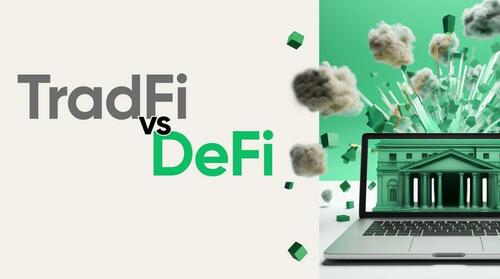
One of us is a Director General at the European Central Bank with a focus on payment systems and market infrastructure.
This past February Ulrich and a colleague published a viral blog post on the ECB website questioning whether Bitcoin had any fundamental value and listing other reasons to be skeptical of its promise as currency. The blog post was a follow-up to an initial critique on the same blog written by Ulrich and his colleague back in 2022.
The other one of us clearly disagrees.
Omid has been working in the crypto industry for years and teaches it at Columbia Business School. As argued on his own blog and in his books, he believes Bitcoin has unique and appealing properties that will eventually make it a backup reserve currency.
And yet: we consider each other friends, colleagues at a distance, and are conducting research together.
We first connected shortly after Ulrich’s initial blog post. Omid presented a list of rebuttals to Ulrich’s arguments — which to his credit Ulrich wanted to hear. Ulrich asked thoughtful questions and volunteered to read Omid’s book. He then invited Omid to present to his colleagues on digital currencies and cited Omid’s writing in his own research. Along the way we learned that we share a passion for the plumbing of finance and the likelihood of it being revolutionized by modern technology.
Unlike Ulrich, other experts in finance often dismiss all blockchain-based innovation, on account of the speculative nature of crypto assets, not to mention the combative nature of crypto believers.
Unlike Omid, many crypto professionals dismiss the most important lessons from the history of finance, dooming themselves to repeat them.
We’ve learned a lot from each other by putting our differences aside. We’ve even discovered that there’s a lot we agree on when it comes to the power of decentralized settlement networks, smart contracts, and tokenization.
We agree that Bitcoin is a novel invention created by a genius, and that it will lead to lasting innovation.
We also think that decentralization comes with major tradeoffs, one of which is a difficulty to evolve.
The next few halvings are going to test Bitcoin’s economic security.
Bitcoin has an illicit use problem. The illicit use of it needs to be addressed — as it needs to be addressed for every other payment solution. Its unique properties require new tools for combating illicit use, but society has to manage the tradeoffs between catching bad actors and censoring good ones. Where to fall on this spectrum is a political decision.
We agree that the energy impact of Bitcoin is significant and must be acknowledged, even as it trends towards renewables. Whether the environmental impact is worth it will ultimately depend on its utility beyond pure speculation. We both think the appeal of Bitcoin is greater in places with high inflation, political oppression, or a lack of basic financial services.
That said, we both think stablecoins might be even more useful to such people for day-to-day use. They might also be disruptive in developed markets as a more sophisticated and programmable payment instrument, one that can be coupled with other tokenized assets to improve capital markets and invent new instruments. [BU1]
Lastly, we both think the high volatility and lack of generally accepted valuation framework of Bitcoin add to the controversy surrounding it. Omid believes that one of his students (or even Ulrich) might someday make a name for themselves by proposing one. Ulrich believes he already found the answer but will try hard to come with a different solution.
Most of all, we both consider ourselves better off for challenging each other’s views and would encourage others to try the same.
Author’s note: This piece was originally written as a back-and-forth debate about Bitcoin before it morphed into the post above. Below is Omid’s rebuttal to Ulrich’s post on the ECB blog as well as Ulrich’s response to the rebuttal. We share this in the spirit of provoking further debate.
Omid Malekan: (emphasis ours)
Whether Bitcoin or any other asset should have value is for markets to decide. The more interesting question — for any asset — is whether there’s utility, but that lives in the eye of the beholder. I have no interest in collectible tennis shoes, but enough other people do for it to have a multi-billion dollar market [source]. My lack of interest is undecisive.
Bitcoin is an algorithmically minted digital currency with its own censorship-resistant payment system. Anyone can use it and be protected from inflation, repression, & forfeiture. This utility isn’t appreciated in the developed world where currencies are stable, and banking reliable. But countless people all over the world lack these financial amenities. Tellingly, Bitcoin adoption is highest in such countries [source].
In an ideal world, nobody would need Bitcoin. But in this one 25 countries are still experiencing double-digit inflation [source] and several had hyperinflation last year [source]. High inflation is often accompanied by financial repression. Bitcoin served as an effective store of value in these countries, despite its volatility.
A skeptic could argue almost any asset — including dollars, stocks, and real estate — do well when currencies collapse. But these assets are often unavailable to ordinary people, or live on untrustworthy infrastructure. Bitcoin has stronger property rights.
As the original blog post points out, those protections have a cost. Bitcoin is too slow and expensive to be used as a day-to-day currency & is seldom used as originally intended. But many technologies evolve beyond their original intent — the internet was original meant for academia and didn’t allow commercial activity until 1993. Tech evolves to serve users, not the other way around.
Bitcoin’s strong protections require energy. Setting aside the nuances, the environmental impact is significant. But many things use a lot of energy when measured in aggregate — like video games or the US Military. The question is whether the benefits are worth the cost. Bitcoin’s are, at least to women in Afghanistan or expats with family in Venezuela. Corporations and governments might someday find similar utility due to rising geopolitical tensions.
Bitcoin’s censorship-resistance does mean that it can be used for illicit activity. But so can smartphones, the internet, or banking. The existing financial system still accommodates significant illicit activity [source] — despite ever tightening restrictions, the cost of which is borne by everyone, including those who can afford it lease, like the underprivileged in so-called high-risk countries. The total amount of illicit activity in Bitcoin fell last year [source], possibly due to new forensic tools built on the transparency of the blockchain. Banking remains as opaque as ever, and fines for AML-violations jumped 50% in 2022. [source]
What do these benefits have to do with people who invest in Bitcoin ETFs? Very little. But it’s perfectly rational for one group of investors to bet that others will appreciate the utility of an asset. People who invest in Lithium ETFs don’t build batteries, they bet that someone else will.
Ulrich Bindseil: (emphasis ours)
Although it would be nice, I fear that the idea of women in Afghanistan improving their conditions with Bitcoin is largely a romantic wish. And if crypto-assets could support them, wouldn’t a US stablecoin relying on a faster, cheaper, and more efficient blockchain not provide a better store of value or payment mechanism than Bitcoin?
One can easily acknowledge that the technical design of the Bitcoin network appears to be a masterpiece. But that doesn’t mean that it’s not already outdated or on its way to being soon. How can the protocol be changed sufficiently to gain the efficiency it needs to survive in the medium term? Wouldn’t substantial changes betray the narrative of Bitcoin being immutable and having a fixed supply, making it indistinguishable from newer cryptocoins, reminding everyone its design is one of countless possibilities, and therefore not scarce?
We admire the technical designs of the 1944 Colossus computer of Max Newman, but it did not have commercial viability for long. Can we really imagine that Bitcoin will be around in 50 years? Why should it, given the incredible pace of change in computing and crypto technology? And if it’s not around in 50 years, can it have value today without remarkable utility? Proof of work has high energy consumption — proof of stake consumes 99% less energy and centralized ledgers even less. The negative climate effects are experienced by everyone, but perhaps they should be charged to Bitcoin holders, most of whom don’t seem to care so long as prices go up. Ironically, many of them only access Bitcoin through centralized intermediaries, as is the case with the official wallet offered by the government of El Salvador [source]
The “HODL” vision of many Bitcoin owners, predicated on ever-higher prices despite so many question marks and no way to derive a fair value, is a poor basis for a trillion-dollar asset. Unlike the technical resilience of the network, it’s inelegant. It leads to endless promotion by large holders who understate the risks, putting other investors at risk. Having a fundamental value anchor for any asset class isn’t just a side issue, it’s a necessary condition for trust.
The worlds of crypto and finance were always going to merge, so we might as well open our minds and learn from each other.
|
[Markets]
The Era Of Informed Consent Is Over
The Era Of Informed Consent Is Over
Authored by Victor Dalziel via The Epoch Times (emphasis ours),
In a significant blow to patient autonomy, informed consent has been quietly revoked just 77 years after it was codified in the Nuremberg Code.
 (Jan H Andersen/Shutterstock) (Jan H Andersen/Shutterstock)
On the 21st of December 2023, as we were frantically preparing for the festive season, the Department of Health and Human Services (HHS) and the Food and Drug Administration (FDA) issued a final ruling to amend a provision of the 21st Century Cures Act. This allowed
“... an exception from the requirement to obtain informed consent when a clinical investigation poses no more than a minimal risk to the human subject ...” [emphasis added]
This ruling went into effect on January 22nd, 2024, which means it’s already standard practice across America.
So, what is the 21st Century Cures Act? It is a controversial Law enacted by the 114th United States Congress in January 2016 with strong support from the pharmaceutical industry. The Act was designed to
“... accelerate the discovery, development, and delivery of 21st-century cures, and for other purposes [?] ...”
Some of the provisions within this Act make for uncomfortable reading. For example, the Act supported:
• High-risk, high-reward research [Sec. 2036].
• Novel clinical trial designs [Sec. 3021]
• Encouraging vaccine innovation [Sec. 3093].
This Act granted the National Institutes of Health (NIH) legal protection to pursue high-risk, novel vaccine research. A strong case could be made that these provisions capture all the necessary architecture required for much of the evil that transpired over the past four years.
Overturning patient-informed consent was another stated goal of the original Act. Buried under Section 3024 was the provision to develop an “Informed consent waiver or alteration for clinical investigation.”
Scholars of medical history understand that the concept of informed consent, something we all take for granted today, is a relatively new phenomenon codified in its modern understanding as one of the critical principles of the Nuremberg Code in 1947. It is inconceivable that just 77 years after Nuremberg, the door has once again opened for state-sanctioned medical experimentation on potentially uninformed and unwilling citizens.
According to this amendment, the state alone, acting through the NIH, the FDA, and the Centers for Disease Control and Prevention (CDC), will decide what is considered a “minimal risk” and, most concerning, will determine:
“... appropriate safeguards to protect the rights, safety, and welfare of human subjects.”
Notice the term subjects, not patients, persons, individuals, or citizens... but subjects. In asymmetrical power relationships such as clinician/patient, it is understood that the passive subject will comply with the rulings and mandates of their medical masters. The use of the term subjects also serves to dehumanise. The dehumanisation of populations was a critical component of Nazi human experimentation and, as Hannah Arendt argued, is an essential step toward denying citizens “... the right to have rights.”
This ruling also allows researchers and their misguided evangelical billionaire backers to potentially pursue dangerous experimental programs such as Bill Gates’ mosquito vaccines, mRNA vaccines in livestock, and vaccines in aerosols. This Act encourages these novel and high-risk programs, with medical studies approved as “minimal risk” by the regulators no longer requiring researchers and pharmaceutical companies to obtain patient consent. Yet, the histories of pharmacology and medicine are plagued with clinical investigations and interventions that were thought to pose no more than minimal risk to humans but went on to cause immeasurable pain, suffering, and death.
This amendment represents merely a first tentative step as the U.S. government tests the waters to see what it can get away with. Given the lack of attention this ruling received in both the corporate press and independent media, the government is likely to feel emboldened to widen its scope. Thus, this decision represents the beginning of a chilling revisionism in Western medical history, as patient autonomy is again forsaken.
This ruling, to be actioned by potentially corrupt scientists, health bureaucrats, and captured health and drug regulators, is another step toward a dystopian future unimaginable just five years ago. No doubt the infrastructure to implement this decree is already being constructed by the same groupthink cultists responsible for the nightmarish pandemic lockdowns, continuing to place the pursuit of profit and the greater good above individual choice, bodily autonomy, and informed consent.
From the Brownstone Institute
Views expressed in this article are opinions of the author and do not necessarily reflect the views of The Epoch Times or ZeroHedge.
|
[Markets]
What Will The Fed Do Next?
What Will The Fed Do Next?
Authored by Louis-Vincent Gave via Evergreen Gavekal blog,
So far this year, we have seen US inflation repeatedly beat expectations, US gasoline prices creep higher, gold break out to new all-time highs, feverish speculation in crypto and parts of the equity market, bonds sell off, and the US dollar roll over. Now copper has suddenly broken out of its recent trading range. And against this benign backdrop, US corporate bond spreads remain tight, despite fears of a US commercial real estate bust and its impact on US regional banks.
Outside the US, Japanese trade unions have secured their biggest pay rise in 33 years. Coming on top of a higher-than-expected PPI reading for February, this points to a more hawkish Bank of Japan and a stronger yen, which implies less deflation and less capital exports from Japan. Meanwhile India, Southeast Asia, Latin America and the Middle East are booming. And in spite of weak domestic economic data, European stock markets are chugging along nicely.
In short, over the past two months the case for Federal Reserve rate cuts has taken on some serious water. This leaves investors with an important question. What will the Fed do next? Will it try to get ahead of the curve and beat back the expectations of imminent rate cuts that it raised in December? Or will the Fed deliver on the promise of rate cuts, even though the macro backdrop is no longer so supportive of easier policy?
One added complication is the calendar. The Fed will be loath to start a new rate cut cycle in July, smack in between the Republican and Democratic conventions. It will also be loath to start a new cutting cycle in late October, days before the US presidential election. This means that the obvious times for the Fed to start a new rate cut cycle are either in June or in December (unless a Lehman-style or Covid-type crisis forces its hand).
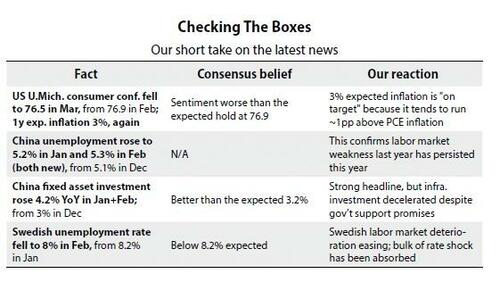
Now, having said all that, one of the first things I was taught as a young cadet at officer school was that “doing nothing” is still “doing something.” In the heat of battle, the temptation is always to freeze and attempt to gather more information before making any decision that could potentially have dire consequences. But the decision to freeze and wait is still a decision—and one that itself can have dramatic implications.
-
If the Fed freezes and does nothing—does not cut rates and lets the reverse repo reservoir drain without adding fresh liquidity—we can probably expect a sell-off in long-dated bonds, especially considering the volume of rollovers and new issuance coming down the pipeline. Few equities, least of all the more richly valued, would respond well to higher bond yields. The US dollar would likely rally, and commodities would struggle.
-
If the Fed, despite the changed environment, goes ahead with rate cuts, precious metals will continue to rally; in the past few sessions, silver has started to show signs of life and seems to be joining gold in a new bull market. Emerging market debt and equities will rally hard. The US dollar will continue to weaken. And commodities will continue to rally.
So let’s weigh the odds, starting with the reasons for the Fed to go ahead and deliver on rate cuts, despite all the recent strong data.
1) Institutional bias. In meeting after meeting, the Fed has made clear its belief that fighting inflation is much easier than fighting deflation. This belief will tend to push the Fed to err on the side of reflation.
2) Credibility fears. After being caught out and changing course in 2019 and again in 2022, Jay Powell probably wants to avoid another flip-flop.
3) Politics. If Powell fails to deliver rate cuts, triggering a bond and equity market crash just before the presidential election, he will never be invited to a dinner party in Washington D.C. again.
4) Treasury capture. In the last couple of months, both Treasury Secretary Janet Yellen and President Joe Biden have gone on record to say that the Fed needs to cut rates. In fairness, it probably does need to cut rates if the US treasury is to roll over US$8trn in debt and add another US$2trn on top without difficulty.
5) China fears. The constant Western media drumbeat on China is that the Chinese economy is imploding, that the renminbi is about to devalue, and that China is set to release a deflationary wave around the world that will make the Asian crisis look like a mere ripple. With a backdrop of such fears, you can see why the Fed might want to get few “insurance” cuts under its belt.
Against all these possible reasons to cut, the main reason Fed policymakers might want to sit on their hands is that Powell has made it clear he does not want to be remembered as another Arthur Burns. That’s basically it: the fear of being remembered as Arthur Burns versus the fear of no longer getting invited to D.C. dinner parties.
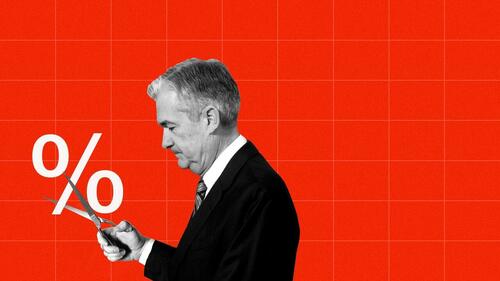
Looking at copper, gold, bitcoin, the US dollar and others, it increasingly looks as if the market has already decided. The fear of losing the dinner party invites is stronger than the fear of getting a bad rap in the history books. In any case, over the last few years the new motto of public life in Western democracies seems to have become “Après moi, le déluge.” Why expect a change now? The market is likely right to expect an easy Fed—and to position itself for reflation.
|
|
[Science]
Smartphones Do or Don’t Harm Kids! So Which Is It?
Two new books offer radically different approaches to how people should think about smartphones and social media.
Published:3/29/2024 5:32:36 AM
|
[Markets]
Rule By Criminals: When Dissidents Become Enemies Of The State
Rule By Criminals: When Dissidents Become Enemies Of The State
Authored by John & Nisha Whitehead via The Rutherford Institute,
“In these days of worldwide confusion, there is a dire need for men and women who will courageously do battle for truth.”
- Martin Luther King Jr.
When exposing a crime is treated as committing a crime, you are being ruled by criminals.
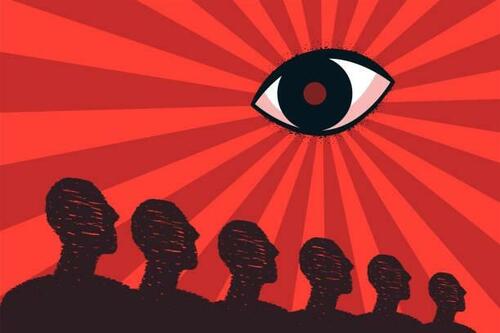
In the current governmental climate, obeying one’s conscience and speaking truth to the power of the police state can easily render you an “enemy of the state.”
The government’s list of so-called “enemies of the state” is growing by the day.
Wikileaks founder Julian Assange is merely one of the most visible victims of the police state’s war on dissidents and whistleblowers.
Five years ago, on April 11, 2019, police arrested Assange for daring to access and disclose military documents that portray the U.S. government and its endless wars abroad as reckless, irresponsible, immoral and responsible for thousands of civilian deaths.
Included among the leaked materials was gunsight video footage from two U.S. AH-64 Apache helicopters engaged in a series of air-to-ground attacks while American air crew laughed at some of the casualties. Among the casualties were two Reuters correspondents who were gunned down after their cameras were mistaken for weapons and a driver who stopped to help one of the journalists. The driver’s two children, who happened to be in the van at the time it was fired upon by U.S. forces, suffered serious injuries.
There is nothing defensible about crimes such as these perpetrated by the government.
When any government becomes almost indistinguishable from the evil it claims to be fighting—whether that evil takes the form of war, terrorism, torture, drug trafficking, sex trafficking, murder, violence, theft, pornography, scientific experimentations or some other diabolical means of inflicting pain, suffering and servitude on humanity—that government has lost its claim to legitimacy.
These are hard words, but hard times require straight-talking.
It is easy to remain silent in the face of evil.
What is harder—what we lack today and so desperately need—are those with moral courage who will risk their freedoms and lives in order to speak out against evil in its many forms.
Throughout history, individuals or groups of individuals have risen up to challenge the injustices of their age. Nazi Germany had its Dietrich Bonhoeffer. The gulags of the Soviet Union were challenged by Aleksandr Solzhenitsyn. America had its color-coded system of racial segregation and warmongering called out for what it was, blatant discrimination and profiteering, by Martin Luther King Jr.
And then there was Jesus Christ, an itinerant preacher and revolutionary activist, who not only died challenging the police state of his day—namely, the Roman Empire—but provided a blueprint for civil disobedience that would be followed by those, religious and otherwise, who came after him.
Indeed, it is fitting that we remember that Jesus Christ—the religious figure worshipped by Christians for his death on the cross and subsequent resurrection—paid the ultimate price for speaking out against the police state of his day.
A radical nonconformist who challenged authority at every turn, Jesus was a far cry from the watered-down, corporatized, simplified, gentrified, sissified vision of a meek creature holding a lamb that most modern churches peddle. In fact, he spent his adult life speaking truth to power, challenging the status quo of his day, and pushing back against the abuses of the Roman Empire.
Much like the American Empire today, the Roman Empire of Jesus’ day had all of the characteristics of a police state: secrecy, surveillance, a widespread police presence, a citizenry treated like suspects with little recourse against the police state, perpetual wars, a military empire, martial law, and political retribution against those who dared to challenge the power of the state.
For all the accolades poured out upon Jesus, little is said about the harsh realities of the police state in which he lived and its similarities to modern-day America, and yet they are striking.
Secrecy, surveillance and rule by the elite. As the chasm between the wealthy and poor grew wider in the Roman Empire, the ruling class and the wealthy class became synonymous, while the lower classes, increasingly deprived of their political freedoms, grew disinterested in the government and easily distracted by “bread and circuses.” Much like America today, with its lack of government transparency, overt domestic surveillance, and rule by the rich, the inner workings of the Roman Empire were shrouded in secrecy, while its leaders were constantly on the watch for any potential threats to its power. The resulting state-wide surveillance was primarily carried out by the military, which acted as investigators, enforcers, torturers, policemen, executioners and jailers. Today that role is fulfilled by the NSA, the FBI, the Department of Homeland Security and the increasingly militarized police forces across the country.
Widespread police presence. The Roman Empire used its military forces to maintain the “peace,” thereby establishing a police state that reached into all aspects of a citizen’s life. In this way, these military officers, used to address a broad range of routine problems and conflicts, enforced the will of the state. Today SWAT teams, comprised of local police and federal agents, are employed to carry out routine search warrants for minor crimes such as marijuana possession and credit card fraud.
Citizenry with little recourse against the police state. As the Roman Empire expanded, personal freedom and independence nearly vanished, as did any real sense of local governance and national consciousness. Similarly, in America today, citizens largely feel powerless, voiceless and unrepresented in the face of a power-hungry federal government. As states and localities are brought under direct control by federal agencies and regulations, a sense of learned helplessness grips the nation.
Perpetual wars and a military empire. Much like America today with its practice of policing the world, war and an over-arching militarist ethos provided the framework for the Roman Empire, which extended from the Italian peninsula to all over Southern, Western, and Eastern Europe, extending into North Africa and Western Asia as well. In addition to significant foreign threats, wars were waged against inchoate, unstructured and socially inferior foes.
Martial law. Eventually, Rome established a permanent military dictatorship that left the citizens at the mercy of an unreachable and oppressive totalitarian regime. In the absence of resources to establish civic police forces, the Romans relied increasingly on the military to intervene in all matters of conflict or upheaval in provinces, from small-scale scuffles to large-scale revolts. Not unlike police forces today, with their martial law training drills on American soil, militarized weapons and “shoot first, ask questions later” mindset, the Roman soldier had “the exercise of lethal force at his fingertips” with the potential of wreaking havoc on normal citizens’ lives.
A nation of suspects. Just as the American Empire looks upon its citizens as suspects to be tracked, surveilled and controlled, the Roman Empire looked upon all potential insubordinates, from the common thief to a full-fledged insurrectionist, as threats to its power. The insurrectionist was seen as directly challenging the Emperor. A “bandit,” or revolutionist, was seen as capable of overturning the empire, was always considered guilty and deserving of the most savage penalties, including capital punishment. Bandits were usually punished publicly and cruelly as a means of deterring others from challenging the power of the state. Jesus’ execution was one such public punishment.
Acts of civil disobedience by insurrectionists. Much like the Roman Empire, the American Empire has exhibited zero tolerance for dissidents such as Julian Assange, Edward Snowden and Chelsea Manning who exposed the police state’s seedy underbelly. Jesus was also branded a political revolutionary starting with his attack on the money chargers and traders at the Jewish temple, an act of civil disobedience at the site of the administrative headquarters of the Sanhedrin, the supreme Jewish council.
Military-style arrests in the dead of night. Jesus’ arrest account testifies to the fact that the Romans perceived Him as a revolutionary. Eerily similar to today’s SWAT team raids, Jesus was arrested in the middle of the night, in secret, by a large, heavily armed fleet of soldiers. Rather than merely asking for Jesus when they came to arrest him, his pursuers collaborated beforehand with Judas. Acting as a government informant, Judas concocted a kiss as a secret identification marker, hinting that a level of deception and trickery must be used to obtain this seemingly “dangerous revolutionist’s” cooperation.
Torture and capital punishment. In Jesus’ day, religious preachers, self-proclaimed prophets and nonviolent protesters were not summarily arrested and executed. Indeed, the high priests and Roman governors normally allowed a protest, particularly a small-scale one, to run its course. However, government authorities were quick to dispose of leaders and movements that appeared to threaten the Roman Empire. The charges leveled against Jesus—that he was a threat to the stability of the nation, opposed paying Roman taxes and claimed to be the rightful King—were purely political, not religious. To the Romans, any one of these charges was enough to merit death by crucifixion, which was usually reserved for slaves, non-Romans, radicals, revolutionaries and the worst criminals.
Jesus was presented to Pontius Pilate “as a disturber of the political peace,” a leader of a rebellion, a political threat, and most gravely—a claimant to kingship, a “king of the revolutionary type.” After Jesus is formally condemned by Pilate, he is sentenced to death by crucifixion, “the Roman means of executing criminals convicted of high treason.” The purpose of crucifixion was not so much to kill the criminal, as it was an immensely public statement intended to visually warn all those who would challenge the power of the Roman Empire. Hence, it was reserved solely for the most extreme political crimes: treason, rebellion, sedition, and banditry. After being ruthlessly whipped and mocked, Jesus was nailed to a cross.
Jesus—the revolutionary, the political dissident, and the nonviolent activist—lived and died in a police state. Any reflection on Jesus’ life and death within a police state must take into account several factors: Jesus spoke out strongly against such things as empires, controlling people, state violence and power politics. Jesus challenged the political and religious belief systems of his day. And worldly powers feared Jesus, not because he challenged them for control of thrones or government but because he undercut their claims of supremacy, and he dared to speak truth to power in a time when doing so could—and often did—cost a person his life.
Unfortunately, the radical Jesus, the political dissident who took aim at injustice and oppression, has been largely forgotten today, replaced by a congenial, smiling Jesus trotted out for religious holidays but otherwise rendered mute when it comes to matters of war, power and politics.
Yet for those who truly study the life and teachings of Jesus, the resounding theme is one of outright resistance to war, materialism and empire.
What a marked contrast to the advice being given to Americans by church leaders to “submit to your leaders and those in authority,” which in the American police state translates to complying, conforming, submitting, obeying orders, deferring to authority and generally doing whatever a government official tells you to do.
Telling Americans to blindly obey the government or put their faith in politics and vote for a political savior flies in the face of everything for which Jesus lived and died.
Will we follow the path of least resistance—turning a blind eye to the evils of our age and marching in lockstep with the police state—or will we be transformed nonconformists “dedicated to justice, peace, and brotherhood”?
As Martin Luther King Jr. reminds us in a powerful sermon delivered 70 years ago, “This command not to conform comes … [from] Jesus Christ, the world’s most dedicated nonconformist, whose ethical nonconformity still challenges the conscience of mankind.”
Ultimately, as I make clear in my book Battlefield America: The War on the American People and in its fictional counterpart The Erik Blair Diaries, this is the contradiction that must be resolved if the radical Jesus—the one who stood up to the Roman Empire and was crucified as a warning to others not to challenge the powers-that-be—is to be an example for our modern age.
|
|
[Entertainment]
Washington Post hardcover bestsellers
A snapshot of popular books.
Published:3/27/2024 7:08:47 AM
|
[Markets]
The Canaries In America's Coal Mine
The Canaries In America's Coal Mine
Authored by J.Peder Zane via RealClearPolitics.com,
Joe Biden vs. Donald Trump is not the race America needs, but it is the one we deserve.
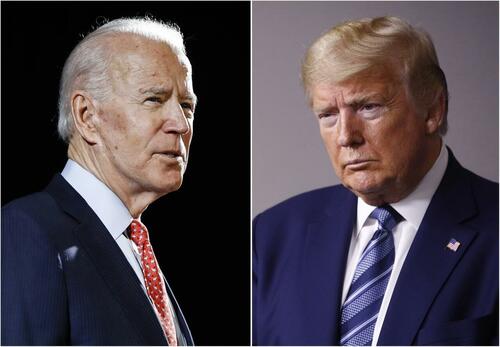
A political system that has spit out a race few voters want is the perfect symbol of a nation – and a people – bent to the point of breaking.
Biden vs. Trump appears to be a welcome diversion in a country whose government seems unequipped to face its biggest challenges and whose people are increasingly unwilling to take responsibility for their own problems. Eight months arguing about two angry old men – hearing our own side praise us to the hilt while blaming every woe on the other – is time we don’t have to spend confronting our own difficulties.
Historic declines in life expectancy, jaw-dropping rates of obesity, and rising truancy among students are just a few of the ways we the people are running off the rails.
A few others include:
-
In a Wall Street Journal commentary about post-COVID America, Yale University’s Nicholas Christakis observes how “reckless behavior” is becoming epidemic. “Americans gambled a record $66.5 billion in 2023. Compared with 2019, there has been an 18% increase in fatal accidents involving alcohol and a 17% increase in those involving speeding. Over 500 Americans are dying every day from alcohol-related deaths, a 30% increase. Sexually transmitted diseases are rising across the nation, too.”
-
Jonathan Haidt reports in the Atlantic that “rates of depression and anxiety in the United States – fairly stable in the 2000s – rose by more than 50 percent in many studies from 2010 to 2019. The suicide rate rose 48 percent for adolescents ages 10 to 19. For girls ages 10 to 14, it rose 131 percent.” A CNN and Kaiser Family Foundation poll published in 2022 found that more than 20% of adults described their mental health as “fair” or “poor,” and about one-third of adult respondents said they feel anxious much of the time.
-
A 2021 study by the Survey on American Life found that 49% of Americans said they had fewer than three close friends – in 1990 the figure was 27%. That same year 33% of respondents said they had 10 or more close friends; in 2021 that number fell to 13%. The birth rate and rates of marriage – which, when done in tandem, producer happier and more stable parents and children – have long been in decline.
-
Unable to meet its recruitment goals, the Pentagon has repeatedly lowered its standards for physical fitness, mental health, and academic achievement to meet its numbers. “America’s youth are less qualified for service than ever before,” Army Brig. Gen. Patrick Michaelis, commander at Fort Jackson, S.C., was quoted as saying in a Stars and Stripes article published last year. Added Gen. James McConville, the Army’s chief of staff, “We have a lot of young men and women who want to serve – and they can’t pass the academic requirements or they can’t pass the physical requirements.”
-
The New York Sun reports that many citizens are no longer part of the workforce. “Jobs held by native-born Americans decreased by nearly half a million between January and February of this year, while jobs held by foreign-bornAmericans (both legal and illegal immigrants) spiked to 1.16 million. Looking further back, since January 2020 — just before the pandemic — there has been no growth in native-held jobs, while jobs for foreign-born employees have skyrocketed by more than 3.9 million. … The native-born workforce participation rate of 6 percent is also less than the foreign-born participation rate of 66.6 percent.”
-
The liberal Vera Institute has reported that “the number of women incarcerated in the United States has skyrocketed in the last four decades, increasing 475 percent in 40 years. In 2019, there were more than 231,000 women and girls held in prisons and jails across the country. … 50 years ago, almost 75 percent of counties held not a single woman in jail.” In a similar vein, news reports now routinely carry articles about female teachers accused of molesting students.
These are just some of the canaries in the American coal mine. Together they suggest how – despite the many strengths our nation still possesses – we are unraveling. The government cannot fix most of these problems, which may be why politicians largely ignore them. Such issues must be addressed at that most local of levels – the individual and the family.
It may feel good to complain about the other guy for the next eight months – and heaven knows we have plenty of reason to. But after the November election, all of our problems will remain. It’s long past time we recognized that much of the fault for our deep-rooted challenges lies not in our political stars but in ourselves.
|
[Markets]
Church Of England Archdeacon Openly Calls For "Anti-Whiteness"
Church Of England Archdeacon Openly Calls For "Anti-Whiteness"
Authored by Steve Watson via Modernity.news,
A Church of England archdeacon has been labelled racist after openly calling for “anti-whiteness.”

The Ven Miranda Threlfall-Holmes, Archdeacon of Liverpool wrote on X “I went to a conference on whiteness last autumn. It was very good, very interesting and made me realise: whiteness is to race as patriarchy is to gender.”
Threlfall-Holmes, who is white, added “So yes, let’s have anti-whiteness, and let’s smash the patriarchy. That’s not anti-white, or anti-men, it’s anti-oppression.”
I went to a conference on whiteness last autumn. It was very good, very interesting and made me realise: whiteness is to race as patriarchy is to gender.
So yes, let’s have anti whiteness, & let’s smash the patriarchy.
That’s not anti-white, or anti-men, it’s anti-oppression.
— Miranda Threlfall-Holmes (@MirandaTHolmes) March 21, 2024
[Miss Threlfall-Holmes has since switched her X feed to private.]
Anti-whiteness isn’t anti-white? What exactly is it then?
When asked to explain by The Telegraph, Threlfall-Holmes claimed that X is “perhaps not the best place for a nuanced argument,” adding “I was contributing to a debate about world views, in which ‘whiteness’ does not refer to skin colour per se, but to a way of viewing the world where being white is seen as ‘normal’ and everything else is considered different or lesser.”
The backlash was swift:
The Telegraph notes that the conference the Archdeacon is referring to was a day-long “Racial Justice Conference” in Birmingham organised by Reconciliation Initiatives, a charity working in partnership with Coventry Cathedral to help churches “contribute to reconciliation in wider society”.
The report further notes that the conference aimed “To encourage white participants to take next steps in facing their own whiteness, and in addressing institutional racism within Anglican churches and provinces.”
The group is also running a four-week long course titled “Being White” which asks clergy and lay members to consider “the ways we are caught up in a system of white superiority and white advantage in UK society.”
The Church of England has been heavily criticised recently for leaning into this kind of stuff.
The church recently announced it would be hiring a “deconstructing whiteness” officer to form part of a “racial justice unit” being set up by the Diocese of Birmingham.
In 2023 the CofE also established a £100 million fund to “address past wrongs of slavery,” even as some church buildings are literally falling apart.
In 2021, the CofE announced it was introducing quotas for black and ethnic clergy to pave the way for ‘anti-racism training’ in the Church, as well as ‘contextualising church statues that may cause offence.”
The CofE has become so infested with wokery in general to the point that it has considered dropping the phrase “our Father” from the start of the Lord’s Prayer, and instructing clergy to refrain from using male pronouns when talking about God.
Some churches have gone as far as erasing references to the nativity and Jesus in a Christmas carol and replacing them with a celebration of “queer” people.
In July last year, the Church of England refused to define what a woman was, saying they had no definition of it on their books, despite still ostensibly opposing same sex marriage.
Also last year, a vicar was officially rebuked for expressing criticism of the CofE’s decision to appoint a transgender archdeacon, after he noted that the person is “biologically, a bloke.”
* * *
Your support is crucial in helping us defeat mass censorship. Please consider donating via Locals or check out our unique merch. Follow us on X @ModernityNews.
|
|
[e48026f1-ea92-536b-93d2-66164e6c210e]
'Charlie and the Chocolate Factory,' 'Matilda' and other Roald Dahl books that were made into popular movies
Roald Dahl's books are the inspiration behind many hit movies. "Charlie and the Chocolate Factory," "Matilda" and "The BFG" and others have translated to the big screen.
Published:3/24/2024 11:10:30 AM
|
[Markets]
New 'Morally Ambiguous' Star Wars Show Directed By Former Assistant To Harvey Weinstein
New 'Morally Ambiguous' Star Wars Show Directed By Former Assistant To Harvey Weinstein
There's a whole lot of former Star Wars fans out there today, and we say "former" because once George Lucas made the fatal (but lucrative for him) decision to sell the franchise to Disney the beloved brand was doomed to lose a majority of its existing audience. To date, Disney has burned every ounce of fan capital it once had and each successive Star Wars movie and series has performed worse than the the last in terms of box office and viewership. And, it was all done in the name of going woke.
Disney as a company has become the mascot for "Get Woke, Go Broke" with an extensive list of theatrical and streaming service failures the past few years, and they continue to refuse to learn from their mistakes. The bottom line? Legacy companies like Disney are willing to destroy their own brand in the pursuit of political propaganda; they'll keep on pontificating about Diversity, Equity and Inclusion until they are bankrupt.

Their upcoming Star Wars streaming format release called 'The Acolyte' is expected by many to become the worst woke/feminist disaster in the company's history handling the franchise. And, it might not be a coincidence that their latest DEI endeavor will be directed by a former assistant to Harvey Weinstein, the very man that the "Me Too" movement was created to admonish.
How aware was Leslie Headland to the casting-couch activities of her boss when she was his assistant? It's hard to say. However, Hollywood has determined that her status as a lesbian and queer activist negates any connections she might have had to that ugly association.

Interviews with Headland suggest she will be bringing all her activism and politics to the latest Disney Star Wars installment along with a predictable interest in making the classic archetypal tale about good and evil "morally ambiguous." As she notes in the Hollywood Reporter:
"People who are good guys can be bad guys, and people who are bad guys can be good guys. There’s a lot of moral ambiguity, which is why Jodie’s [Turner-Smith] line in the trailer is so important: “This isn’t about good or bad; this is about power and who is allowed to use it.” And I believe, of course, that the Jedi are a benevolent, well-intentioned institution, but they are an institution and they have amassed all the power..."
As with all woke activism, good and evil are considered relative social constructs that don't really exist, and Headland wants to bring that philosophy to Star Wars. In other words, the Sith might do things that are considered evil, but did you ever ask yourself how they feel about it? What if they have an emotional justification for their actions?
Any normal person would say "Who cares?" But writers and directors with narcissistic tendencies don't understand the world of heroism or moral principle. They are also incapable of writing from another person's perspective and are only capable of injecting their own views into everything they touch. Moral ambiguity is a completely counterintuitive interpretation to the symbolism of Star Wars, as well as contrary to what the vast majority of audiences connect with.
The entertainment media is also buzzing with excitement over the amount of LGBT representation in The Acolyte, with a number of gay and trans actors and crew members involved. Not to mention, the show trailer is noticeably devoid of white male characters; par for the course in today's far-left content. Kathleen Kennedy's mantra of "the force is female" is heavily present here.
As usual, the show is being sold on the basis of its diversity rather than the merit of its storytelling, with cast and crew asserting that Star Wars is finally "safe for black nerds" and other minorities because now they can see themselves represented on screen. Of course, if you can't relate to a well written story unless the characters share your skin color or ethnic background, then there's probably something very wrong with you.
The production is tied directly to Disney's 'The High Republic' book series, which is widely regarded as an epic marketing blunder and dismal seller. The books showcase an array of leftist ideological concepts that immediately turned off readers, and fans have long suspected that Disney's agenda was to eventually replace all Star Wars lore with High Republic wokism. Added to the terrible base material is Headland's own fan fiction, which she admits she wrote when she was younger and is at least partially ingrained into the show.
At this time, The Acolyte trailer has received 366,000 dislikes on YouTube, compared to 160,000 likes and Disney executives are allegedly scrambling to produce positive PR. Disney denies that their DEI based content has anything to do with the growing public skepticism for the show. In what has become an endlessly repeating cycle, Hollywood produces woke bomb after woke bomb, refuses to admit that wokeness is the problem, the movies or series are quickly forgotten and then they start all over again.
|
|
[Entertainment]
Laurent de Brunhoff, artist who made Babar the elephant famous, dies at 98
He popularized a character imagined by his mother and drawn by his father when he was a boy, elevating Babar to global fame through films, TV and books.
Published:3/24/2024 3:27:22 AM
|
[Markets]
CIA Secrecy On JFK Points To Criminal Culpability
CIA Secrecy On JFK Points To Criminal Culpability
Authored by Jacob Hornberger via The Future of Freedom Foundation,
More than 30 years ago, Congress enacted the President John F. Kennedy Assassination Records Collection Act of 1992. Enacted in the wake of Oliver Stone’s movie JFK, which posited that the Kennedy assassination was a regime-change operation on the part of the U.S. national-security establishment, the law mandated that all the assassination-related records of the Pentagon, the CIA, the Secret Service, the FBI, and other federal agencies be released to the public. Having succeeded in keeping their assassination-related records secret for almost 30 years, they didn’t like that at all.

Today — more than 60 years after the assassination — the CIA continues to keep thousands of its assassination-related records secret. Its justification? You guessed it: “national security,” the two most powerful and meaningless words in the American political lexicon. CIA officials maintain, with straight faces, that if those still-secret assassination-related records were released, the United States would fall into the ocean, be taken over by communists, or have its “national security” endangered in some other silly way.
How in the world can “national security” be threatened by the release of records that are more than 60 years old, regardless of what definition is placed on that nebulous term? Indeed, how can any American really believe this nonsense? They obviously take Americans for dupes.
It is a virtual certainty that those still-secret records contain circumstantial evidence that further confirms criminal culpability on the part of the CIA and the Pentagon in the assassination of President Kennedy. After all, the CIA knows that that is precisely what most everyone is thinking with respect to the continued secrecy of those records. Why would the CIA want to leave people thinking that? One reason: Because it’s better to have people thinking that those records contain incriminating evidence rather than knowing that they do.
What could the CIA be hiding with those still-secret records? The answer necessarily has to be speculative in nature, but my hunch is that some of the still-secret information deals with Mexico City, where the accused assassin Lee Harvey Oswald was supposed to have met with Cuban and Soviet officials.
In the immediate aftermath of the assassination, it is obvious that everything went wrong with the Mexico City part of the assassination plot. For example, there were audiotapes that supposedly contained Oswald’s voice and then suddenly there were no such audiotapes. There was a photograph of Oswald except that it was a photograph of someone else.
Why was Mexico City an important part of the assassination plot? As I detail in my newest book on the assassination, An Encounter with Evil: The Abraham Zapruder Story, an essential part of the assassination plot was to frame a communist. This was the height of the Cold War, when most everyone hated and feared the Reds. By framing a communist, the national-security establishment could rest assured that Americans would be reluctant to come to Oswald’s defense or believe anything he said.
Mexico City played an important role in this endeavor. Oswald was ordered to travel to Mexico City, where he was to meet with both Cuban and Soviet officials. In that way, the plotters could definitely tie the future assassin to the Soviet and Cuban communists.
Why would Oswald obey such orders? Because he was an operative for U.S. intelligence. Intelligence operatives follow orders, especially when they’re told that they are part of an intelligence operation.
In fact, in one of its first meetings, Earl Warren, the head of the Warren Commission, told the commission that there was highly discomforting evidence that Oswald was, in fact, an intelligence operative. Once the CIA and the FBI, which, of course, would never lie about such a thing, assured the commission that such wasn’t the case, Warren ordered that the meeting be kept top-secret and never revealed to the American people.
When he was serving in the army, Oswald became fluent in the Russian language. That is not an easy thing to do. It takes language experts, which the U.S. government has. That’s the only way Oswald could have learned to speak fluent Russian while he was in the army.
There is also New Orleans, where Oswald had moved from Dallas prior to his trip to Mexico City. In New Orleans, Oswald spent a lot of effort building up his “pro-communist” persona, especially with the help of an anti-Castro group called the DRE.
Immediately after the assassination, the DRE sent out a press release informing the nation that Oswald was a communist. There is one big important thing about the DRE that the nation did not know and would not know for several decades. It was a CIA-funded and CIA-supervised group. Thus, it was actually the CIA that wanted the nation to know that the president had been killed by a Red.
As JFK researcher Jefferson Morley, who first discovered the CIA’s connection to the DRE, has also discovered, the CIA was secretly monitoring Oswald in the months leading up to the assassination, including secretly reading his mail. Why would the CIA be doing that? Because if one is going to frame a person in a very complex murder plot, one has to be certain that the person being framed doesn’t figure out what is going on.
Will the CIA succeed in keeping its assassination-related records secret forever? Given the overwhelming power that the national-security branch has within the federal governmental structure, it’s a virtual certainty that it will succeed. But what difference does it make? The evidence that was released by the JFK Records Act already proves beyond a reasonable doubt that the Kennedy assassination was a national-security state regime-change operation, especially with respect to the fraudulent autopsy that the military conducted on JFK’s body and the fraudulent copy of the Zapruder film that the CIA produced. (See my books The Kennedy Autopsy and An Encounter with Evil: The Abraham Zapruder Story.) The CIA’s still-secret assassination-related records would only add more circumstantial evidence to what we already know.
|
[Markets]
Sowing The Wind: The New 'Newspeak'
Sowing The Wind: The New 'Newspeak'
Authored by Lani Kass via RealClear Wire,
The presidential election is eight months away. Yet the campaign to preclude a second Trump administration is already in high gear. In the course of two weeks, the public was given a preview of the undemocratic, uncouth, racist dystopia MAGA America is doomed to become. Against the backdrop of the most virulent antisemitism sweeping the U.S. in the wake of Hamas’ savagery, the media has chosen to pillory “white nationalism” as the clear and present danger.

First, a new tome, “White Rural Rage,” is hailed by the New York Times as “an important book that ought to be read by anyone who wants to understand politics in the perilous Age of Trump.”
Next, Politico’s Heidi Przybyla proclaims that people who believe human rights come from God are “Christian Nationalists.” She triggers an uproar. Yet she doubles down in an even more incendiary piece: “Christian Nationalism is a political movement. … The thing that unites them … is that they believe our rights as Americans and as all human beings do not come from any earthy [sic] authority. They don’t come from Congress, from the Supreme Court, they come from God.”
Evidently, people who have read America’s founding document – the Constitution – are a mortal threat to our very survival.
Then, on March 3, CBS’s “60 Minutes” broadcasts a segment about “Moms for Liberty” waging a “campaign to ban books on race and gender from school libraries.” Could “Fahrenheit 451” be far behind?
We are witnessing what Hannah Arendt calls “the atomization of society.” It is a well-tested tactic: Shatter every natural connection in society; twist the language; isolate people from each other. The individual is all alone – an atom. No family, no community, no solace.
Totalitarianism of all stripes finds fertile ground in frightened, isolated individuals.
Technology accelerates this “atomization.” We relate to each other in “virtual reality.” Our “friends” are on Facebook.
Truth itself is erased, because the Internet offers “facts” to fit any narrative. We have access to unprecedented amounts of information; yet our knowledge and intellectual discourse are beggared. The free market of ideas gives way to mutually reinforcing opinions, shared in closed echo chambers.
To disorient the “atomized” individual still further, “Political Correctness” takes hold. Things which were acceptable yesterday will get you a reprimand today. You’ll be censored online. You learn to obfuscate, because you need your job; you don’t want to be “canceled”; and, most of all, you dread being labeled “racist.” You self-censor – just like in the U.S.S.R.
Soon, a new language takes hold. Not only our pets can be “groomed”; so can our children. We ask about “preferred pronouns.” We learn new words: “cisgender,” “woke,” and “micro-aggression.”
We’re taught that “the only remedy to past discrimination is present discrimination.” And thus, “All animals are equal, but some animals are more equal than others.”
The term “Newspeak” originated in George Orwell’s novel “1984.” “Newspeak” is a controlled language, designed to limit critical thinking.
In Orwell’s dystopia, “The Ministry of Peace concerns itself with war, the Ministry of Truth with lies. … These contradictions are not accidental; they are deliberate exercises in doublethink.”
In today’s Department of Defense:
Diversity management calls for creating a culture of inclusion in which the diversity … shapes how the work is done. … Although good diversity management rests on a foundation of fair treatment, it is not about treating everyone the same. This can be a difficult concept to grasp, especially for leaders who grew up with the EO-inspired mandate to be both color and gender blind. Blindness to difference, however, can lead to a culture of assimilation in which differences are suppressed rather than leveraged. Cultural assimilation, a key to military effectiveness in the past, will be challenged as inclusion becomes, and needs to become, the norm.
The statement is from the 2011 report of the commission on “Military Leadership Diversity.”
Orwell would be proud.
The report – and the implementing law – are breathtaking in scope and implications. MLDC calls for a fundamental “transformation” of our military – making racial and gender representation a “top defense priority.” This effort continues with a new Defense Advisory Committee on Diversity and Inclusion.
We know that accentuating what is different among us fosters division and erodes cohesion. Yet we’re told that it’s “diversity” – of gender, race, ethnicity, sexual orientation – that makes our nation prosperous and our military strong.
We try to reconcile this with our motto, “E pluribus unum.” But we can’t reconcile the irreconcilable. This inevitably leads to cognitive dissonance – disorienting, disconcerting, and further “atomizing.”
A new Utopia emerges, wherein there are 57+ genders and men can give birth.
We know that is inconceivable, but it’s all around us – and suddenly we can’t talk to our children anymore. They think we are racist, sexist, transphobic bigots. We feel like aliens – from outer space, not from across the Southern border. “Up is down, war is peace, freedom is slavery, ignorance is strength.” We are atoms, untethered, disoriented, disconnected.
“And, thus, they had come to a time when no one dared speak his mind.”
Dr. Lani Kass served in the Department of Defense for 30 years. These views are her own.
|
|
[Entertainment]
Washington Post paperback bestsellers
A snapshot of popular books.
Published:3/20/2024 7:07:29 AM
|
[Markets]
From Capitalism To Corporatism
From Capitalism To Corporatism
Authored by Jeffrey Tucker via DailyReckoning.com,
In the 1990s, it was common to ridicule the government for being technologically backward.

We were all gaining access to fabulous things, including the web, apps, search tools and social media. But governments at all levels were stuck in the past using IBM mainframes and large floppy disks.
I recall the days of thinking government would never catch up to the glories and might of the market itself. I wrote several books on it, full of techno-optimism.
The new tech sector had a libertarian ethos about it. They didn’t care about the government and its bureaucrats. They didn’t have lobbyists in Washington. They were the new technologies of freedom and didn’t care much about the old analogue world of command and control. They’d usher in a new age of people power.
Here we sit a quarter-century later with documented evidence that the opposite happened. The private sector collects the data that the government buys and uses as a tool of control.
It’s determined by algorithms agreed upon by a combination of government agencies, university centers, various nonprofits and the companies themselves. The whole thing has become an oppressive blob.
Money Flows to Power
Here is Google’s new headquarters in Reston, Virginia:

And here’s Amazon’s proposed HQ2, in Arlington, Virginia:

Every major company that once stayed far away from Washington now owns a similar giant palace in or around D.C., and they collect tens of billions in government revenue.
Government has now become a major customer, if not the main customer, of the services provided by the large social media and tech companies. They’re advertisers but also massive purchasers of the main product too.
Show Me the Money
Amazon, Microsoft and Google are the biggest winners of government contracts, according to a report from Tussell. Amazon hosts the data of the National Security Agency with a $10 billion contract, and gets hundreds of millions from other governments.
We don’t know how much Google has received from the U.S. government, but it’s surely a substantial share of the $694 billion the federal government hands out in contracts.
Microsoft also has a large share of government contracts. In 2023, the U.S. Department of Defense awarded the Joint Warfighter Cloud Capability contract to Microsoft, Amazon, Google and Oracle.
The contract is worth up to $9 billion and provides the Department of Defense with cloud services. It’s just the beginning. The Pentagon is looking for a successor plan that will be bigger.
Actually, we don’t even know the full extent of this but it is gargantuan. Yes, these companies provide the regular consumer services but a main and even decisive customer is government itself.
As a result, the old laughingstock line about backward tech at government agencies is no more. Today government is a main purchaser of tech services and is a top driver of the AI boom too.
It’s one of the best-kept secrets in American public life, hardly talked about at all by mainstream media. Most people still think of tech companies as free-enterprise rebels. It’s not true.
The same situation of course exists for pharmaceutical companies. This relationship dates even further back in time and is even tighter to the point that there is no real distinction between the interests of the FDA/CDC and large pharmaceutical companies.
Consumer Preference Doesn’t Matter
In this framework, we might also tag the agricultural sector, which is dominated by cartels that have driven out family farms. It’s a government plan and massive subsidies that determine what is produced and in what quantity.
It’s not because of consumers that your Coke is filled with a scary product called “high-fructose corn syrup,” why your candy bar and danish have the same and why there’s corn in your gas tank. This is entirely the product of government agencies and budgets.
In free enterprise, the old rule is that the customer is always right. That’s a wonderful system sometimes called consumer sovereignty. Its advent in history, dating perhaps from the 16th century, represented a tremendous advance over the old guild system of feudalism and certainly a major step over ancient despotisms. It’s been the rallying cry of market-based economics ever since.
What happens, however, when government itself becomes a main and even dominant customer?
The ethos of private enterprise is thereby changed. No longer primarily interested in serving the general public, enterprise turns its attention to serving its powerful masters in the halls of the state, gradually weaving close relationships and forming a ruling class that becomes a conspiracy against the public.
The Old Binaries Have Broken Down
This used to go by the name “crony capitalism,” which perhaps describes some of the problems on a small scale. This is another level of reality that needs an entirely different name. That name is corporatism, a coinage from the 1930s and a synonym for fascism back before that became a curse word due to wartime alliances.
Corporatism is a specific thing, not capitalism and not socialism but a system of private property ownership with cartelized industry that primarily serves the state.
The old binaries of the public and private sector — widely assumed by every main ideological system — have become so blurred that they no longer make much sense. And yet we’re ideologically and philosophically unprepared to deal with this new world with anything like intellectual insight.
Not only that, it can be extremely difficult even to tell the good guys from the bad guys in the news stream. We hardly know anymore for whom to cheer or boo in the great struggles of our time.
That’s how mixed up everything has become. We’ve clearly traveled a long way from the 1990s!
Monetary Corporatism
Of course in 1913, we saw the advent of a particularly egregious public-private partnership with the Federal Reserve, in which private banks merged into a unified front and agreed to service U.S. government debt obligations in exchange for bailout guarantees. This monetary corporatism continues to vex us to this day, as does the military-industrial complex.
How is it different from the past? It’s different in degree and reach.
The corporatist machine now manages the main products and services in our civilian life including the entire way we get information, how we work, how we bank, how we contact friends and how we buy.
It’s the manager of the whole of our lives in every respect, and has become the driving force of product innovation and design. It’s become a tool for surveillance in the most intimate aspects of our lives, including financial information and listening devices we’ve willingly installed in our own homes.
It’s become a main curator and censor of our news and social media presence and postings. It is in a position to say which companies and products succeed and which ones fail. It can kill apps in a flash if the well-placed person does not like what they are doing.
It can order other apps to add or subtract to a blacklist based on political opinions. It can tell even the smallest company to comply or face death by lawfare. It can seize on any individual and make him a public enemy based entirely on an opinion or action that runs contrary to regime priorities.
In short, this corporatism — in all its iterations including the regulatory state and the patent war chest that maintains and enforces monopoly — is the core source of all the current despotism.
COVID: A Trial Run
It obtained its first full trial run with the lockdowns of 2020, when tech companies and media joined in the ear-splitting propaganda campaigns to shelter in place, cancel holidays and not visit Grandma in the hospital and nursing home.
It cheered as millions of small businesses were destroyed and big-box stores thrived as distributors of approved products, while vast swaths of the workforce were called nonessential and put on welfare.
This was the corporatist state at work, with a large corporate sector wholly acquiescent to regime priority and a government fully dedicated to rewarding its industrial partners in every sector that went along with the political priority at the moment.
The trigger for the construction of the vast machinery that rules our lives was far back in time and always begins the same way: with a seemingly inauspicious government contract.
How well I recall those days in the 1990s when public schools first started to buy computers from Microsoft. Did alarm bells go off? Not for me. I had a typical attitude of any pro-business libertarian: Whatever business wants to do, it should do.
Surely it’s up to the enterprise to sell to all willing buyers, even if that includes governments. In any case, how in the world would one prevent this? Government contracting with private business has been the norm from time immemorial. No harm done.
And yet it turns out that vast harm was done. This was just the beginning of what became one of the world’s largest industries, far more powerful and decisive over industrial organization than old-fashioned producer-to-consumer markets.
These gigantic for-profit and public trading corporations became the operational foundation of the surveillance-driven corporatist complex.
What to Do?
We’re nowhere near coming to terms with the implications of this. It goes way beyond and fully transcends the old debates between capitalism and socialism. Indeed that is not what this is about.
The focus on that might be theoretically interesting but it has little or no relevance to the current reality in which public and private have fully merged and intruded into every aspect of our lives, and with fully predictable results: economic decline for the many and riches for the few.
This is also why neither the left nor the right, nor Democrats or Republicans, nor capitalists or socialists, seem to be speaking clearly to the moment in which we live.
The dominating force on both the national and global scene today is techno-corporatism that intrudes itself into our food, our medicine, our media, our information flows, our homes and all the way down to the hundreds of surveillance tools that we carry around in our pockets.
I truly wish these companies were genuinely private, but they’re not. They’re de facto state actors. More precisely, they all work hand-in-glove and which is the hand and which is the glove is no longer clear.
Coming to terms with this intellectually is the major challenge of our times. Dealing with it juridically and politically seems like a much more daunting task, to say the least. The problem is complicated by the drive to purge serious dissent at all levels of society.
How did American capitalism become American corporatism? A little at a time and then all at once.
|
[Markets]
"We're One Event Away From A 1970s-Style Stagflation Explosion..."
"We're One Event Away From A 1970s-Style Stagflation Explosion..."
Excerpted from 'The Turning Point' report via Larry MacDonald's TheBearTrapsReport.com,
We hear the comparisons more and more; they are growing louder by the week.
“The years 2023-2024 look a lot like 1973-1974.”
The history books remind us,1973’s oil embargo shook the global energy market. It also reset geopolitics, reordered the global economy, and a multipolar world saw energy weaponized. After kissing 6% in 1970, in Q1 of 1973, inflation as measured by CPI danced just below 4%, much like today, central bankers were doing the Michael Jackson moonwalk in celebratory form. Then, in bloodcurdling fashion in late 1974, CPI breached 12%.
“Don’t be silly, 1973 was a far different set up,” we are told.
When it comes to demand on a global stage, 2024 is 2x 1973.
Above all, the U.S. is the largest producer of oil in 2024, not as was the case in 1973, when she was the world’s largest petroleum importer.
At the time, oil was 50% of world energy consumption vs. 1/3 today.
There is just one overwhelming difference today.
In the last 8 weeks, we have seen drone technology knock out
a) parts of Russia’s second largest airport,
b) at least three of Putin’s prize oil refineries,
and c) countless ships in the Suez Canal.
Weaponizing oil in a multipolar world is exponentially more uncertain with James Cameron calling the shots. In October of 1984, he brought us the “Terminator” and opened the world’s eyes to the future of AI and the weaponization of robots. If Vladimir Putin, on the eve of an election, cannot protect his second-largest airport, how can the Saudi’s protect their own crown jewel. Measuring 280 by 30 km (170 by 19 mi) (some 8,400 square kilometres (3,200 sq mi)), it is by far the largest conventional oil field in the world. That’s a lot of ground to protect. We are one event away from a 1970s-style stagflation explosion.
More often than not, recency bias is an investor’s foe. The 2008 and 2020 recessions were similar in that a shock triggered a colossal bond rally along with plunging PMI, ISM and LEI data. It’s more and more apparent by the minute. What we are experiencing today is much more of a 1970s – 1980s recession vintage. An inflation-driven slowdown hits the bottom 60% first, but this time around after the Fed suppressed rates for so, so, so long, higher net worth consumers feel like they died and went to heaven. Revenge consumption has been the economy’s tailwind from those with $1m ($50k annual income vs. $8k in 2021) to $10m ($500k annual income vs. $80k in 2021) in a money market fund. This, plus trillions of fiscal overdosing coming out of Washington have prevented the recession so far, but they have also made inflation’s second act far more certain in a multipolar world.
In this note we breakdown the increasing stagflationary landscape.
By our count, $500B has moved into Oil & Gas and Metals in recent months. Likewise, oil’s risk to inflation expectations, rates and the -- CRE wounded -- super regional banks is accelerating.
What does the world look like if the Fed is forced to ease to protect the banks and the bottom 60% of consumers in an election year -- while inflation is heading north for the summer?
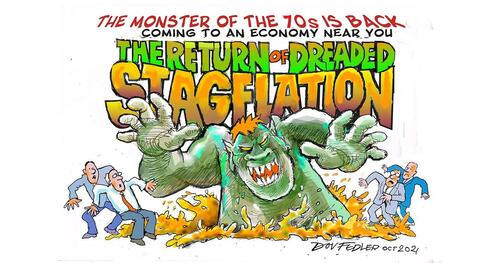
Sticky Inflation
Both CPI on Tuesday and PPI on Thursday came in hotter than expected.
Core CPI rose 3.8% y/y vs +3.7% expected and PPI rose 2% y/y vs 1.9% expected. At the same time, several data points show a slowing economy as well. Retail sales, which were reported simultaneous with the PPI on Thursday, rose 0.6% m/m, which was less than the 0.8% forecast. The prior month was revised lower as well, from -0.8% to -1.1%.
In ANOTHER stagflationary turn, the Empire State manufacturing survey for March also came in well below expectations at -21 vs -7 expected.
The report noted that “Demand softened as new orders declined significantly, and shipments were lower. Unfilled orders continued to shrink. Labor market indicators weakened, as employment and hours worked both decreased. The pace of input price increases moderated somewhat, while the pace of selling price increases held steady”.
BofA in its monthly consumer spending report on Monday said that” consumer spending momentum appears soft, Credit card and debit card spending rose 0.4% m/m, after a 0.3% drop in January.”
Oil – High Impact Far and Wide
The oil heavy CRB touched its highest level since November Friday. Every day the super-regional banks go without rate cuts, the day of reckoning on market-tomarket losses grows closer to a reality. The Fed opened the door to a softer path, just an inch – that has fueled inflation’s Act II.
This has LARGE implications for the banks.
Since January 2023; Zions ZION, Comerica CMA and Truist TFC are underperforming the S&P 500 by close to 50%.
The NYCB failure has regulators at the OCC and FDIC on the lookout for other Mark-to-Market cheaters.
In recent days, we have multiple Ukraine drone attacks on Russian oil refineries, another over the weekend.
A multipolar world takes some of the steering wheel away from the Fed with large implications for the banks.
Multipolar World - Drone Strikes with High Impact
By some estimates, in 2023 the EU imported 130 million barrels of seaborne refined products – mostly diesel – from refineries processing Russian crude.

These purchases were worth an estimated €1.1 billion. With some Russian refineries down, Europe must draw more supply from the West, WTI is more than +13% off February levels, +20% off the December lows.
The refineries that are processing Russian crude oil and exporting to the EU are largely the same ones sending laundered Russian fuel to the UK and US.
The seven largest refineries collectively processed 390 million barrels of Russian crude oil in 2023, valued at an estimated €23 billion. (Global Witness).
Connecting the Dots
Higher rates + higher inflation expectations are leaving a stain here. Some banks desperately need rate cuts.
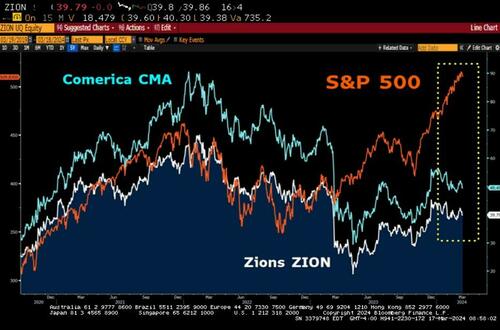
Where does that leave us?
The anxious bond market is now pricing in just 60% odds a rate cut in June and 72bp of rate cuts in 2024. In the upcoming FOMC meeting, some economists are now forecasting the DOT plot to move from 3 to 2 cuts this year.
It only takes two Committee members to raise their dot for the median dot to go from 3 cuts to 2 cuts for the year.
Odds of Rate Cut
The higher the white line above the lower the June rate cut probability.
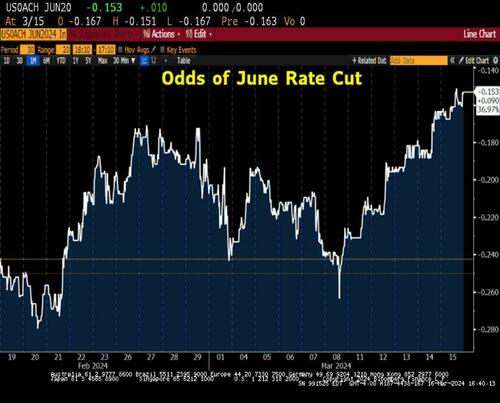
We are back where we were in late February, with June rate hike odds at 60%.
(The market prices these odds as an expected move in the Fed Fund futures. So -15bp is a 15bp/25bp=60% chance of a 25bp drop in Fed Funds.)
...
"Funny how Nicky-Leaks only mentions the dovish data, failed to mention the Atlanta Fed sticky CPI data out yesterday which showed nice reacceleration" -- Dallas PM.
* * *
Subscribers can read the full 'Turning Point' report from Larry MacDonald's Bear Traps Report here...
|
[Markets]
Half Of Downtown Pittsburgh Office Space Could Be Empty In 4 Years
Half Of Downtown Pittsburgh Office Space Could Be Empty In 4 Years
Authored by Mike Shedlock via MishTalk.com,
The CRE implosion is picking up steam.
Check out the grim stats on Pittsburgh.
Unions are also a problem in Pittsburgh as they are in Illinois and California.

Downtown Pittsburgh Implosion
The Post Gazette reports nearly half of Downtown Pittsburgh office space could be empty in 4 years.
Confidential real estate information obtained by the Pittsburgh Post-Gazette estimates that 17 buildings are in “significant distress” and another nine are in “pending distress,” meaning they are either approaching foreclosure or at risk of foreclosure. Those properties represent 63% of the Downtown office stock and account for $30.5 million in real estate taxes, according to the data.
It also calculates the current office vacancy rate at 27% when subleases are factored in — one of the highest in the country.
And with an additional three million square feet of unoccupied leased space becoming available over the next five years, the vacancy rate could soar to 46% by 2028, based on the data.
Property assessments on 10 buildings, including U.S. Steel Tower, PPG Place, and the Tower at PNC Plaza, have been slashed by $364.4 million for the 2023 tax year, as high vacancies drive down their income.
Another factor has been the steep drop — to 63.5% from 87.5% — in the common level ratio, the number used to compute taxable value in county assessment appeal hearings.
The assessment cuts have the potential to cost the city, the county, and the Pittsburgh schools nearly $8.4 million in tax refunds for that year alone. Downtown represents nearly 25% of the city’s overall tax base.
In response Pittsburgh City Councilman Bobby Wilson wants to remove a $250,000 limit on the amount of tax relief available to a building owner or developer as long as a project creates at least 50 full-time equivalent jobs.
It’s unclear if the proposal will be enough. Annual interest costs to borrow $1 million have soared from $32,500 at the start of the pandemic in 2020 to $85,000 on March 1. Local construction costs have increased by about 30% since 2019.
But the city is doomed if it does nothing. Aaron Stauber, president of Rugby Realty said it will probably empty out Gulf Tower and mothball it once all existing leases expire.
“It’s cheaper to just shut the lights off,” he said. “At some point, we would move on to greener pastures.”
Where’s There’s Smoke There’s Unions
In addition to the commercial real estate woes, the city is also wrestling with union contracts.
Please consider Sounding the alarm: Pittsburgh Controller’s letter should kick off fiscal soul-searching
It’s only March, and Pittsburgh’s 2024 house-of-cards operating budget is already falling down. That’s the clear implication of a letter sent by new City Controller Rachael Heisler to Mayor Ed Gainey and members of City Council on Wednesday afternoon.
The letter is a rare and welcome expression of urgency in a city government that has fallen in complacency — and is close to falling into fiscal disaster.
The approaching crisis was thrown into sharp relief this week, when City Council approved amendments to the operating budget accounting for a pricey new contract with the firefighters union. The Post-Gazette Editorial Board had predicted that this contract — plus two others yet to be announced and approved — would demonstrate the dishonesty of Mayor Ed Gainey’s budget, and that’s exactly what’s happening: The new contract is adding $11 million to the administration’s artificially low 5-year spending projections, bringing expected 2028 reserves to just barely the legal limit.
But there’s still two big contracts to go, with the EMS union and the Pittsburgh Joint Collective Bargaining Committee, which covers Public Works workers. Worse, there are tens — possibly hundreds — of millions in unrealistic revenues still on the books. On this, Ms. Heisler’s letter only scratched the surface.
Similarly, as we have observed, the budget’s real estate tax revenue projections are radically inconsistent with reality. Due to high vacancies and a sharp reduction in the common level ratio, a significant drop in revenues was predictable — but not reflected in the budget. Ms. Heisler’s estimate of a 20% drop in revenues from Downtown property, or $5.3 million a year, may even be optimistic: Other estimates peg the loss at twice that, or more.
Left unmentioned in the letter are massive property tax refunds the city will owe, as well as fanciful projections of interest income that are inconsistent with the dwindling reserves, and drawing-down of federal COVID relief funds, predicted in the budget itself. That’s another unrealistic $80 million over five years.
Pittsburgh exited Act 47 state oversight after nearly 15 years on Feb. 12, 2018, with a clean bill of fiscal health.
It has already ruined that bill of health.
Act 47 in Pittsburgh
Flashback February 21, 2018: Act 47 in Pittsburgh: What Was Accomplished?
Pittsburgh’s tax structure was a much-complained-about topic leading up to the Act 47 declaration. The year following Pittsburgh’s designation as financially distressed under Act 47 it levied taxes on real estate, real estate transfers, parking, earned income, business gross receipts (business privilege and mercantile), occupational privilege and amusements. The General Assembly enacted tax reforms in 2004 giving the city authority to levy a payroll preparation tax in exchange for the immediate elimination of the mercantile tax and the phase out of the business privilege tax. The tax reforms increased the amount of the occupational privilege tax from $10 to $52 (this is today known as the local services tax and all municipalities outside of Philadelphia levy it and could raise it thanks to the change for Pittsburgh).
The coordinators recommended an increase in the deed transfer tax, which occurred in late 2004 (it was just increased again by City Council) and in the real estate tax, which increased in 2015.
Legacy costs, principally debt and underfunded pensions, were the primary focus of the 2009 amended recovery plan. The city’s pension funded ratio has increased significantly from where it stood a decade ago, rising from the mid-30 percent range to over 60 percent at last measurement.
The obvious question? Will the city stick to the steps taken to improve financially and avoid slipping back into distressed status? If Pittsburgh once stood “on the precipice of full-blown crisis,” as described in the first recovery plan, hopefully it won’t return to that position.
The Obvious Question
I could have answered the 2018 obvious question with the obvious answer. Hell no.
No matter how much you raise taxes, it will never be enough because public unions will suck every penny and want more.
On top of union graft, and insanely woke policies in California, we have an additional huge problem.
Hybrid Work Leaves Offices Empty and Building Owners Reeling
Hybrid work has put office building owners in a bind and could pose a risk to banks. Landlords are now confronting the fact that some of their office buildings have become obsolete, if not worthless.
Meanwhile, in Illinois …
Chicago Teachers’ Union Seeks $50 Billion Despite $700 Million City Deficit
Please note the Chicago Teachers’ Union Seeks $50 Billion Despite $700 Million City Deficit
The CTU wants to raise taxes across the board, especially targeting real estate.
My suggestion, get the hell out...
|
[Markets]
"Dramatic Picture For History Books": LNG Tankers Still Absent From Red Sea
"Dramatic Picture For History Books": LNG Tankers Still Absent From Red Sea
Ongoing attacks by Iran-backed Houthi rebels on commercial vessels navigating through the Bab el-Mandeb Strait have forced all liquefied natural gas tankers with destinations to Europe and the US to divert routes, which means longer and more expensive routes.
"This is a dramatic picture for history books. Bookmark it!" Energy Outlook Advisors' Anas Alhajji posted on X.
Alhajji posted a map showing no LNG tankers transiting the Red Sea, Suez Canal, or the Gulf of Adan.
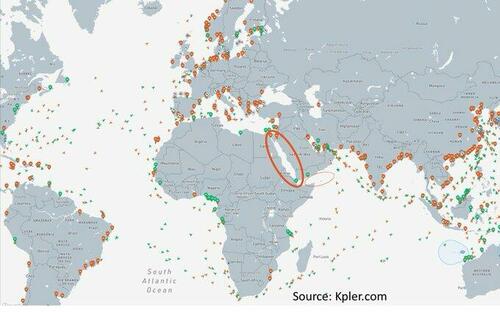
Using Bloomberg data, Alhajji's map is correct when searching for LNG tankers with an end destination in North America, South America, Central America, Eastern Europe, Western Europe, Australia, and Oceania.
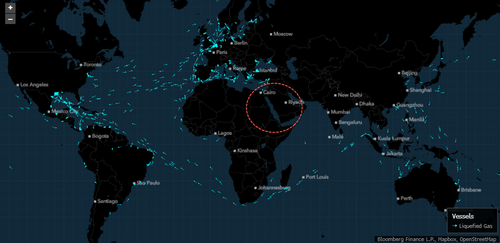
Alhajji explained LNG tankers are avoiding the southern Red Sea for two reasons:
- Carries are super expensive and fairly new relative to average oil tankers
- Insurance premium is very high
Analyst Andreas Steno Larsen responded to Alhajji's post, "Not really news? It has been like that for a while."
However, continuous Houthi attacks disrupting the critical shipping lane, which accounts for 12-15% of global trade and 20% of international container shipping, only indicates that shipping companies must continue to rejigger routes that are more costly and longer. These extra costs will only feed into global inflation.
With President Biden's Operation Prosperity Guardian mission failing, there is no immediate solution to resolve the Red Sea crisis.
In a recent interview, former Supreme Allied Commander at NATO, Adm. James Stavridis, told Goldman's Allison Nathan, "In my career, I've never seen a higher level of maritime risk than I do today. That owes first and foremost to the return of great power competition, which we thought was basically over when the Soviet Union collapsed."

Three decades after the Cold War ended, conflicts rage across Ukraine, Gaza, the Red Sea, Myanmar, the Sahel, Sudan, and potentially Taiwan and Iran. The rules-based system of international relations modeled on America's liberal-democratic values is crumbling as the world stumbles into a nascent multipolar era.
With conflict only expected to worsen, David Asher, a senior fellow at Hudson Institute, has warned about increasing risks that Saudi Arabia's refineries could come under drone and or missile attack by Houthi rebels and spark a global financial shock.
|
|
[]
Maryland Bravely Leads the Fight to Keep Porn in Public School Libraries
Published:3/16/2024 10:11:07 AM
|
[Markets]
Childless China: Coercive Population Plan Implodes
Childless China: Coercive Population Plan Implodes
Authored by John Miltimore via The American Institute for Economic Research,
Kenneth Emde of Minnesota, who came of age during the Swinging Sixties, recently explained why he is childless today.
“I was a college student when I read [Paul] Ehrlich’s The Population Bomb,” he said in a letter published by the Wall Street Journal.
“I took it to heart and now have no grandchildren, but 50 years later the population has increased to eight billion without dire consequences. I was gullible and stupid.”
Emde might have been gullible, but that doesn’t make him stupid.
Countless people were swept up by the maelstrom of fear created by Ehrlich’s 1968 book, which predicted mass famine due to a coming “population explosion.”
The Population Bomb was omnipresent on college campuses in the late 1960s and early ’70s and received a massive amount of media attention because of its scary subject matter. (Three decades after it was published, I was assigned the book as an undergrad in college.) Ehrlich, who at the time was young, telegenic, and breezily confident, was happy to talk about his book on TV and offer social “remedies.”
His solution to the population bomb began with government-sponsored propaganda designed to convince Americans that no patriotic family would have more than two children (“preferably one”).
“You ought to make the [Federal Communications Commission] see to it that large families are always treated in a negative light on television,” Ehrlich told an interviewer in 1970.
“There ought to be a tremendous amount of television time devoted to spot commercials, the sort we’ve had against smoking.”
If that failed to move the needle, Ehrlich said, the government should use the tax structure to disincentivize women from having children and offer financial bonuses to women who forgo motherhood.
“If that doesn’t work, then you’ll have the government legislate the size of the family,” Ehrlich calmly continued.
“If we don’t get the population under control with voluntary means… the government will simply tell you how many children you can have and throw you in jail if you have too many.”
Watching the interview today, it’s easy to dismiss Ehrlich as a cocky and kooky peddler of Malthusianism, a school of scarcity economics popularized by doomsayer Thomas Malthus (1766–1834), an English economist who made similar dire population predictions in the early 19th century (and, more recently, by Thanos in the Marvel movies.)
Ehrlich’s predictions on population and famine were just as wrong as Malthus’s, and thankfully his ideas were never implemented in the United States.
But others paid attention to Ehrlich’s warnings, and not just college students like Kenneth Emde.
The Origins of China’s One-Child Policy
Seven years after the publication of Ehrlich’s book, a Chinese military scientist named Song Jian visited the University of Twente in the Netherlands as part of an academic delegation to the Dutch university.

During his visit Song met a Dutch mathematician named Geert Jan Olsder who had written papers on population control, including a 1973 paper titled “Population planning; a distributed time optimal control problem.” Much like Ehrlich, Olsder believed that an “optimal” birth rate could be achieved through centralized planning.
“Given a certain initial age profile the population must be ‘steered’ as quickly as possible to another, prescribed, final age profile by means of a suitable chosen birth rate,” Olsder wrote.
In a recent Wall Street Journal interview, Olsder recalled how he told Song, who’d pioneered China’s anti-ballistic missile system, his research had been inspired by “warnings about finite global resources and how mathematical models could be applied to birthrates.”
The podcast Freakonomics summarized Olsder’s recollection of their first meeting (the men would meet again a few years later in Finland).
“According to Olsder, they went out for beers and talked about population planning,” wrote Bourree Lam.
“Olsder thought nothing of it.”
The meeting apparently had a much deeper impact on Song, whose expertise in cybernetics translated well, he believed, to the field of population modeling. After the trip, Song began working with other scientists on his demographic projections, and by 1980 he was presenting reports to officials of the Chinese Communist Party predicting China would have more than 4 billion people by the approach of the 22nd century.
Susan Greenhalgh, the John King and Wilma Cannon Fairbank Research Professor of Chinese Society in the Department of Anthropology at Harvard University, traces China’s notorious one-child policy directly to Song.
Writing in The China Quarterly in 2005, Greenhalgh pointed out that elite scientists like Song, aerospace engineer Qian Xuesen, and nuclear physicist Qian Sanqiang had tremendous prestige and influence in China. This gave Song “the scientific, political, and cultural resources and the self-confidence to redefine the nation’s population problem, create a radically new ‘scientific’ solution to it, and persuade China’s leaders that his policy of one child for all was the only way out of China’s demographic impasse.”
If one doubts Greenhalgh’s claims, it’s worth noting that Song himself claimed credit for inspiring China’s one-child policy.
“[Our 1980 projections] shocked the scientific circles and politicians,” he wrote in a 1995 article, “[leading the government to] follow a policy of ‘one child system.’”
China’s One-Child Policy: A Total Failure
Whether there is a straight line from Ehrlich to Olsder to Song is not certain.
What is clear, however, is that Song was a key leader in the Chinese central government’s pivotal meeting in Chengdu in March 1980 to discuss the scope and details of what had already become China’s new policy: citizens should have just one child. (As early as October 1979, Deng Xiaoping, the communist leader of China, had informed members of a British delegation in Beijing of China’s “one-child policy.”)
China’s one-child policy proved to be not just a moral abomination but a total failure, something even Chinese Communist Party officials seemed to recognize long before the policy was officially rescinded in 2016.
Though near-universal one-child restrictions were codified into China’s constitution in 1982, the policy’s history is peppered with rollbacks and exceptions that began as early as 1984. These included allowing some parents to have a second child if the first was a daughter, and allowing exemptions for some provinces and ethnic groups.
By the 2000s, Communist officials seemed to realize they had a new problem on their hands: a birth shortage. Models began to show an ominous drop in population, portending severe economic problems down the road.
More exemptions to the one-child policy followed. Then, in 2015, the Chinese government announced it was lifting its cap to allow two children per family. By 2021, it was three. Soon thereafter there were no procreation restrictions at all.
Today, China’s government is offering various incentives to get citizens to procreate. Researchers at Shanghai Academy of Social Sciences and Victoria University recently told the Journal that China is projected to have just 525 million people by 2100, a collapse of more than 60 percent of its current population (1.4 billion).
“Our forecasts for 2022 and 2023 were already low but the real situation has turned out to be worse,” Xiujian Peng, a fellow at Victoria University who leads research on China’s population, told the paper.
Forced Sterilization and Abortion Quotas
The moral problems with China’s one-child policy were apparent from the beginning.
Though Ehrlich may not have received the memo, international human rights groups since the 1960s had declared in charters that “parents have a basic human right to determine freely and responsibly the number and the spacing of their children.” The Communist regime in China cared little for such rights, which resulted in its gruesome and well-documented enforcement practices: forced sterilization and abortion quotas in regions that ignored the policy.
While many people across the world were rightfully appalled by these practices, few today realize how widely these practices were embraced by prominent institutions in the West.
Ehrlich’s book had created a moral panic. By preposterously predicting that “England will not exist” by 2020 and tens of millions of Americans would soon starve because of unfettered population growth, officials within some of the most powerful institutions in the West — the World Bank, the Ford Foundation, the Swedish International Development Authority, and the Rockefeller Foundation — began advocating forced sterilization, a policy supported by Ehrlich.
Douglas Ensminger, a representative of the Ford Foundation in India, worked directly with government officials there to create the infrastructure to forcibly sterilize millions in one of the worst human rights violations in modern history.
According to the BBC, an astounding 6.2 million men — mostly poor ones — were sterilized in a single year, far exceeding any of the sterilization efforts led by the Nazis during World War II.
For various reasons—including the fact that both countries were far poorer and more populous—the population control policies took place in China and India at a scale they did not in the United States.
This isn’t to say population control efforts didn’t occur in America; they did. But these efforts ran into more resistance in the US (see Buck v. Bell), largely because the American system is designed to curb the erosion of rights that such efforts inevitably require.
The smooth-talking Ehrlich might have been able to convince men like Emde and Ensminger that population control was a moral imperative, much like the brilliant military scientist Song was able to convince Communist officials that unchecked procreation was a dire threat. But widespread population-control policies proved more difficult to sustain in the US and remain a non-starter today at the federal level because of the American system’s emphasis on limited government, individual rights, and the separation of powers.
Where those protections were weaker (in minority communities, prison, and mental asylums) population control “experts” had some success in states pushing sterilization efforts with devastating results.
As recently as the early 2000s, California was running a sterilization program for inmates in state prisons. The American conception of individual rights can be fragile, especially in the face of moral panic created by doomsayers preaching the latest apocalypse.
A Dying Dragon and the Perils of Planning
Despite growing fears in the West of the “Red Dragon Rising,” China’s coming population collapse raises serious doubts about its economic future. The Chinese government’s policies designed to incentivize procreation might manage to reverse the decline, but such an outcome is unlikely.
“History suggests that once a country crosses the threshold of negative population growth, there is little that its government can do to reverse it,” the New York Times recently observed in a report on China’s demographic plight.
That China’s downfall stems from its own collectivist policies is no small irony, but it should come as no surprise. It stems from the same flawed thinking that led to the fall of the last communist empire: the Soviet Union.
Both systems suffered from the fatal conceit that central planners can effectively engineer society if they’re only given the proper coercive tools to do so.
Central planners are not omniscient, and this is evidenced by China’s own policies.
“In the last 80 years China has swerved from pro-natal sentiment, to anti-natal sentiment, to anti-natal policy, to pro-natal sentiment, and likely to pro-natal policy soon,” wrote economist Peter Jacobsen.
The only thing consistent in China’s schizophrenic approach to population control over the last century is this: central planners, not individual families, get to decide how many children people should have.
Call this what you will, but it’s not science.
“Planning other people’s actions means to prevent them from planning for themselves, means to deprive them of their essentially human quality, means enslaving them,” economist Ludwig von Mises once observed.
China is paying the price for its barbaric and byzantine policies.
|
|
[Entertainment]
Washington Post hardcover bestsellers
A snapshot of popular books.
Published:3/13/2024 8:09:57 AM
|
[Markets]
Writer Ridiculed For Asking "Where Are The Black People?" In Ancient Japan Samurai Show
Writer Ridiculed For Asking "Where Are The Black People?" In Ancient Japan Samurai Show
Authored by Steve Watson via Modernity.news,
A writer for lefty woke outlet Medium is facing ridicule for penning an article complaining about the lack of black actors in a new TV show about Samurai warriors in Japan in the year 1600.

The show, produced by FX, is a remake of the popular Shogun series from 1980, which also featured no black actors.
Because it’s about ancient Japan.
The network’s guide to the series states “FX’s Shogun, based on James Clavell’s bestselling novel, is set in Japan in the year 1600, at the dawn of a century-defining civil war. Lord Yoshii Toranaga (Hiroyuki Sanada) is fighting for his life as his enemies on the Council of Regents unite against him, when a mysterious European ship is found marooned in a nearby fishing village.”
There are European people in the series too, because Europeans travelled to Japan in boats at that time.
Japanese and Europeans, but no blacks? Medium writer and critical race theorist William Spivey cannot abide that.
He writes “The white characters appearing in the first episodes representing Portugal, Spain, England, and Holland could hardly be deemed heroic. However, the character John Blackthorne, now played by Cosmo Jarvis, is already a pivotal figure and will be a hero, along with several Japanese characters.”
Oh no! the horror.
” I ask the question now that I naively didn’t ask in 1980. Where are the Black people?” he adds.
In Africa, that’s the short answer. But no, Spivey isn’t done. He goes on to claim that there absolutely were black people in Japan in 1600 and some of them were Samurai warriors.
“I don’t ask out of a desire to see representation when it wasn’t historically accurate. I inquire because there were Black people in Japan in 1600 and before, though Japan could teach Florida a thing or two about rewriting history,” he claims.
Spivey continues, “According to multiple sources, one of the early real-life Shoguns, Sakanoue no Tamuramaro (758–811), was Black, though denied by others. There is a consensus he was something other than pure Japanese, and he is often considered descended from the Ainu, the darker-skinned indigenous people of northern Japan who were subjected to forced assimilation and colonization.”
Not content with that unverifiable and inaccurate claim, he made up a ‘Japanese’ proverb, that goes “For a Samurai to be brave, he must have a bit of Black blood.”
Note Spivey’s capitalisation of the word ‘black’. This proverb, if it exists at all which it likely doesn’t, is not referring to black people, but rather darkness of the soul.
Respondents, including black people, pointed out that all of this is nuts and yet another example of the insane fringe effort to blackify history, which has included baseless claims of black ancient Britons, Romans, scholars, Mesolithic hunter-gatherers, and the list goes on.
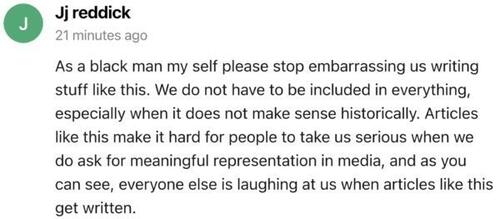
* * *
Your support is crucial in helping us defeat mass censorship. Please consider donating via Locals or check out our unique merch. Follow us on X @ModernityNews.
|
|
[Ridiculae]
Inside a 2074 Climate Fantasy
"... We had bigger things to worry about, like whether drag queens should have been allowed to read books to children ..."
Published:3/12/2024 12:42:30 AM
|
[Markets]
Gold & Bitcoin At Record Highs Are "Huge Dollar No-Confidence Vote" - Rubino Warns US Financial Death Spiral Is "Inevitable & Imminent"
Gold & Bitcoin At Record Highs Are "Huge Dollar No-Confidence Vote" - Rubino Warns US Financial Death Spiral Is "Inevitable & Imminent"
Via Greg Hunter’s USAWatchdog.com.
Analyst and financial writer John Rubino warned nearly four months ago of a “U.S. Financial Death Spiral.”
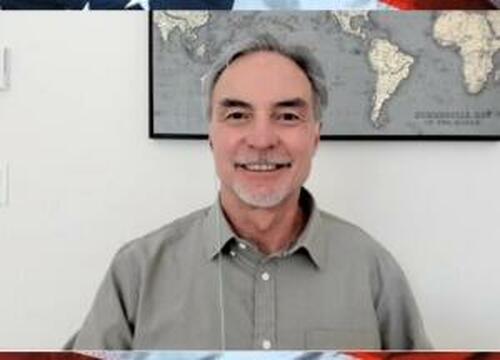
This past week, Bank of America caught up to Rubino and issued a warning about a “US dollar death spiral” because the federal government was going deeper in the red by creating “$1 trillion in new debt every 100 days.”
Maybe this is why gold and Bitcoin have been hitting new all-time highs day after day. Rubino says, “When a building was worth $200 million and someone sells it for $48 million, that means there is a loss that someone has to take. Those losses are mostly on the books of regional and local banks. So, they are in big trouble financially..."
"You will get these massive bank runs that the government will have to step in and bail out. This is one of many things that will happen in the not-so-distant future. This will impact government finances in a scary way that will send people’s attention to the currency. In other words, if we have another $3 trillion bailout on top of everything else that’s going on . . .what is that going to do to the dollar?
...Currencies are being inflated away with all these bailouts, deficits, wars and all these things that are going on that are bad for the currency. So, people start selling government bonds, which push up interest rates and blows up even more bad real estate and paper . . . until you get a debt spiral, a real live financial death spiral than cannot be fixed...
I was talking to a real estate guy the other day, and he said this is not just inevitable, it is imminent. It is happening now. It is happening quickly, and it is going to hit the headlines...
In this case, what is inevitable in commercial real estate is also looking imminent.”
Rubino goes on to say, “The numbers are not lost on the guys running the big investment banks and the big media outlets. They are sitting around, and they are thinking we have to say something about this because this is obviously a very big financial story. So, we have to report on it. Finally, the numbers have gotten big enough with the deficits and government interest costs..."
"...that this is a story that cannot be ignored anymore. It’s got to be pretty far along before they reach that point because they really don’t want to report on this. To report on this is seen as a betrayal of the establishment, and they are part of the establishment. They are playing on that team. The debt numbers are finally big enough that they can’t be ignored anymore, and that implies that we are getting near the end of the road.”
Gold and Bitcoin both hit all-time new highs this past week. What does it mean? Rubino explains,
“This means the market is speaking, and it’s concluding these currencies have a problem. Capital is flowing into the alternatives. It’s flowing into the old kind of money that has held up for thousands of years like gold or the possible new kind of money like Bitcoin that has come on relatively recently (when compared to gold)...
In either case, it is a vote against the dollar. When gold and Bitcoin are both spiking, it is a big vote of no confidence in the dollar.”
In closing, Rubino says, “There is no way to know how this plays out in the next six months, but this should terrify the central banks."
" By the way, the big central banks are behaving as if they are terrified because they are aggressively buying gold. They have bought about 1,000 tons of gold in each of the last two years. 1,000 tons is a fourth of the gold that comes out of all the gold mines in a given year. So, that is a major purchase, and they take the gold off the market. They don’t turn around and sell it. They put it away as a reserve asset. The gold is effectively disappearing. This makes the market even tighter, and this is also part of the reason why gold is going up.”
There is much more in the 42-minute interview.
Join Greg Hunter as he goes One-on-One with financial writer John Rubino and his new enterprise called Rubino.Substack.com for 3.9.24.
To Donate to USAWatchdog.com Click Here
John Rubino is a prolific financial writer, and you can see some of his work for free at Rubino.Substack.com. There is even more cutting-edge original information and analysis if you subscribe.
|
|
[Politics]
Exploits of the Ex-Presidents
Increasingly our best works of American history are being authored by writers who've never attended a faculty meeting. Add to that list Jared Cohen, president of global affairs at Goldman Sachs, who has published half-a-dozen books, including the 2017 bestseller Accidental Presidents, which chronicled the men who ascended to the Oval Office after the deaths of their elected predecessors.
The post Exploits of the Ex-Presidents appeared first on Washington Free Beacon.
Published:3/10/2024 4:33:09 AM
|
[Markets]
University Of Virginia Spends $20 Million On 235 DEI Employees, With Some Making $587,340 Per Year
University Of Virginia Spends $20 Million On 235 DEI Employees, With Some Making $587,340 Per Year
By Adam Andrzejewski of Open The Books substack
The University of Virginia (UVA) has at least 235 employees under its “diversity, equity and inclusion (DEI)” banner — including 82 students — whose total cost of employment is estimated at $20 million. That’s $15 million in cash compensation plus an additional 30-percent for the annual cost of their benefits.
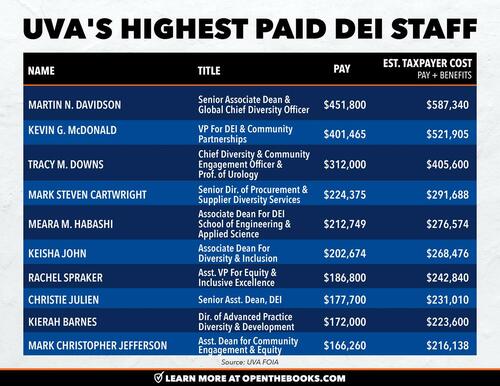
In contrast, last Friday, the University of Florida dismissed its DEI bureaucracy, saving students and taxpayers $5 million per year. The university terminated 13 full-time DEI positions and 15 administrative faculty appointments. Those funds have been re-programmed into a “faculty recruitment fund” to attract better people who actually teach students.
No such luck for learning at Virginia’s flagship university – founded by Thomas Jefferson no less. UVA has a much deeper DEI infrastructure.
Reform or abolition must await this summer’s anticipated changes in the school’s Board of Visitors. At least until then, the very highly compensated, generally non-teaching, DEI staffers are safely embedded throughout the entire university – while costing students and taxpayers a fortune.
Our team of auditors at OpenTheBooks.com reviewed the university payroll file for 2023 to sort out the DEI position head counts, compensation, and then estimated the cost of benefits.
Meet The Top Paid DEI Executives
Martin N. Davidson, senior associate dean of the Darden School of Business & global chief diversity officer, earns the most in a DEI role, at $452,000, or $587,340 including benefits. For comparison, Glenn Youngkin, the governor of Virginia earned $175,000.
The second most highly compensated DEI executive is Kevin G. McDonald, the vice president for diversity, equity, inclusion and community partnerships, who takes home $401,465, or an estimated $520,000 with benefits.
Those in DEI leadership roles such as vice presidents, associate/assistant deans, directors, assistant directors and managers earned up to $312,000 last year, or $400,000 with benefits.
When McDonald began in his position in August 2019, he was making $340,000, eligible for a 10-percent bonus every year. His first year, he was given a $25,000 recruitment bonus and up to $30,000 for relocation costs, according to UVA records provided through the Virginia Freedom of Information Act.
Some of the DEI chiefs have been transparent about their philosophies during their public comments. For example, Rachel Spraker, an assistant vice president for equity & inclusive excellence – where she earned $186,800 last year or $242,840 with benefits – described the opioid epidemic in Appalachia as an example of “white toxicity.”
DEI staff aren’t the only well-paid employees in controversial roles at UVA.
Lanice Avery, an assistant professor of psychology in the departments of Psychology and Women, Gender and Sexuality, makes $102,200 ($132,860 with estimated benefits). She runs the Research on Intersectionality, Sexuality, and Empowerment (RISE) Lab at UVA and writes and speaks about black, female sexuality, and describes herself as a “board-certified sexologist” and speaks online about her orgasms.
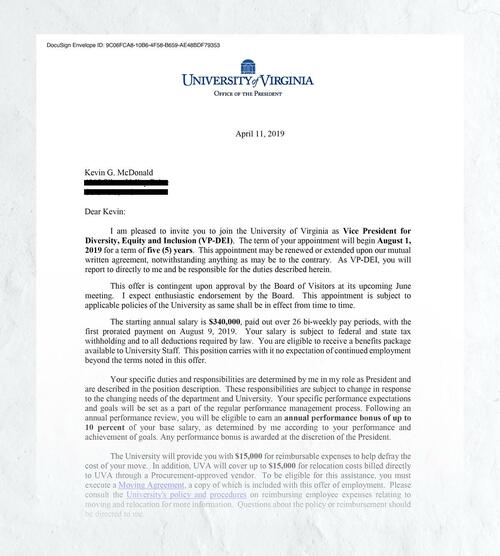
UVA’s DEI Infrastructure
What does the DEI bureaucracy do?
There are 187 UVA employees and students dedicated to “assist and monitor all units of the University in their efforts to recruit and retain faculty, staff, and student from historically underrepresented groups and to provide affirmative and supportive environments for work and life…”
Here are some of the university agencies committed to the DEI mission. If you think you are seeing double in this list, you are right:
- Equity Center (110 employees total: 37 employees +73 students),
- Office for Diversity, Equity and Inclusion (17 employees +1 student),
- Multicultural Student Services (6 employees +10 students),
- Office of Diversity & Engagement (3 employees + 4 students)
- Center for Diversity (4 students)
Included in the DEI employment roster are another 31 people working in DEI roles sprinkled throughout other departments, including the Urology Department, in Occupational Programs, for the School of Engineering and Applied Science, and other areas.
Then, there are another 48 employees and students working in roles related to DEI and advancing equality for women, minorities, etc.
- Maxine Platzer Lynn Women’s Center (21 employees, including 4 undergrad students/interns)
- Office of Equal Opportunity and Civil Rights (16 employees working on Title IX compliance, sexual misconduct investigations and Americans with Disabilities Act compliance, among other things)
- Office of African American Affairs (4 employees)
- Center for Global Health Equity (4 employees and 3 student employees working on providing health services to mostly Third World countries)
Not included in the DEI numbers for this investigation were the Women, Gender and Sexuality Department with 10 professors making a collective $857,103 last year ($1.1 million with benefits) and the Psychology Department with 87 employees making $8.4 million ($11 million with benefits).
Adding to the confusion, the university has consistently undercounted DEI staffers in presentations to the public. In April 2023, Kevin McDonald told the New York Times that UVA had only 40 DEI employees. In May 2023, a presentation to the Board of Visitors claimed UVA had only 55 DEI positions.
Even our list of 235 employees is not complete. Here is a great example of an executive with a hidden DEI mission:
Kimberley Barker, Librarian for Digital Life ($80,000, or $104,000 with benefits). Barker isn’t in our database, however, she is the DEI leader for the Health System Library – the “IDEA (Inclusion Diversity Equity Accessibility) lead. Her university bio page lists her as the “Librarian for Belonging and Community Engagement.”
Summary
UVA was founded by Thomas Jefferson, the author of our Declaration of Independence. Jefferson’s work presented the moral case for a common freedom among all men. The university has an historic opportunity to promote the time-tested principles:
“We hold these truths to be self-evident, that all men are created equal, that they are endowed by their Creator with certain unalienable Rights, that among these are Life, Liberty and the pursuit of Happiness…”
But, instead of working towards the ideal of the Shining City on the Hill under Jeffersonian principles, his university embraced the divisive quotas of the neo-Marxist DEI crowd.
Tens of millions of dollars in student tuition and taxpayer monies are flowing into promoting anti-American notions and radical philosophies that judge the color of one’s skin instead of the content – and competence – of their character.
Students, taxpayers and all who care about learning can look to Florida as the beacon of a new day. Perhaps Virginia, a birthplace of our Constitutional republic, home to birth places of individual rights and freedoms in America, will emulate the model.
|
|
[Politics]
Irony Alert: RuPaul's Online Bookstore Against Banning Books ... Bans Books From Conservatives
Published:3/8/2024 6:14:23 PM
|
[Markets]
"Banning Books Is Never The Answer": RuPaul's "No Censorship" Bookstore Lasted Just Three Days
"Banning Books Is Never The Answer": RuPaul's "No Censorship" Bookstore Lasted Just Three Days
Authored by Jonathan Turley,
It took just three days.
After drag performer RuPaul announced the creation of a “no censorship” Allstora bookstore, censorship was back with a vengeance after many on the left learned that free speech meant that opposing views might be sold at the site. While the sentiment was appealing, it became intolerable when activists noted that a “no censorship” store would mean that they could not censor others.

In the rollout, RuPaul stood in a blue suit before a flag to defy the censors and embrace access to works of different authors and viewpoints. For many of us, it was an exciting moment. The anti-free speech movement on the left has grown exponentially. Now, this iconic figure from the left was taking a bold stand for free speech.
With ten million titles, readers could buy most any book, including writers like Riley Gaines who have challenged transgender theories.
Various sites like National Review have covered the rise and rapid fall of the free speech initiative.
The rollout was promising. Like many of us, the founders objected to book bans across the country. Such bans have been implemented by both the left and the right.
Allstora was founded on the pledge that “We’re a marketplace for all books and all stories, with a focus on elevating marginalized voices.” Co-founder Eric Cervini and drag performer Adam Powell, welcomed visitors to the website with a pop-up message that warned “you may find books you disagree with.”
The site declared “censorship of any book, perspective, or story is incompatible with the survival of democracy.” After all, “banning books is never the answer.”
The pledge was heralded in the media. Many viewed it as a jab at conservatives to show that there is nothing to fear in access to opposing views.
Then someone thought about what free speech means.
Liberal critics raised the alarm that the bookstore would be selling “homophobic,” “transphobic,” and “anti-woke” works.
Drag performer “Lady Bunny” noted that the store would be selling works by figures like Mike Huckabee, Chaya Raichik, and Matt Walsh.
Lady Bunny asked “Why not just stop selling what many on the left consider to be hate speech?”
That is all that it took.
Allstora first implemented a flagging system for offensive books and then just got rid of the no censorship pledge.
While some sites state that Allstora only moved to add disclaimers, it appears that the no censorship pledge is gone and various authors are missing.
I searched for books by writers like Gaines and Matt Walsh and found nothing.
The obvious response to Lady Bunny is that she is the answer to her question. In the name of combatting hate speech, she is embracing the very tool used by the most hateful movements in history from book burning to black listing of opposing views. Censorship becomes insatiable as the list of offensive topics or views grows from transgender politics to climate change to abortion. Every advocacy group finds opposing its own views to be dangerous and harmful.
It is analogous to what Gandhi said about vengeance: “An eye for an eye leaves the whole world blind.” The same is true about censorship. Eventually it leaves the whole world ignorant.
|
[Markets]
Stretched Markets Hint At A Pause But "No Panic"
Stretched Markets Hint At A Pause But "No Panic"
By Michael Msika, Bloomberg Markets Live reporter and analyst
Markets are showing signs of consolidation after a powerful four-month rally on both sides of the Atlantic. Stretched positioning means a breather may be in order, but major reasons to sell are still absent.
Investors have been increasing their exposure to stocks, yet market breadth looks ok, with a still-narrow rally leaving scope for equity gains to broaden out. While the Stoxx 600 is hovering near overbought levels, only about 15% of individual members are actually overbought.
According to Goldman Sachs, this narrow breadth isn’t a worry when looking at history, as the rest of the market tends to catch up with the handful of stocks that have led the rally. Yet, it could trigger some episodes of volatility.
“Investors sometimes worry that this may pave the way to a market drawdown, but it does not always,” say Goldman strategists including Lilia Peytavin. Twelve-month aggregate equity returns are positive in 71% of instances following narrow rallies, with an average return of about 8%. Still, “when there is a drawdown, it tends to be deeper.”
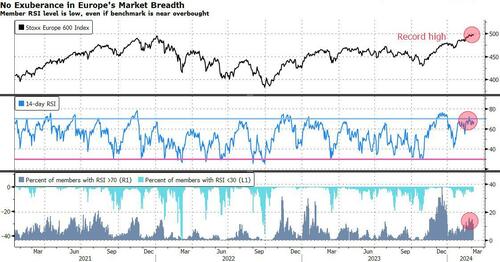
Looking at our thematics dashboard, there’s been a bit of rotation away from the hedge fund crowded trades and the Magnificent 7 recently, and toward higher risk themes like most shorted, debt sensitivity and high beta. The overall picture is of high upward momentum with more overbought flags appearing.

Things are looking a bit more stretched in futures, with Citi quant strategist Chris Montagu saying investors have a “complete disinterest in taking a bearish view.” Futures positioning reflects markets “that are both extended and turning increasingly one-sided,” he says, adding that bullish positioning in Nasdaq futures is near the highest in three years, while high levels of profit on Euro Stoxx 50 and DAX long positions creates an elevated risk of profit taking.
For Deutsche Bank strategists, equity positioning is “well above average but not yet extreme.” Gains are supported by strong data and rising economic forecasts, while big buyback announcements are spurring demand for stocks, they say. Meanwhile, volatility control funds have continued to increase exposure to equities, something that Tier1Alpha strategists say has been a tailwind.
“Vol control funds added an additional $7 billion in buying requirements to their books last Friday, bringing the two-day total to just over $30 billion,” the strategists say, noting this has created an upward bias in a low volatility regime. They expect favorable conditions to remain in place for at least the first half of this week as vol control funds catch up on their residual rebalancing. After that, there may be some modest selling before fresh inflows around the middle of March.

While there’s no panic out there, risks of a short-term pullback have increased, so thinking about hedging may not be a bad idea, especially as volatility continues to be sold in both the US and Europe. What’s more is that hedging opportunities look attractive, both on a short and longer-term basis.
“One-month ATM volatility on both the Stoxx 600 and the S&P 500 is low vs. the past 5-year history, providing cheap hedges in case of a reversal,” according to Goldman strategist Cecilia Mariotti. Meanwhile, Bank of America strategists recommend that investors “lock in long-term lows in US and EU equity volatility where derivatives most underprice markets’ ability to drift.”
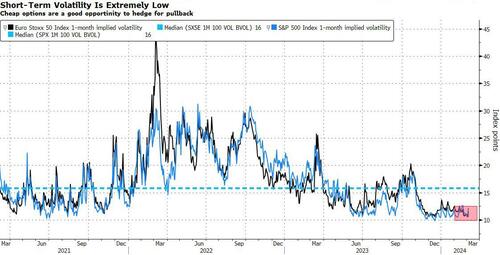
|
[Markets]
Alteration Of Gut Microbiota Affects The Severity And Complications Of COVID-19
Alteration Of Gut Microbiota Affects The Severity And Complications Of COVID-19
Authored by Elllen Wan via The Epoch Times (emphasis ours),
Increasing evidence suggests that alterations in the gut microbiota are associated with the development, severity, and sequelae of COVID-19 infection.
In the adult digestive tract, there are approximately 100 trillion microbes, 10 times the number of human cells, and they weigh about 4.41 pounds. These organisms are immune system guardians and can help remove viruses.
 (Alpha Tauri 3D Graphics/Shutterstock) (Alpha Tauri 3D Graphics/Shutterstock)
Certain Gut Bacteria Can Inactivate COVID-19 Virus
In a new study published in Cell Host & Microbe, researchers evaluated the impact of gut microbiota composition on respiratory viral infections through animal experiments. The results showed that segmented filamentous bacteria (SFB) in the gut could protect mice from viral influenza, respiratory syncytial virus (RSV), and the COVID-19 virus.
Studies have indicated that SFB, whether naturally present or acquired, can combat viral infections with the help of alveolar macrophages in the lungs.
Alveolar macrophages serve as the first line of defense against respiratory pathogens.
In mice that don’t have SFB, these immune cells were rapidly depleted as infection progressed. Conversely, in mice with SFB in the gut, these immune cells underwent alterations to resist the inflammatory signaling induced by the influenza virus. Moreover, alveolar macrophages directly disabled the influenza virus.
Gut-Lung Axis
While the functions of the gut and lungs are different, they share common structural features, as they both develop from the same embryonic tissue. Both the gut and lungs are covered with mucous membranes. These membranes secrete mucin and collectively form a mucosal immune system that defends against pathogens.
As research on COVID-19 progresses, some researchers have noted the bidirectional and complex relationship of the gut-lung axis. Microbiota-derived metabolic pathways can function distally and play a vital role in anti-inflammatory responses in the airways.
The SFB are unlikely to be the only kind of gut microbe capable of affecting the immune cells in the lungs, said Dr. Andrew Gewirtz, a co-senior study author, in a press release.
Dr. Richard Plemper, a co-senior author of the paper, said that among the thousands of microbial species inhabiting the mouse gut, a common commensal microbe significantly impacted respiratory virus infections. He further stated that if these findings apply to human infections, they could have substantial implications for the risk assessment of disease progression in patients.
Research has shown that alterations in the gut microbiota, including changes in specific microbiota species and microbial-derived metabolites, play an important role in regulating the severity and progression of COVID-19 infection and post-recovery complications.
Viral Respiratory Tract Infection Affects the Gut Microbiota
An analysis of fecal samples from 102 patients with severe COVID-19 infection following ICU admission found that decreased concentrations of gut microbiome metabolite—secondary bile acids and desaminotyrosine—were associated with an increased risk of respiratory failure and mortality.
Another study revealed that patients infected with COVID-19 showed a decrease or depletion of bacteria with immune-regulating capabilities in the body, such as Faecalibacterium prausnitzii, as well as some bacteria from the Lactobacillus and Bifidobacterium families.
Additionally, respiratory virus infections are often observed in patients undergoing hematopoietic stem cell transplantation. Microbiota analysis of these patients showed that those with reduced levels of commensal bacterial species producing butyrate had a fivefold increase in the progression of viral respiratory tract infections.
Enhancing Gut Health to Build Robust Immunity
The intestinal tract, the largest immune organ in the human body, plays a crucial role in establishing and maintaining a robust immune system, and gut immunity is closely linked to our diet.
Probiotics are beneficial bacteria for the gut and are relatively safe health supplements. A retrospective cohort study showed that COVID-19 patients treated with probiotics had a shorter time to clinical improvement, including reduced fever, hospital stays, and viral shedding. Another study also indicated that probiotic treatment significantly shortened the duration of diarrhea in critically ill COVID-19 patients.
BMJ Nutrition, Prevention & Health published a study in 2021 analyzing the effects of dietary habits on COVID-19 infection, severity of symptoms, and duration of the illness.
The study covered 2,884 frontline health care workers from six different countries, investigating their dietary habits and the severity of COVID-19 infection. The results showed that participants who followed either a plant-based or pescatarian diet (where a person doesn’t eat meat but eats fish) had a 59 percent lower odds of developing moderate to severe COVID-19 than those who did not.
|
|
[Education]
Critics of ‘Banning’ Books Are Wrong: They’re Not All Suitable for Kids
Our English teachers taught us to use extreme caution before writing a word such as “always” or “never.” Such totalizing words are rarely accurate, since... Read More
The post Critics of ‘Banning’ Books Are Wrong: They’re Not All Suitable for Kids appeared first on The Daily Signal.
Published:3/6/2024 3:29:52 PM
|
[Markets]
NYCB Announces $1BN Equity Infusion, Fmr Tsy Sec Mnuchin Joins Board
NYCB Announces $1BN Equity Infusion, Fmr Tsy Sec Mnuchin Joins Board
Update (1410ET): Having seen shares collapse over 40% before being halted for 'news pending', we have the news...
Bloomberg reports that New York Community Bancorp plans to announce an equity investment of more than $1 billion led by Steven Mnuchin’s Liberty Strategic Capital, Hudson Bay Capital and Reverence Capital Partners, according to a spokesperson for the bank.

Liberty will invest $450 million, Hudson Bay $250 million and Reverence $200 million as part of the transaction, the spokesperson said.
In connection with the deal, NYCB will reduce the board to nine members, adding new directors, including Mnuchin and Joseph Otting, former comptroller of the currency.
Secretary Steven Mnuchin stated:
"In evaluating this investment, we were mindful of the Bank's credit risk profile. With the over $1 billion of capital invested in the Bank, we believe we now have sufficient capital should reserves need to be increased in the future to be consistent with or above the coverage ratio of NYCB's large bank peers."
Non-Executive Chairman Sandro DiNello stated,
"We welcome the approach that Liberty and its partners took in its evaluation of the Bank and look forward to incorporating their insights going forward. The strategic investment involving former Secretary Steven Mnuchin, former Comptroller Joseph Otting and Milton Berlinski, along with the other institutional investors is a positive endorsement of the turnaround that is underway and allows us to execute on our strategy from a position of strength. We enter this next chapter with a strong balance sheet and liquidity position supported by a diversified and retail focused deposit base. Our new leadership team, with the support of the reconstituted Board, will continue to take the actions that are necessary to improve earnings, profitability and drive enhanced value for shareholders."
Secretary Mnuchin stated,
"We decided to make this investment because we believe Sandro, alongside new management, has taken the appropriate actions to stabilize the Company and to position NYCB to become a best-in-class $100+ billion national bank with a diversified and de-risked business model that supports long term profitability. We are delighted that former Comptroller Otting will be NYCB's new CEO and believe that the actions taken by NYCB establish a strong foundation for future growth through our new relationship with other new Board members and investors. We are confident that NYCB is poised to generate sustainable shareholder value."
The question, of course, is just how diluted the current equity holders just got...
* * *
And the hits just keep coming...
Once the darling of the small banking crisis comeback, New York Community Bancorp has crashed 45% to fresh 30 year lows after The Wall Street Journal reports the bank is seeking to raise equity capital in a bid to shore up confidence in the troubled regional lender.
According to people familiar with the matter, NYCB has dispatched bankers to gauge investors’ interest in buying stock in the company.
There’s no guarantee there will be a deal, or that one would succeed in addressing the bank’s challenges, which as of Wednesday morning had led to a roughly 80% decline in its stock price since January.
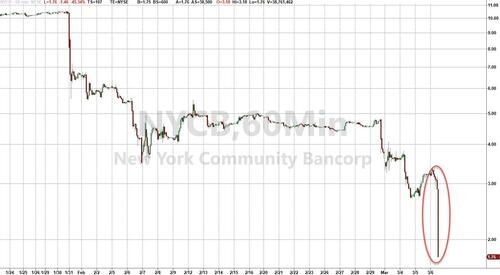
This is not a good picture for a bank... Would you hold your deposits there?
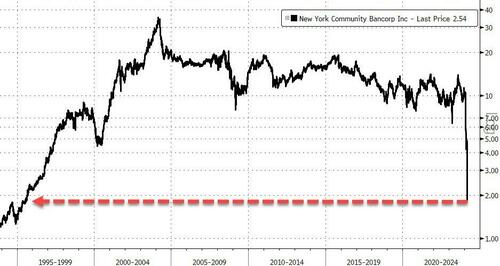
Last month, DiNello laid out a series of options the bank could explore to bolster its balance sheet, including selling assets from certain non-core businesses. The bank has also considered turning to newfangled financial instruments that would share the risks of those loans with outside investors, people familiar with the matter said.
As WSJ reports, finding takers for those assets, at least at prices that would make a deal worthwhile, has been challenging and U.S. officials have expressed reservations with banks pursuing credit-risk transfers that would shift the burden of potential losses to entities outside of the regulated banking system.
Finally, as a reminder, NYCB is not alone. The red line below shows 'small banks' are in trouble absent The Fed's BTFP facility...
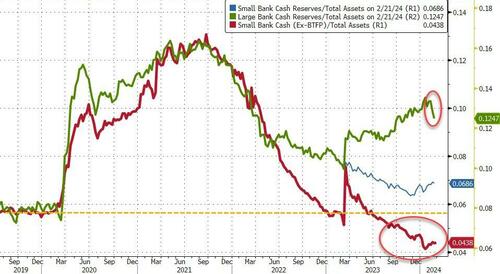
Oh, and this is fine...
And perhaps that's why the broad regional bank index is also getting hit today...
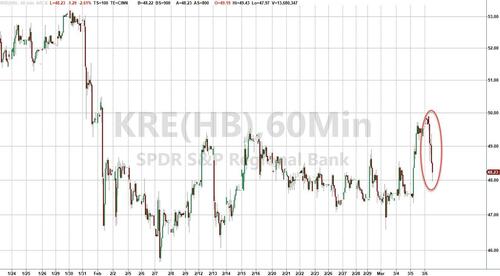
Beware the Ides of March as RRP liquidity evaporates.
Think this is isolated?
Think again.
As Chris Whalen details below via The Institutional Risk Analyst, the short answer as to what happens next is that we think that the bank may be sold, one way or another. The profitable Flagstar residential servicing business could be offered for sale in order to make a downpayment for the cleanup of the NYCB legacy multifamily portfolio. But in the wake of credit downgrades, NYCB itself may need to be acquired by another bank.
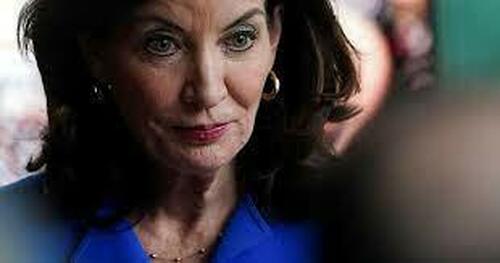
KBW said in a research note that NYCB could tap into its $78 billion in unpaid balances of mortgage-servicing rights to raise capital through a potential sale. The portfolio has a carrying value of $1.1 billion, analysts said. That is a mere downpayment, however, on a larger mess emanating from the bank's impaired multifamily assets.
Without an investment grade credit rating, banks cannot hold escrow balances for conventional or government loans. We cannot see how NYCB keeps the billions in conventional and government escrow deposits long-term. The whole Flagstar servicing platform and more than $300 billion in residential loan servicing, mostly for third parties like nonbank mortgage issuers, needs a new home.
Obviously the shareholders of Flagstar are coming to rue the decision to join forces with NYCB, an under-managed community bank with a portfolio of performing but ultimately unsalable multifamily assets. Thanks to the New York State legislature’s 2019 rent control law, which was supported by Governor Kathy Hochul, all banks in New York City that hold rent stabilized assets on the books are now capital impaired. Several of these banks in New York City may fail as a result of Albany's actions.
So who might acquire NYCB?
First, we take JPMorgan (JPM) and Wells Fargo (WFC) off the table. The former is already the largest residential mortgage servicer in the US and the latter is exiting the residential mortgage business with finality. The departure of Wells from residential mortgages is bad news for consumers and cause for glee among progressive cadres in the Biden Administration. In any event, neither bank wants any part of the Ginnie Mae sub-servicing book inside Flagstar.
Next is Citigroup (C), an intriguing possibility for a bank that badly needs new ideas and revenue streams. Citi has been in and out of residential mortgages for the past 50 years. In the 1980s, Citi introduced the first no-doc mortgage in the US market.
Since subprime consumer credit is a big part of Citi’s business, why not add a good sized residential mortgage business and get back into the housing finance game? There are few other industry segments that have enough size to matter to Citi. Flagstar is the number two warehouse lender after JPM. Overnight, Citi becomes the top bank servicer in the Ginnie Mae market and a significant issuer of MBS.
After Citi the obvious candidate for NYCB is U.S. Bancorp (USB), which is now the second largest residential bank loan producer after Chase. Although USB is still digesting the acquisition of Union Bank of California, they are a player in residential servicing and loan administration. USB could easily acquire the NYCB mortgage platform and billions in escrow deposits.
The idea of NYCB losing stable escrow deposits argues against the sale of the Flagstar mortgage platform and in favor of selling or recapitalizing the whole bank. But is this possible short of an FDIC intervention? Again, the actions taken by Albany in 2019 make NYCB and other New York banks unsalable short of an FDIC takeover.
If you are an investor looking at NYCB, the big question is the 40% of total loans and leases in multifamily assets. If NYCB were to either sell or risk-share a substantial portion of the rent stabilized multifamily assets, then the prospects for the business improve significantly. But given the disclosures about weak controls over loan underwriting, investors are going to be very cautious about making any assumptions on valuation. And risk-sharing is not yet broadly relevant for commercial assets.
Looking at the volume of risk-sharing deals done by banks so far, virtually all of the transactions are for consumer facing assets. Banco Santander (SAN) leads the pack on risk sharing auto and consumer loans. Commercial loans are far more difficult. Western Alliance (WAL) and Texas Capital Bank (TCBI) have done risk sharing deals in prime RMBS and warehouse loans, but commercial mortgages will likely be handled as customized, bespoke arrangements done on single loans. Selling the loans outright to hard money investors may be easier.
NYCB might want to consider creating a separate “bad bank” containing rent stabilized assets from the legacy NYCB to put pressure on Governor Hochul and the New York legislature to come and clean up their mess. Indeed, FDIC Chairman Martin Gruenberg ought to lead that discussion with Governor Hochul. His agency – and all the FDIC insured banks he represents – now hold the bag on billions in eventual losses on rent-stabilized Signature Bank commercial mortgage loans as well as loans held by other banks. The intemperate actions of the State of New York caused these losses.
We expect to see a number of creative structures being rolled out to address the impairment of multifamily commercial mortgages on the books of US banks. Risk-sharing is useful and can actually reduce the risk weighted assets of a bank and improve capital ratios, but at a cost to the bank in terms of income. Other techniques involve selling the low-coupon mortgage and replacing it with risk-free collateral that generates a similar cash flow, but frees up regulatory capital for other purposes.
Despite the promise of risk-sharing transactions, at the end of the day raising new capital and managing the delinquency may be a better approach. In the case of NYCB, raising new equity is not feasible. Indeed, any prospective buyer may demand some form of loss sharing from the FDIC on the multifamily book. If, for example, we assume a conservative 20% haircut on rent-stabilized buildings in NYC, many of the smaller institutions are insolvent.
That said, we would not be surprised to see an arranged marriage involving NYCB and a larger player that wants a bigger role in aggregating, selling and servicing residential mortgages. Even the likes of Goldman Sachs (GS), which has a significant presence in lending on residential warehouse loans and mortgage servicing rights, might find NYCB a compelling opportunity -- given the proper incentives from FDIC, of course.
Bloomberg columnist Max Abelson wrote an epitaph of sorts for NYCB this week:
"How NYCB got here is a tale of percolating financial risks, changing rules and shifting regulators. New rent restrictions became law in 2019, but instead of acknowledging a hit to its loan book, the bank got bigger. Back-to-back acquisitions, first Flagstar and then parts of Signature Bank, almost doubled the firm's size and set it on a collision course with new rules for banks holding more than $100 billion of assets."
We still own NYCB, but we strongly recommend that our readers stand clear until management gives shareholders a very specific roadmap to recovery. The economics of the bank's multifamily book are gnarly at best. Does the FDIC want to resolve another $100 plus billion asset regional bank? Hell no. Because the mess flows downhill, it may be time for creativity on the part of the FDIC and the State of New York.
FDIC Chairman Gruenberg ought to tell Governor Hochul and New York State to take over the rent stabilized loans from Signature, NYCB and other lenders or face an old fashioned FDIC liquidation as and when any banks fail. The number of public housing units in New York City will soar, placing enormous pressure on the city's finances. If the multifamily building cannot be financed by a bank, then the City of New York likely will end up as the owner.
Imagine if FDIC went "by the book" and next week sold all of the rent stabilized Signature Bank multifamily assets for whatever hard money bid is available. New York would face a political crisis. Governor Hochul and progressives in Albany caused this mess, which now threatens the solvency of a number of New York banks. The State of New York should take ownership of its fine work and repeal the 2019 rent control legislation.
|
|
[Entertainment]
Washington Post paperback bestsellers
A snapshot of popular books.
Published:3/6/2024 7:13:11 AM
|
|
[b2aaecf0-666c-574a-ad72-7ee5fdff21c1]
Louisiana becomes nation's 28th state with constitutional carry law on the books: 'landmark victory'
Republican Lousiana Gov. Jeff Landry signed a permitless carry bill into law on Tuesday, marking the 28th state in the nation with such laws on the books.
Published:3/5/2024 11:30:38 AM
|
[Markets]
'We Have Liftoff!' - Spot Gold Takes Out Record High
'We Have Liftoff!' - Spot Gold Takes Out Record High
Extending their run of the last few days, spot gold prices just exceeded their all-time highs, topping $2140 for the first time in history...
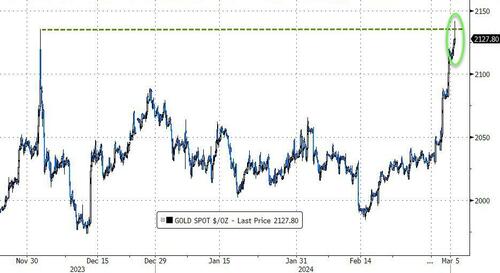
Source: Bloomberg
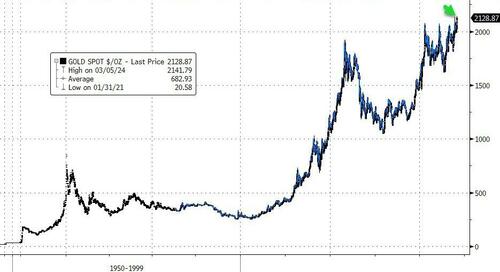
Source: Bloomberg
What is gold pricing in about future Fed action? Real rates dramatically negative?
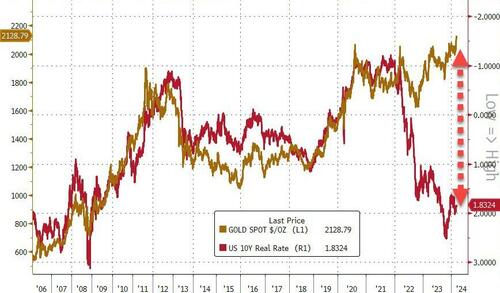
Source: Bloomberg
Paging Benoit?

As Egon von Greyerz details in his latest note, "we have liftoff", expect more to come...

All Empires die without fail, so do all Fiat currencies. But gold has been shining for 5000 years and as I explain in this article, Gold is likely to outshine virtually all assets in the next 5-10 years.
In early 2002 we made major investments in physical gold for our investors and ourselves. At the time gold was around $300. Our primary objective was wealth preservation. The Nasdaq had already crashed 67% but before the bottom was reached, it lost another 50%. The total loss was 80% with many companies going bankrupt.
In 2006, just over 4 years later, the Great Financial Crisis started. In 2008, the financial system was minutes from imploding. Banks like JP Morgan, Morgan Stanley and many others were bankrupt – BANCA ROTTA – (see my article First Gradually then Suddenly, The Everything Collapse)

Virtually unlimited money printing postponed the collapse and since 2008 US total debt has almost doubled to $100 trillion.
Gold backing of a currency doesn’t always solve a debt problem but it certainly makes it more difficult for the government to cook the books which they do without fail.
BONFIRE OF THE US BUDGET BOOKS
So tricky Dick (Nixon) couldn’t make ends meet in the late 1960s – early 70s partly due to the Vietnam war.
Thus in 1971 Nixon, by closing the Gold window, started the most spectacular bonfire of the US government budget books. How wonderful, no more accountability, no more shackles and no more gold deliveries to de Gaulle in France who was clever to ask for gold instead of dollars in debt settlement from the US.
So from August 1971, the US embarked on a money printing and credit expansion bonanza never seen before in history.
Total US debt went from $2 trillion in 1971 to $200 trillion today – up 100X!
Since most major currencies were linked to the dollar under the Bretton Woods system, the closing of the gold window started a global free for all with the printing press (including bank credit) replacing REAL MONEY i.e. GOLD.
The consequences of this “temporary” move by Nixon is that all Fiat or paper money has declined by 97-99% since 1971.
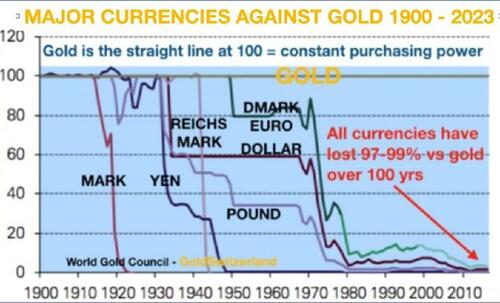
The price of assets have obviously inflated correspondingly. In 1971 total US financial assets were $2 trillion. Today they are $130 trillion, up 65X.
And if we include off balance sheet assets including the shadow banking system and derivatives, we are looking at assets (which will become liabilities) in excess of $2 quadrillion.
I forecast the derivative bubble and demise of Credit Suisse in this article (Archegos & Credit Suisse – Tip of the Iceberg) and also in this one (The $2.3 Quadrillion Global Debt Time Bomb).
HEADS, GOLD WINS – TAILS, GOLD WINS
Luke Gromen in his Tree Rings report puts forward two options for the world economy which can be summarised as follows:
1. Dedollarisation continues, the Petrodollar dies and gold gradually replaces the dollar as a global commodity trading currency especially in the commodity rich BRICS countries. This would allow commodity prices to stay low as gold rises and drives a virtuous circle of global trade.
If the above option sounds too good to be true especially bearing in mind the bankrupt status of the global financial system, Luke puts forward a much less pleasant outcome.
And in my view, Luke’s alternative outcome is sadly more likely, namely:
2. “China, the US Treasury market, and the global economy implode spectacularly, sending the world into a new Great Depression, political instability, and possibly WW3…in which case, gold probably rises spectacularly all the same, as bonds and then equities scramble for one of the only assets with no counterparty risk – gold. (BTC is another.)”
Yes, Bitcoin couldgo to $1 million as I have often said but it could also go to Zero if it is banned. Too binary for me and not a good wealth preservation risk in any case.
As Gromen says, there is a virtuous case and there is a vicious case for the world economy.
But above both cases shines GOLD!
So why hold the worthless paper money or bubble assets when you can protect yourself with Gold!
FOR THE CBO BAD TIMES DON’T EXIST
The US Central Budget Office – CBO – has recently made a 10 year forecast.
Obviously, the CBO assumes no depression or even a little recession in the next 10 years!
Isn’t it wonderful to be a government employee and have a mandate to only forecast GOOD NEWS!
And although the CBO forecasts a debt increase of $21 trillion by 2034 to a total of $55 trillion, they expect inflation to stay around 2%!
As I have stated in many articles, the US Federal debt has doubled every 8 years on average since Reagan became President in 1981!
I see no reason to deviate from that long term trend although there can be short term deviations. So based on that simple but historically accurate extrapolation, I could forecast the increase from $10 trillion to $20 trillion debt in 2009 when Obama took over from Bush Jr.
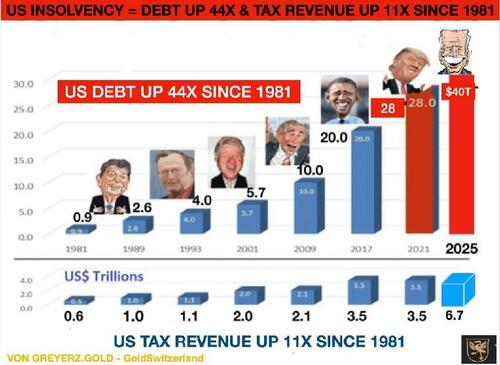
Extrapolating this trend, the US Federal Debt will reach $100 trillion in 2036.
With debts and deficits increasing exponentially, it is not unlikely that as inflation catches fire again, $100 trillion Federal Debt will be reached earlier than 2036.
Just think about a big number of bank failures, which is guaranteed, plus major defaults in the $2+ quadrillion derivative market. Against such dire background, it would be surprising if US debt doesn’t go far beyond $100 trillion by the mid 2030s!

STOCK MARKET BUBBLE & LEADERSHIP SWAPS
Investors and many analysts are still bullish about the stock market. As we know, markets will move higher until all investors, especially retail, are sucked in and until most of the shorts have liquidated their positions.
It has been a remarkable bull market based on unlimited debt creation. Nobody worries about the fact that 7 stocks are creating this mania. These stocks are well known to most investors: Alphabet (Google), Amazon, Apple, Meta (Facebook), Microsoft, Nvidia and Tesla.
These Magnificent 7 have a total market cap of $13 trillion. That is the same as the combined GDP of Germany, Japan, India and the UK! Only the US and China are bigger.
When 7 companies are greater than 4 of the biggest industrial economies in the world, it is time to fire the management of these countries and maybe do a swap.
GATES, COOKE, MUSK TAKING OVER GERMANY, UK & FRANCE
What about Germany’s Chancellor Scholz running Amazon. Or Rishi Sunak in the UK being in charge of Microsoft? How long would it take them to destroy these companies? Not many years in my view. They would quickly double the benefits for workers and increase debts to unsustainable levels.
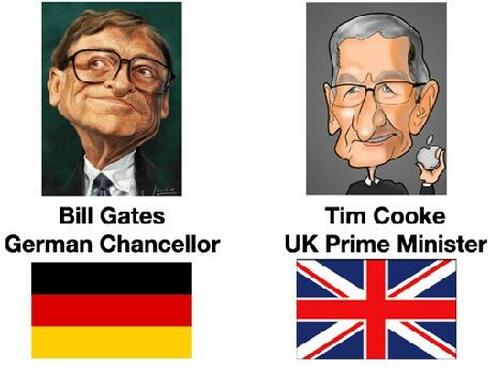
But Germany and the UK would most certainly benefit from Bill Gates of Microsoft taking on Germany and Tim Cooke of Apple running the UK. They would of course need dictatorial powers in order to take the draconian measures required. Only then could they slash inefficiencies, halve benefits and reduce taxes by at least 50%.
If the entrepreneurs just got a very small percentage of the improvement in the countries’ finances as remuneration, they would make much more money than they are currently.
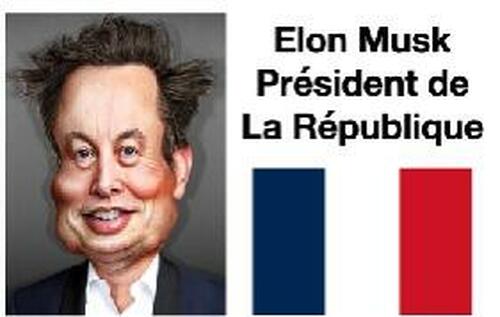
Even more fascinating would be to see Elon Musk as French President. He would fire at least 80% of state employees and by doing that he might even get the militant French unions on his side and get the country back on its feet.
An interesting thought experiment that of course will never happen.
WHY IS EVERYONE WAITING FOR NEW GOLD HIGHS IN ORDER TO BUY???
For almost 25 years I have been standing on a soapbox to inform investors of the importance of wealth preservation.
Still only just over 0.5% of global financial assets have been invested in gold. In 1960 it was 5% in gold and in 1980 when gold peaked at $850, it was 2.7%.
For a quarter of a century, gold has gone up 7- 8X in most Western currencies and exponentially more in weak currencies like the Argentine Pesos or Venezuelan Bolivar.
In spite of gold outperforming most asset classes in this century, it remains at less than 1% of Global Financial Assets – GFA. Currently at $2,100 gold is at 0.6% of GFA.
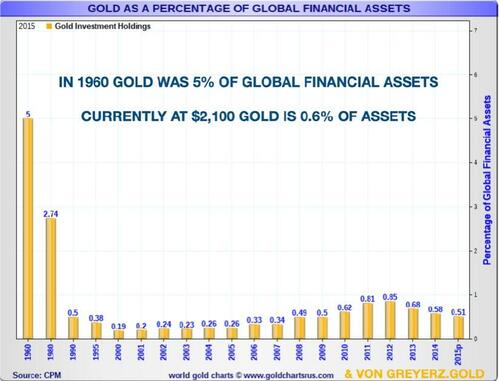
WE HAVE LIFTOFF!
So gold has now broken out and very few investors are participating.
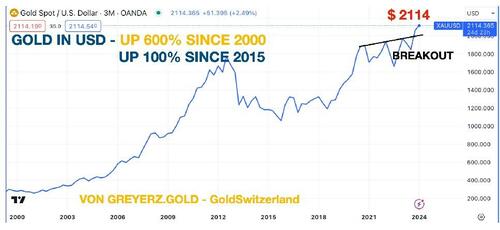
This stealth move that gold has made has left virtually every investor behind as this table shows:

The clever buyers are of course the BRICS central banks. Almost all of their purchases are off market so in the short term it has only a marginal effect on the gold price.
But now the squeeze has started as my good friend Alasdair Macleod explains so well on King World News. The Comex was never meant for physical deliveries but only for cash settlements. But now buyers are standing for physical delivery. We have also seen last month major exports of gold from the US to Switzerland. These are either Comex 400 ounce bars or US government bars sold/leased and sent to the Swiss refiners and broken down to 1 kg bars for onwards export to the BRICS. These bars will never return again even if they are only leased and not sold.
The above process will one day bring panic to the gold market as there will be nowhere near enough physical gold for all the paper claims.
So for any gold investors who don’t hold physical gold in a safe jurisdiction (NOT USA), I suggest that they quickly move their gold to a private vault where they have personal access, preferably in Switzerland or Singapore.
So NO FRACTIONAL GOLD OWNERSHIP, NO GOLD ETFs or FUNDS and NO GOLD IN BANKS!
At least not if you want to be sure to get hold of your gold as the gold squeeze starts.
GOLD IS ON THE CUSP OF A MAJOR MOVE
Having just broken out, gold is now on its way to much, much higher levels.
As I keep on saying, forecasting the gold price is a mug’s game.
What is the purpose of predicting a price level when the unit you measure gold in (USD, EUR, GBP etc) is continually debasing and worth less every month.
All investors need to know is that every single currency in history has without fail gone to ZERO as Voltaire said already in 1727.
Since the early 1700s, over 500 currencies have become extinct, most of them due to hyperinflation.
Only since 1971 all major currencies have lost 97-99% of their purchasing power measured in gold. In the next 5-10 years they will lose the remaining 1-3% which of course is 100% from here.
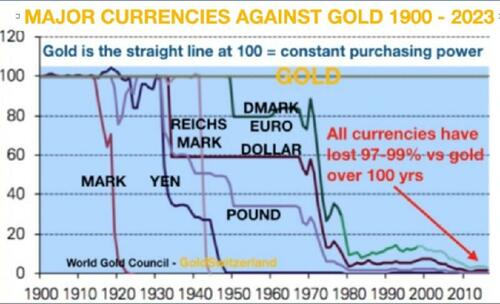
But gold will not only continue to maintain purchasing power, it will do substantially better. This is due to the coming collapse of all bubble assets – Stocks, Bonds, Property etc. The world will not be able to avoid the Everything Collapse or First Gradually then Suddenly – The Everything Collapse as I wrote about in two articles in 2023.
YES, GOLD IS ON THE CUSP OF A MAJOR MOVE AS:
-
Wars continue to ravage the world.
-
Inflation rises strongly due to ever increasing debts and deficits.
-
Currency continues their journey to ZERO.
-
The world flees from stocks, bonds, and the US dollar.
-
The BRICS countries continue to buy ever bigger amounts of gold.
-
Central Banks buy major amounts of gold as currency reserves instead of US dollars.
-
Investors rush into gold at any price to preserve their wealth.
GOLD AS CHEAP AS IN 1971 OR 2000
The chart below indicates that gold in early 2020 at $1700 was as cheap as in 1971at $35 and in 2000 at $1700 in relation to money supply.

At this point we do not have an updated chart but it is our estimate that the monetary base has probably kept pace with the gold price meaning that the level in 2024 is similar to 2020.
So let me repeat my mantra:
Please jump on the Gold Wagon while there is still time to preserve your wealth.
The coming surge in gold demand cannot be met by more gold because more than the current 3000 tonnes of gold per annum cannot be mined.
|
|
[National Security]
Correspondent to Carnage
It's often the case that the most hard-bitten war correspondents write the most heartbreaking books. That's because they go to dangerous battle-zones—with their carnage and destruction—to which the more timorous correspondents hesitate to take themselves. And as a consequence, these toughest of reporters see things that others don't see—others, that is, who aren't themselves trapped in these zones, whether as soldiers in the thick of battle or war-locked civilians on the brink of death. And in telling us about them these reporters rend our hearts.
The post Correspondent to Carnage appeared first on Washington Free Beacon.
Published:3/3/2024 4:42:28 AM
|
[Markets]
Futures Fall Ahead Of Key PCE Print
Futures Fall Ahead Of Key PCE Print
For the third day in a row, US equity futures dropped and bonds fell as investors braced for a print of the Federal Reserve’s favorite inflation metric, which will help identify the path forward for interest rates. As of 7:45am, futures contracts for the emini S&P 500 and the Nasdaq 100 both retreated by about 0.2%, off the worst levels of the session. European stocks fluctuated during another crowded day on the earnings calendar, while Asia closed modestly higher. MegaCaps are mixed with NVDA -1.3% and AAPL -0.7%, the largest movers pre-mkt. Bond yields are up 3-6bps as the yield curve bear flattens; the US Dollar is weaker while the yen holds most of the advance spurred by strongest signal yet from Bank of Japan that the end is near for its negative interest-rate policy. The commodity complex is also lower; oil is flat, while bitcoin continues to surge and was last seen around $63,000. Today’s macro data focus includes PCE/Core PCE, jobless claims, and regional activity indicators. While PCE has been de-risked due to the CPI print, there is still potential for volatility given positioning in the bond market. Month-end rebalancing is thought to provide additional pressure on stocks irrespective of PCE.
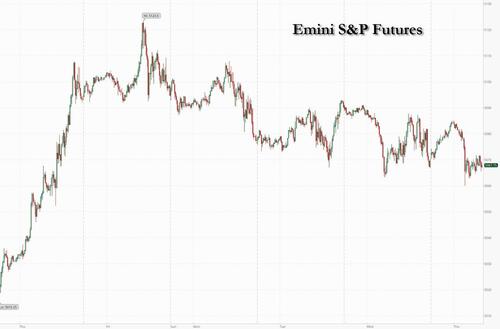
In premarket trading, cloud software giant Snowflake shares plunge 23% after the company gave a forecast for first-quarter product revenue that is weaker than expected. Analysts noted that the shares were pressured by a combination of CEO Frank Slootman stepping down and a conservative guide. Peers also decline, with MongoDB down 4.2%, and DataDog sliding 3.0%. Elsewhere, WW International, fka as Wight Watchers, shares crasjed 25% after the "health and wellness" company issued full-year revenue guidance that missed expectations. The company also said Oprah Winfrey has decided to not stand for re-election at its annual shareholders meeting in May, having served on the board since 2015. Here are some other notable premarket movers:
- C3.ai (AI US) shares jump 17.58% after the software firm’s third-quarter revenue beat estimates, showing that demand remains robust for its artificial intelligence-related products. Analysts highlighted strength in its subscription revenues, and demand from government clients.
- CRH (CRH US) shares gain 6.3% in New York premarket trading after the building-materials firm reported “excellent” full-year results, according to Davy, with UBS highlighting the firm’s strong growth prospects in 2024.
- Duolingo (DUOL US) shares soar 20% after full-year revenue guidance from the language-learning software company beat expectations, while fourth-quarter earnings per share also surpassed forecasts. A number of analysts lifted their price targets on the stock, noting robust growth in user numbers.
- HP Inc. (HPQ US) shares fall 3.4% after the computer hardware company reported first-quarter results that missed expectations on key metrics amid ongoing weakness in the market for personal computers.
- Macy’s (M US) shares dip 0.6% after the department store chain was downgraded to market perform from outperform at TD Cowen, which said the company’s restructuring plans will take some time to drive upside to guidance.
- Monster Beverage (MNST US) shares advance 5.6% after the energy-drink maker reported fourth-quarter gross margin that beat consensus estimates. Analysts saw the results as solid overall, highlighting the gross margin beat in the quarter, as well as the strong start to the first-quarter.
- Okta (OKTA US) shares rise 29% after the application software company reported fourth-quarter results that beat expectations. Analysts view the results as a relief in the wake of a recent breach.
- Paramount Global (PARA US) shares advance 3.9% after the media company reported results that were seen as mixed, although revenue in its direct-to-consumer (DTC) streaming business beat expectations.
- Salesforce (CRM US) shares fall 1.8% after the application software company gave a full-year revenue forecast that was weaker than expected, though analysts said it could be conservative. It also initiated a dividend of 40c/share and increased the share buyback authorization by $10b.
Thursday’s core PCE report, where the core print is expected to rise 0.4% MoM and 2.8% YoY, will likely validate recent commentary from Fed officials showing no rush to ease monetary policy and underscore the twists and turns on the route to the central bank’s 2% inflation target. A higher-than-anticipated reading could undermine expectations for three quarter-point rate cuts by year-end.
"The market always needs to focus on something, and with earnings out of the way and the rates outlook priced in, inflation is the next catalyst,” said Beata Manthey, equity strategist at Citigroup Inc. “It’ll depend on how bad or good the print is today, but when we look at the fundamentals, earnings have shown they’re delivering."
Stocks are rounding off a strong February, with the S&P 500 and the Nasdaq 100 up more than 4% after excitement around artificial intelligence drove a tech-powered, record-breaking run on Wall Street. MSCI’s global equity index is rising for a fourth month, its longest winning streak since 2021.
For Ulrich Urbahn, head of multi-asset strategy and research at Berenberg, trading on the final day of February is likely to be influenced more by month-end rebalancing than by data, as inflation trends have already been priced into markets following this month’s consumer and producer price reports.
“The focus on PCE ‘because that’s what the Fed cares about’ is valid,” Urbahn said. “But it’s mostly already baked in the cake. Markets will be more affected by some rebalancing flows as equities have hugely outperformed bonds this year.”
New York Fed President John Williams said Wednesday the central bank has “a ways to go,” in its battle against inflation and Atlanta Fed chief Raphael Bostic urged patience in regard to policy tweaks. Meanwhile, traders are currently pricing around 80 basis points of easing by year-end — almost in line with what officials in December indicated as the likeliest outcome. That would equate to three cuts in 2024 — as the Fed moves have historically been increments of 25 basis points. To put things in perspective, swaps were projecting almost 150 basis points of cuts this year at the start of February.
“Fedspeak and economic data so far this week suggest that central bankers remain data-dependent, which raises volatility around key economic data releases, and that inflation seems to be re-accelerating in the short term, which may make it harder to reach the 2% inflation goal,” Kathleen Brooks, research director at XTB, wrote in a note.
European stocks fluctuated during another crowded day on the earnings calendar as traders reduced bets on how fast and far the European Central Bank will lower interest rates this year after a flurry of inflation readings from the region. Moncler SpA rallied after the Italian luxury company beat profit expectations. Air France-KLM slumped after a fourth-quarter loss. The Stoxx 600 added 0.1% with construction, media and retail shares the best performers. Here are the most notable movers:
- Haleon rises as much as 9%, the most since Dec. 2022, after delivering results that were better than feared, following the weak numbers posted by rival Reckitt yesterday
- Universal Music Group gains as much as 6.5%, the most since July, after the Amsterdam-listed music and entertainment group impressed with its fourth-quarter earnings
- Moncler shares rise as much as 6.3%, to the highest since June, after the Italian luxury company reported results that beat estimates
- Eiffage gains as much as 5.4%, the most since March 2022, as Morgan Stanley flags the infrastructure company’s strong cash generation and in-line earnings performance
- AMS-Osram shares plunge 45% after a major customer — believed by analysts to be Apple — canceled the Swiss chipmaker’s key project around microLED
- Howden Joinery rises as much as 8.5%, the most since Dec. 2020, after 2023 results broadly met estimates
- Drax climbs as much as 8.6% after the UK renewable energy company’s results, which analysts say look solid. Morgan Stanley highlights Drax’s long-term guidance and positive impact
- Argenx falls as much as 4.5% after it reported full-year results that analysts said weren’t surprising
- Beiersdorf shares fall as much as 6.1%, their steepest drop since May 2022, after the Nivea maker reported results that RBC described as “disappointing”
- Technip Energies shares reverse an earlier gain to slip as much as 3.6%, after the France-based engineering and technology company posted a 2023 Ebit beat but issued guidance that missed
In FX, the dollar steadied, while the yen was the best-performing G-10 currency, rising 0.4% versus the greenback, the most in more than a week, after Bank of Japan Board Member Hajime Takata sent one of the strongest signals yet that the end is near for its negative interest rate policy.
In rates, Treasury yields rose, with the more policy sensitive two-year note up five basis points. 10-year TSY yields last traded around 4.31% near session high, outperforming gilts by around 3bp in the sector; the UK curve cheaper on the day by as much as 7bp in 5-year sector. Yields in Europe climbed after mixed readings on price pressures from France and Spain, with German inflation coming in on the softer side of expectations (CPI printed 0.4% MoM, vs exp. 0.5%, and 2.5% YoY, vs exp 2.6%). Traders reduced bets on how fast and far the European Central Bank will lower interest rates this year after a flurry of inflation readings from the region - Bloomberg Economics still expect euro-area headline inflation to slow on Friday. Short-end bonds are leading a selloff in European government debt. German two-year yields rise 7bps to 2.99%. IG dollar issuance slate empty so far; seven names priced $14.4b Wednesday, taking weekly volume past $50b; issuers paid about 6bps in new-issue concessions on order books said to be 3.8x oversubscribed. Robust calendar could materialize Thursday if inflation readings are benign. US January personal income and spending data at 8:30am New York time include PCE inflation gauge with potential to alter corresponding outlook for Fed.
In commodities, oil prices are little changed, with WTI trading near $78.50. Spot gold falls 0.2%. Bitcoin jumps ~3% and is above $62,000.
Bitcoin continues to march higher and back above the $62k level, after it was revealed that yesterday's record volume surge across the ETF sector led to a record net inflows as demand for crypto just won't slow. Meanwhile, Ether continues to outperform, printing a peak incrementally above USD 3.5k. Elsewhere, Coinbase said all services on Coinbase.com have been restored; after some users reported a zero balance on their accounts.
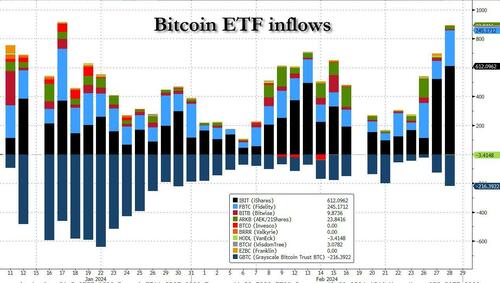
Looking to the day ahead now, the US economic data calendar includes weekly jobless claims (8:30am), February MNI Chicago PMI (9:45am, three minutes earlier to subscribers), January pending home sales (10am) and February Kansas City Fed manufacturing activity (11am). Fed speakers scheduled include Bostic (10:50am), Goolsbee (11am), Mester (1:15pm, 3:30pm) and Williams (8:10pm). Elsewhere, there’s the February flash CPI inflation prints from Germany and France, along with German unemployment for February, UK mortgage approvals for January, and Canada’s Q4 GDP. From central banks, we’ll hear from the Fed’s Bostic, Goolsbee, Mester and Williams.
Market Snapshot
- S&P 500 futures down 0.3% to 5,065.00
- STOXX Europe 600 little changed at 495.04
- MXAP up 0.4% to 172.73
- MXAPJ up 0.2% to 524.61
- Nikkei down 0.1% to 39,166.19
- Topix little changed at 2,675.73
- Hang Seng Index down 0.2% to 16,511.44
- Shanghai Composite up 1.9% to 3,015.17
- Sensex little changed at 72,263.43
- Australia S&P/ASX 200 up 0.5% to 7,698.70
- Kospi down 0.4% to 2,642.36
- German 10Y yield little changed at 2.49%
- Euro little changed at $1.0847
- Brent Futures down 0.4% to $83.32/bbl
- Gold spot up 0.0% to $2,035.55
- U.S. Dollar Index down 0.16% to 103.81
Top Overnight News
- The Supreme Court’s decision to take up Donald Trump’s bid for immunity from criminal prosecution raises the prospect that a trial to hold him accountable for trying to overturn the 2020 election could face a lengthy delay — potentially until after the November election
- An Illinois judge barred Trump from appearing on the Republican presidential primary ballot, marking the third state to impose such a ban on the former president for his role in the insurrection at the US Capitol on Jan 6.
- Ben Bernanke’s global savings glut is drying up. Long-term interest rates worldwide may be heading higher as a result.
- China banned a top-performing quant fund from the stock-index futures market and vowed tighter oversight of high-speed trading, expanding a crackdown on computer-driven investment strategies that some have blamed for exacerbating market turmoil
- Wall Street traders bracing for key inflation data waded through mixed economic figures and remarks from Federal Reserve speakers for clues on the interest-rate outlook.
Earnings
- Covestro (1COV GY) - Q4 (EUR): adj. EBITDA 132mln (exp. 99mln), Revenue 3.35bln (exp. 3.44bln). Decides not to pay a dividend. Expects economic conditions to remain challenging in 2024. Guides Q1 EBITDA 180-280mln (exp. 204mln). Guides initial FY24 EBITDA 1-1.6bln (exp. 1.36bln), Revenue 14-15bln (exp. 14.7bln). Shares +1.8% in European trade
- IAG (IAG LN) – FY (EUR): Revenue 29.5bln (exp. 29.4bln), adj. Net 2.66bln (exp. 2.29bln), adj. Operating 3.5bln (exp. 3.5bln). 92% booked for Q1 and 62% for H1. Positive outlook for 2024, expect to generate significant cashflow throughout the year. Shares +1.2% in European trade
- MTU Aero (MTX GY) – FY23 (EUR): Adj. Revenue 6.3bln (prev. forecast 6.1-6.3bln), Adj. EBIT 818mln (prev. forecast 800mln), Adj. Net Income 594mln (exp. 600mln). Outlook: FY Revenue 7.3-7.5bln, Adj. EBIT margin 12%. Shares -0.5% in European trade
- Snowflake (SNOW) - Q4 2024 (USD): Adj. EPS 0.35 (exp. 0.18), Revenue 774.7mln (exp. 760.4mln); Q1 product revenue view 745-750mln (exp. 769.5mln), FY25 product revenue view 3.25bln (exp. 3.46bln). (Newswires) Shares -22.8% in pre-market trade
- Salesforce (CRM) - Shares slipped by 1.6% in afterhours trade as it provided light guidance for the FY. Q4 adj. EPS 2.29 (exp. 2.26), Q4 revenue USD 9.29bln (exp. 9.22bln). Increases share repurchase authorisation by USD 10bln. Initiated a common stock dividend of USD 0.40/shr. Sees Q1 adj. EPS between USD 2.37-2.39 (exp. 2.20), and Q1 revenue between USD 9.12bln-9.19bln (exp. 9.19bln); sees FY25 revenue between USD 37.7bln-38.0bln (exp. 38.6bln). Shares -1.8% in pre-market trade
A more detailed look at global markets courtesy of Newsquawk
APAC stocks were choppy at month-end after the lacklustre handover from the US ahead of PCE price data. ASX 200 eventually shrugged off the initial indecision and briefly climbed above 7,700 to eke a fresh record high. Nikkei 225 briefly dipped below the 39,000 level amid a firmer currency and hawkish comments from BoJ's Takata, although the index gradually recovered all of its losses in late trade. Hang Seng and Shanghai Comp. were positive with outperformance in the latter which momentarily reclaimed the 3,000 level amid lower yields and after the PBoC voiced support for Shanghai's high-level opening up financially, while it was also reported that China is to crack down on illegal activity to maintain market order. Conversely, the gains in Hong Kong were limited with earnings on the radar.
Top Asian News
- US limits the sales of Americans' data to China and other rivals with President Biden signing an executive order restricting the ability of data brokers to sell sensitive information abroad, according to WSJ.
- BoJ Board Member Takata said Japan's economy is at an inflexion point of changing the 'norm' that people think wages and prices are not rising, while he added achievement of the price target is coming into sight despite the uncertainty of the economic outlook. Takata also said need to consider taking a flexible response including exit from monetary stimulus and that momentum is rising in this spring's wage talks with many companies offering higher-than-2023 wage hikes. BoJ Board Member Takata later stated that he would call for a gear shift in policy and not go backwards but added he has not made up his mind yet on a monetary policy decision when asked about whether to end negative interest rates in March or April, while he is not thinking of raising interest rates one after another and said gradual steps will be needed amid mixed circumstances surrounding small firms.
- RBNZ Governor Orr said as aggregate demand has slowed, it has been harder to pass on cost increases and he is confident the current level of the OCR is restricting demand, while the inflation outlook is very balanced. Orr said the economy has developed as they expected and the latest data confirmed inflation is slowing, while he added the easing of interest rates won't happen anytime soon.
European bourses, Stoxx600 (+0.1%) are mixed and trade has remained rangebound throughout the session; the DAX 40 (+0.4%) outperforms, and continues to trade towards/at ATHs. European sectors are mixed; Construction & Materials takes the top spot, lifted by gains in CRH (+7.3%) post-earnings. Tech is found at the bottom of the pile, with many of the chip names continuing to underperform. US Equity Futures (ES -0.3%, NQ -0.3%, RTY +0.1%) are mostly lower, with trade continuing the downbeat price action seen in the prior session. In terms of individual movers, Salesforce (-1.9%) slipped on its results, which although reported strong metrics, its FY25 guidance missed analyst expectations.
Top European News
- ECB's Vasle said the ECB is looking at a rate-cutting phase if there are no big surprises and the timing of cuts depends on inflation.
- ECB will continue to put a 'floor' underneath market interest rates in the years ahead, though banks will have a greater role in determining how much liquidity they want, via Reuters citing sources.
- UK appoints Clare Lombardelli as the the next BoE Deputy Governor for monetary policy; replaces Broadbent who leaves at the end of June.
- ECB's Holzmann says a serious discussion at the ECB on rate reductions is unlikely before June, via Politico [published Feb. 28th]
FX
- DXY is a touch softer as a by-product of JPY strength. DXY has ventured to a low of 103.75, stopping shy of the 200DMA at 103.69 and yesterday's low at 103.60. The fate for the index today will almost certainly be determined by US PCE metrics.
- EUR marginally gains vs. the USD amid a slew of EZ data with (on balance) firmer regional CPIs taking focus ahead of tomorrow's EZ-wide metrics. EUR/USD mounted yesterday's best at 1.0840.
- JPY is the standout outperformer across the majors following "hawkish" BoJ comments overnight. This has given JPY some reprieve with USD/JPY pulling back to a low of 149.62 (matches 21DMA) from a high of 150.69. A hot core PCE release could reverse the pair's fortunes and bring attention back to the YTD peak at 150.88.
- Differing fortunes for the antipodes with AUD/USD back on a 0.65 handle after bottoming out yesterday at 0.6488 post-USD strength. NZD/USD remains above yesterday's 0.6082 trough but is unable to reclaim 0.61 status.
- PBoC set USD/CNY mid-point at 7.1036 vs exp. 7.1938 (prev. 7.1075).
Fixed Income
- The bearish narrative continues for Bunds; French CPI sparked some initial downside, though further hotter-than-expected releases from Spain and Germany (state), firmly guided the hawkish direction. Bunds have been drifting lower and are now at a fresh YTD low at 131.62, with the 10yr yield above 2.5%.
- USTs are driven by EGBs so far but also potentially positioning into the US January PCE data, which will be gauged to see if it conforms to the hotter narrative of other January pricing metrics; currently holds just above 110-00.
- Gilt price action conformed with EGBs into the latest BoE mortgage data with no reaction to the numbers despite lending and approvals printing below/above their respective forecast ranges. EGB-driven action has similarly pushed Gilts to a fresh YTD low at 96.83.
Commodities
- Crude benchmarks are under modest pressure but are comparably contained when judged against Wednesday's whipsaw price action; currently holds around the USD 82/bbl mark.
- Spot gold is incrementally softer initially benefitting from a weaker Dollar, though now off best levels; USD 2032/oz 50-DMA remains untested with the current low at USD 2034/oz.
- Base metals are bid and deriving support from USD downside, the overall European risk tone and strength in China.
Geopolitics
- Japan's top currency diplomat Kanda said using frozen Russian assets for Ukraine must be based on international law and he thinks EU's proposal is along those lines, while he added that Japan strongly condemned Russia's invasion of Ukraine at the G20 and that the G7 discussed ways to make use of frozen Russian assets for Ukraine reconstruction.
- Russian President Putin says "don't they understand there is danger of nuclear conflict?"; on talk of NATO troops in Ukraine, says consequences for the intruders will be more tragic and we have weapon which is able to hit targets on their territory.
- Ukraine sees a risk of Russia breaking through its defences by the summer unless allies increase supplies of ammunition, according to Bloomberg sources
US Event Calendar
- 08:30: Feb. Initial Jobless Claims, est. 210,000, prior 201,000
- Feb. Continuing Claims, est. 1.87m, prior 1.86m
- 08:30: Jan. Personal Income, est. 0.4%, prior 0.3%
- Jan. Personal Spending, est. 0.2%, prior 0.7%
- Jan. Real Personal Spending, est. -0.1%, prior 0.5%
- 08:30: Jan. PCE Deflator MoM, est. 0.3%, prior 0.2%
- Jan. PCE Core Deflator YoY, est. 2.8%, prior 2.9%
- Jan. PCE Core Deflator MoM, est. 0.4%, prior 0.2%
- Jan. PCE Deflator YoY, est. 2.4%, prior 2.6%
- 09:45: Feb. MNI Chicago PMI, est. 48.0, prior 46.0
- 10:00: Jan. Pending Home Sales (MoM), est. 1.5%, prior 8.3%
- Jan. Pending Home Sales YoY, est. -4.4%, prior -1.0%
- 11:00: Feb. Kansas City Fed Manf. Activity, est. -2, prior -9
Central Bank Speakers
- 10:50: Fed’s Bostic Participates in Fireside Chat
- 11:00: Fed’s Goolsbee Gives Remarks on Monetary Policy
- 13:15: Fed’s Mester Speaks on Financial Stability and Regulation
- 15:30: Fed’s Mester Speaks to Yahoo Finance
- 20:10: Fed’s Williams Participates in Moderated Discussion
DB's Jim Reid concludes the overnight wrap
Happy February 29. I’m hearing lots about how this day happens every four years, but strictly speaking that’s not true. The rule is it’s a leap year if it’s divisible by 4, unless it’s divisible by 100, but not if it’s also divisible by 400. Make sense? So 1700, 1800 and 1900 weren’t leap years, 2000 was a leap year, but 2100 won’t be one. In other words, you get one every 97/400 years rather than 1/4, as the earth’s rotation around the sun is actually a bit less than 365.25 days. This might seem trivial (and you may be right), but the previous Julian calendar hadn’t adjusted for this and had a leap day every four years, hence the shift to the modern Gregorian calendar from the 16th century onwards. But when countries made the adjustment, it meant the date shifted forward. So in Britain, the recorded date went from 2 September 1752 one day to 14 September 1752 on the next, skipping over the 11 calendar days in the middle.
If we missed the next 11 days right now, we’d skip over an awful lot, including the next US jobs report, an array of US primary elections on Super Tuesday, the ECB’s policy decision, Fed Chair Powell’s congressional testimonies, and the UK budget. But today, the main focus will be on the PCE inflation data from the US, which is the measure of inflation that the Fed officially targets, and is therefore closely watched in markets. Readers will remember that a couple of weeks ago, the CPI and PPI inflation reports both surprised on the upside, and the components that feed into the core PCE reading are pointing to a strong print for January. As a result, o ur US economists are expecting core PCE to come in at +0.36% for the month, which if realised would be the strongest monthly print since another +0.36% reading in February last year. So that’s one to look out for as investors seek to gauge the timing of potential rate cuts from the Fed.
Ahead of that, markets in Asia have put in a mixed performance overnight. Chinese equities have advanced, including the CSI 300 (+1.11%) and the Shanghai Comp (+1.00%), and the Shanghai Comp is currently on track to record its best monthly performance since November 2022. But other indices have been more negative, and the Hang Seng is down -0.02%, the Nikkei is down -0.02%, and the KOSPI (-0.49%) has posted larger declines. Futures have also been subdued, with those on the S&P 500 up just +0.05% after yesterday’s decline.
In Japan, sentiment wasn’t helped by the latest industrial production data, which showed a decline of -7.5% in January (vs. -6.8% expected), which is the biggest monthly decline since May 2020. Nevertheless, investors have continued to grow in confidence that the end of the negative interest rate policy could be near, following comments from the BoJ’s Hajime Takata, who said that “my view is that the price target is finally coming into sight”. That’s helped the Japanese Yen to strengthen +0.44% against the US Dollar overnight, whilst 2yr government bond yields are up +2.3bps to 0.18%, which is their highest level since 2011. Moreover, overnight index swaps are now pricing in a 33% chance of a move away from negative interest rates at the next meeting in April, up from 21% the previous day.
Ahead of that yesterday, markets were mostly in a holding pattern, with the S&P 500 (-0.17%) still experiencing little movement since Nvidia’s earnings last week. The latest decline means the index is still on track for a weekly loss, and there were larger falls for the NASDAQ (-0.55%) and the Magnificent 7 (-0.58%). Meanwhile in Europe, the story was also one of losses yesterday, with the STOXX 600 down -0.35%. That said, the DAX (+0.25%) continued to outperform, posting a 6th consecutive advance and closing at a fresh all-time high.
Over on the rates side, the moves were also modest in scope yesterday, though yields did extend moderate declines during the US session. This came even as central bank speakers continued to echo the recent consensus on policy, suggesting that rate cuts are likely to happen over the coming months, but not yet. For instance, Boston Fed President Collins said that it “will likely become appropriate to begin easing policy later this year”, but also that “I want to see more evidence of a sustained trajectory to price stability”. Separately, New York Fed President Williams said that they still had “a ways to go on the journey to sustained 2% inflation”. Meanwhile at the ECB, we heard from Slovakia’s Kazimir, who said in a Reuters interview that for a rate cut, “June would be my preferred date, April would surprise me and March is a no go”. Lithuania’s Simkus made similar comments, saying that “June is really the month to consider the rate cut”. And later in the evening, Germany’s Nagel said that "we can’t make any mistakes in the final stretch of the journey”, suggesting it would be “fatal” if rates were eased too early only for inflation to rebound.
That backdrop saw expectations for rate cuts tick up a little yesterday. For the Fed, investors still expect that June is the most likely meeting for a cut, with futures pricing in a 77% chance of a cut by June (up from 73% the day before). In turn, that helped yields on 2yr Treasuries fell -5.6bps, while 10yr yields were down -3.9bps to 4.265%. Over in Europe the bond rally was more marginal, with yields on 10yr bunds (-0.6bps), OATs (-1.2bps) and BTPs (-1.8bps) all seeing modest declines.
Although yields were falling yesterday, there were fresh signs of an increase in market expectations for US inflation, with the 2yr breakeven up +2.6bps to 2.77%, which is their highest level since March last year. 2yr zero-coupon inflation swaps were also up +3.9bps to 2.43%, the highest since October, so we’re seeing that across several instruments. That came as Brent crude (+0.04%) closed at its highest level since early November, at $83.68/bbl. Moreover, it’s clear that higher oil prices are filtering through into the real economy, and data from the AAA showed US gasoline prices remained at $3.294 per gallon on Wednesday, in line with their level on Tuesday and their highest level since November.
On the data side, yesterday saw a very modest downgrade to US GDP growth in Q4, with the second estimate coming in at an annualised +3.2% (vs. +3.3% first estimate). The release also showed that core PCE prices grew a bit faster than thought in Q4, at an annualised rate of +2.1% (vs. +2.0% first estimate). However, the revisions still left annual GDP growth for 2023 at +2.5%, in line with the initial estimate.
Finally in US political news, congressional leaders agreed a deal yesterday evening to avoid a partial government shutdown that would have started after March 1. The deal would extend funding to March 8 for several departments, and others to March 22.
To the day ahead now, and data releases from the US include PCE inflation for January, personal income, personal spending and pending home sales for January, the weekly initial jobless claims, and the MNI Chicago PMI for February. Elsewhere, there’s the February flash CPI inflation prints from Germany and France, along with German unemployment for February, UK mortgage approvals for January, and Canada’s Q4 GDP. From central banks, we’ll hear from the Fed’s Bostic, Goolsbee, Mester and Williams.
|
|
[Entertainment]
Washington Post hardcover bestsellers
A snapshot of popular books.
Published:2/28/2024 7:10:17 AM
|
